- contact@scarhandpainting.com


As a full time professional miniatures painter I strive to specialize in techniques that provide the maximum effect on the gaming board, while being relatively simple and easy to mass duplicate. Here I will present to you a Step-by-step guide to painting green glow effect similar to that used in most of the projects, for example Gallery: Cult of Yurei and Gallery: Legio Vulpa.
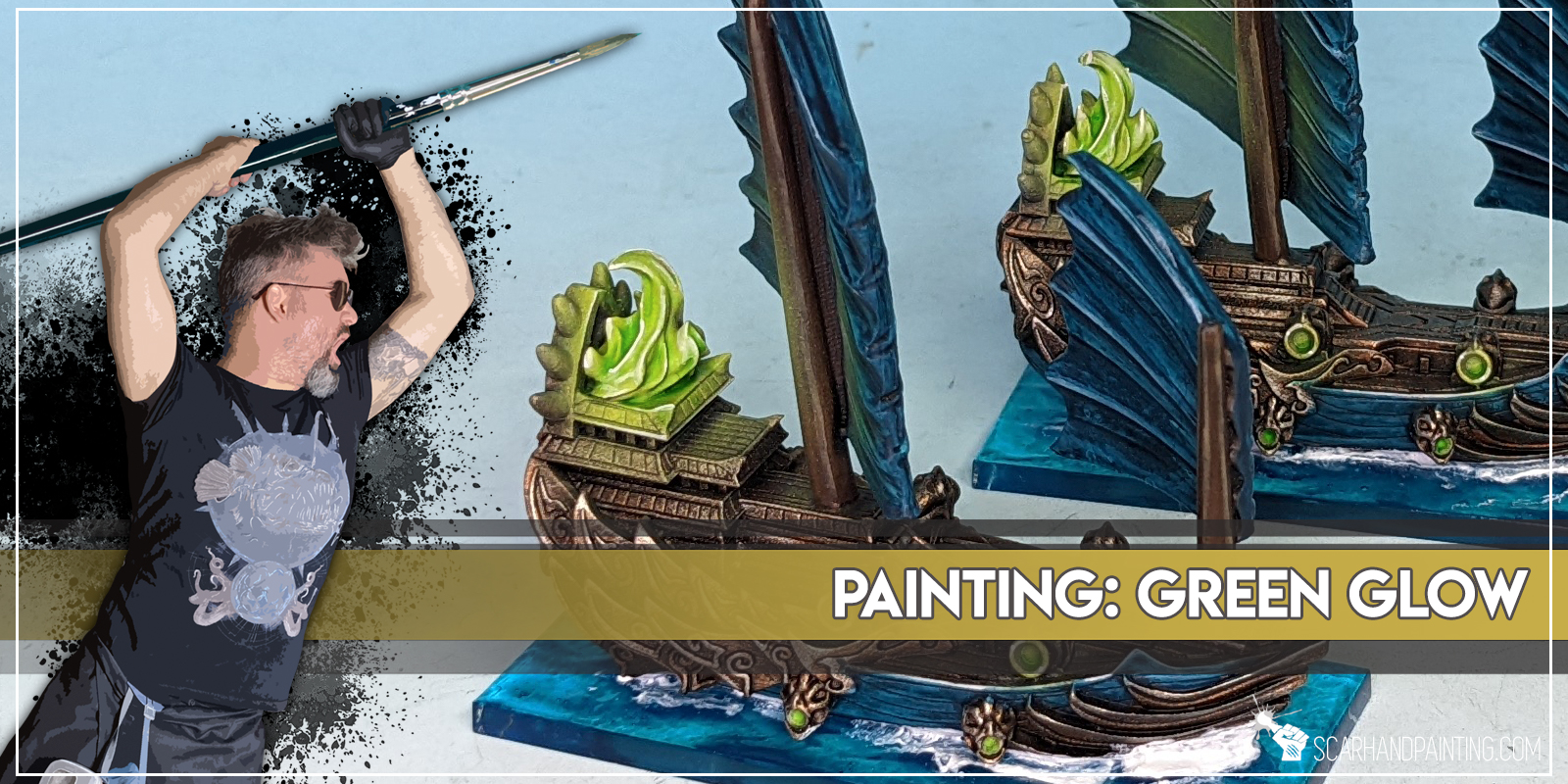
Before we start, some notes:

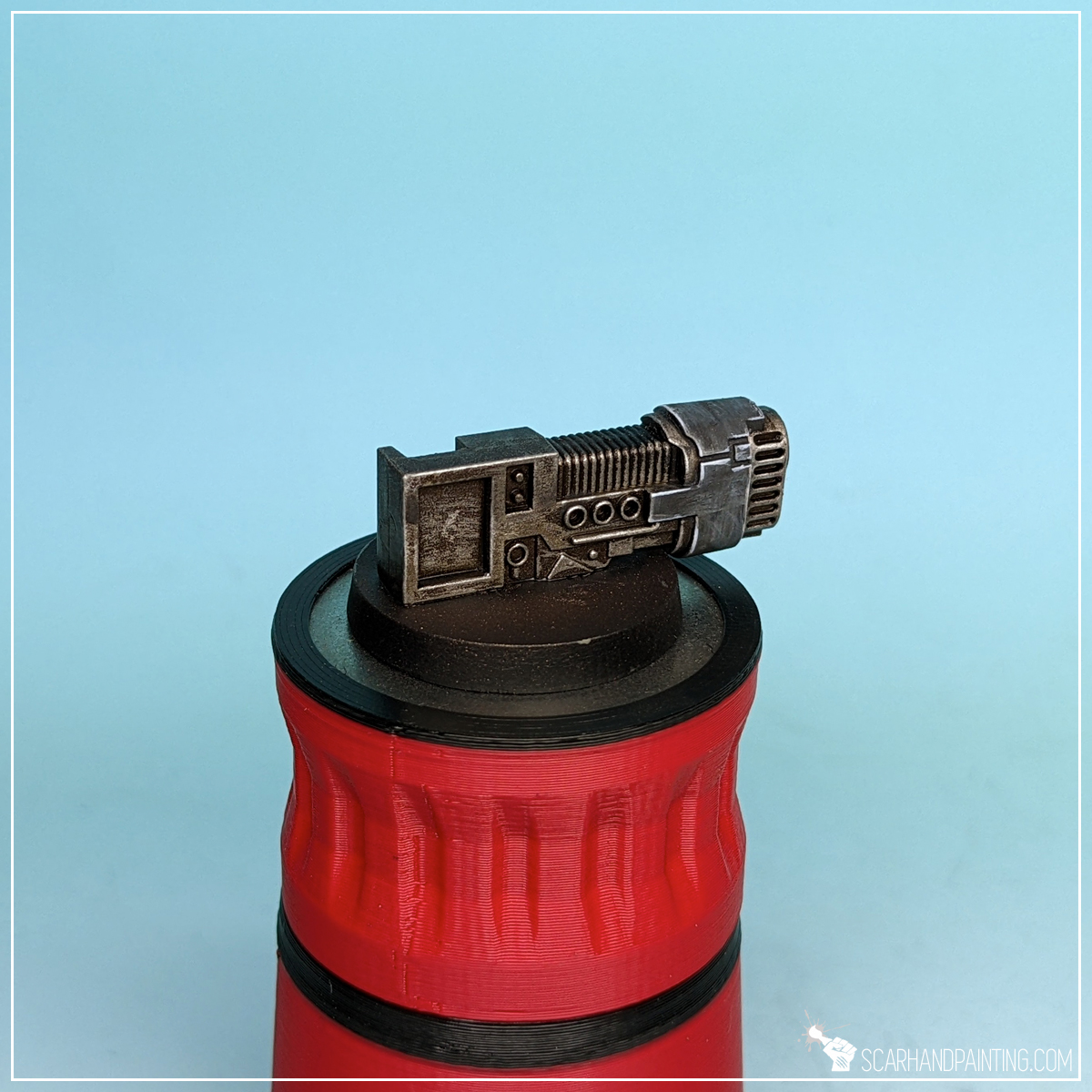
Step one: Duck Egg preshade
I started with a soft layer of slightly thinned airbrushed Vallejo 71.009 Duck Egg Green (air). While airbrushing I made sure to cover potential light source areas plus the immediate surroundings.
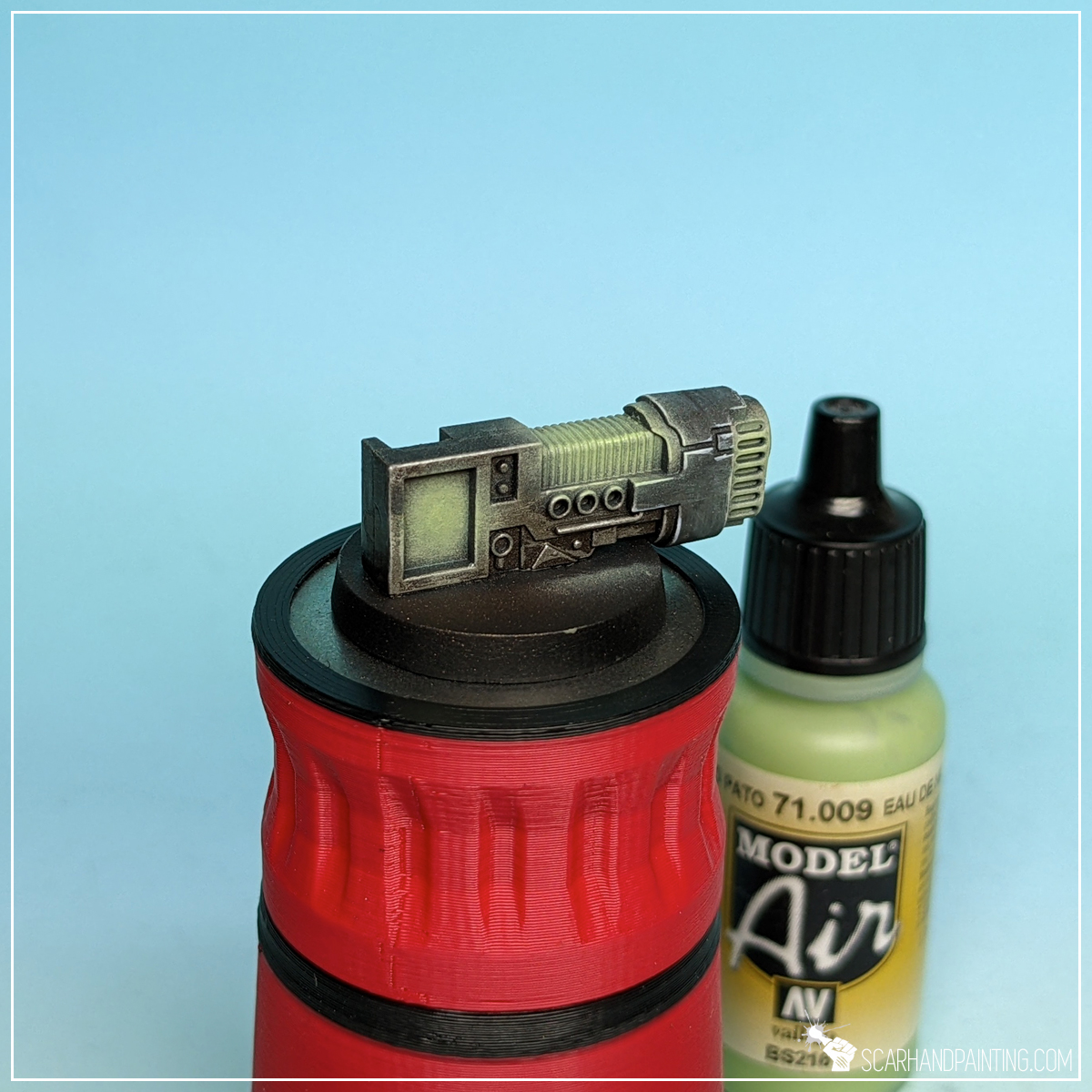
Step two: Green base
Next I airbrushed a layer of Vallejo 72.733 Light Livery Green (air) without thinning. This layer was applied on top of previously airbrushed Duck Egg Green.

Step three: highlight
I then highlighted green with Vallejo 72.101 Off-White, pulling the edges out to create a solid base for future juicing up back to strong toxic green.
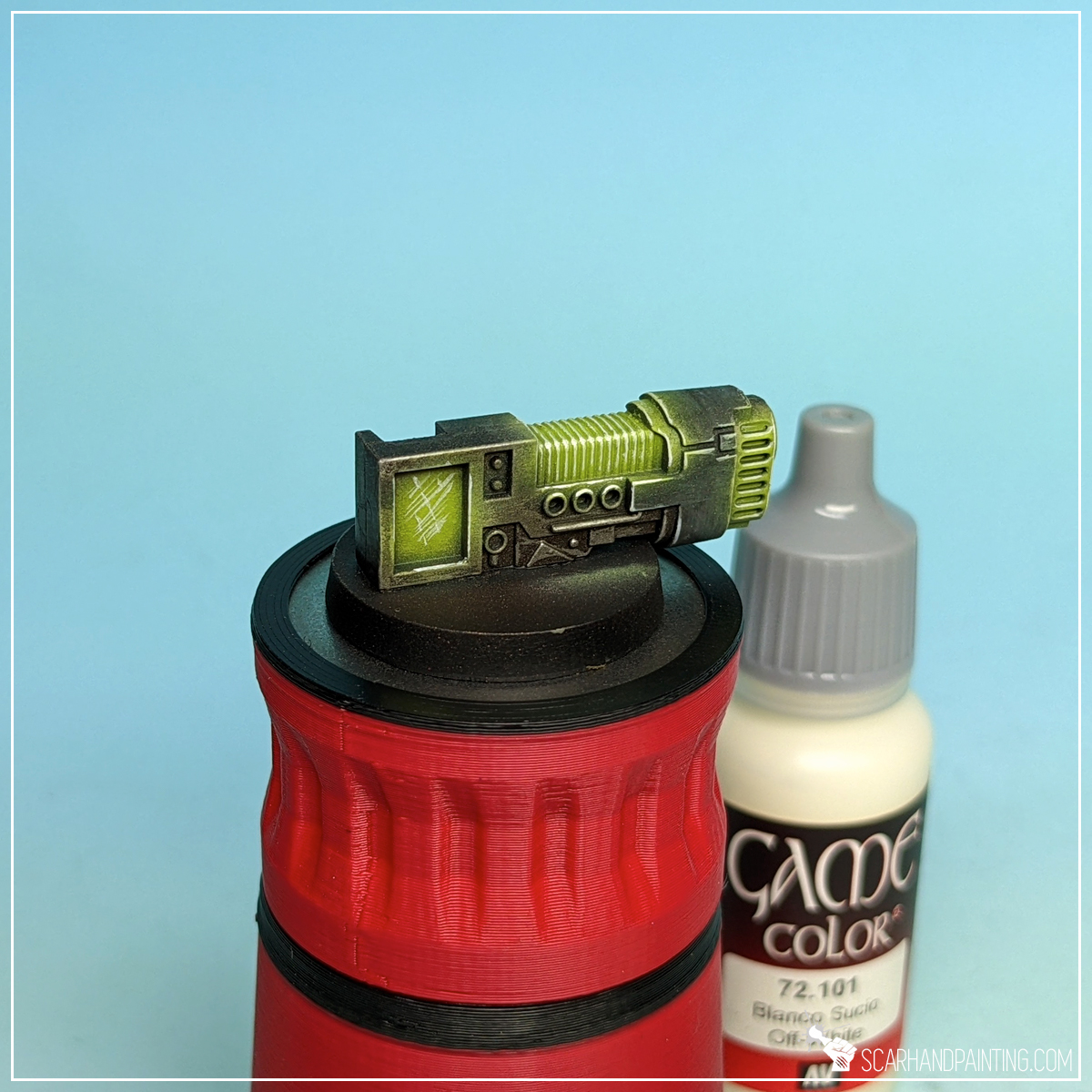
Step four: glaze
Next I manually applied a glaze of slightly thinned down Vallejo 72.733 Light Livery Green over the most intense green parts of the miniature. This includes plasma coils, glow on the side of the barrel and large rectangle area at the back.
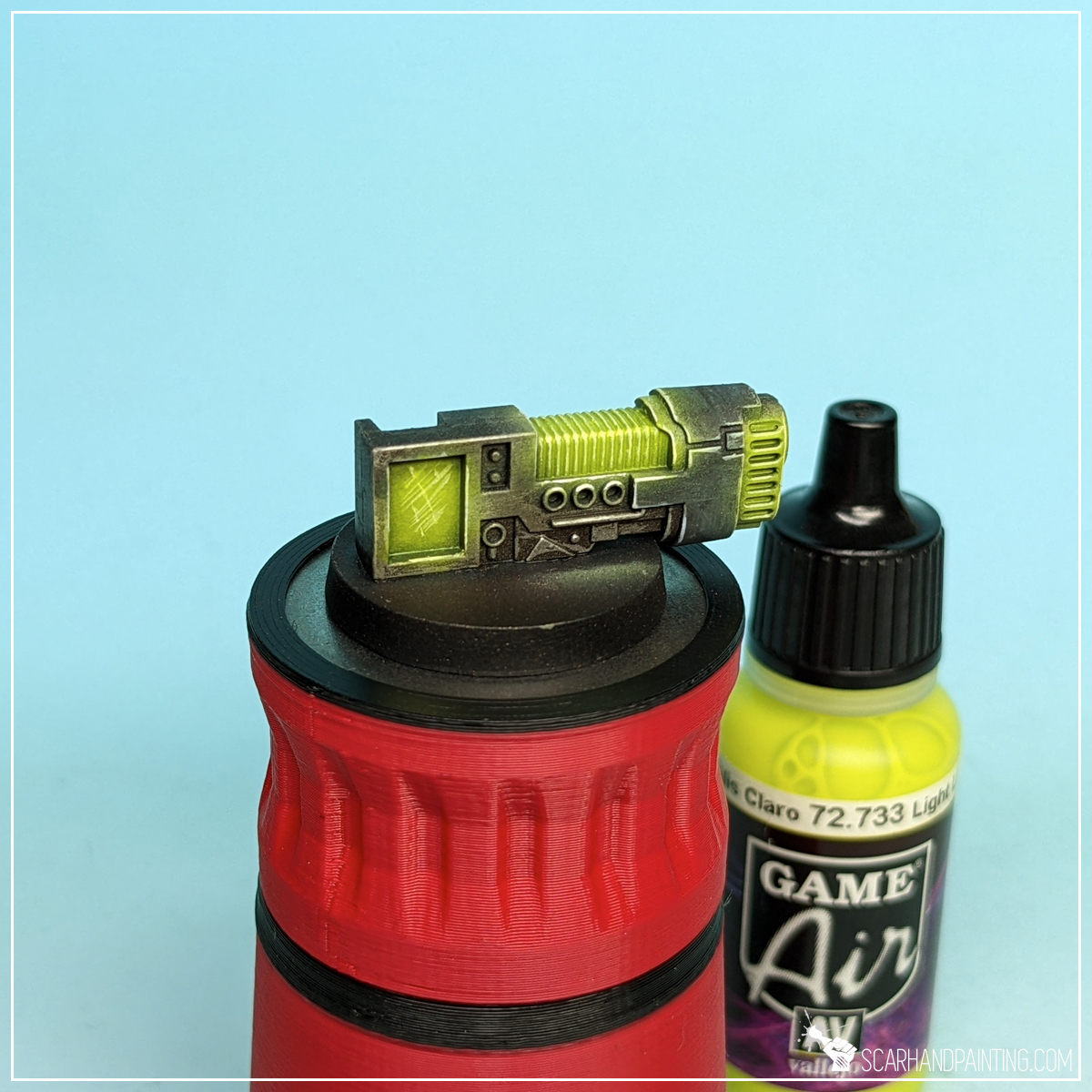
Step five: highlight
Then, I once again applied a highlight of Vallejo 72.101 Off-White. This time I kept it contained to most exposed areas, barely few lines and dots to add focus points and add more overall contrast on the piece.

Step six: wash
Finally I applied a mix* of Vallejo 72.089 Green Ink ( 3 drops), Vallejo 72.085 Yellow Ink (2 drops) and water (10 drops). I made sure to apply the paint to deepest recesses only, avoiding exposed plasma coils and edges.
* You might notice a GW Waywatcher Green bottle in the picture below. The Vallejo mix is a recipe for GW Waywatcher Green, that is out of production. You can find more GW Glaze – Vallejo mix recipes in this article.
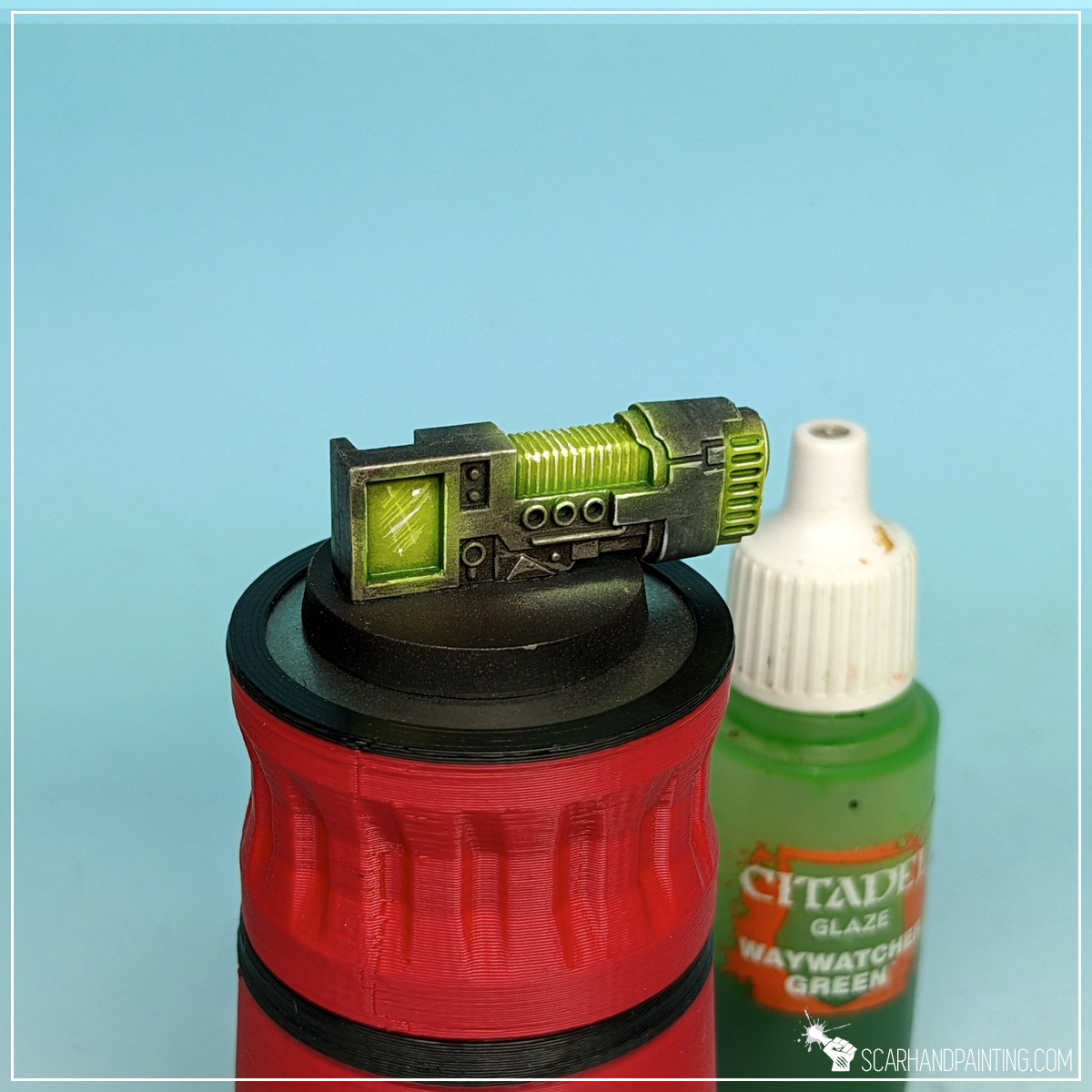
Work complete. Four colors, six layers an an interesting effect of toxic green plasma coils / ghosts / goo is done!
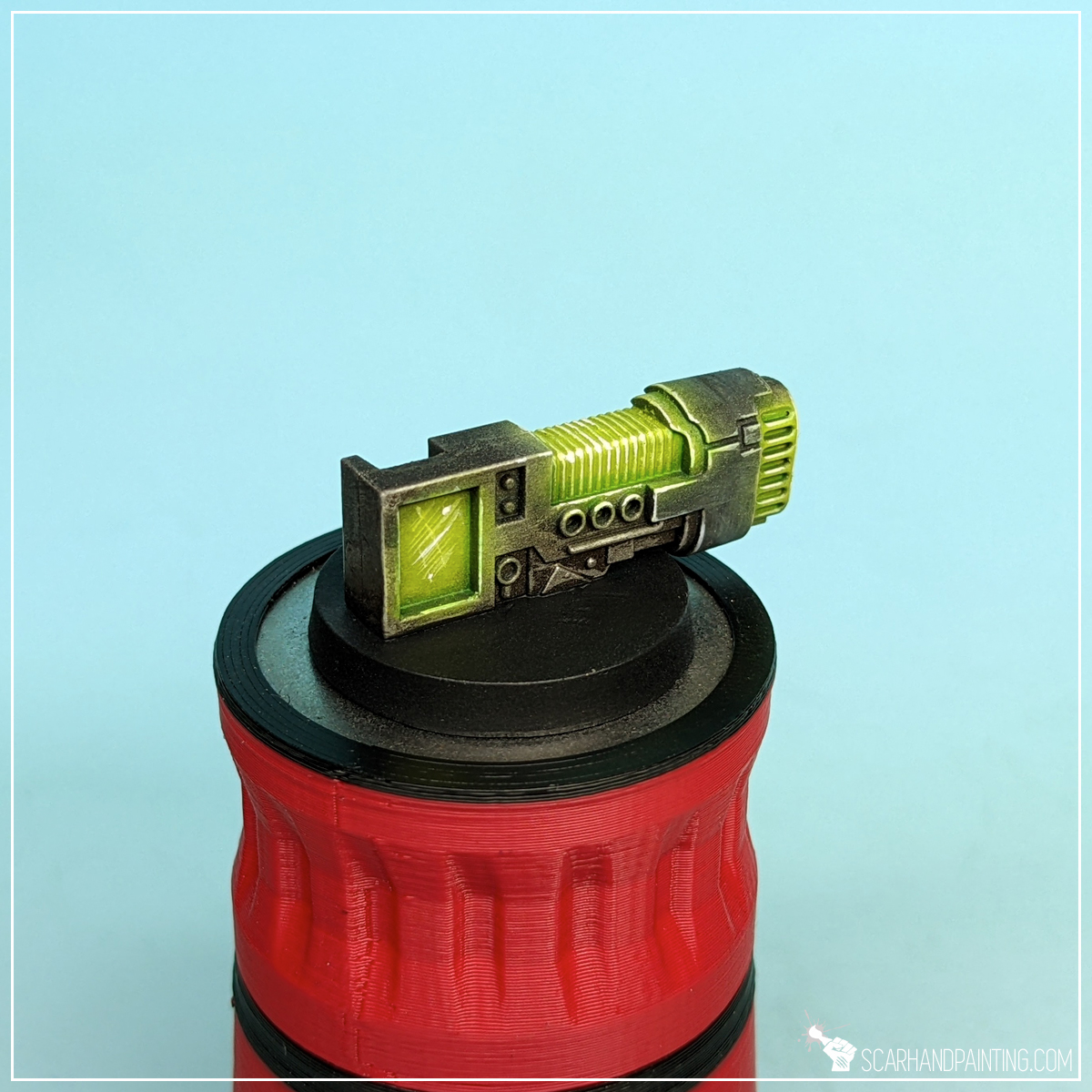
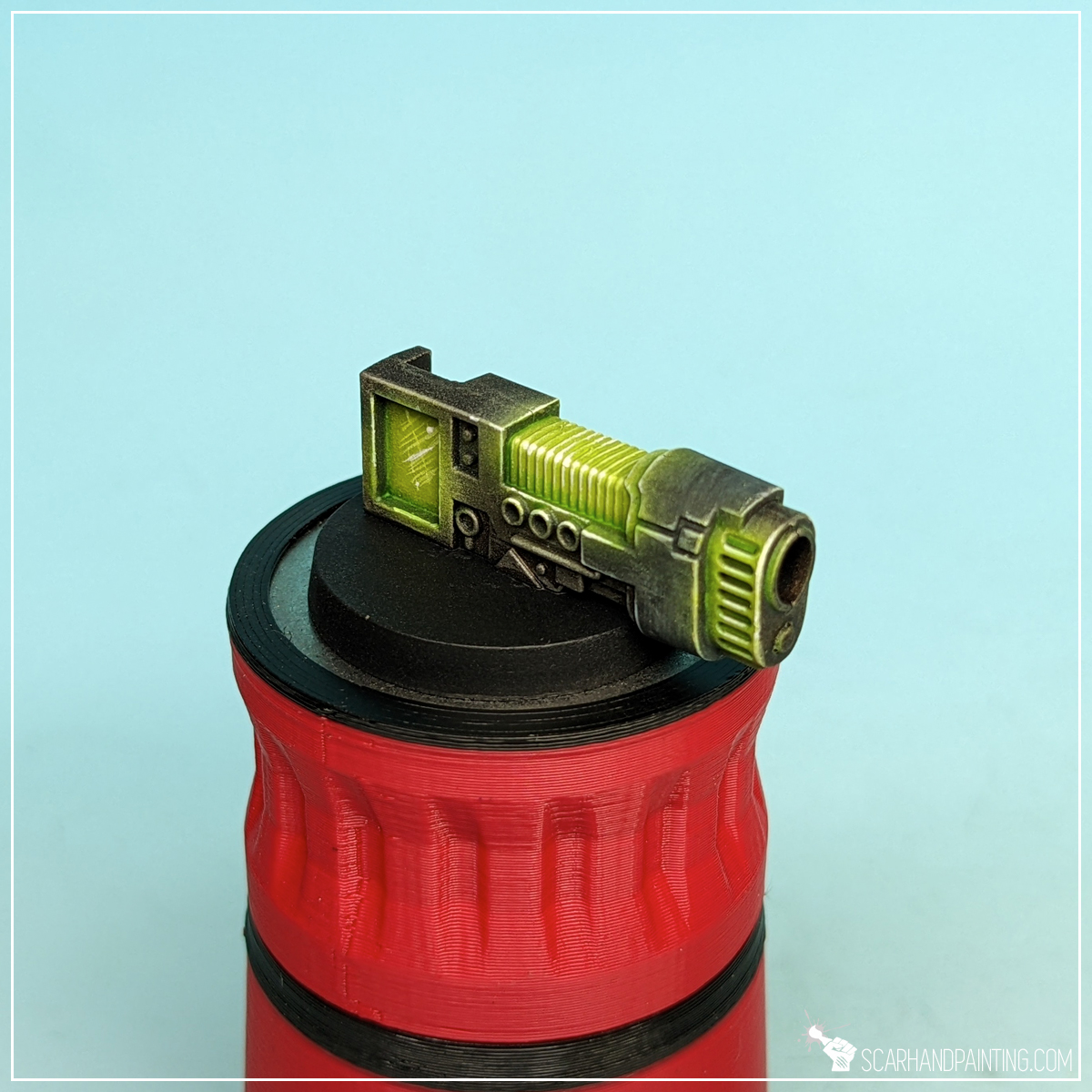


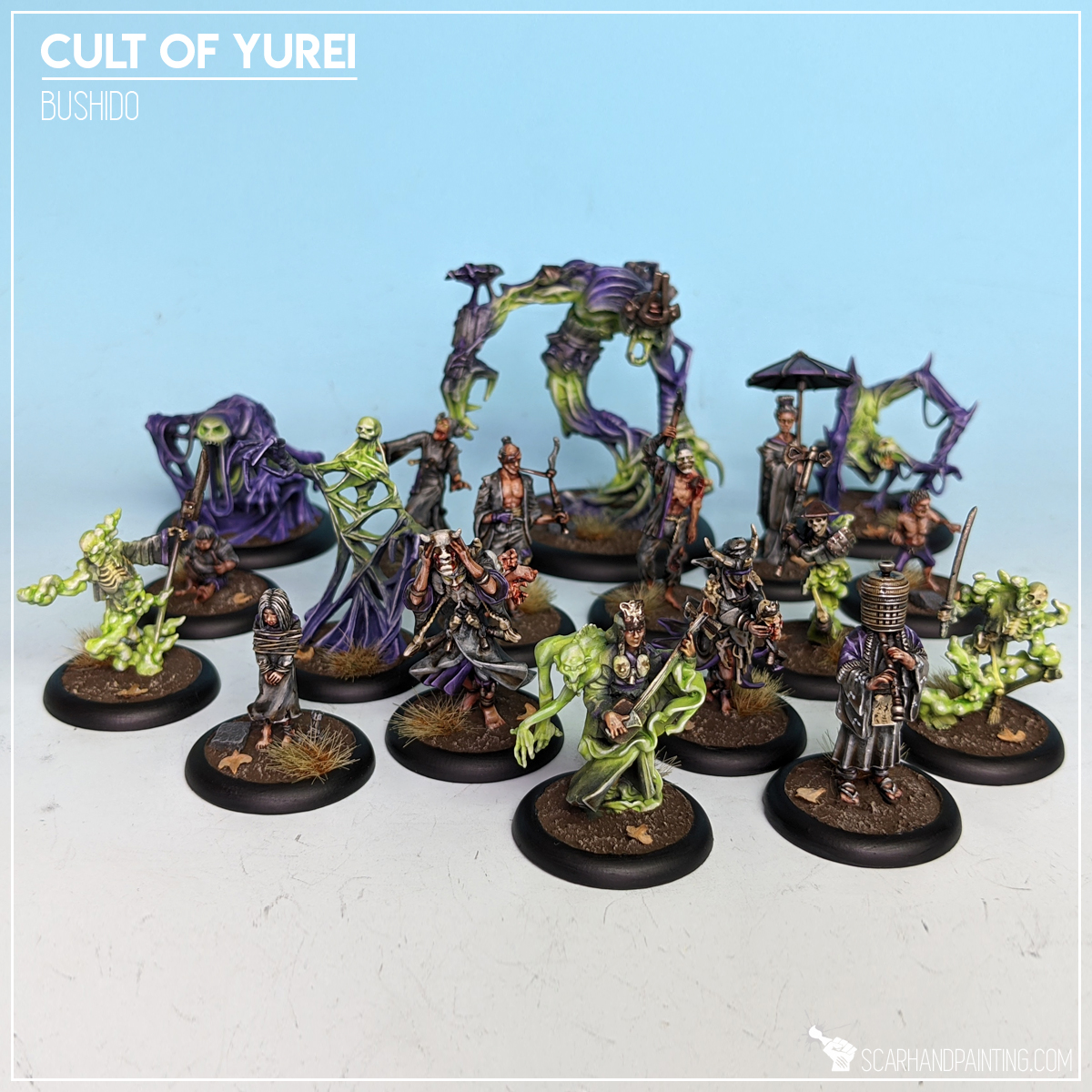
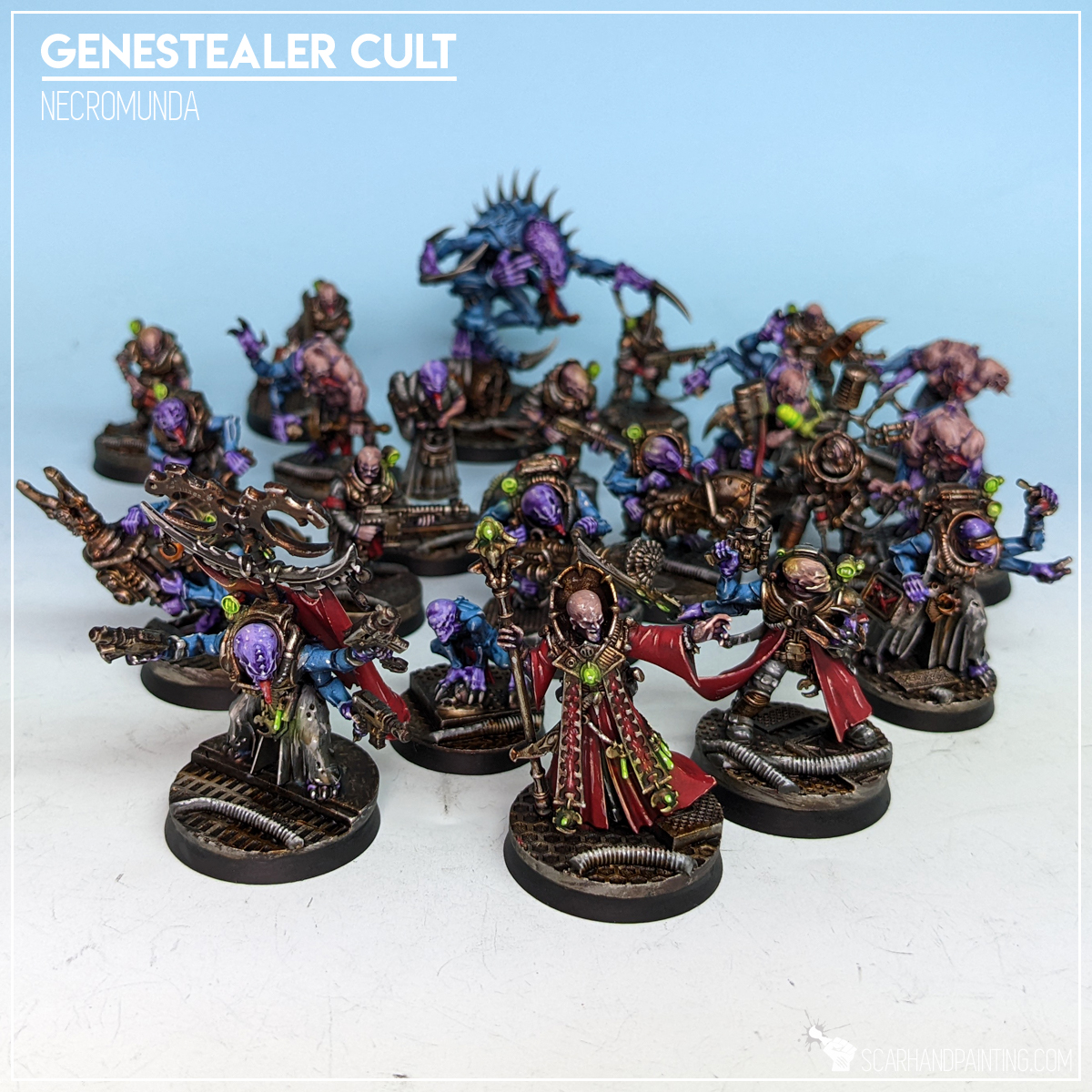

I hope you find this tutorial interesting. Be sure to let me know your thoughts in the comments below or via Facebook or Instagram. I would also appreciate if you considered sharing this content with your friends, who might find it useful. Finally if you are looking for a professional warhammer 40k miniatures painting service, be sure to contact me with this contact form. I always reply within 24 hours, after which please check out your spam folder.

As a full time professional miniatures painter I strive to specialize in techniques that provide the maximum effect on the gaming board, while being relatively simple and easy to mass duplicate. Here I will present to you a Step-by-step guide to painting orange glow effect similar to that used on my Games Workshop Crimson Fists army as can be seen in Gallery: Crimson Fists.
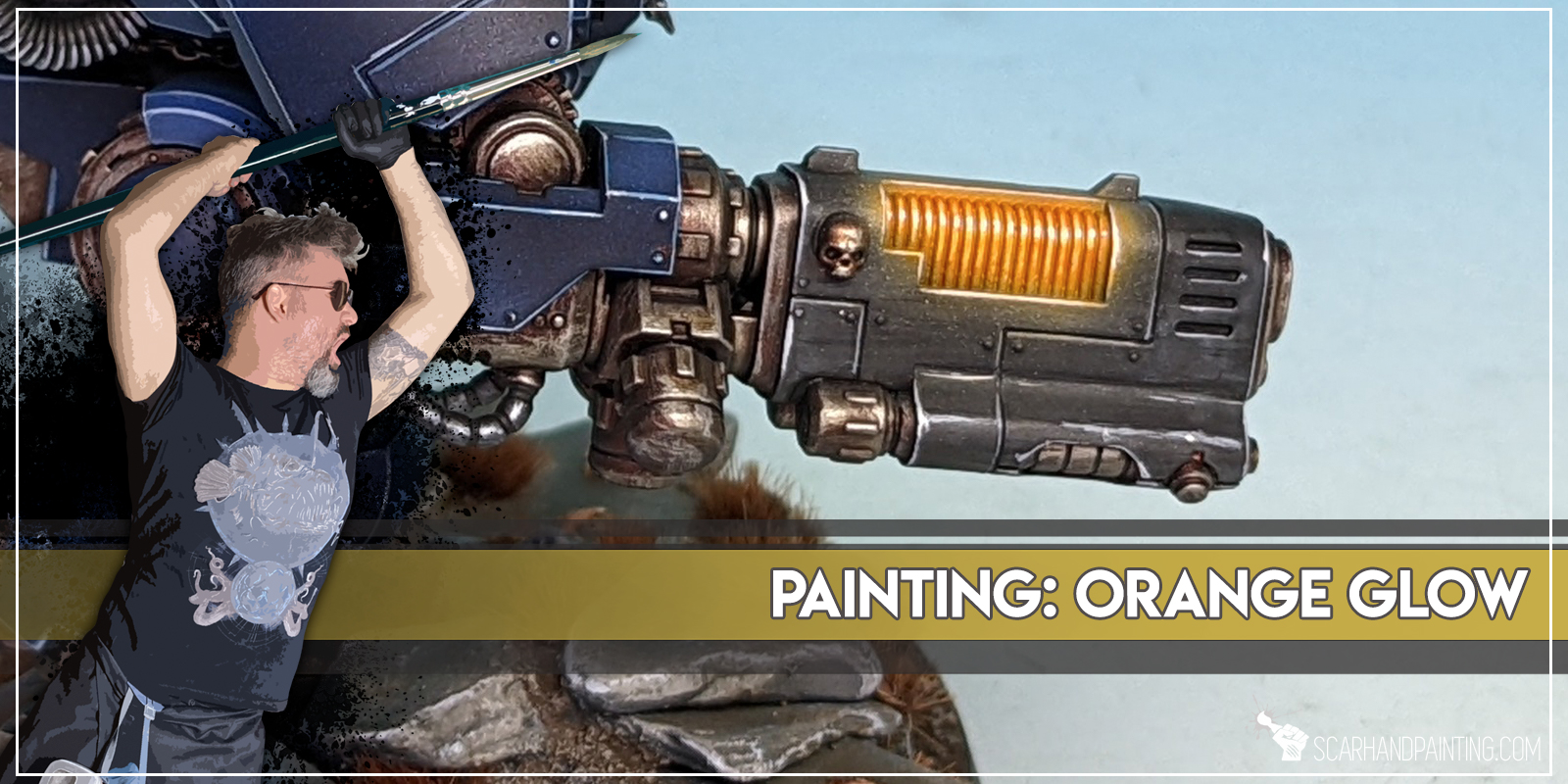
Before we start, some notes:


Step one: White preshade
I started with a soft layer of airbrushed Vallejo 72.701 Dead White (air). For the purpose of this tutorial I went straight from the bottle, although usually I thin the paint down just a bit with a drop of Flow Improver and a drop of Airbrush Thinner, resulting in less speckling. While airbrushing I made sure to cover potential light source areas plus the surroundings.
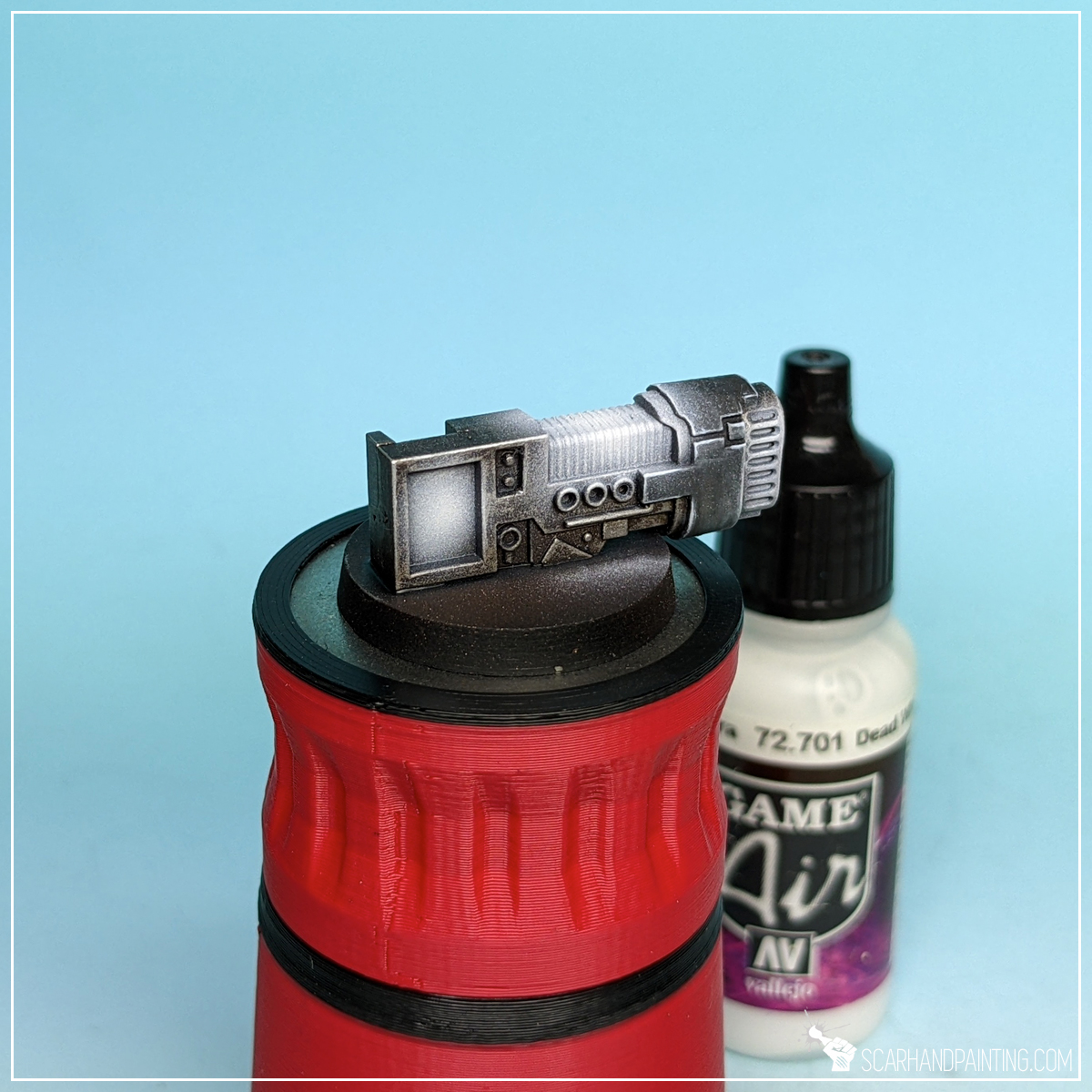
Step two: Orange base
Next I airbrushed a layer of Vallejo 72.709 Hot Orange (air) without thinning. This layer was applied on top of previously airbrushed Dead White.
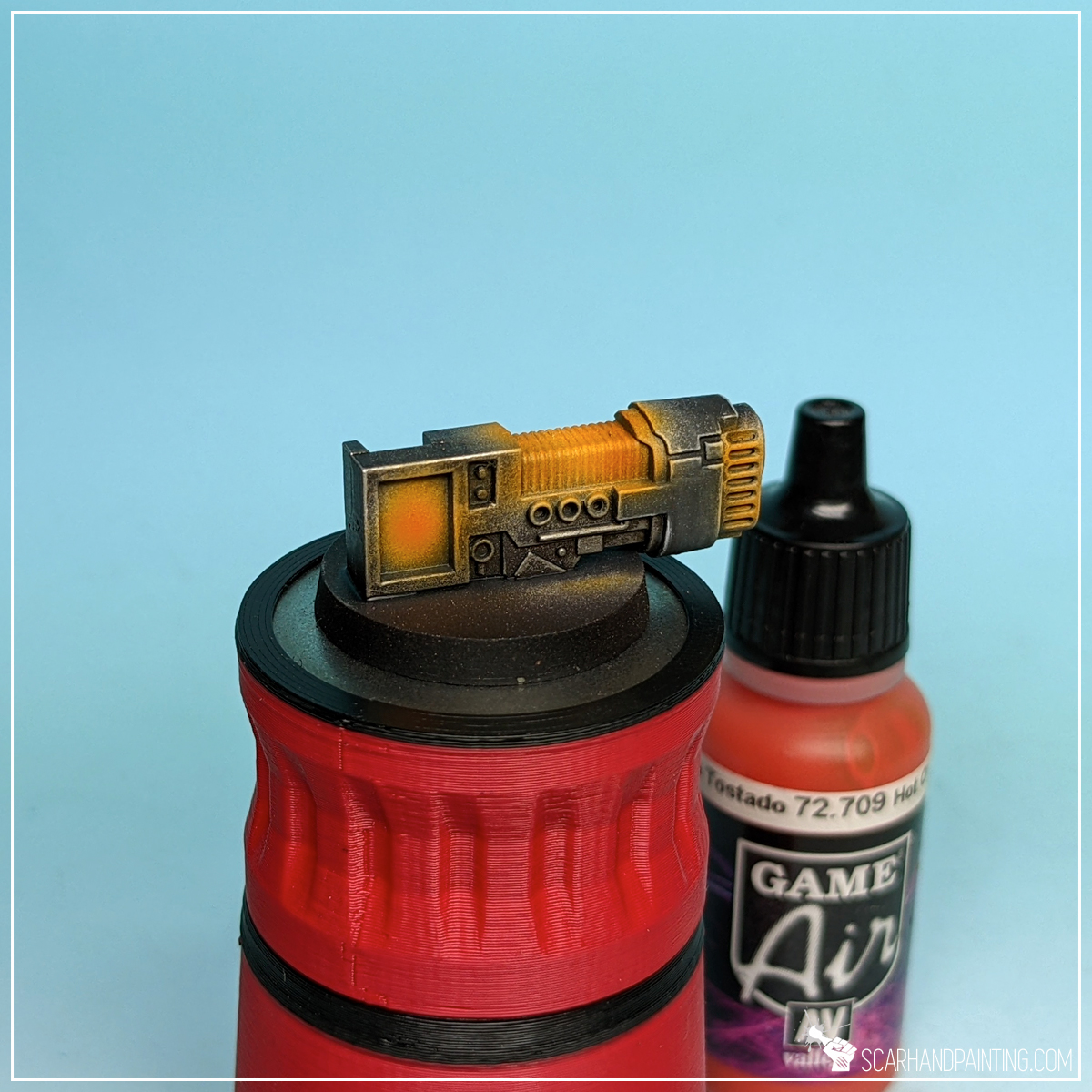
Step three: highlight
I then highlighted orange with Vallejo 72.101 Off-White. Such a bright color might seem like an overkill, but this one is a bit cream’ish and can get juiced up to bright orange easily later on.

Step four: glaze
Here’s where real magic started. I thinned down Vallejo 72.709 Hot Orange (air) with a bit of water and manually glazed over the most intense orange parts of the miniature. This includes plasma coils, glow on the side of the barrel and large rectangle area at the back. Vallejo air series are perfect for hard glazing, retaining a lot of ‘juice’ even after thinning.

Step five: highlight
Finally I once again applied a highlight of Vallejo 72.101 Off-White, but this time limited to barely few dots and lines in the most exposed areas. This created focus points for the eye, while also providing better overall contrast on the piece.
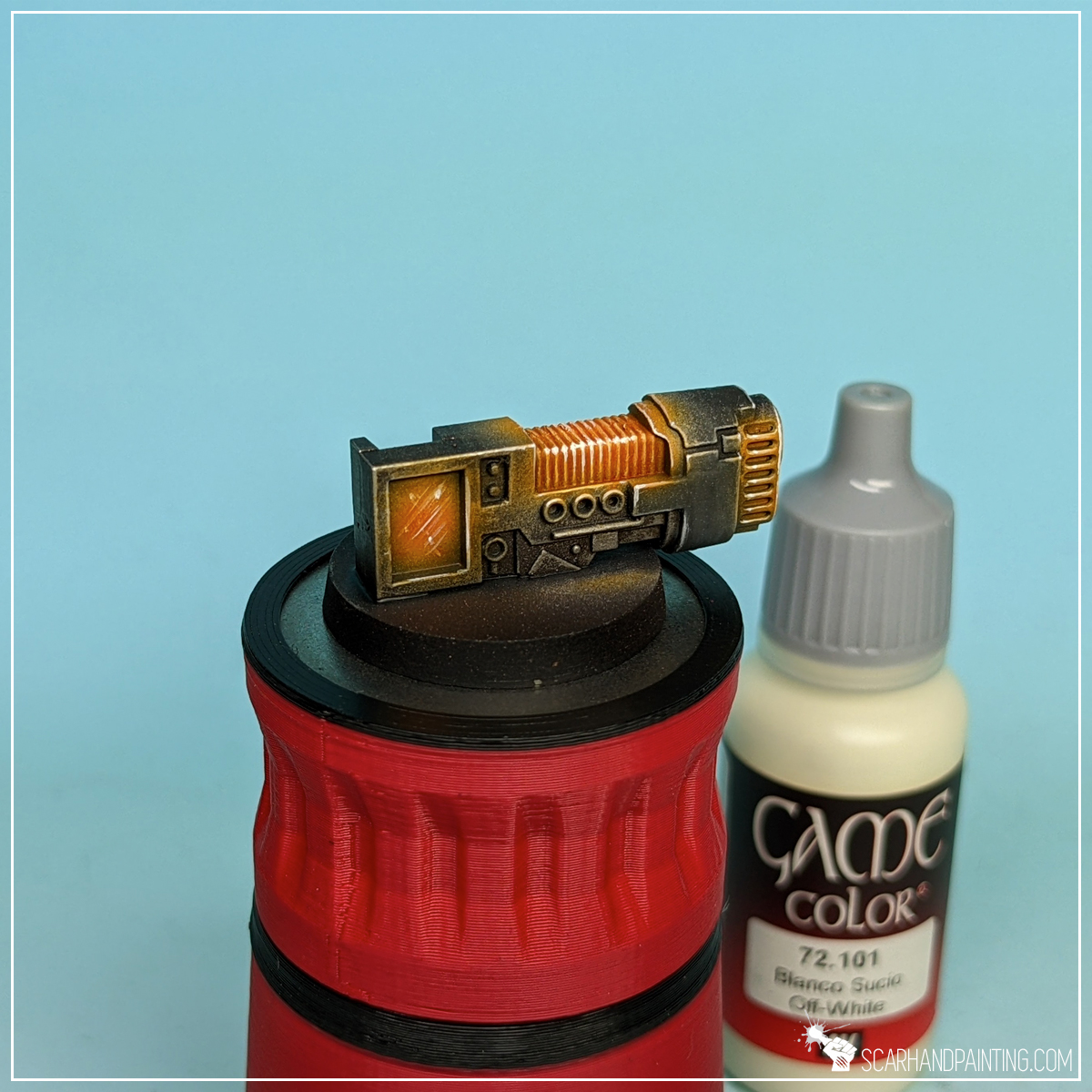
Job done. Three colors, five layers is all it takes to achieve an interesting effect that will steal a glance or two on the gaming board.
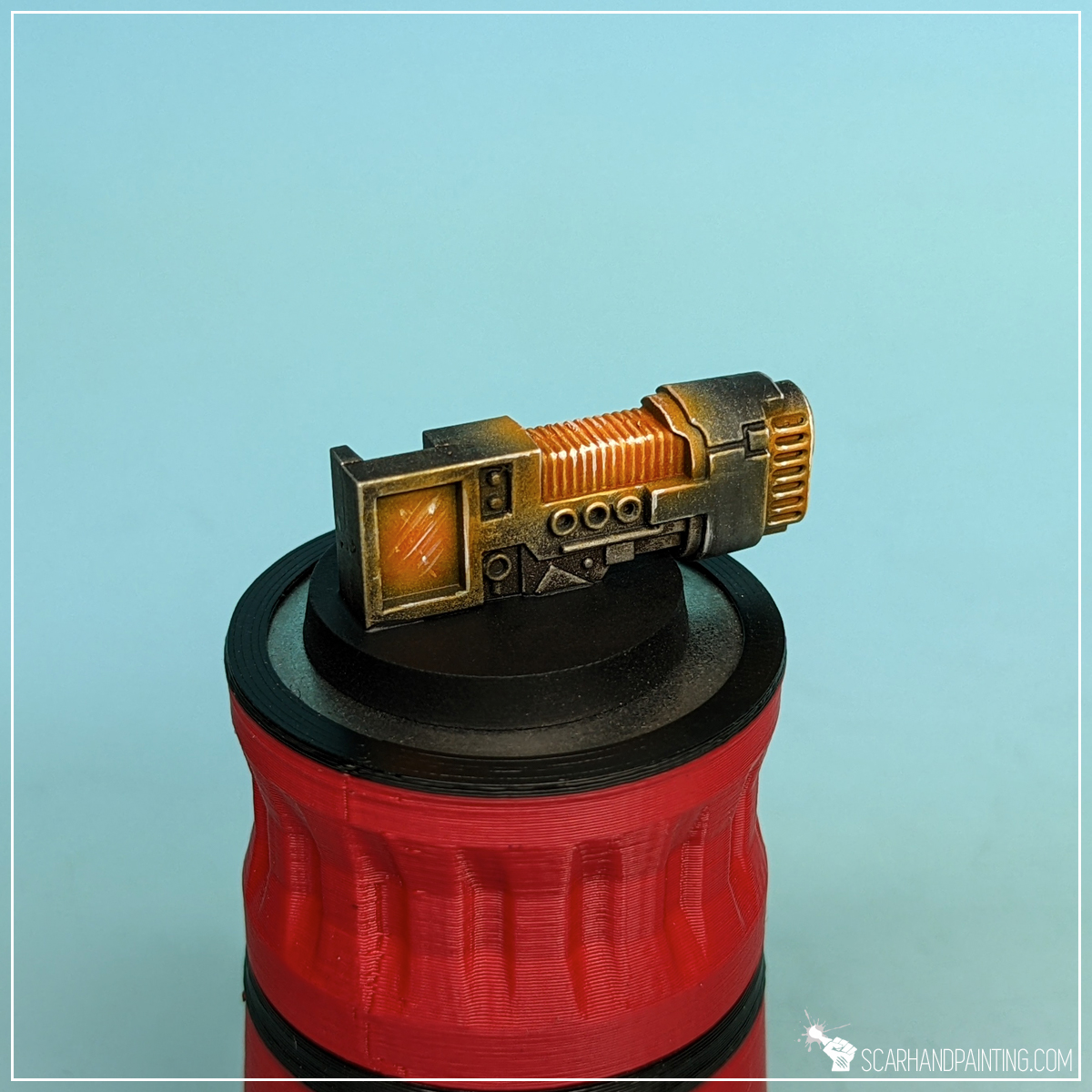
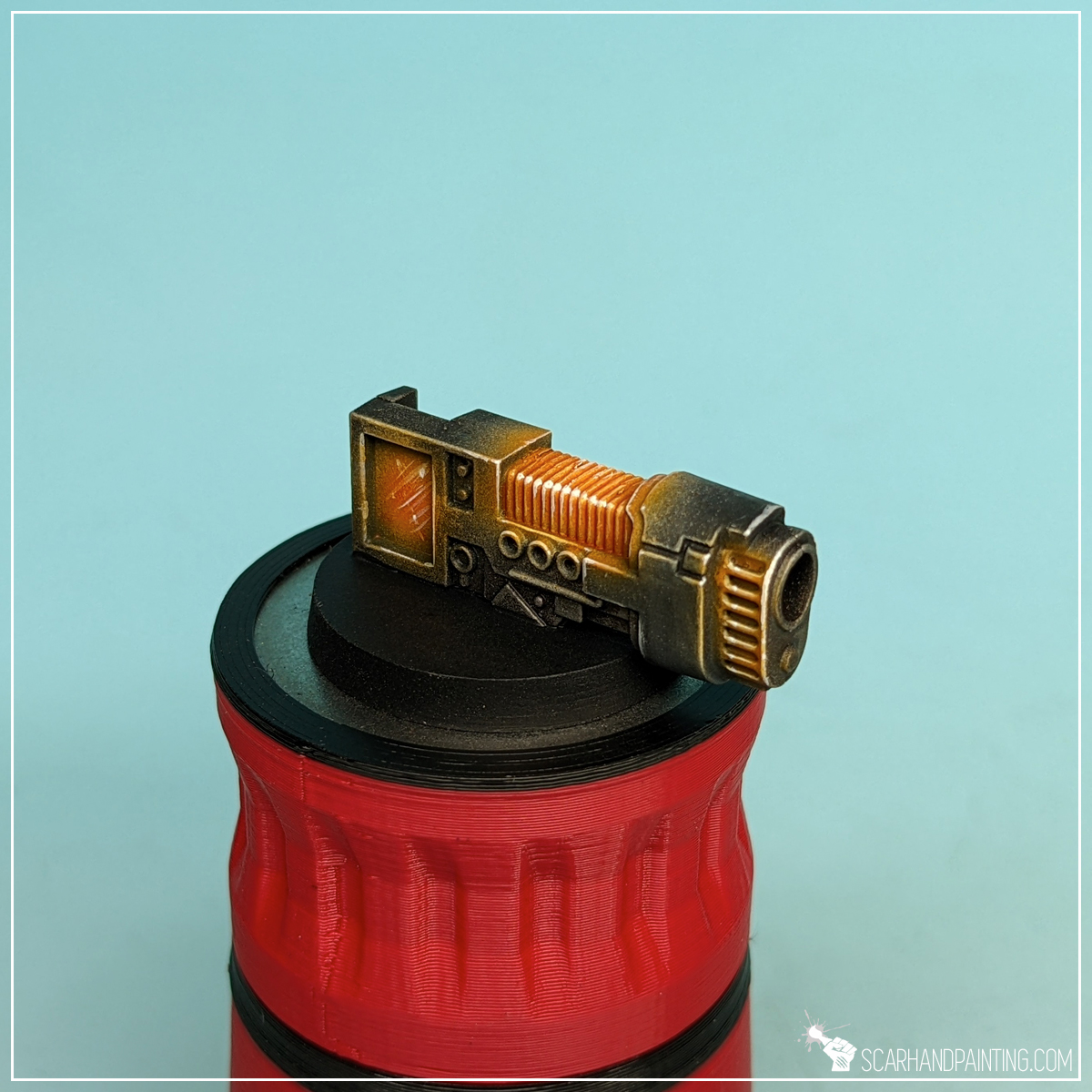
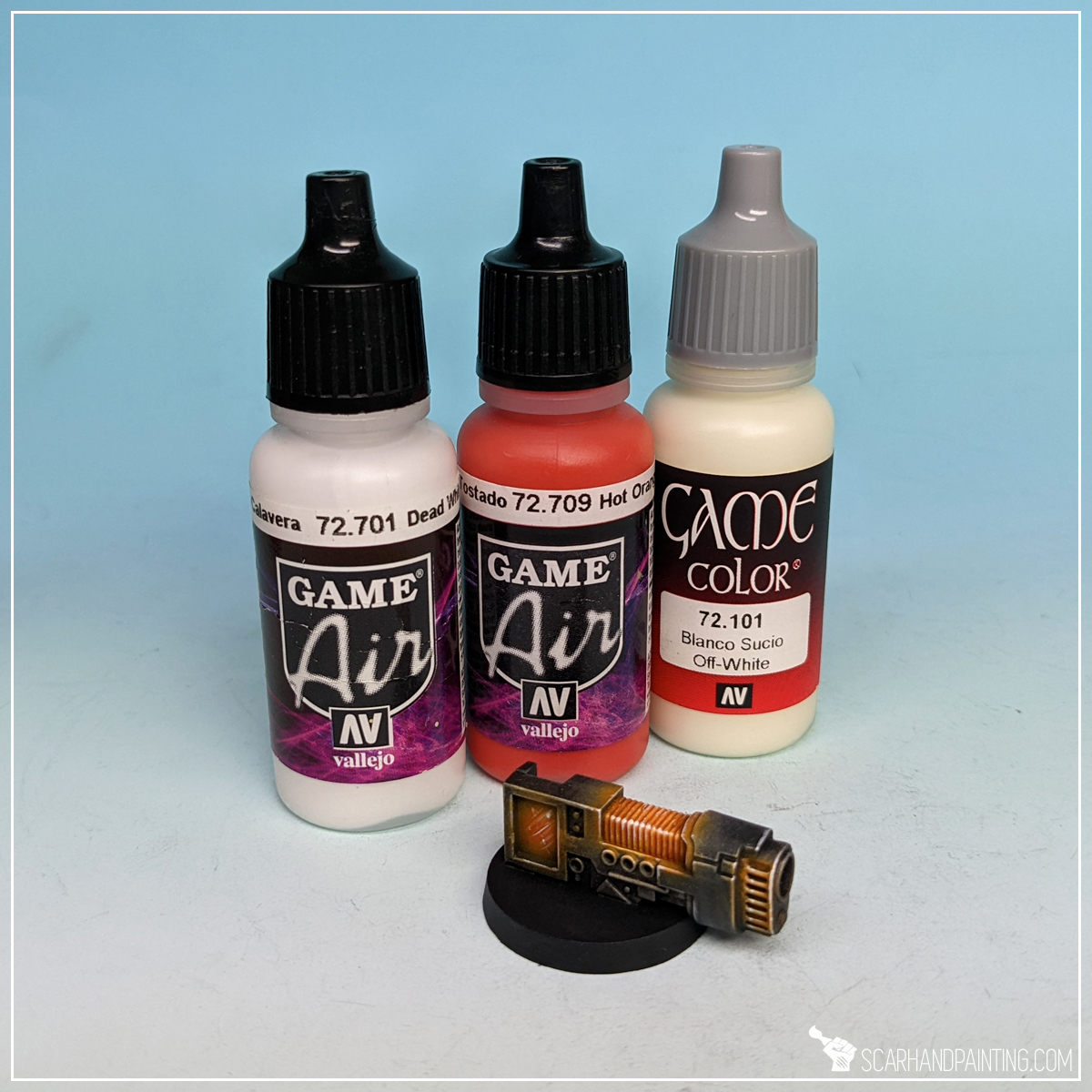
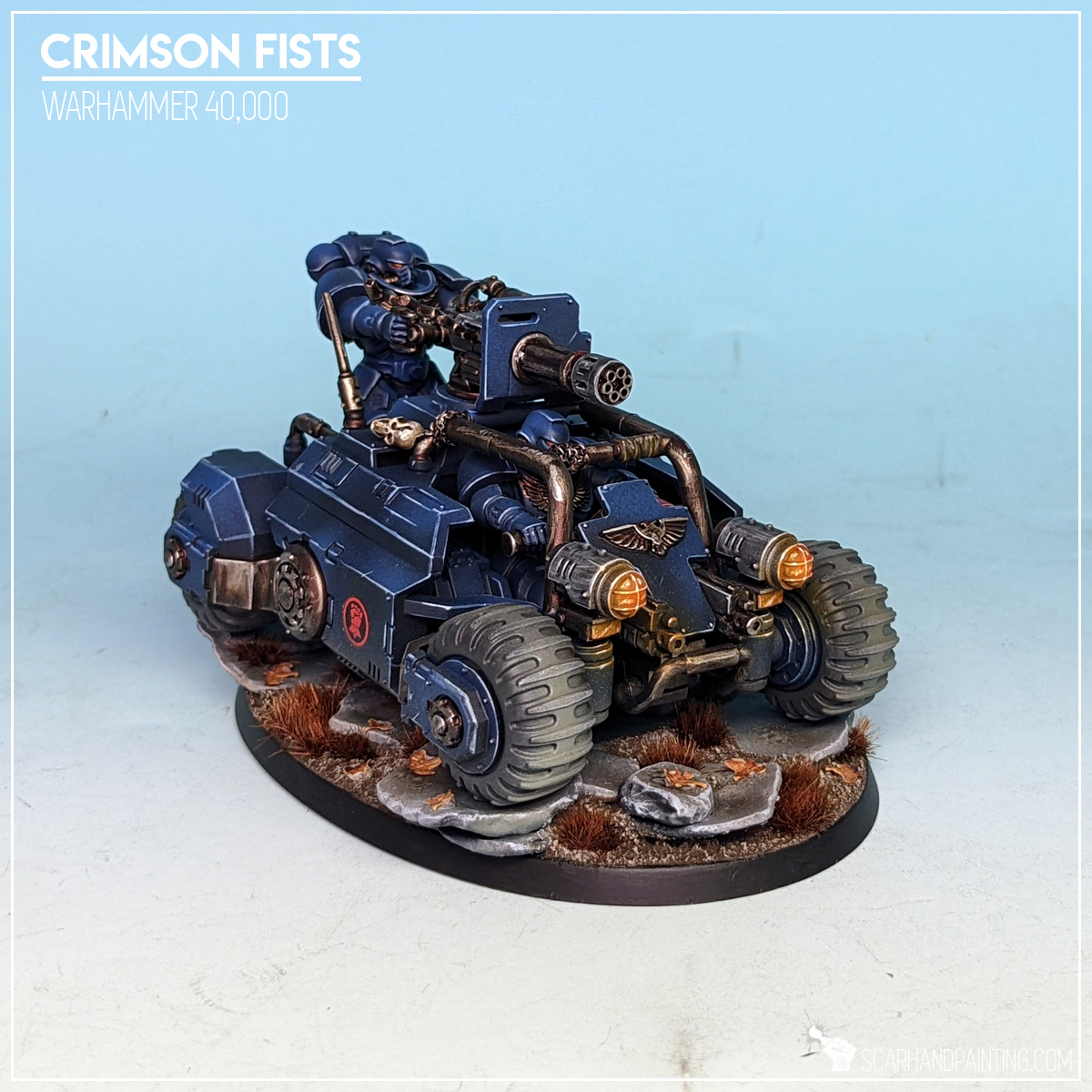
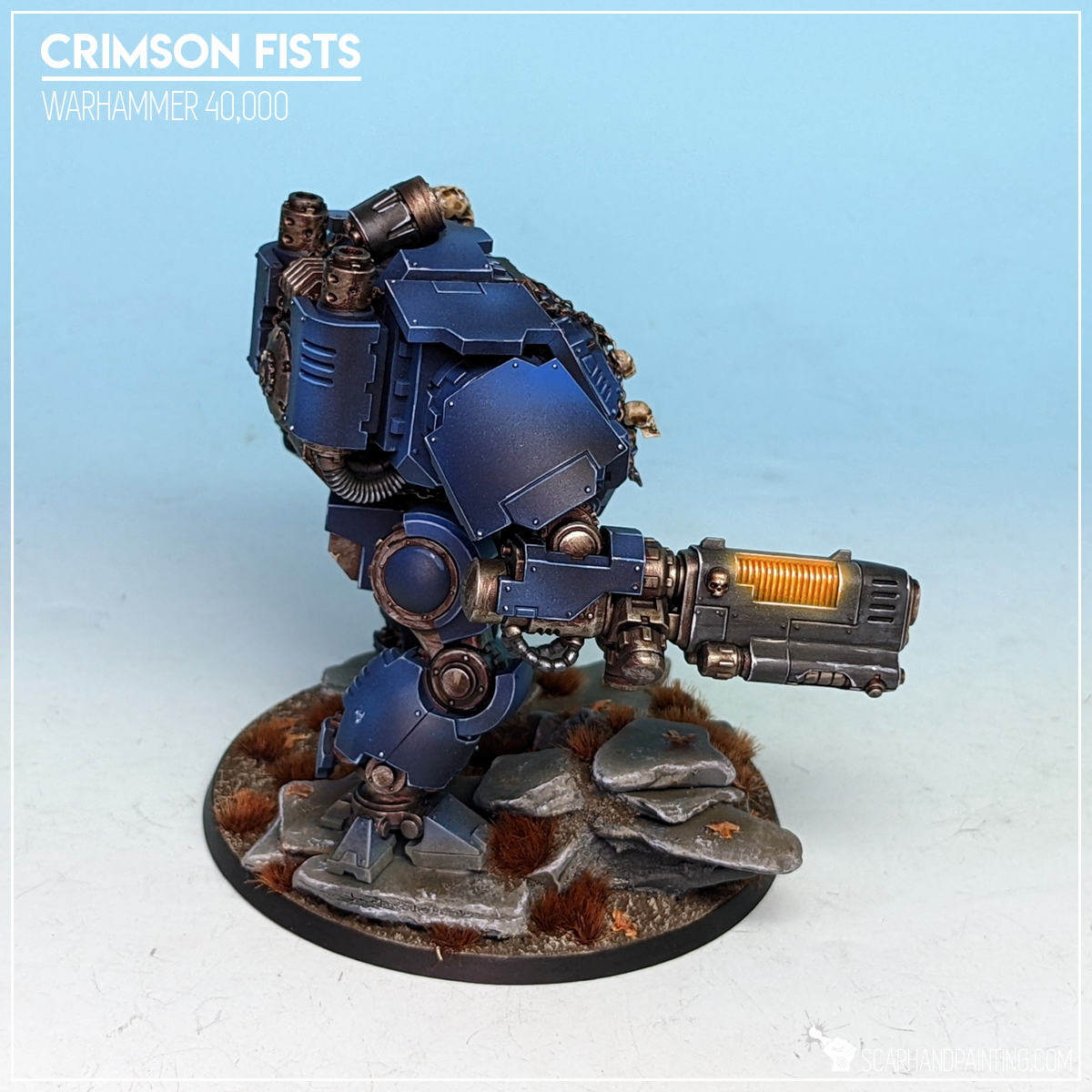


I hope you find this tutorial interesting. Be sure to let me know your thoughts in the comments below or via Facebook or Instagram. I would also appreciate if you considered sharing this content with your friends, who might find it useful. Finally if you are looking for a professional warhammer 40k miniatures painting service, be sure to contact me with this contact form. I always reply within 24 hours, after which please check out your spam folder.

Welcome to tutorial for modelling Flames. Here I will present to you a Step-by-step guide on how to create fantastic, highly detailed flames for miniatures in a matter of seconds.
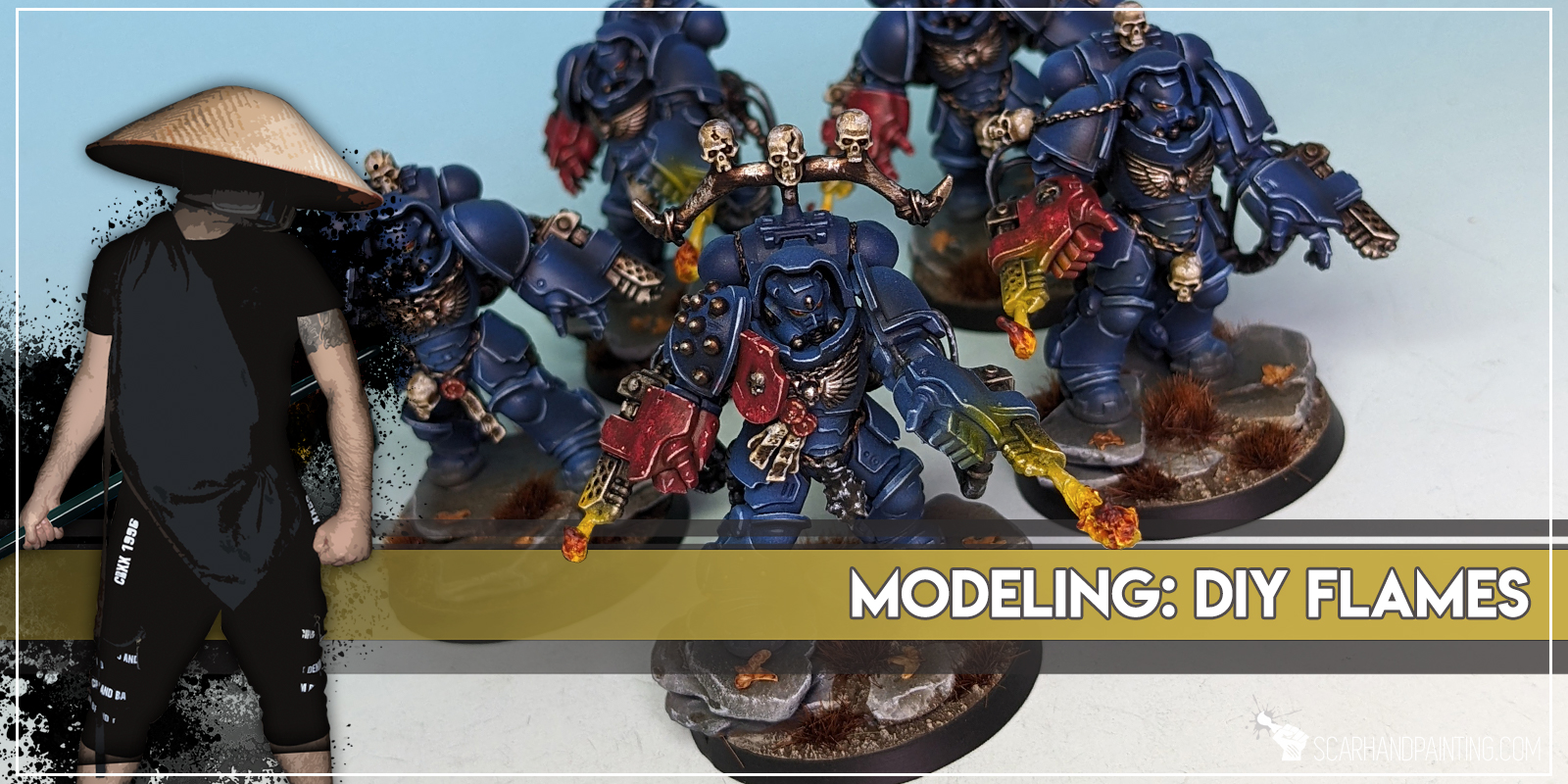
Blazing flamethrowers, crackling braziers, torches or balls of magical fire – in the world of miniatures wargames flames add a lot of character and dynamic to our favorite tiny characters. With 3d printing prevalence and a lot of bitz selling companies getting your hands on some awesome parts has never been easier. Still why pay and wait, when you can make your own flames of chosen size and shape in a matter of seconds and from materials you probably already have at home!
Before we start, as usual, please take note that what works for me might not necessarily work for you.
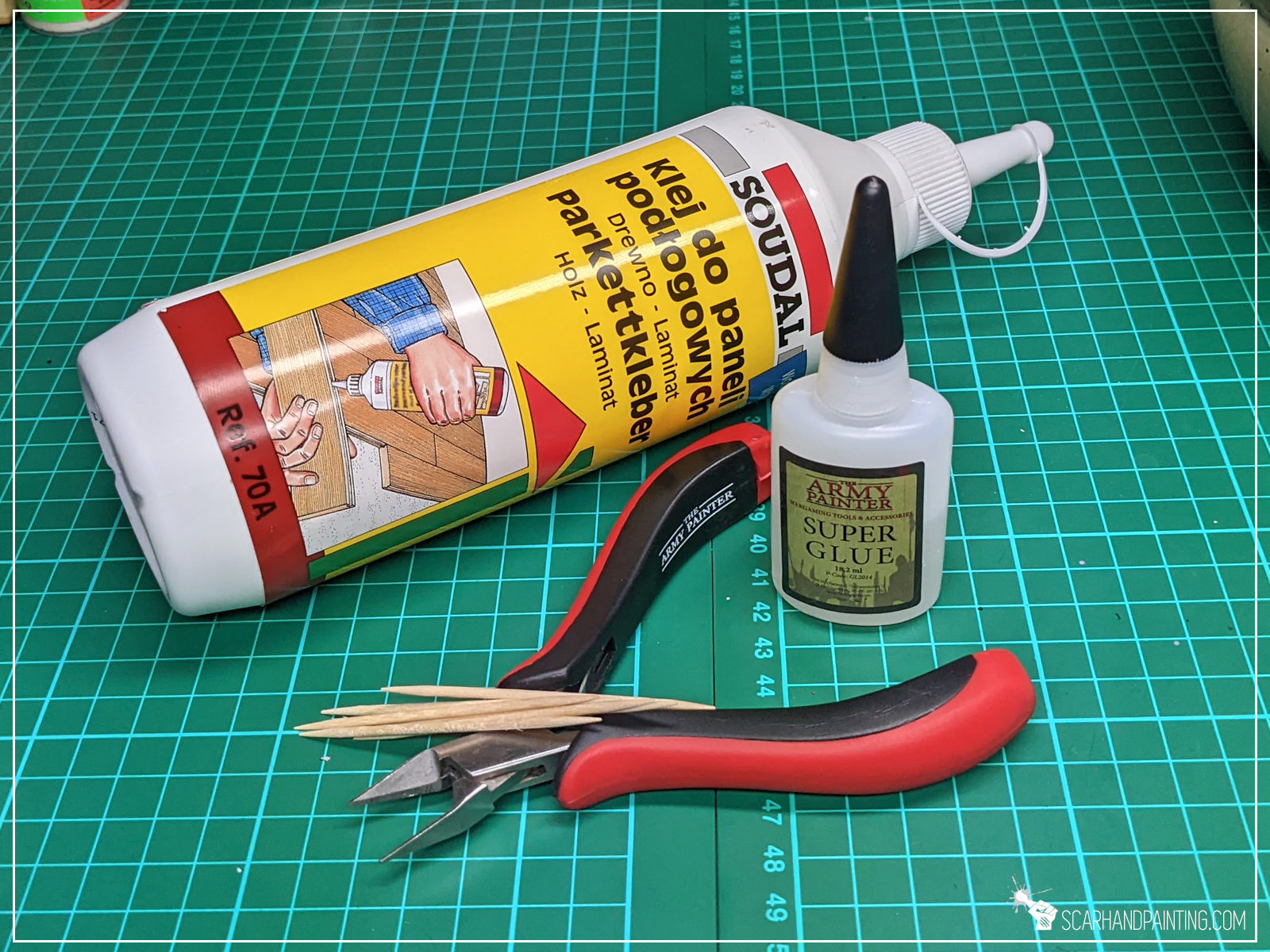

Step one: Foundation
It is best to start by finding a base shape to build the flame around. It can be anything solid including toothpick, wire, piece of plastic, or even the miniatures themselves. In this case, with an idea of flames gushing out of a flamethrower, I cut a small piece of a toothpick.

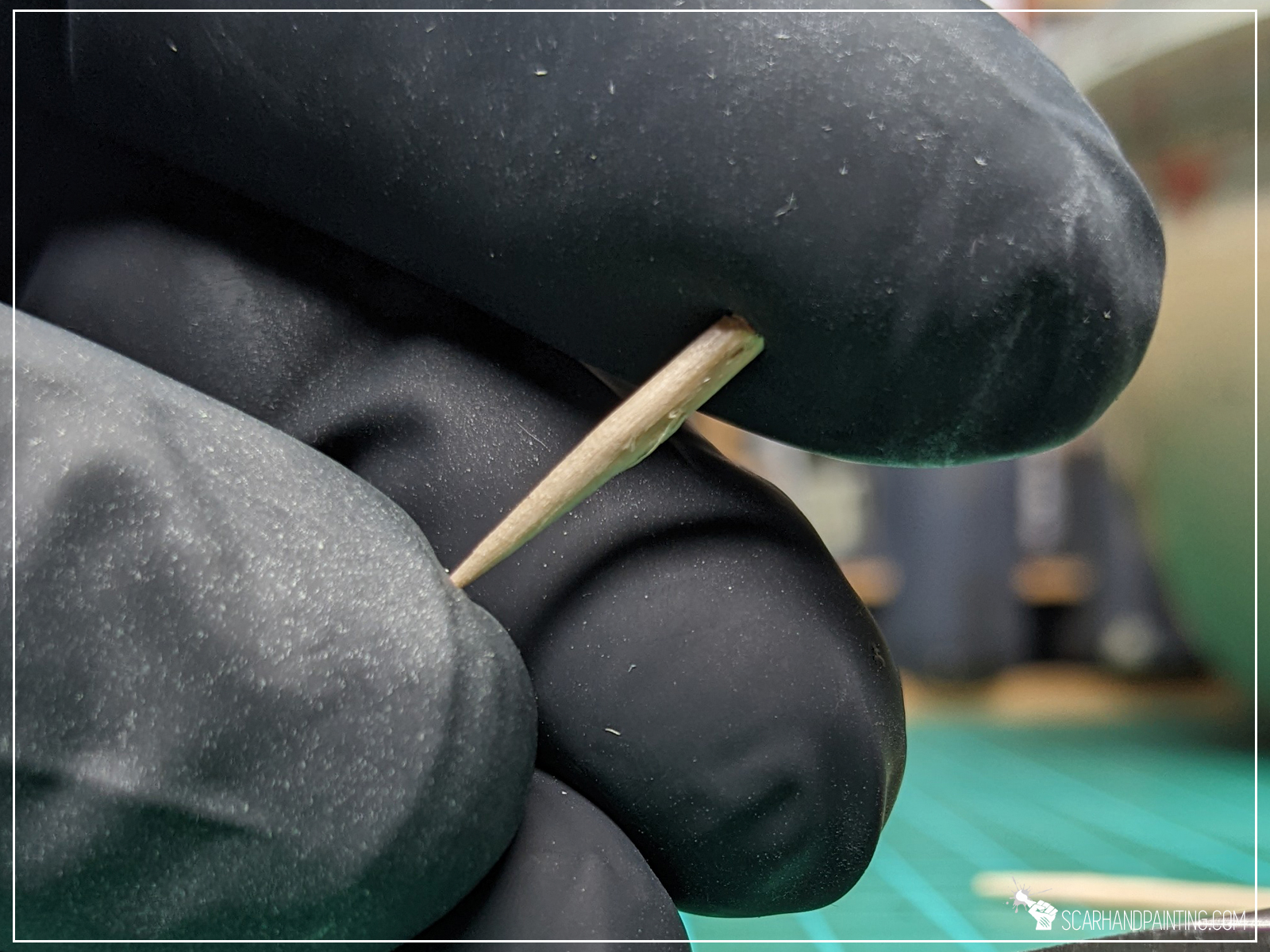
Step two: Ingredients
Next I poured few small drops of PVA glue onto the piece of toothpick. Just enough to cover the wider end. Right after that, while PVA was still wet, I poured Super Glue on top and moved the shape around so that Super Glue covered entire PVA beneath.
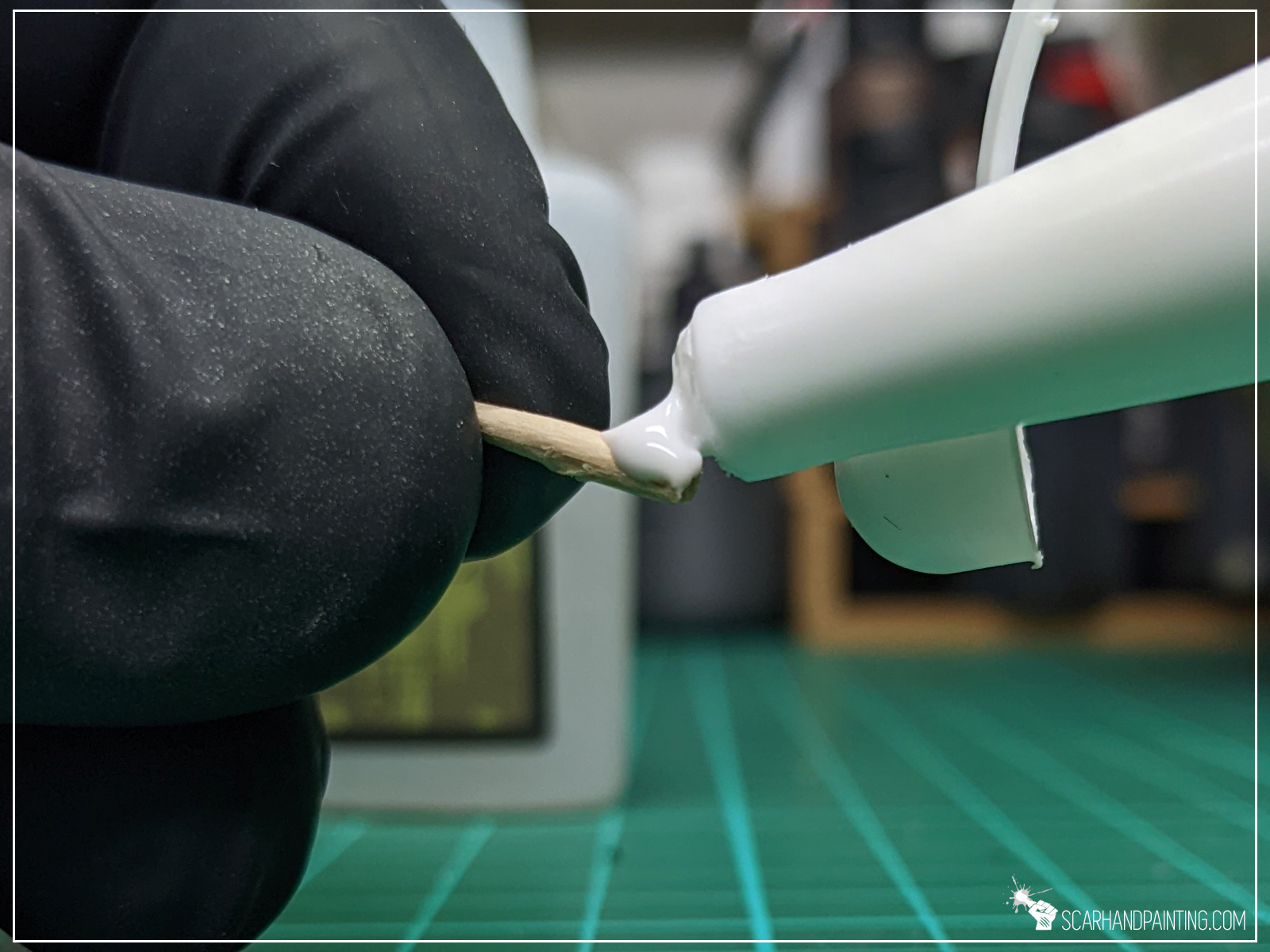
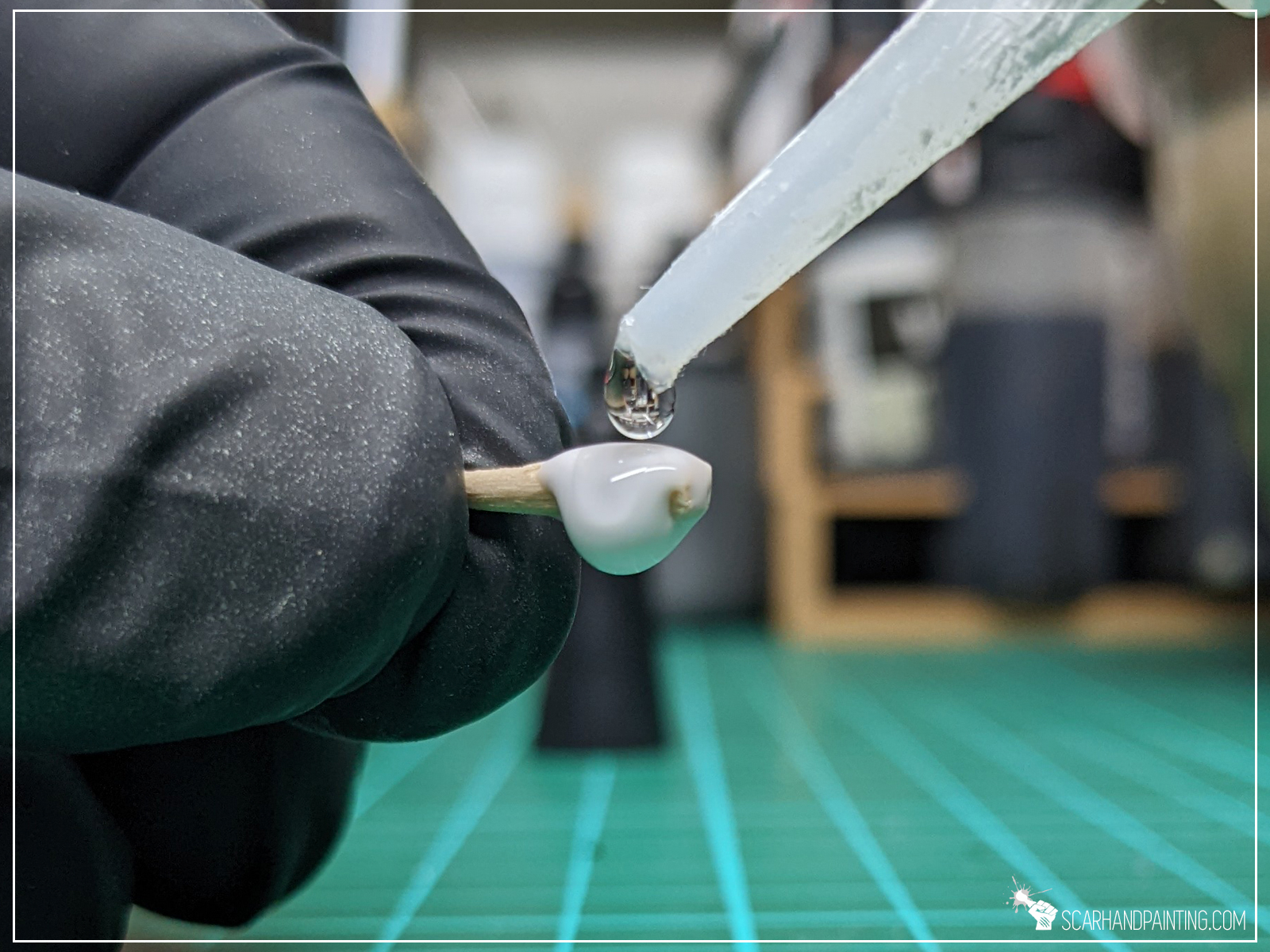
Step three: Shape
Here’s where modelling kicks in. I used another toothpick to mix both glues and guide a quickly hardening ‘paste’ around and finally in one direction to form a cone. The mix creates an organic, irregular texture when drying, which provided additional detail to the flame.
It might seem difficult at first, but once you get how the ‘paste’ behaves it will be as simple as barely few moves of a toothpick to get a desired cone.

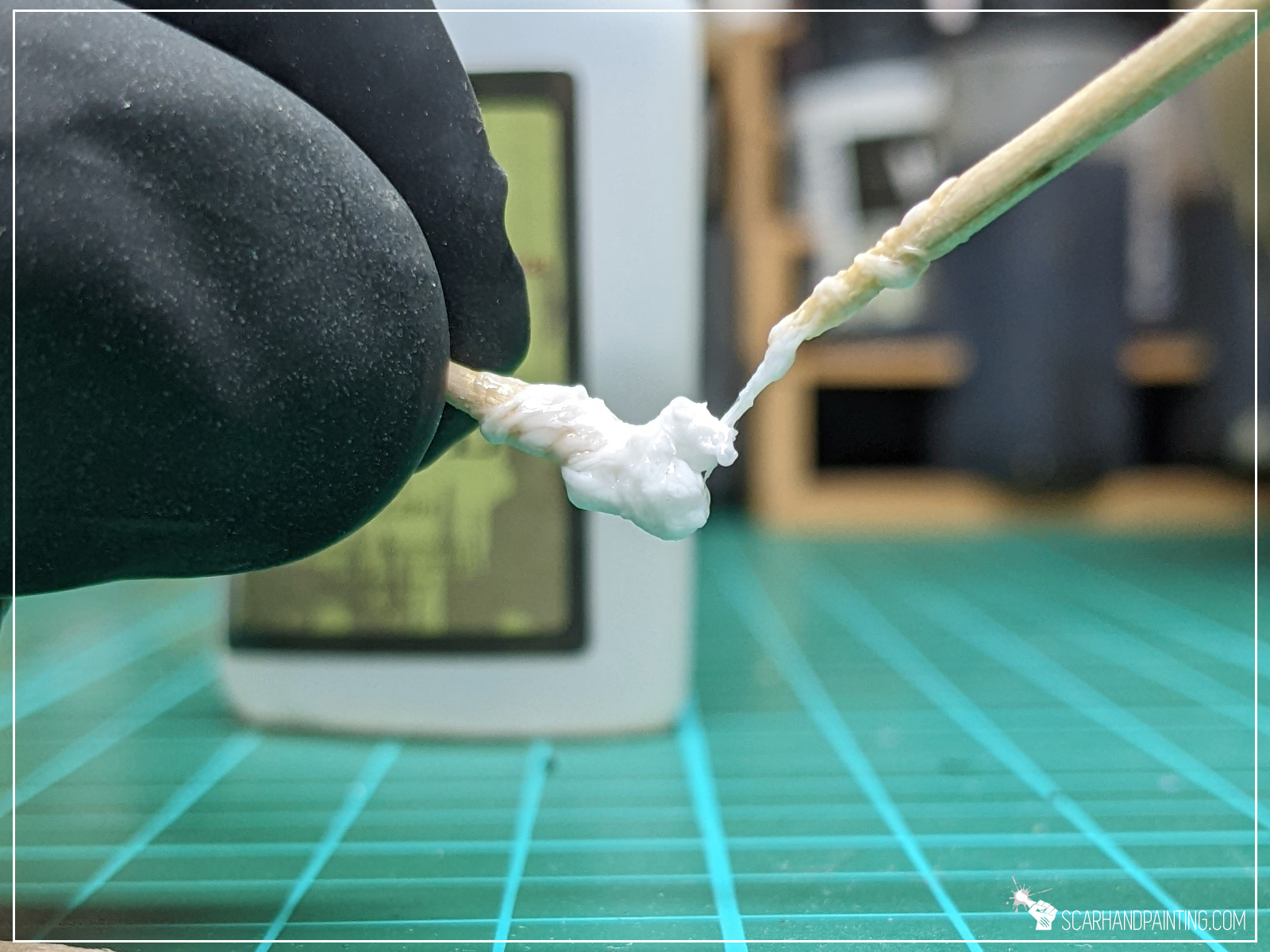
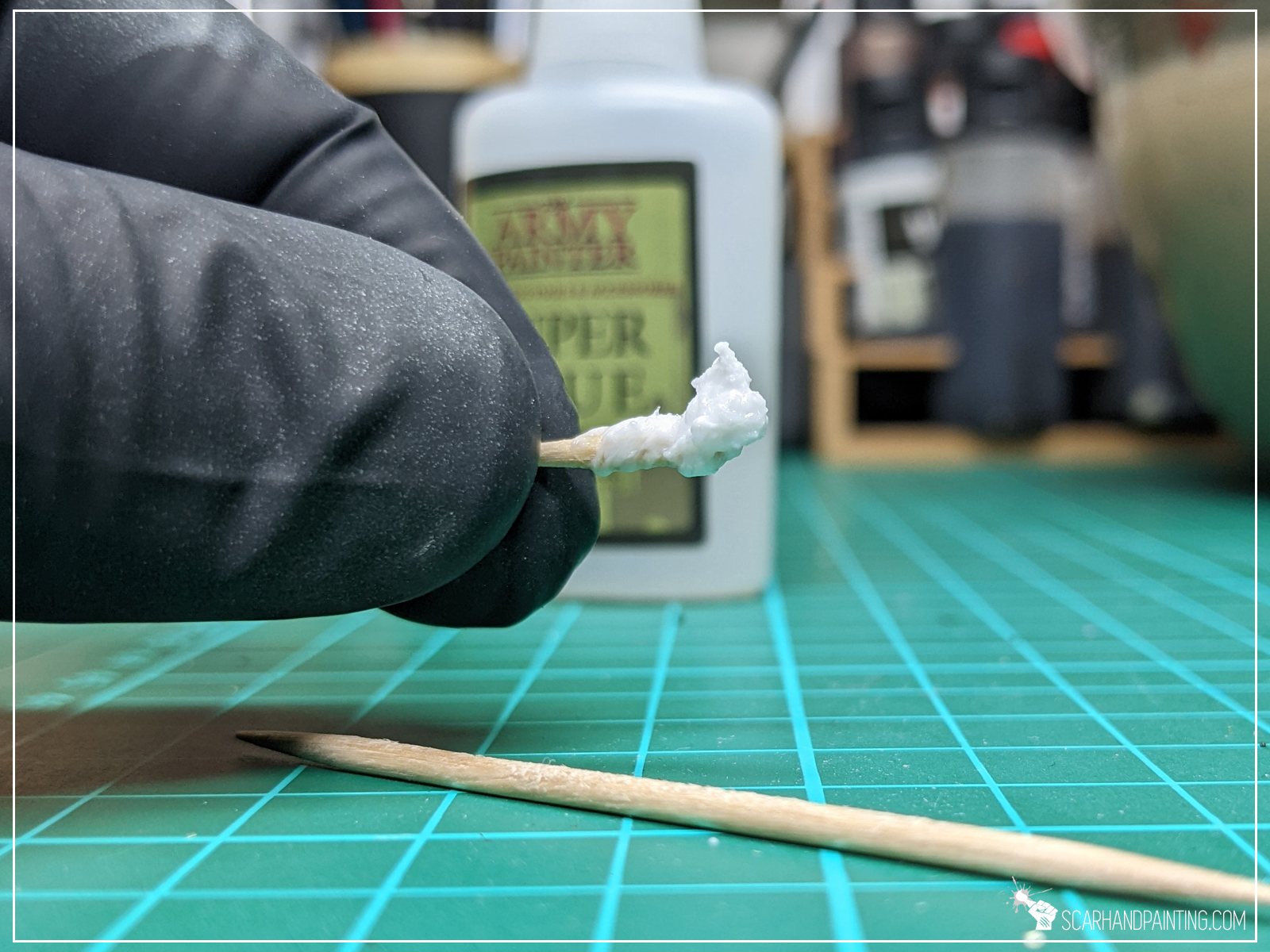
Three steps, that’s all it takes. With a bit of practice the process takes less than a minute and can be applied to any surface. Below are just some examples of the results:
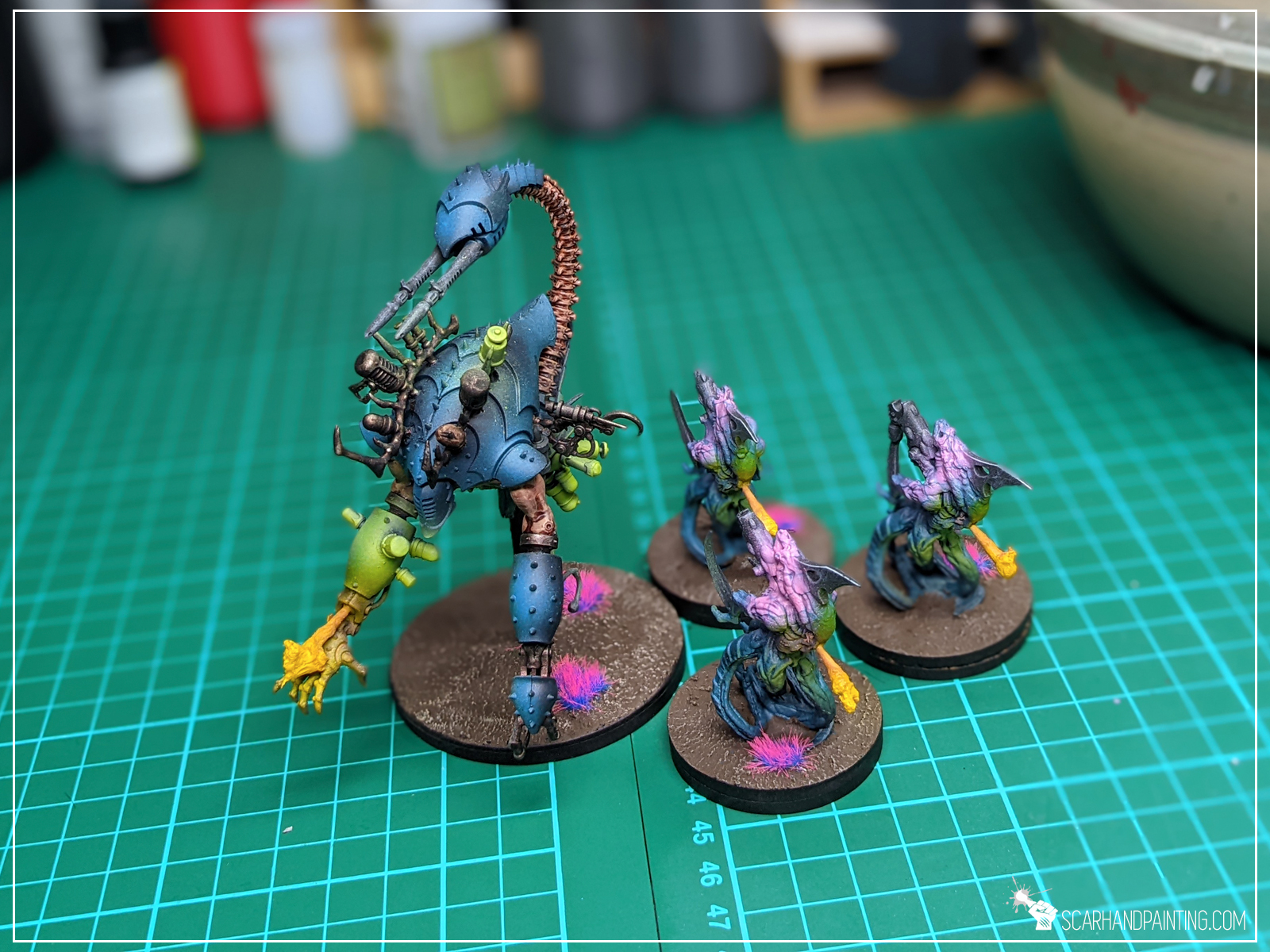

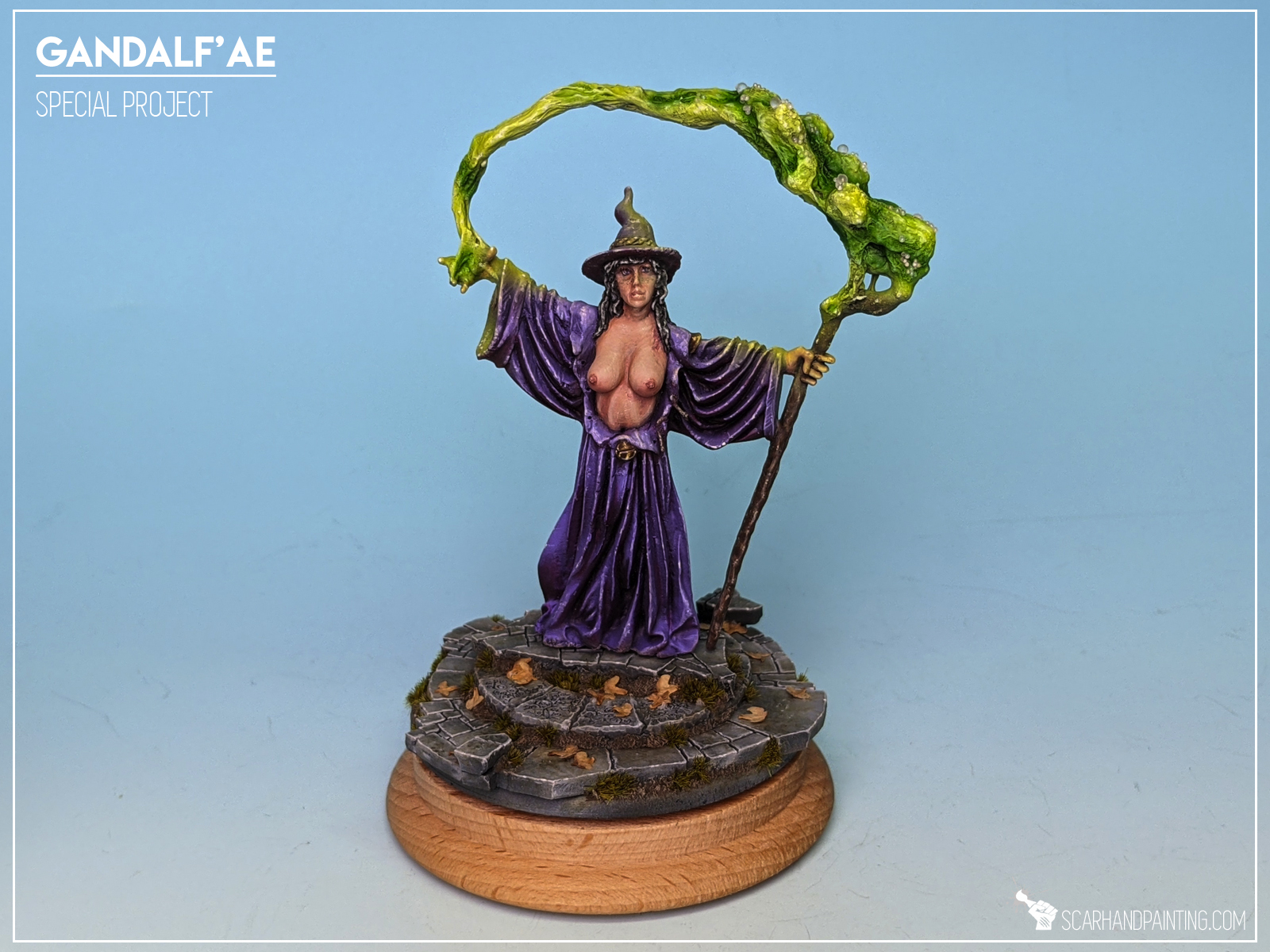
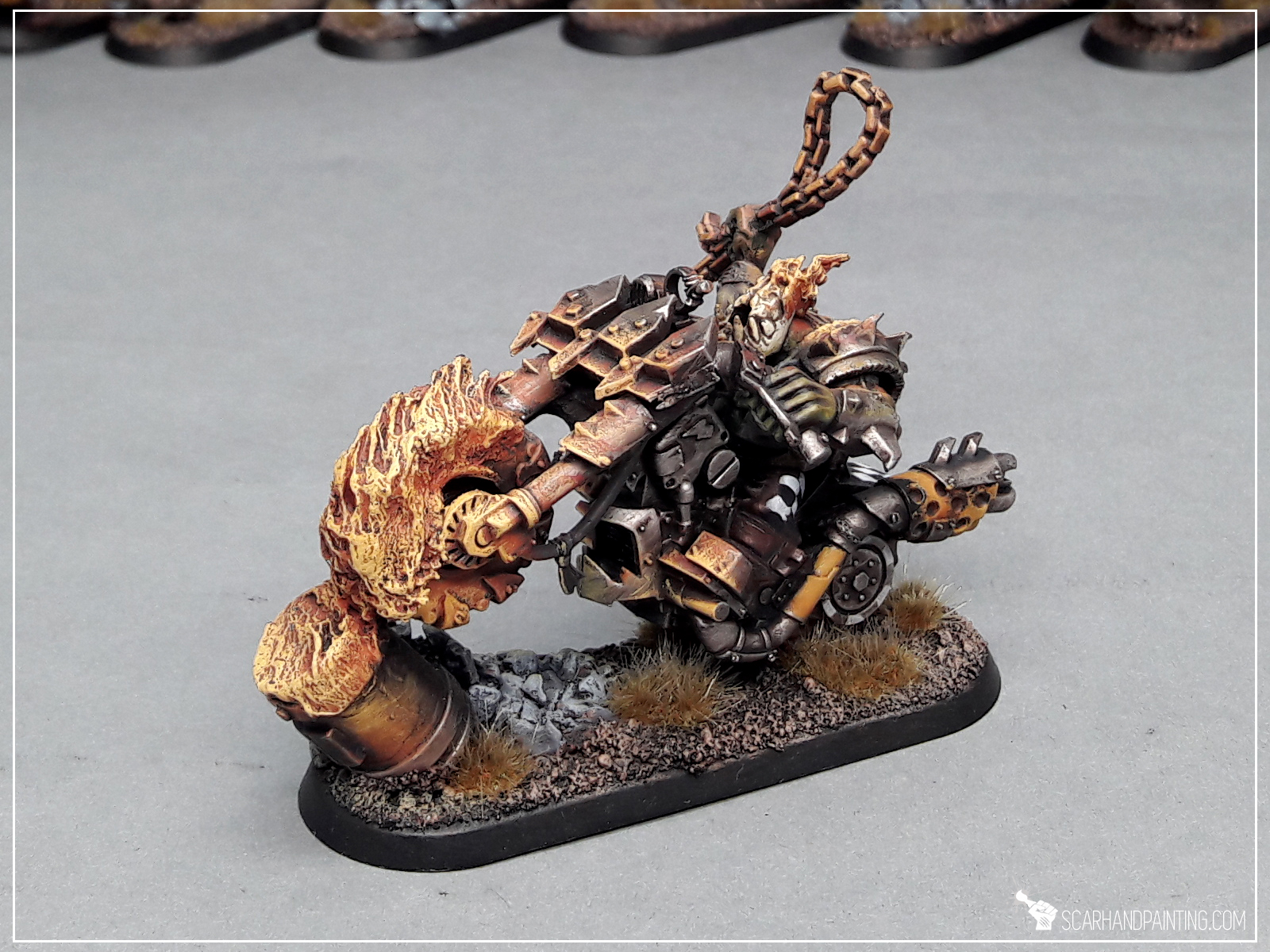
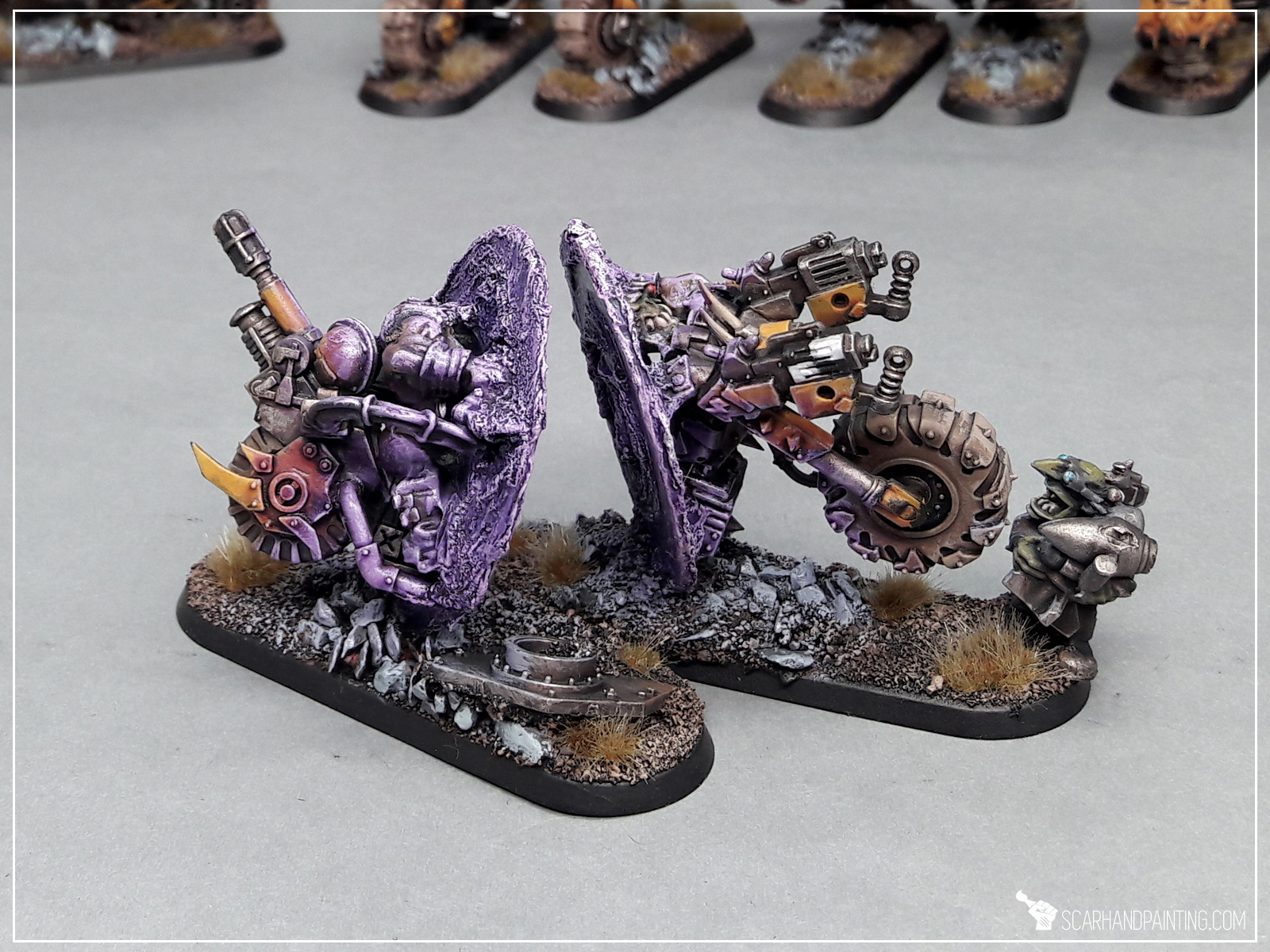
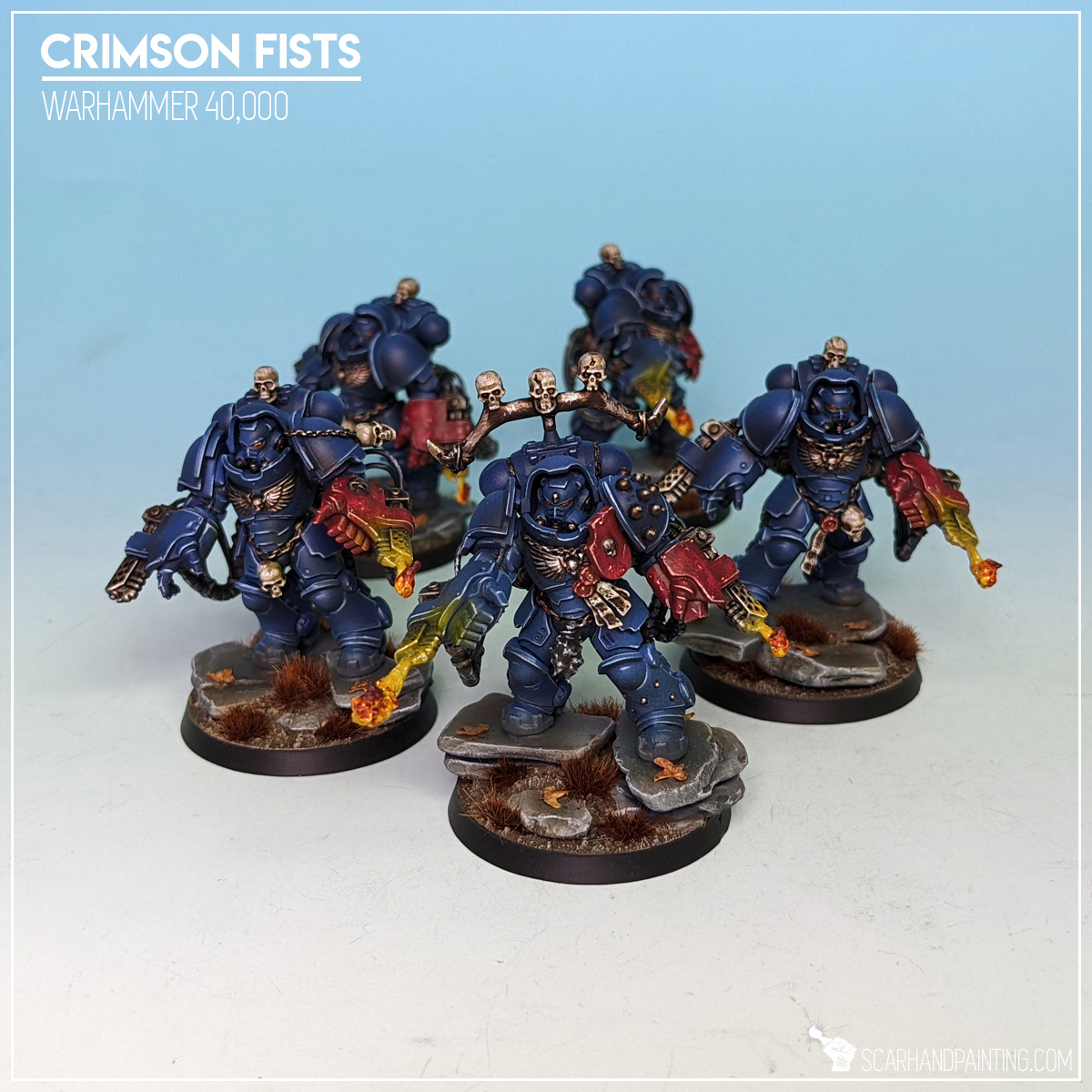

I hope you find this tutorial interesting. Be sure to let me know your thoughts in the comments below or via Facebook or Instagram. I would also appreciate if you considered sharing this content with your friends, who might find it useful. Finally if you are looking for a professional miniatures painting service, be sure to contact me with this contact form. I always reply within 24 hours, after which please check out your spam folder.

Welcome to Painting Warhammer 40,000 Crimson Fists tutorial. Here I will present to you a Step-by-step of an easy and fast painting process for Games Workshop Crimson Fists Primaris Marines armor as can be seen in Gallery: Crimson Fists.
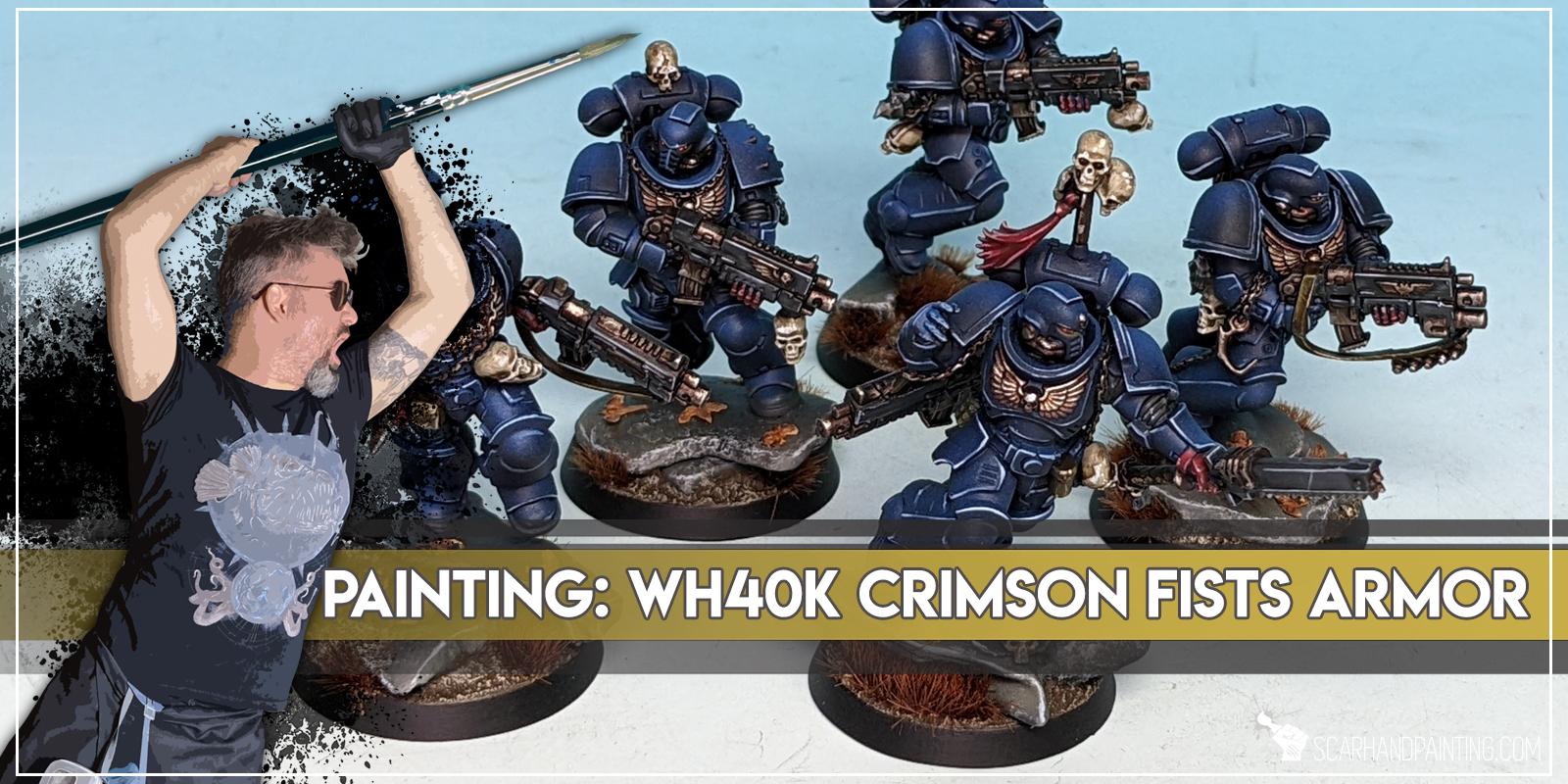
Before we start, some notes:
Step one: Undercoat
I started with a thorough layer of Games Workshop Chaos Black spray. This is a standard procedure for me. Chaos Black spray is my go to choice when it comes to undercoat.
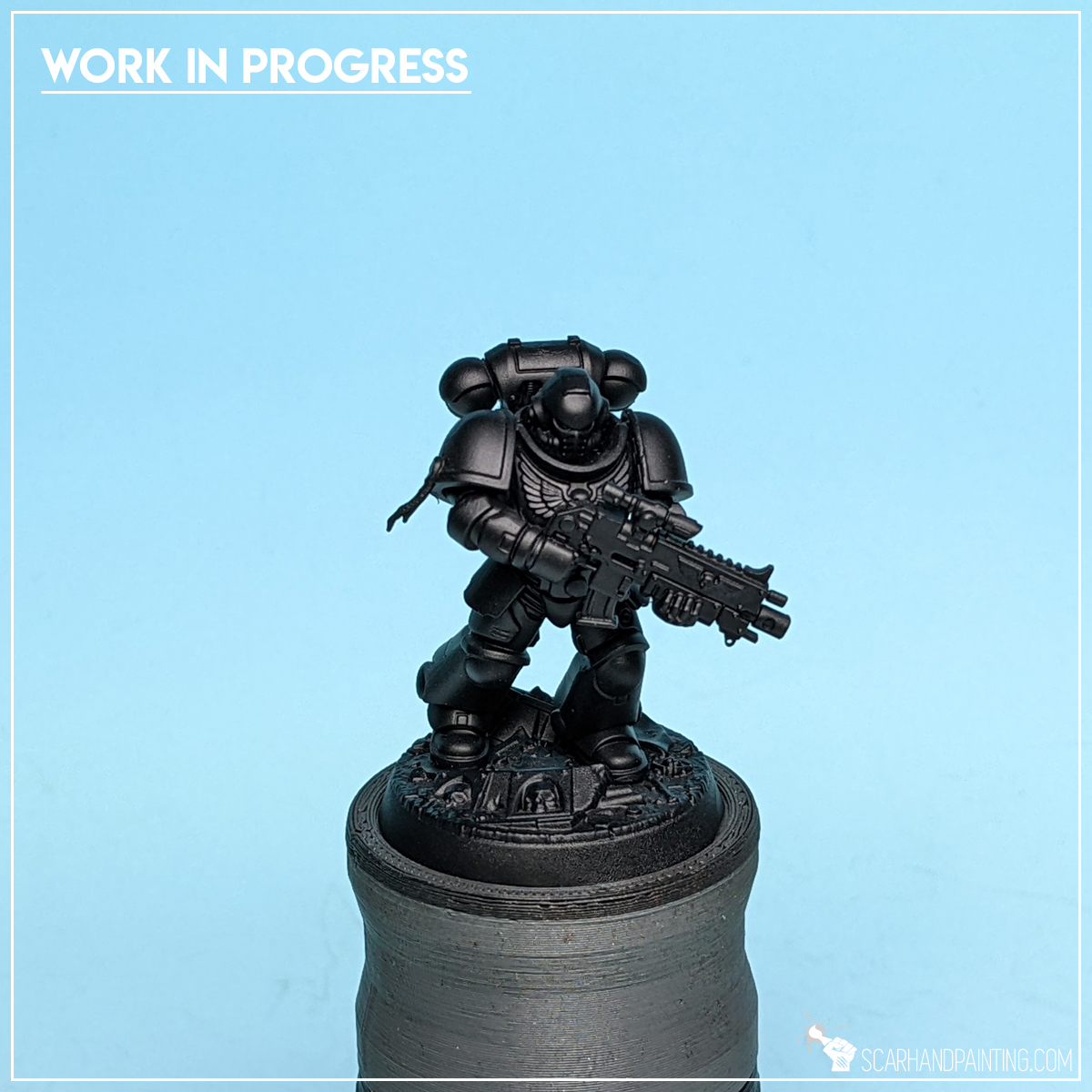
Step two: Base Color
For the initial layer I chose Vallejo Model Air – French Blue (71.088). The color is a somewhere medium tone blue, with much vibrancy that got a bit toned down by black undercoat beneath. I applied a thin, dry layer of French Blue by airbrushing it on top and around the miniature. I took extra care not to make the layer too strong.
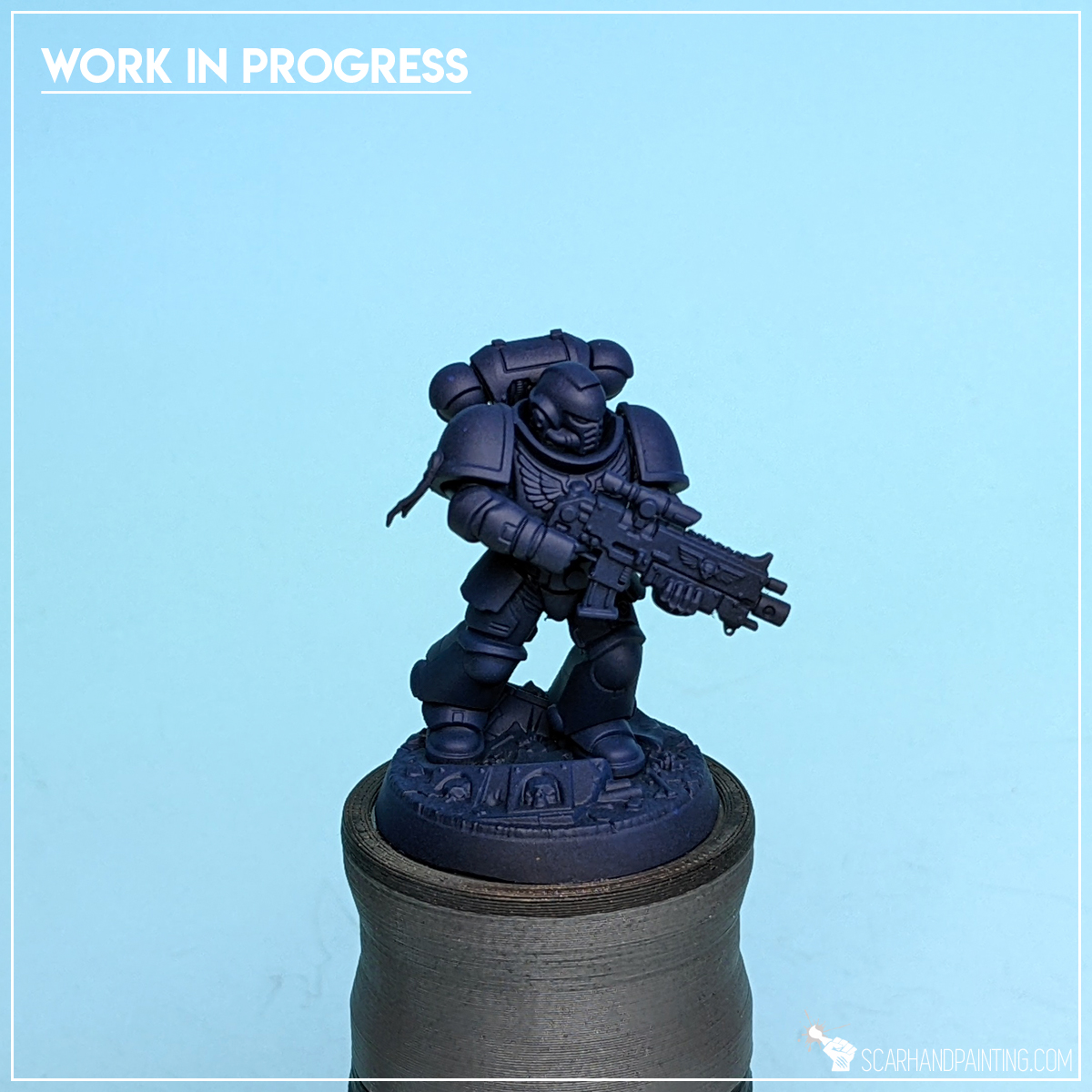
Step three: Highlight
Next I applied a mix of Vallejo Game Air – Ultramarine Blue (72.722) proportioned 5:2 with Vallejo Model Air – Light Sea Blue (71.089). This layer was also airbrushed, but this time I applied it zenithally and on the most exposed areas of the armor. Once again I took extra care to keep the layer dry and soft.
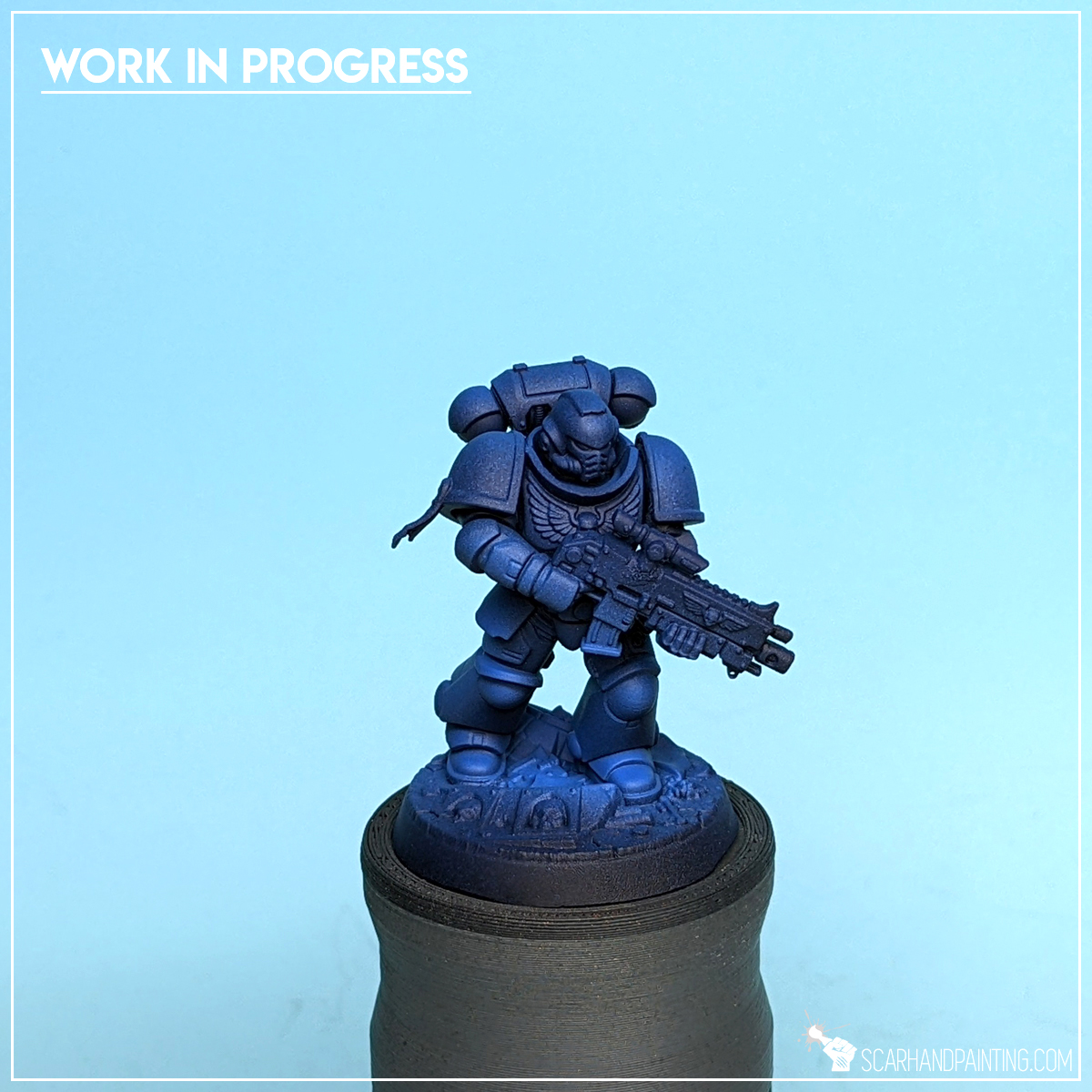
Step four: Shading
I then applied Vallejo Wash for Dark Vehicles (76.518) by airbrushing it from the bottom of the miniature (reverse zenithal) and onto low parts of large areas, including lower shoulder guards, sides of leg armor and lower part of the backpack. This particular paint is very thin, forcing me to apply it by multiple tiny, mist-like “puffs”, that dried out almost instantly. It significantly toned down all the armor and blended any dry specks leftovers from previous layers.
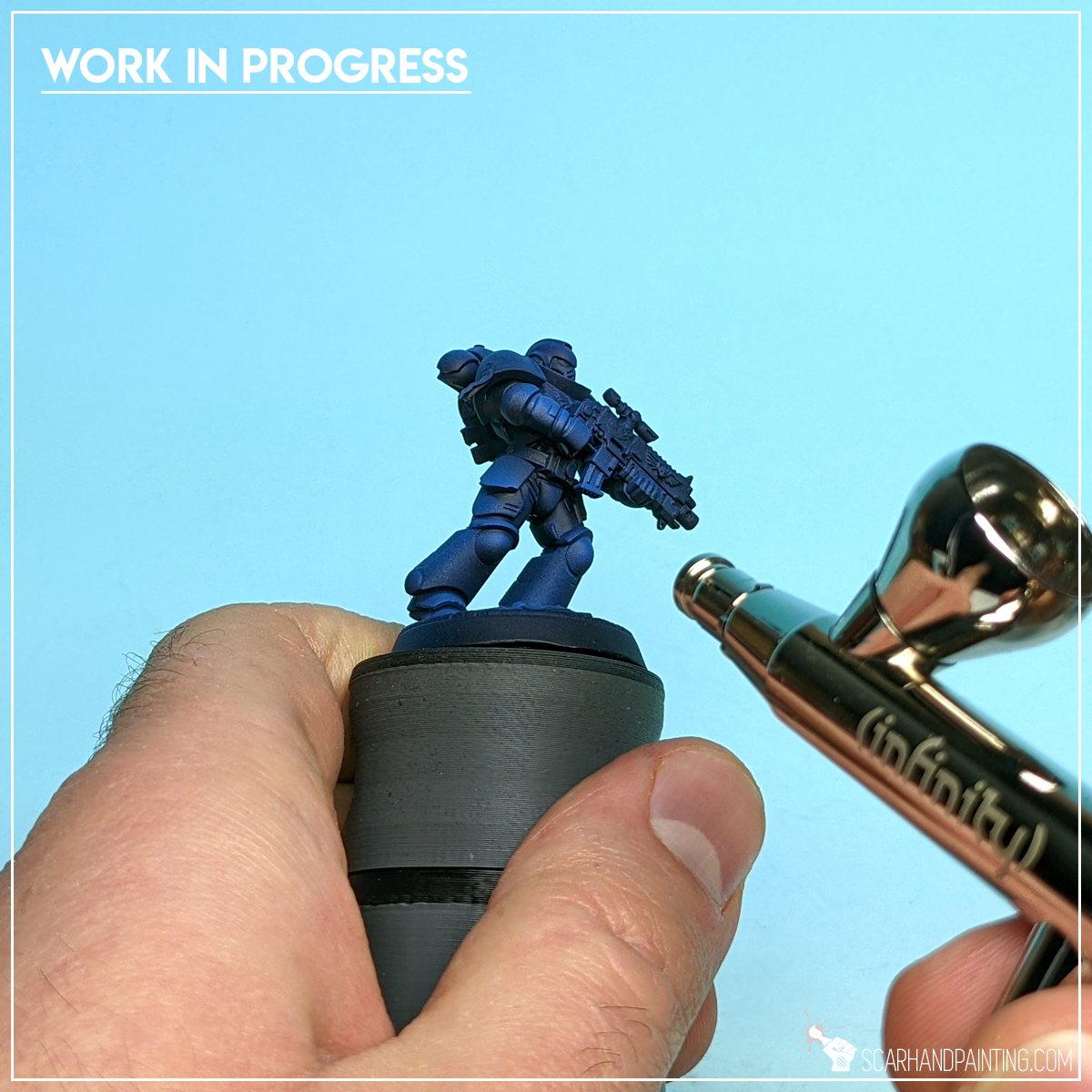
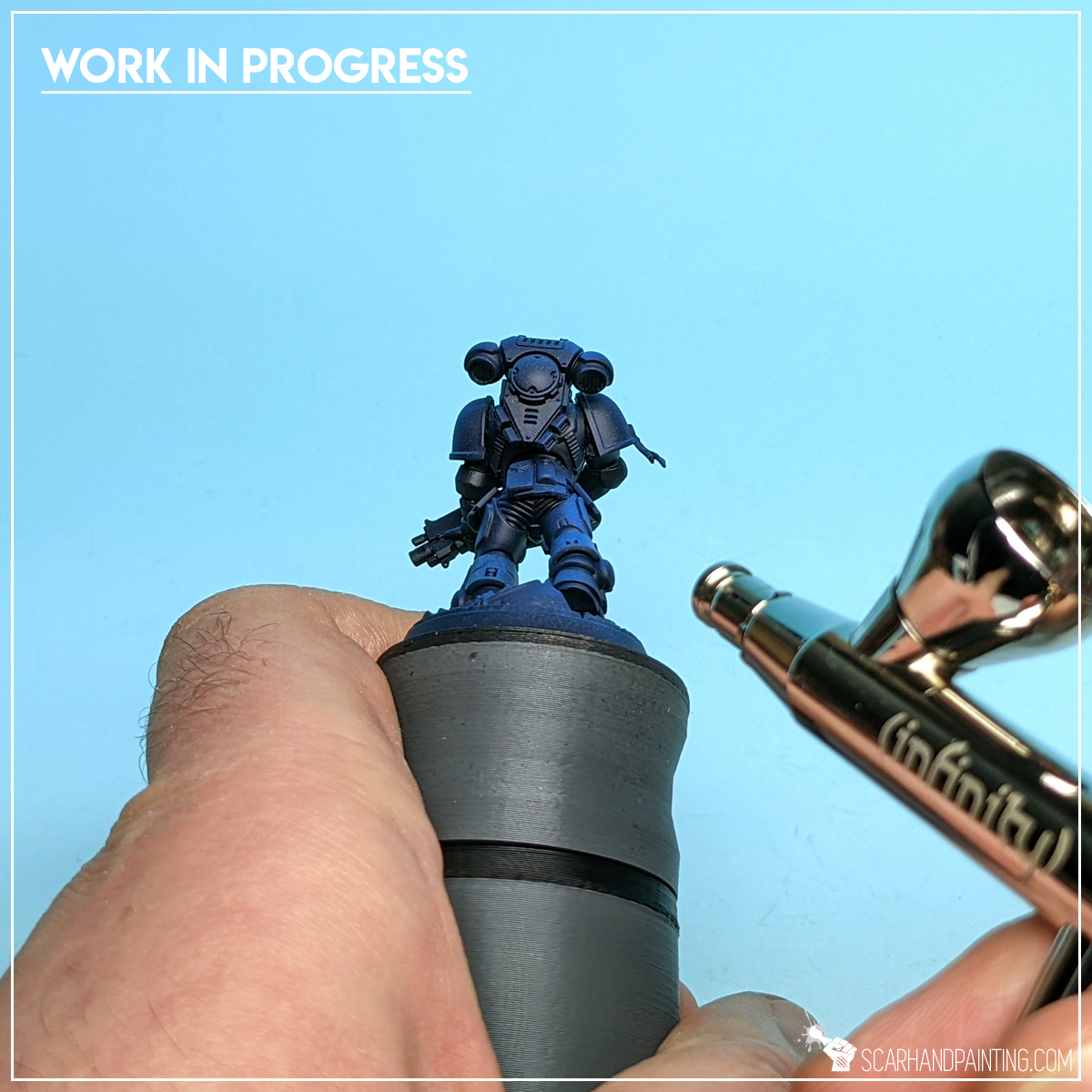
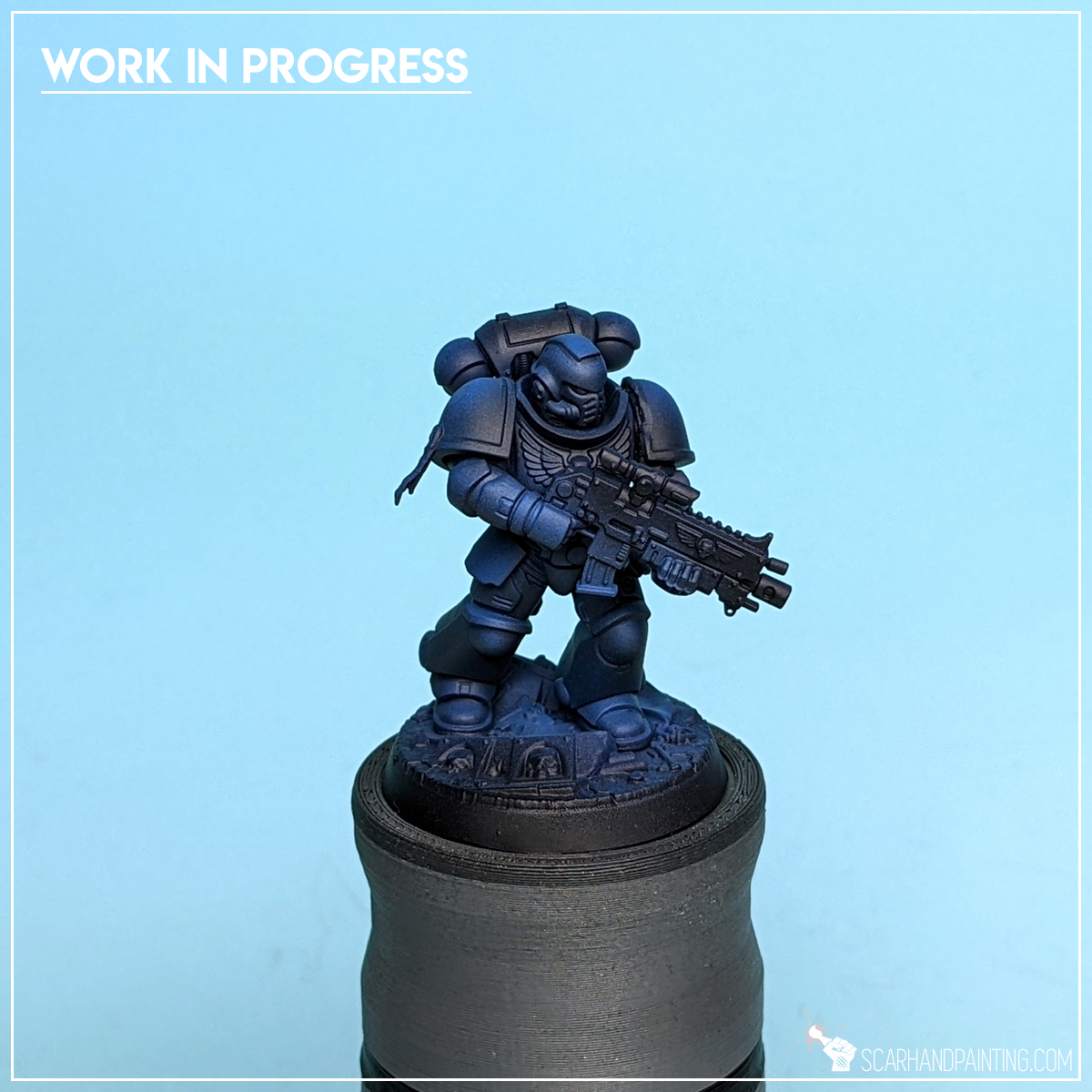
Step five: First Highlight
Next I switched to manual brush and applied an edge highlight of Citadel Layer – Hoeth Blue. I picked only the most exposed edges, skipping all places that were too difficult to reach or hidden from sight.

Step Six: Second Highlight
Finally I applied an edge highlight with Vallejo Game Color – Glacier Blue (72.095). Contrary to previous layer, I kept this one concentrated on top areas and corners, adding extra focus and depth to the exposed armor detail.
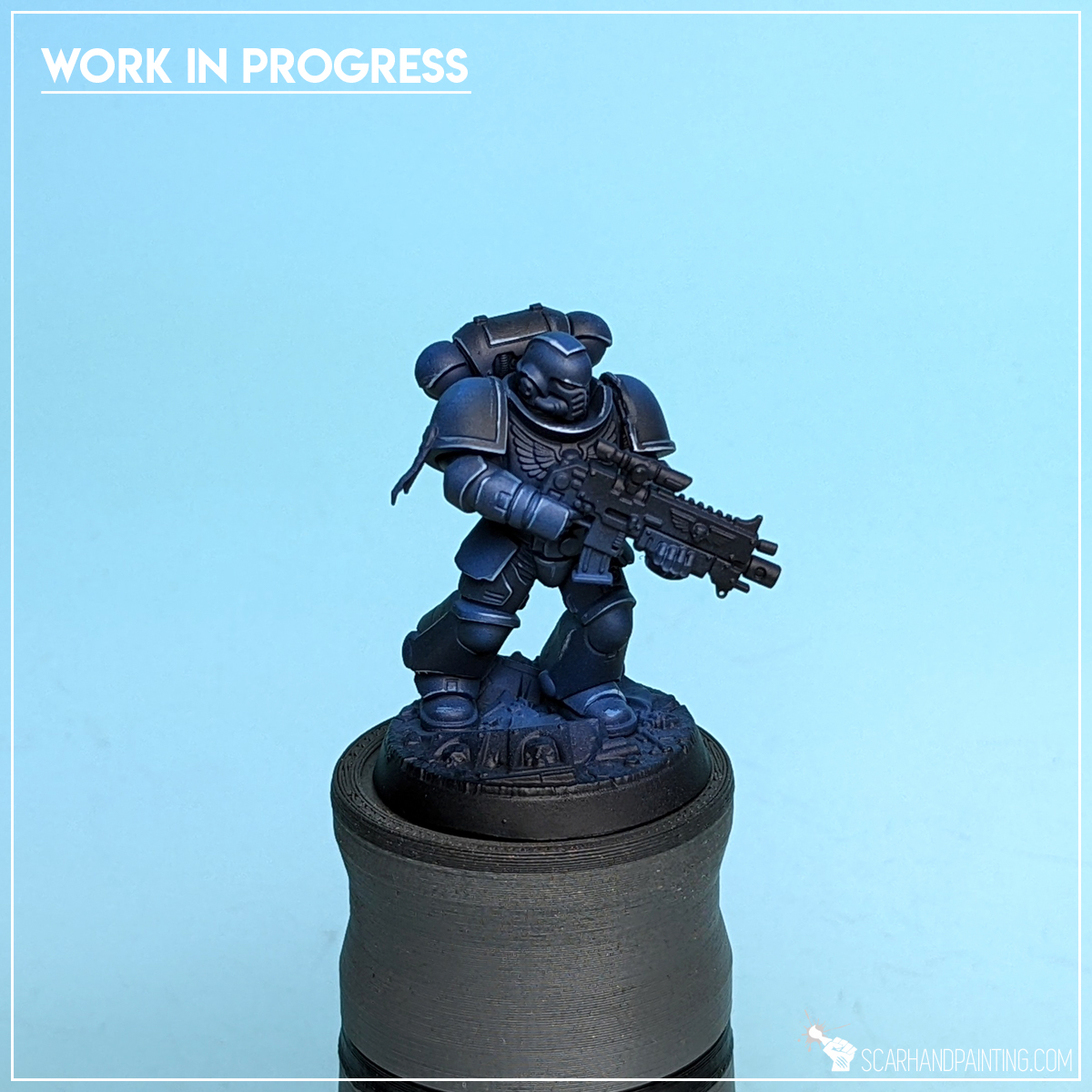
That wraps up the armor. Only five layers of paint for an eye catching effect of dark blue armor, that stands out on the gaming board. Now with this solid base out of the way, we can start building character of the miniatures, by adding more colors and enriching the overall feel of the miniatures – but that is a topic for another day. Stay tuned for part two of the tutorial.
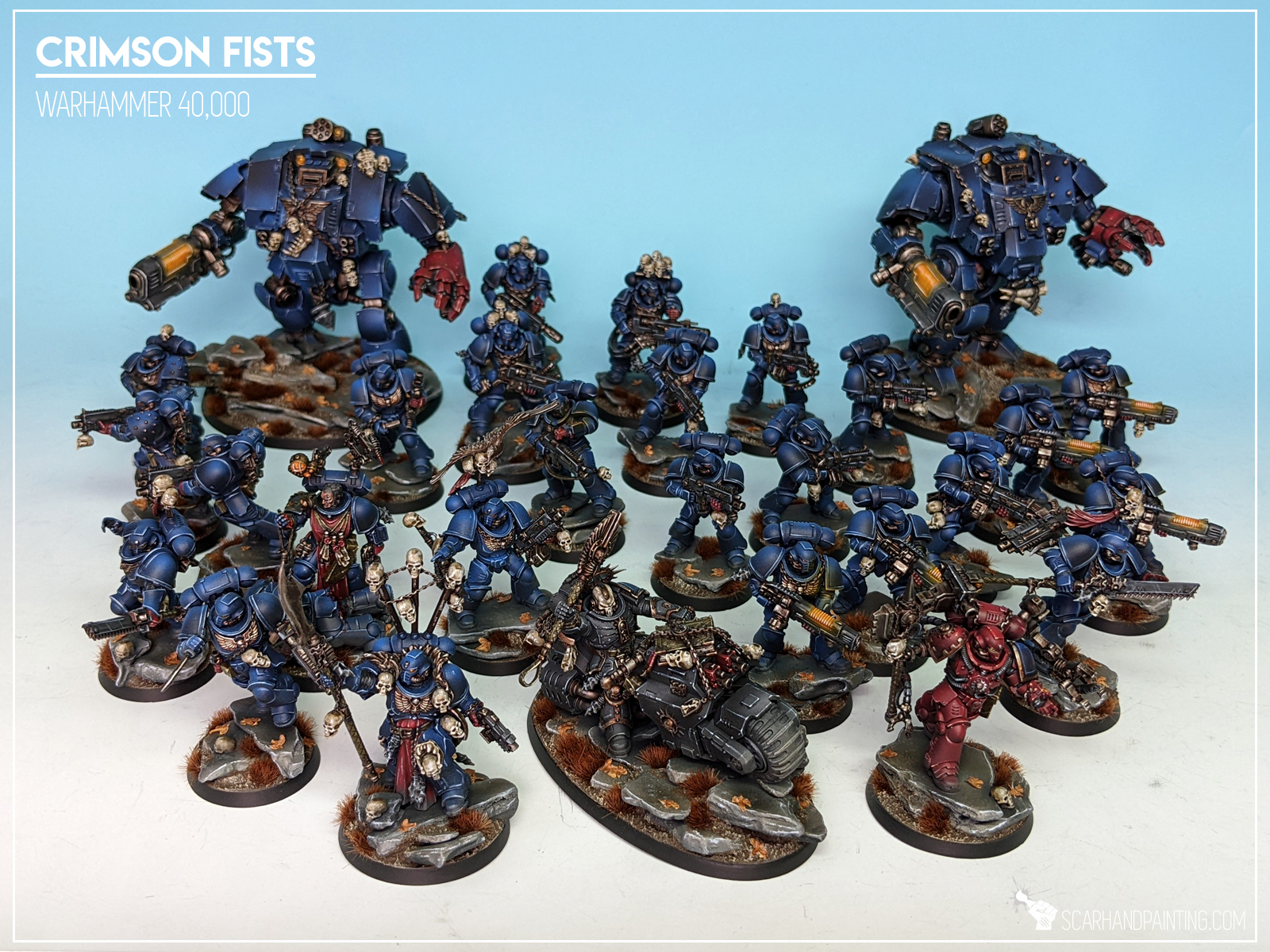

I hope you’ve enjoyed this article. Be sure to let me know your thoughts in the comments below or via Facebook or Instagram. I would also appreciate it if you considered sharing this content with your friends, who might find it interesting. Finally if you are looking for a professional miniatures painting service, be sure to contact me with this contact form. I always reply within 24 hours, after which please check out your spam folder.

Magnetized bases is nowadays new hotness when it comes to miniatures transportation. This solution allows for comfortable transportation and fast deployment of your army. Once commited to this form of handling your plastic dudesmen, you will probably go back and magnetize all of your stuff. Regardless of choice of container, be it a professional carrying case like A-Case, or just a plain paper box with a piece of metal mounted at the bottom, first thing to do is actually magnetizing the bases.
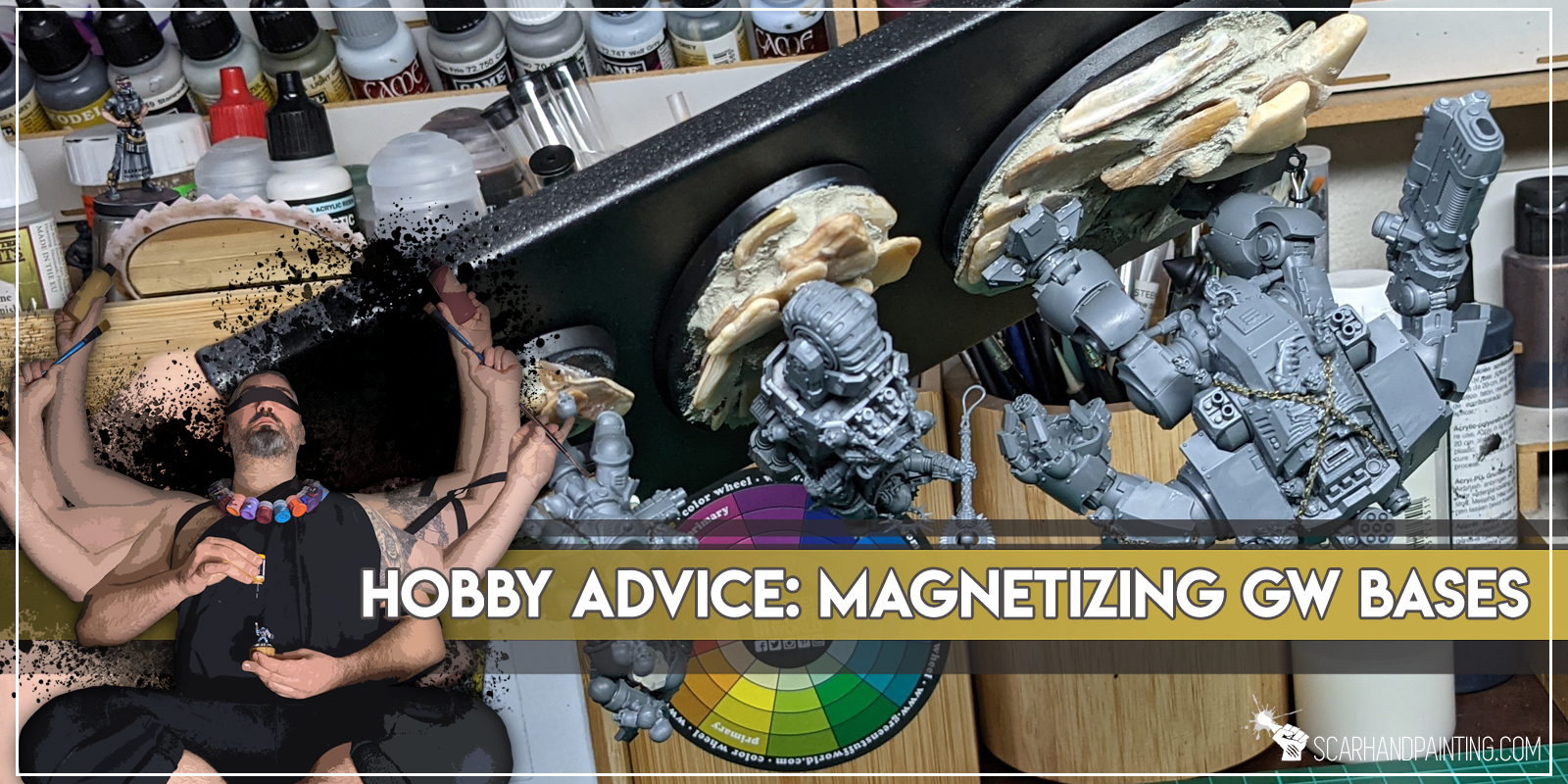
And here’s where word of mouth and slight issues might discourage you from this glorious path to ultimate wargaming comfort. The internet is full of common misconceptions about magnetized miniatures. That is because a lot of hobbyists decide to go the most straightforward way and just glue a random magnet to the underside of a base YOLO style. This might result in a magnet falling off a base mid-transport, which in turn might transform your precious collection into a pile of scrap. Below I will show you how to avoid this fate with a very easy life hack.
Before we start, some notes:
This tutorial focuses on Games Workshop bases specifically as they tend to have empty undersides.
For conveniences sake I highly recommend magnetizing bases before painting.
Please take note that what works for me might not necessarily work for you.
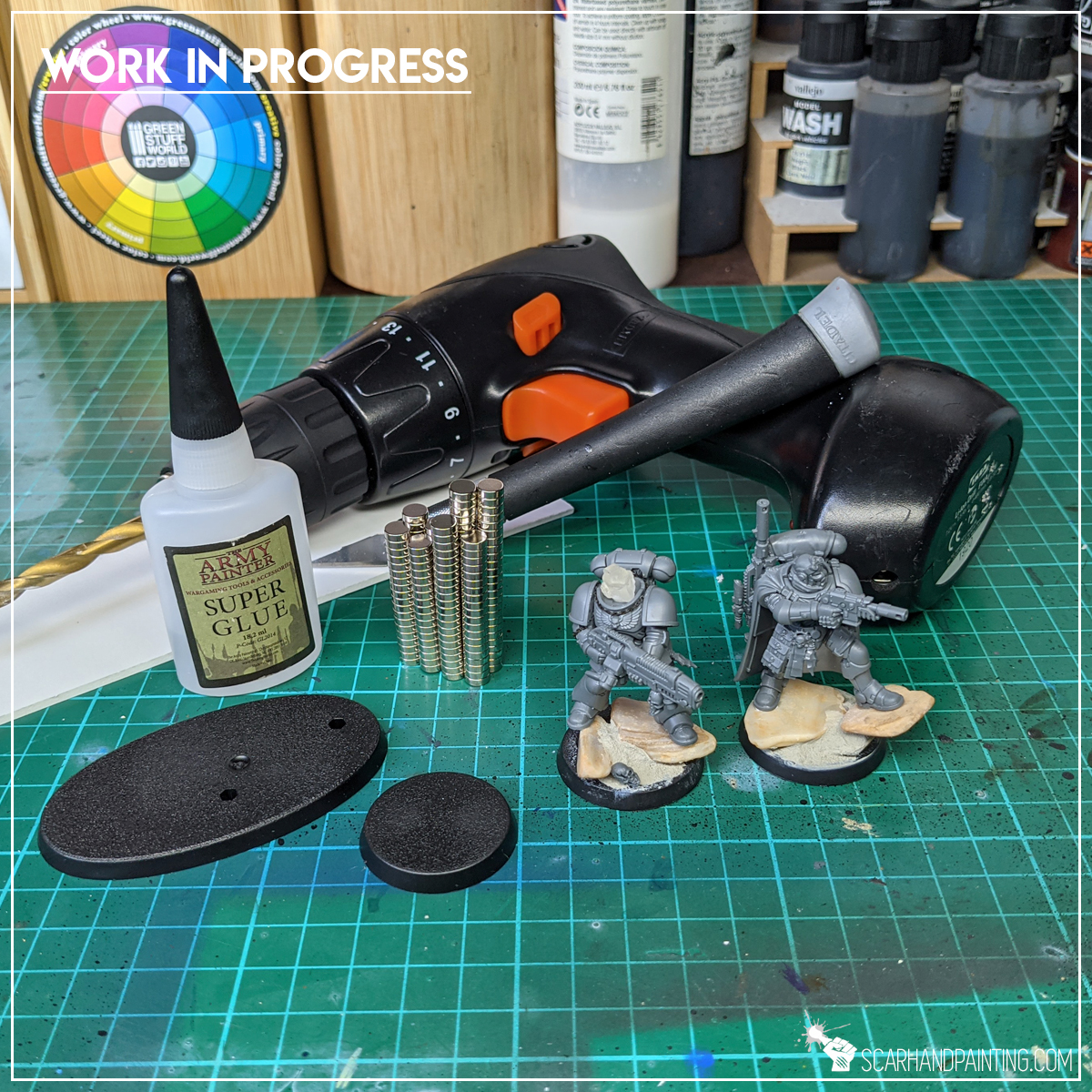
Let’s start by toppling the topic of magnets falling off a base. This happens because the entirety of miniature’s weight is held in place by a relatively tiny spot of contact between a magnet and a base. The smaller the area of contact and the heavier a miniature – the more probable a COVFEFE in your carrying case. To avoid this, but also keep the size of magnets reasonable, I propose to use sockets. A socket extends the area of contact to the sides of a magnet and greatly increases strength with which the magnet is held in place. A proper material for a socket will also increase the bond between the magnet and plastic base.
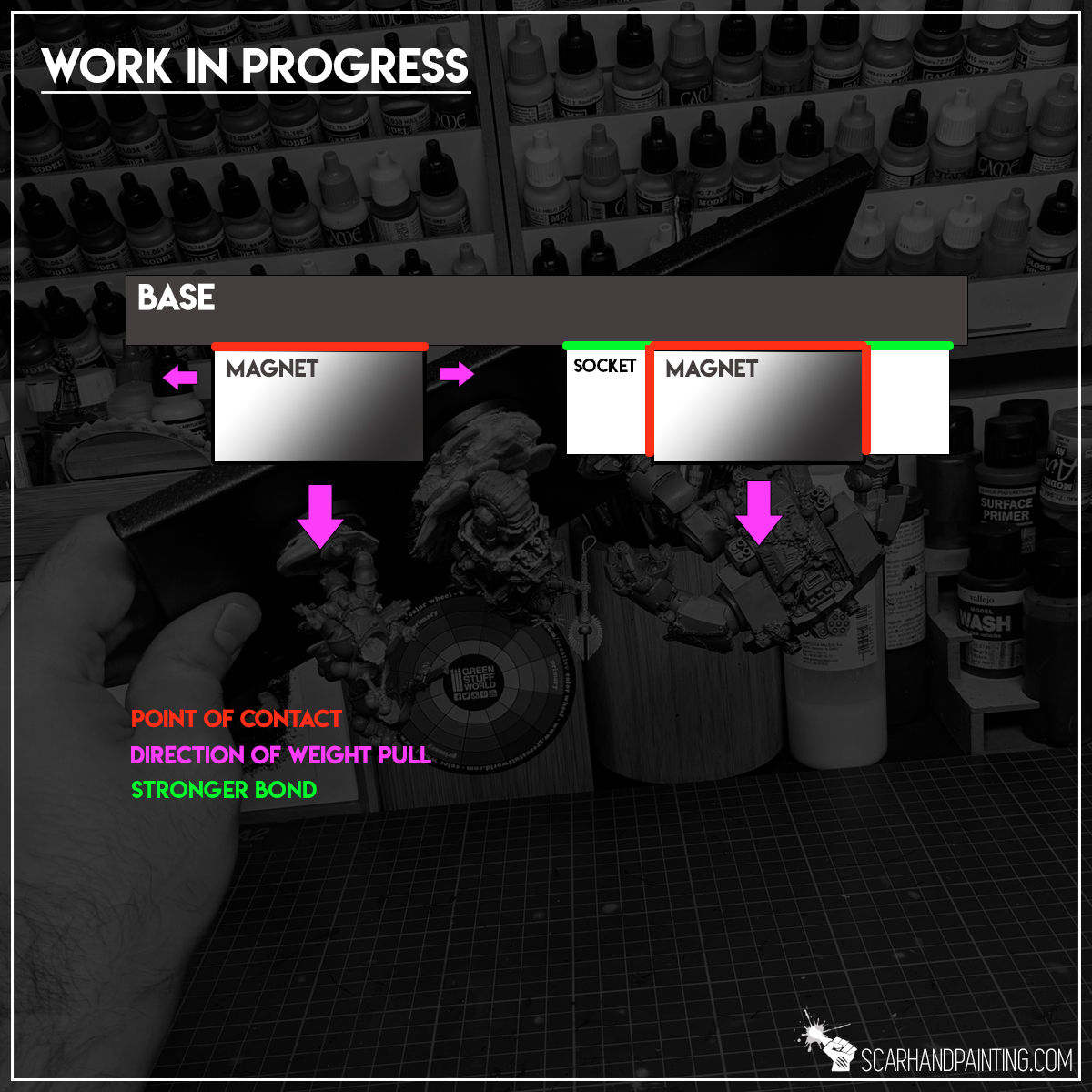
Another thing is choosing a right size and the amount of magnets for each miniature. Personally I tend to go with two magnets for infantry, three to four for large infantry and cavalry and more for anything larger, depending on weight. The size of these varies depending on what bases I work with. For Games Workshop bases I go with 5x2mm magnets, which work as a charm, providing just enough strength to keep miniatures in place, but not as much as to prevent me from comfortably picking the miniatures.
Boy oh boy, so much theory… “where’s the actual tutorial?!” you might ask. Ok, let’s just go straight for the easy step-by-step.
Step one: the PVC
Start by drilling holes in the PVC one beside another with few mm in-between. No need to be very precise. Once done, use a hobby knife to cut the PVC into small two-holes pieces, as seen in the picture below. These are now “sockets” to hold the magnets in. Test if all sockets fit the bases, make some adjustments if necessary.
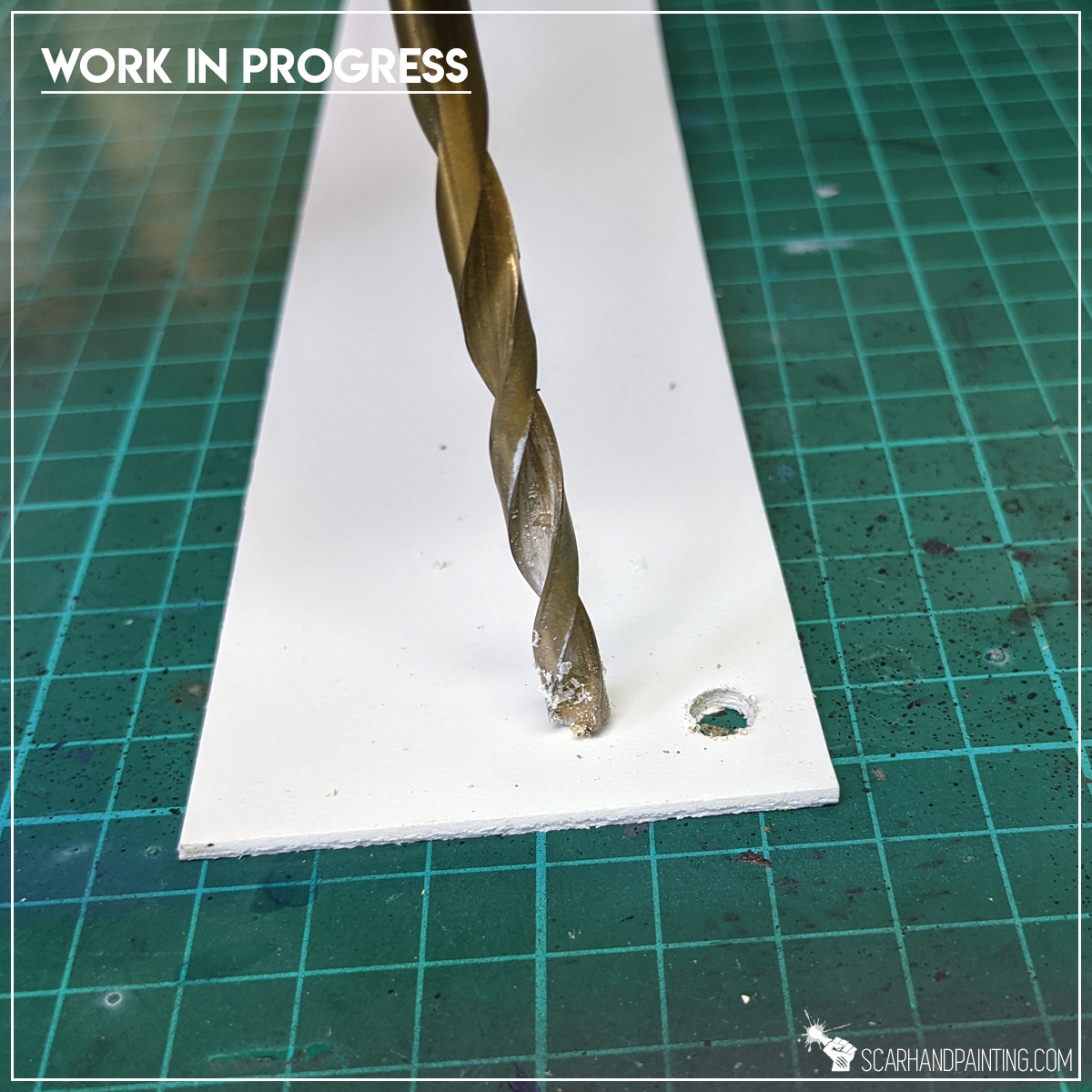
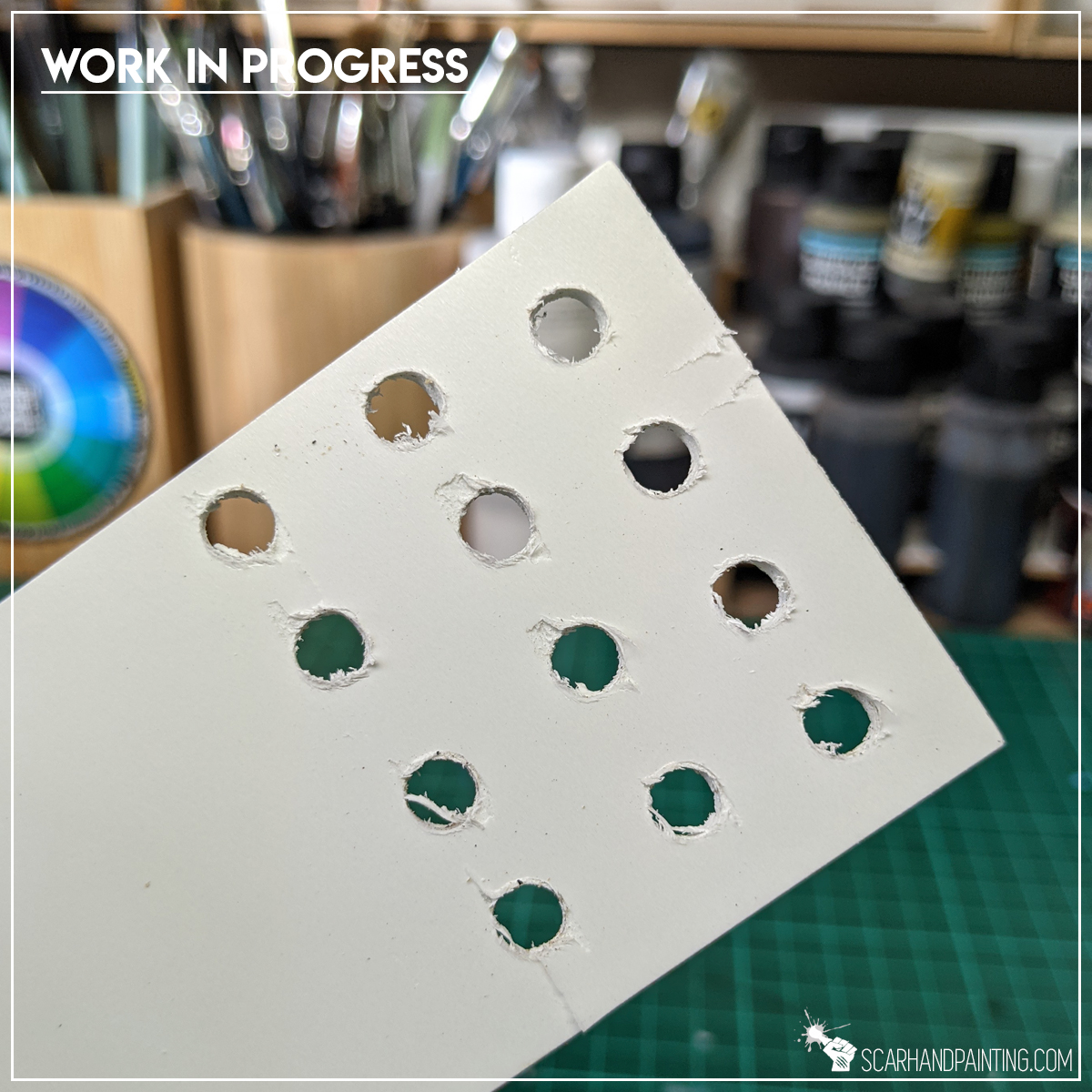
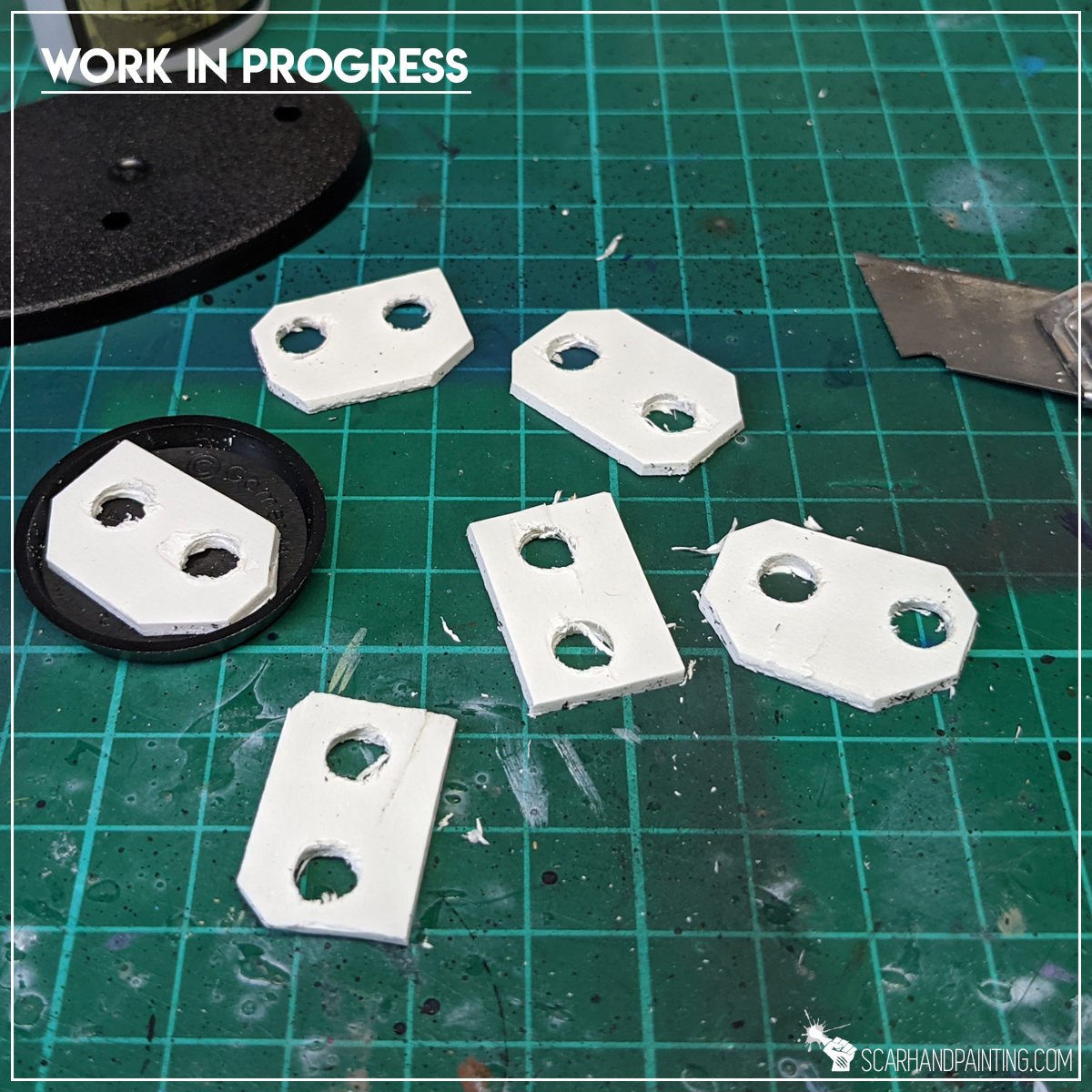
Step two: Mounting Sockets
Turn the base upside down, apply some Super Glue onto the surface and glue the socket on top. Avoid sticking your fingers through the holes as you might end up becoming one with the base by accident 🙂
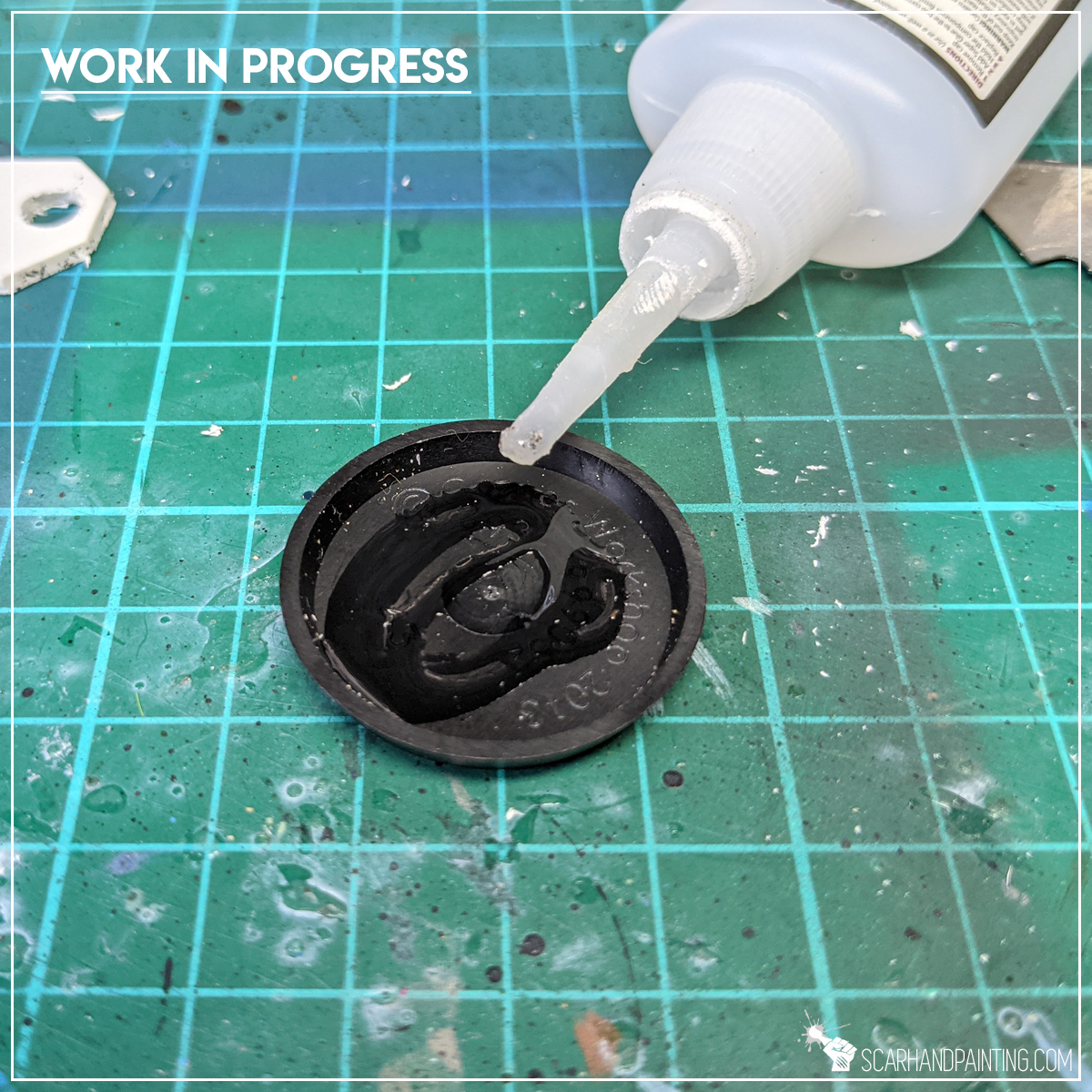

Step three: the Magnets
Apply Super Glue into the sockets and glue the magnets in. Try to glue all the magnets in same direction for better effect. I found that it is better to put the magnet just barely into the socket, then flip the base and push it on top of a flat surface. This way the magnet will slide inside a socket up to a level of the base’s edge, thus providing good connection to a future metal transportation surface.
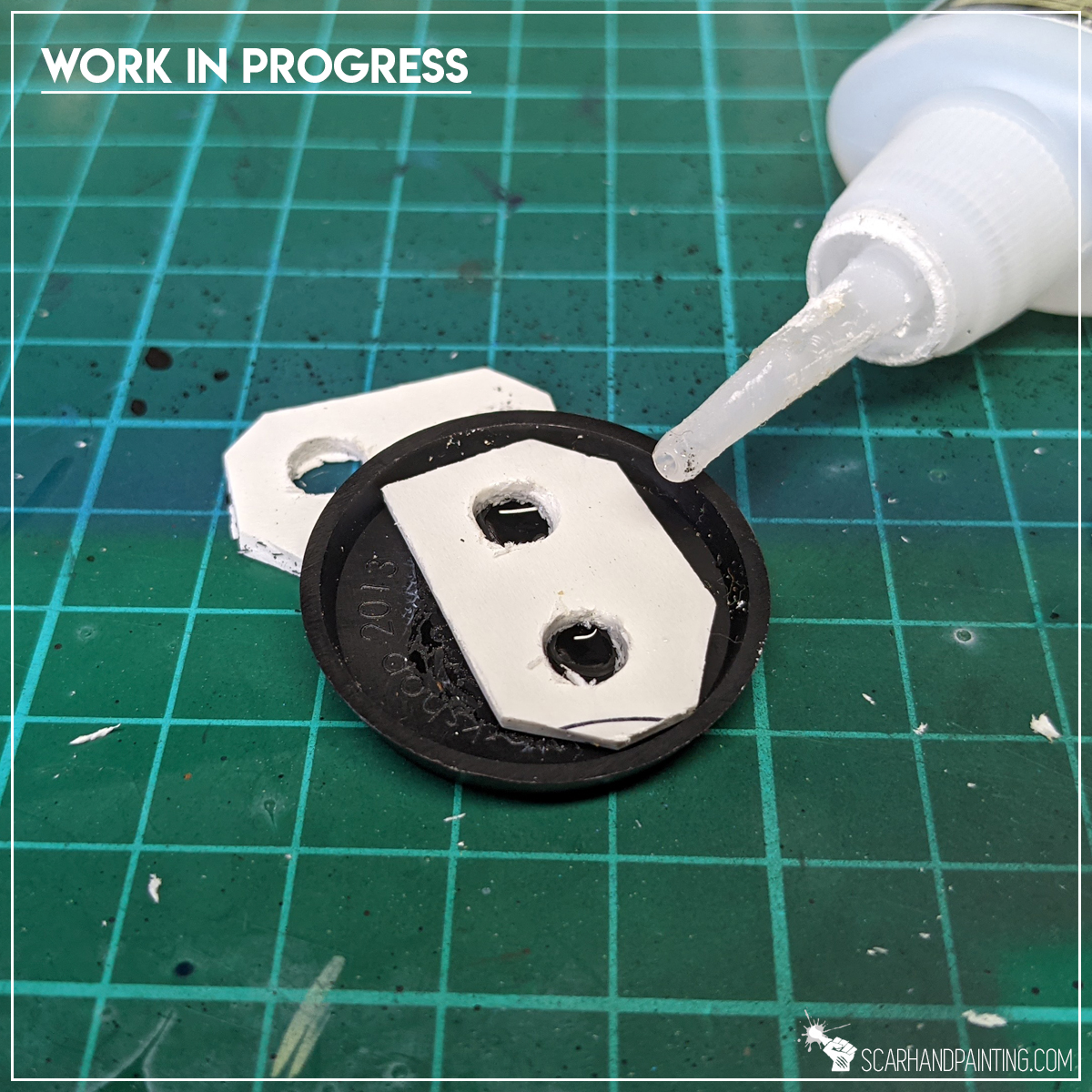
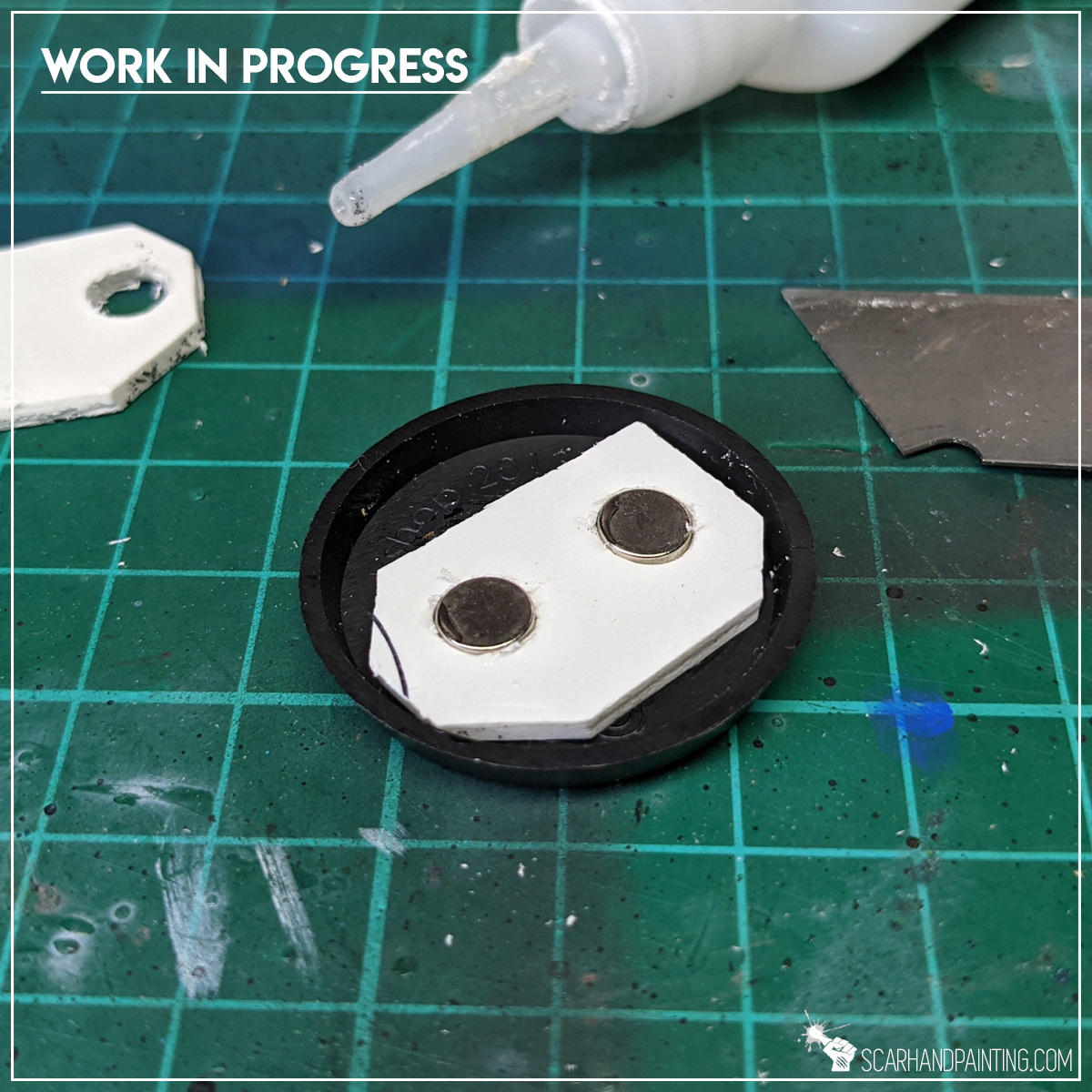

Hey! That’s it! These three simple steps will greatly increase your magnets (and miniatures) survivability during transportation. I’ve been using this solution for couple of years now, with no bad experience what so ever and I hope it will work for you just as well.
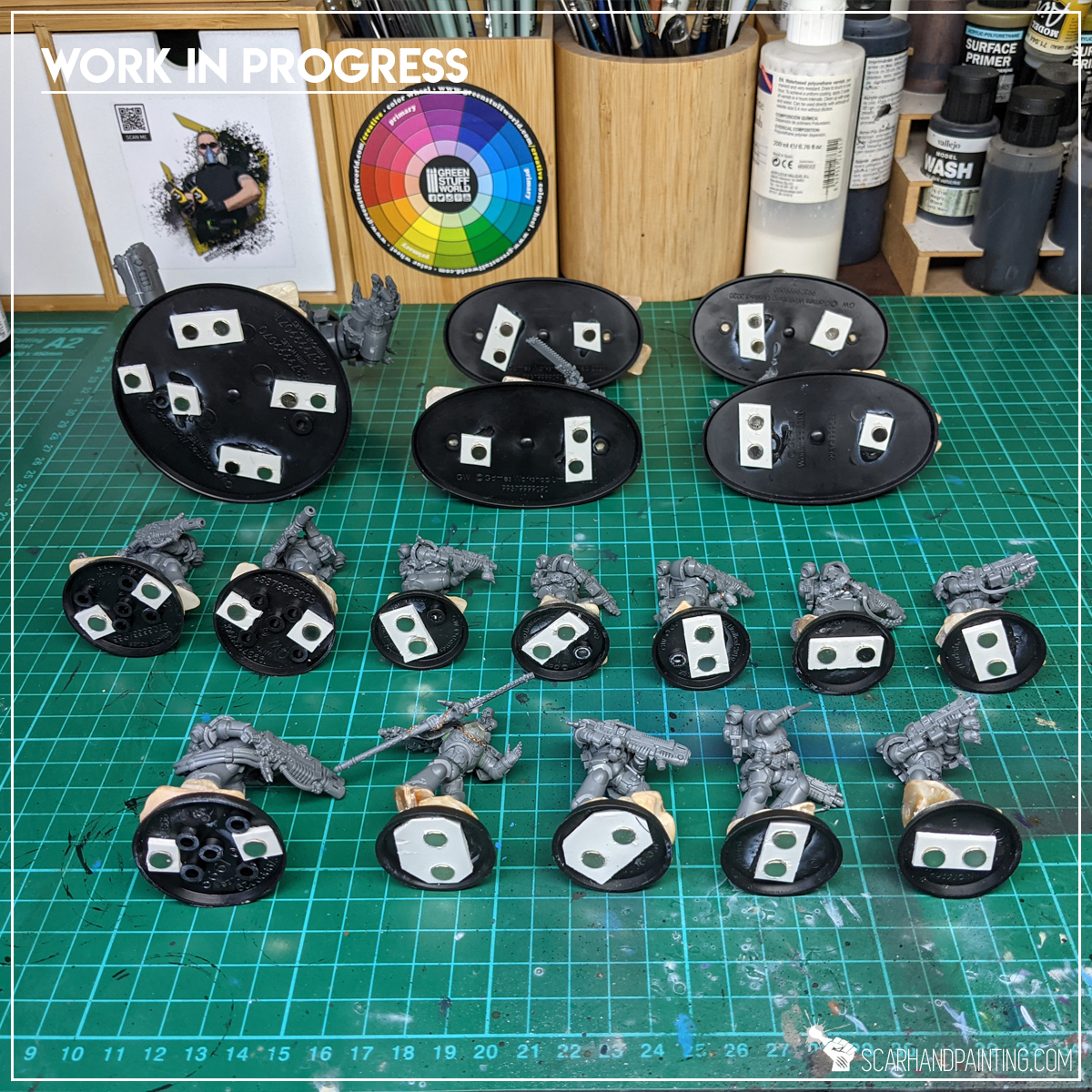

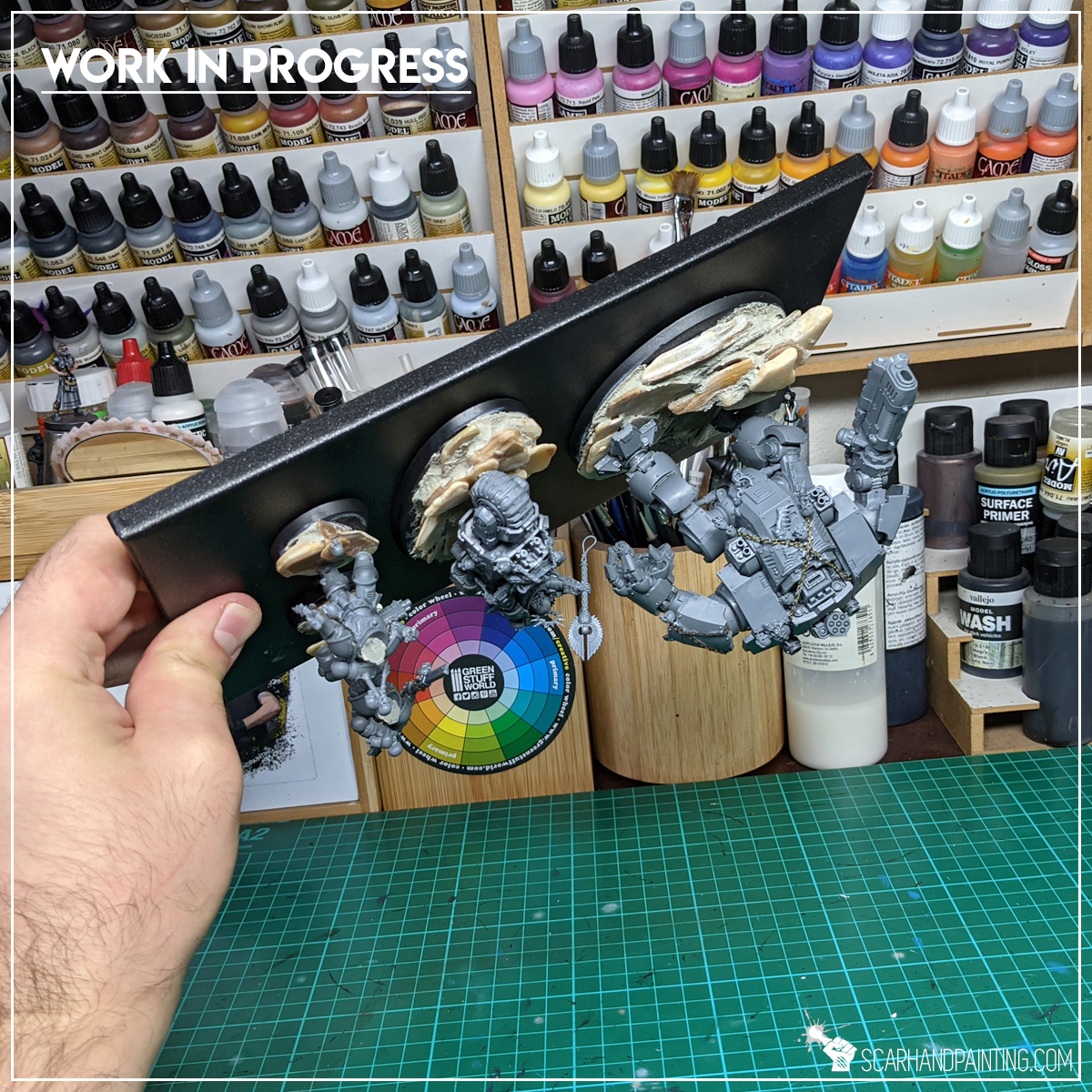

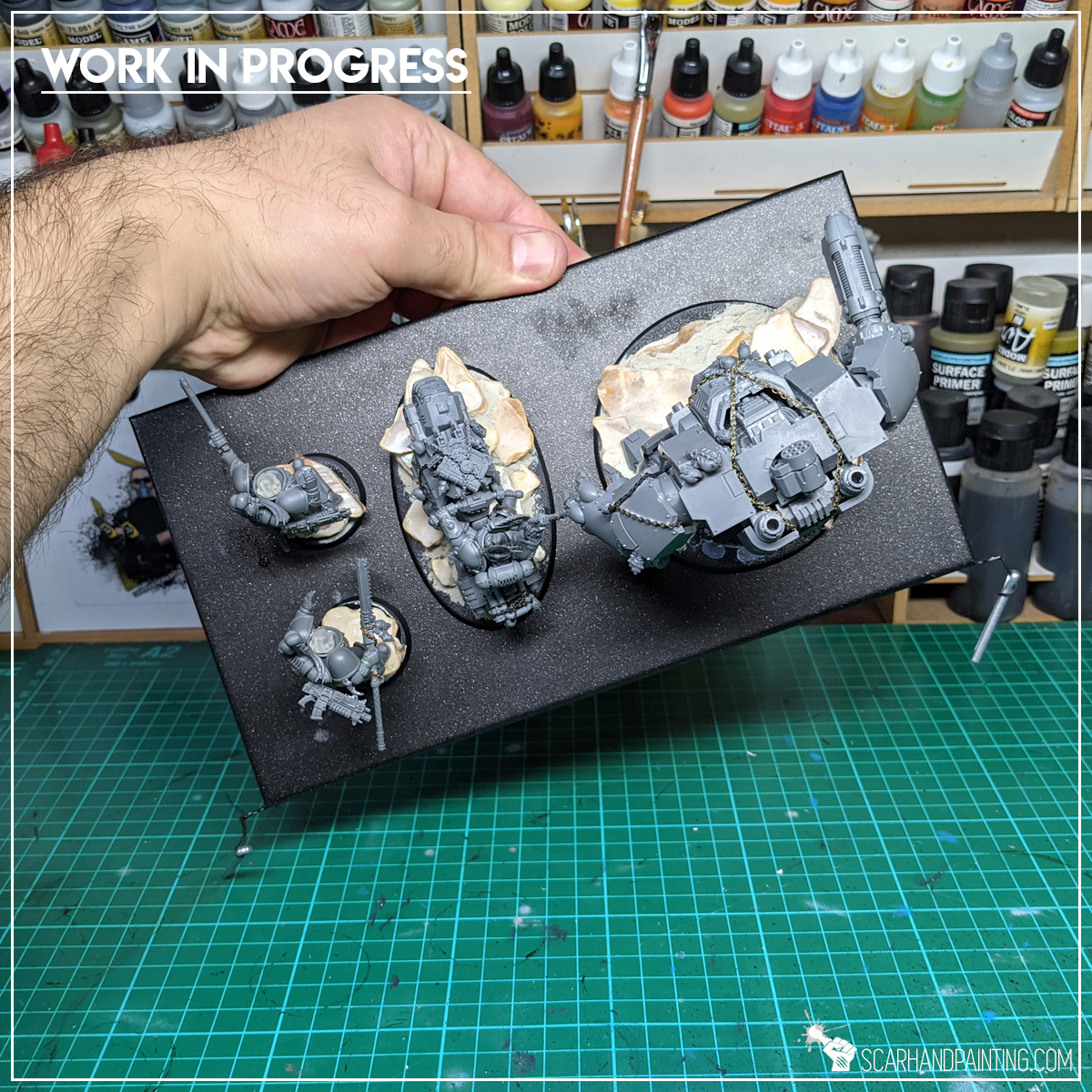
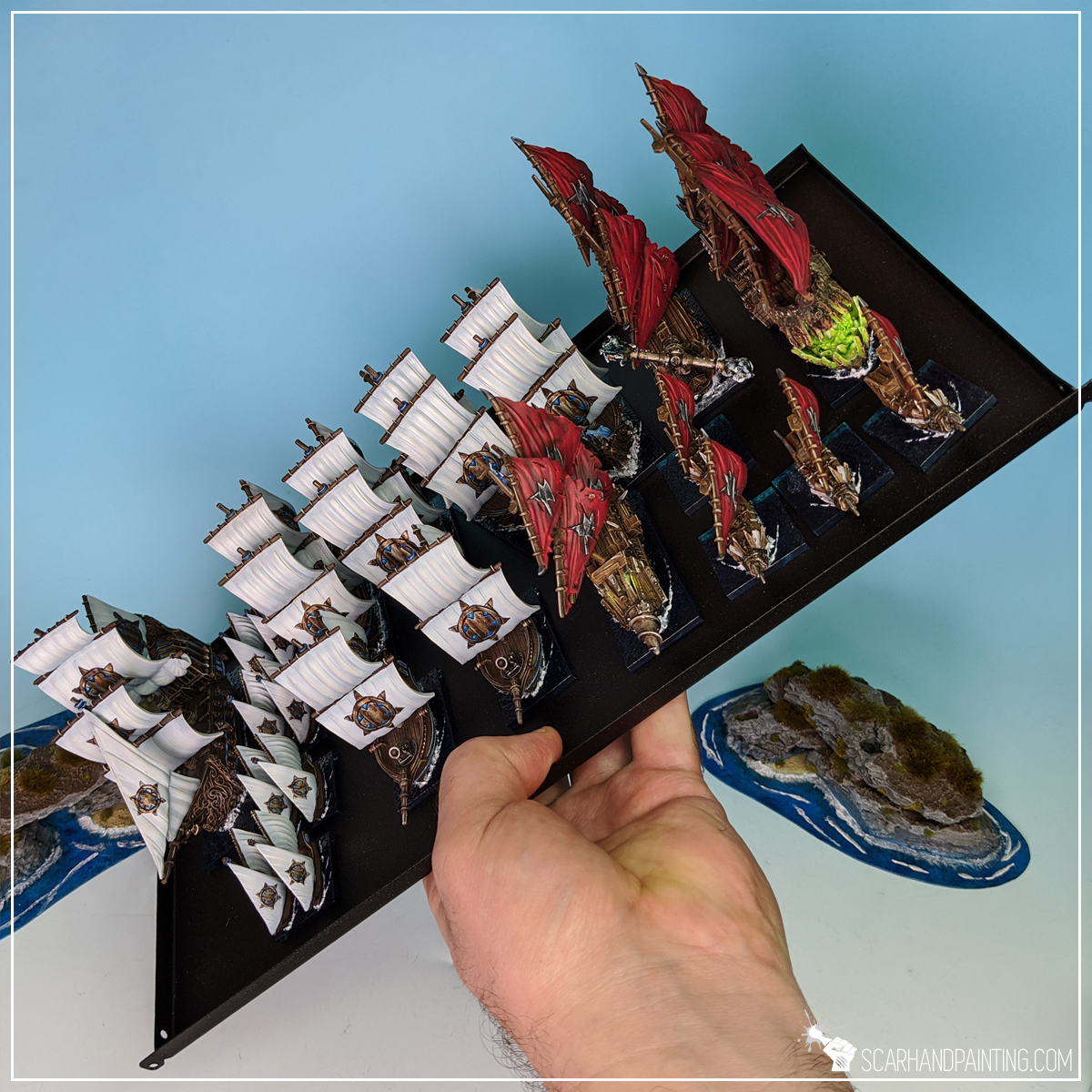
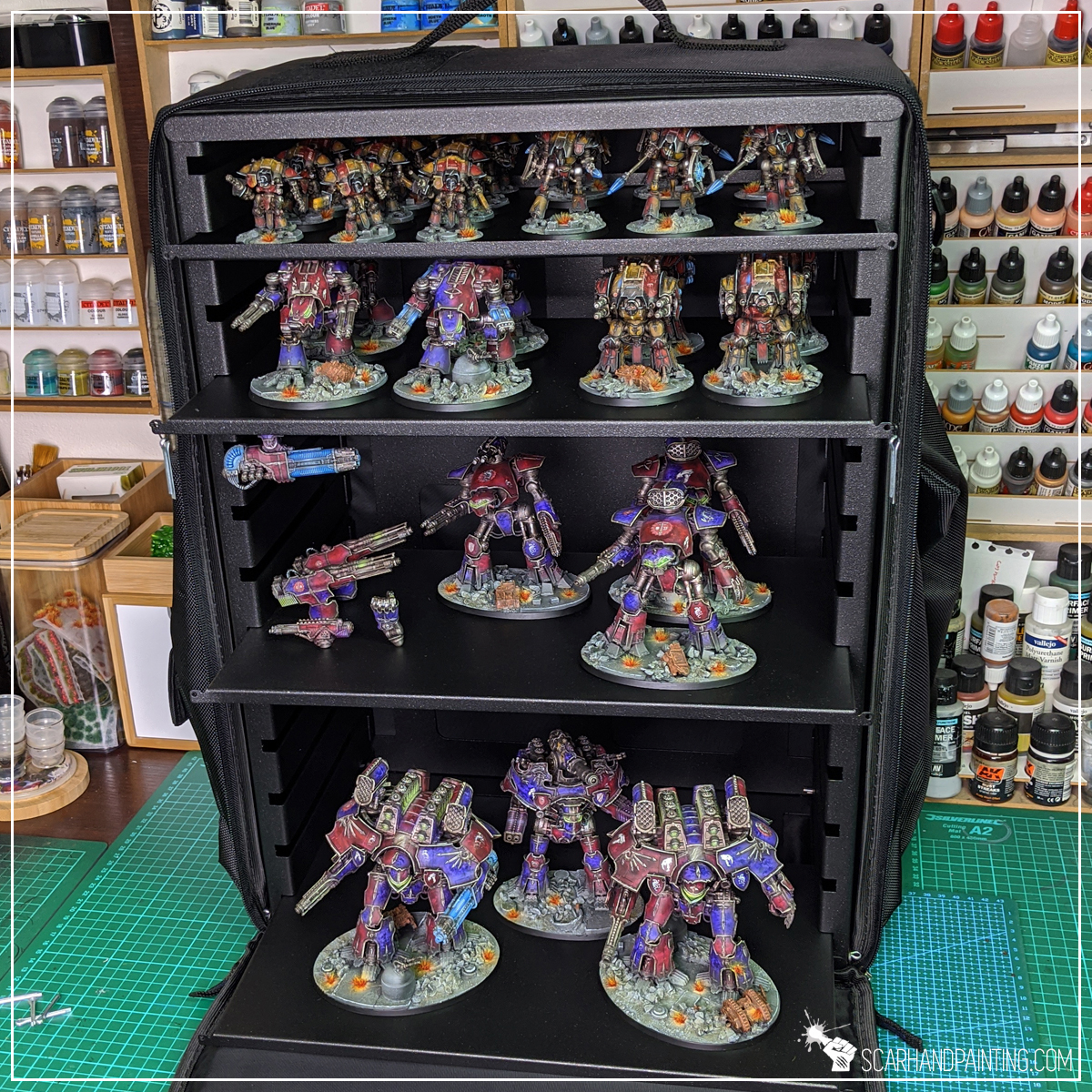



I hope you find this tutorial interesting. Be sure to let me know your thoughts in the comments below or via Facebook.or Instagram. I would also appreciate if you considered sharing this content with your hobby buds, who might find it useful. Finally if you are looking for a professional miniatures painting service be sure to contact me via this contact form. I always reply within 24 hours, after which please check out your spam folder.
Cheers!

Welcome to Painting Road to Survival Bandits tutorial. Here I will present to you a Step-by-step of an easy and fast painting process for Orzol Studio’s Bandits team from the Post-apo Survivors Kickstarter.
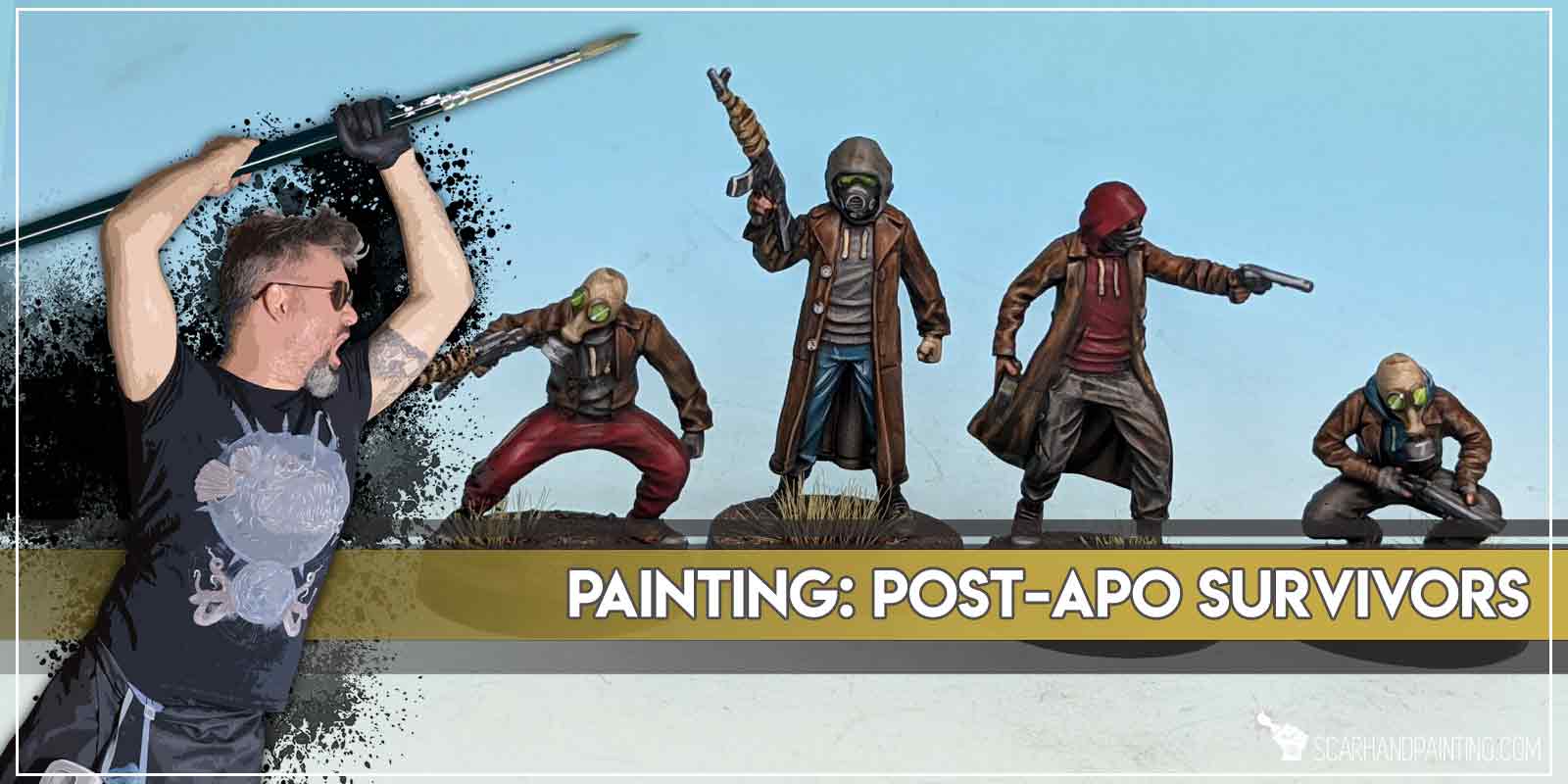
Before we start, some notes:

Step one: Undercoat
I applied a strong layer of Citadel Chaos Black spray. I prefer spray over manual application, but this is just a personal preference. Any matt black undercoat will do, as long as it’s thorough.
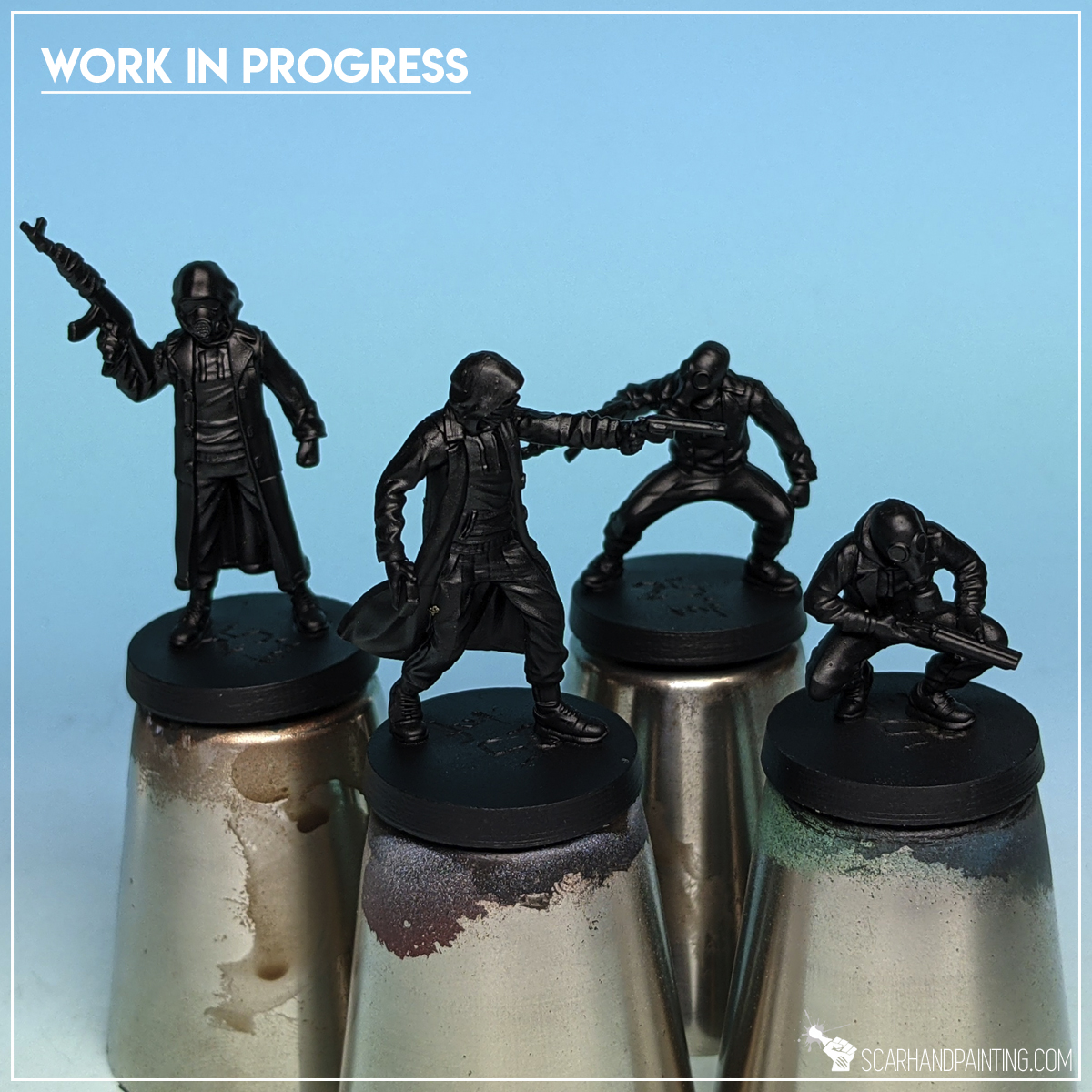
Step two: Grey clothes base
I started by airbrushing a strong layer of Vallejo Panzer Dark Grey all over the miniature. I used an airbrush mainly to have a thin but also strong and smooth layer.
Next I airbrushed a layer of Vallejo Cold Grey on top, zenithally and partially on the sides of the miniature.
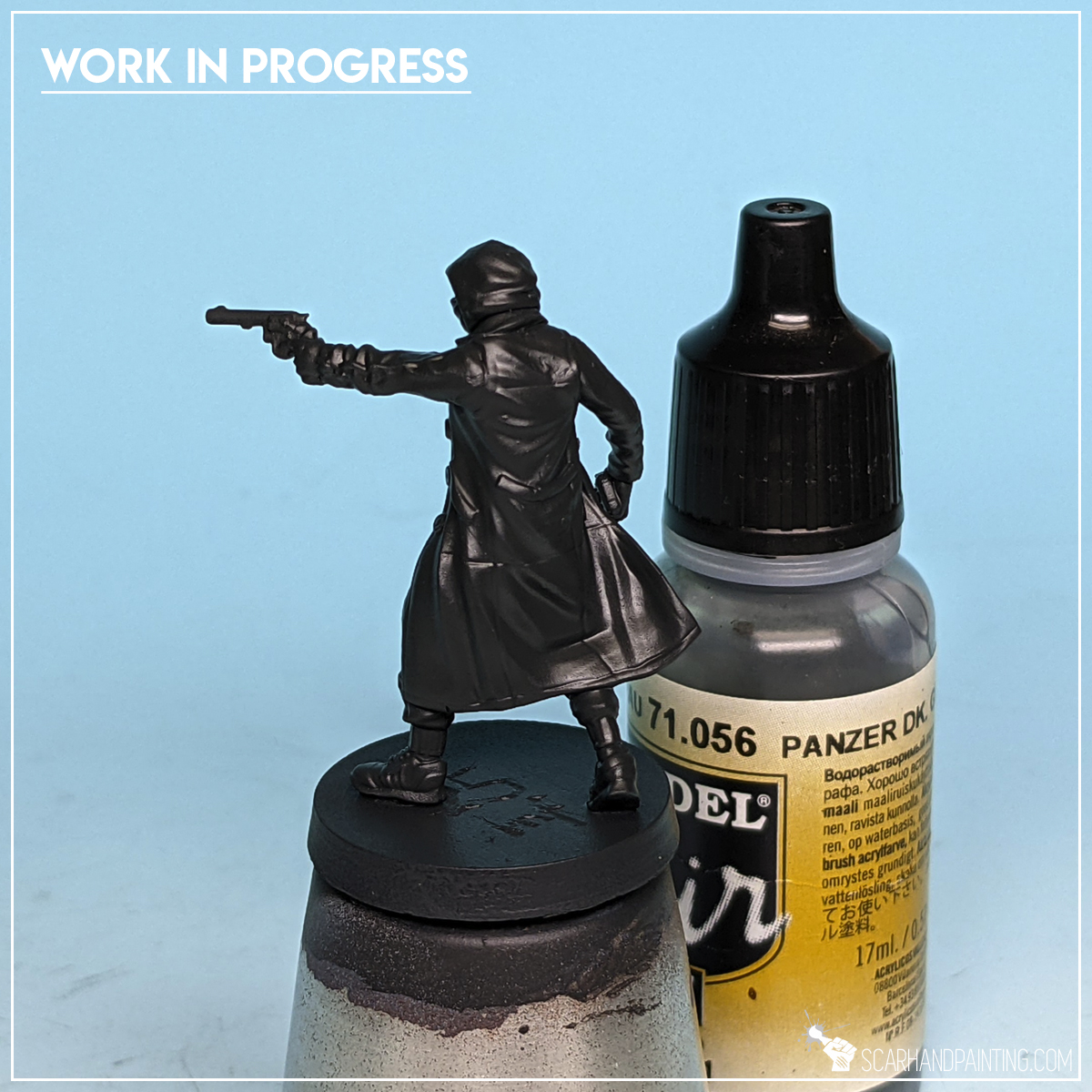

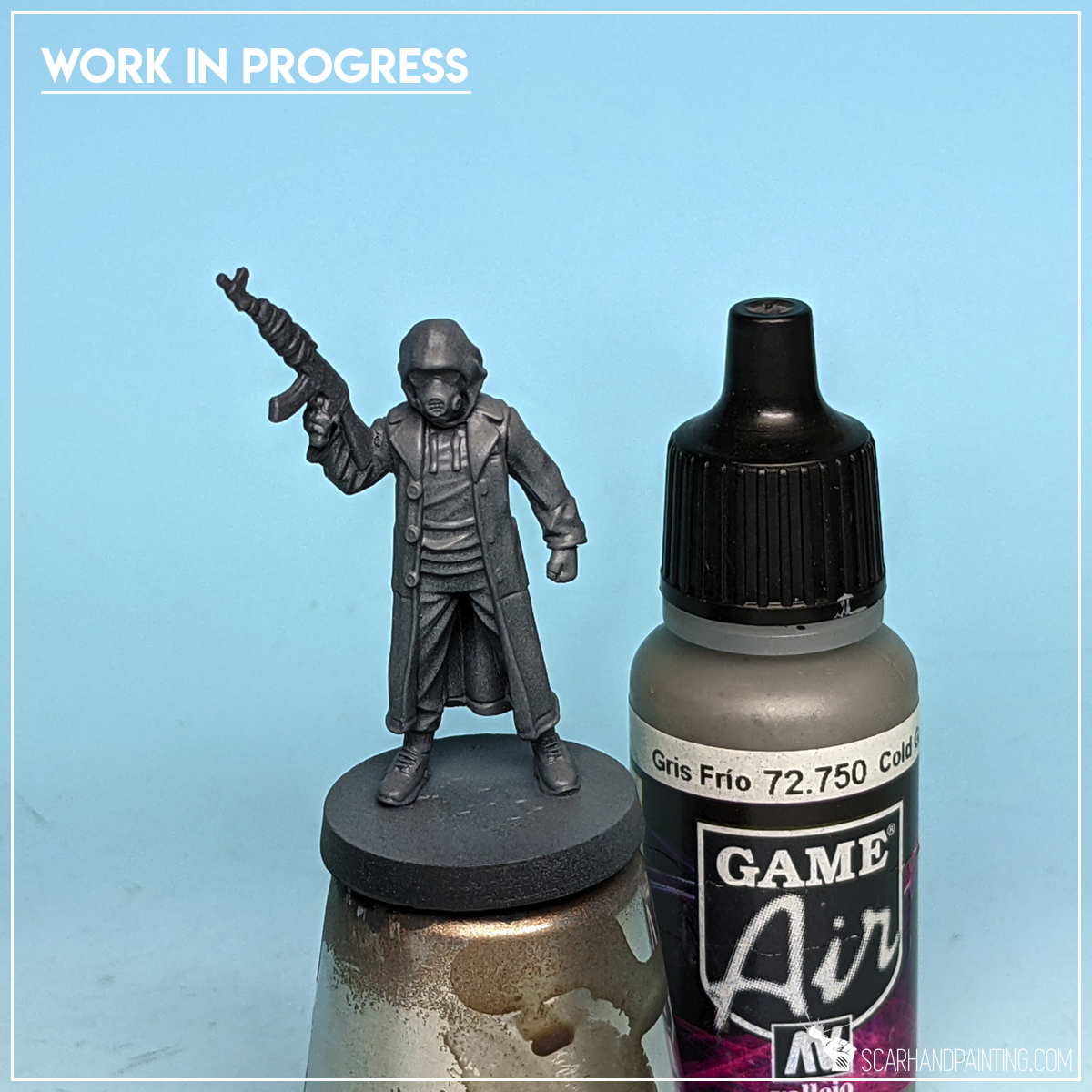
Step three: Brown clothes
With a solid grey foundation I moved to painting browns. I started by applying a thinned down Vallejo Ghost Grey in a gritty, haphazard fashion on top of everything soon to be brown. I also used this opportunity to apply highlights on weapons and pieces of clothes meant to be black.
Then I applied a strongly thinned layer of Vallejo Burnt Umber instantly changing grey to nice vibrant brown, but keeping all the detail of the previous layer still visible. You might say I glazed with Burnt Umber.
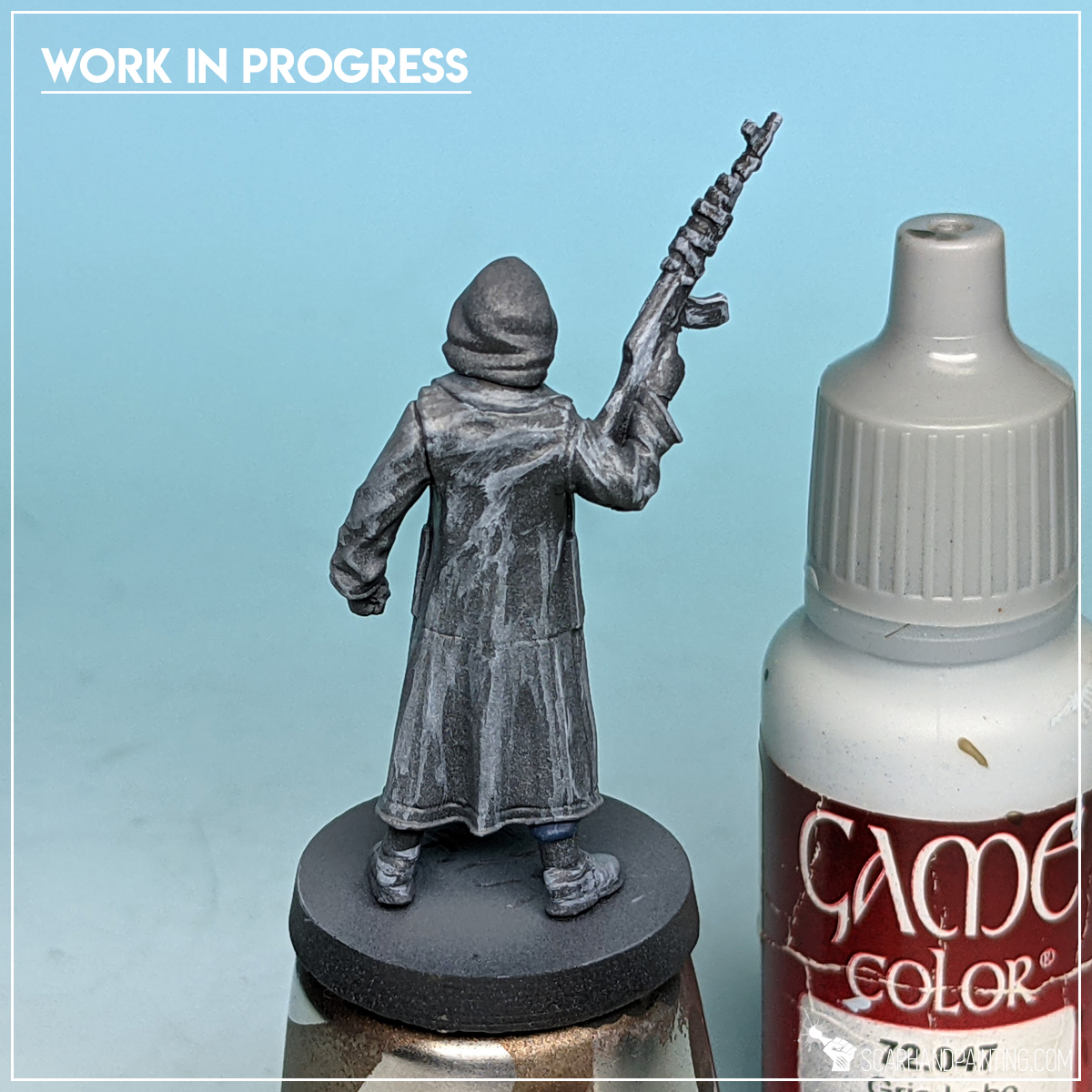
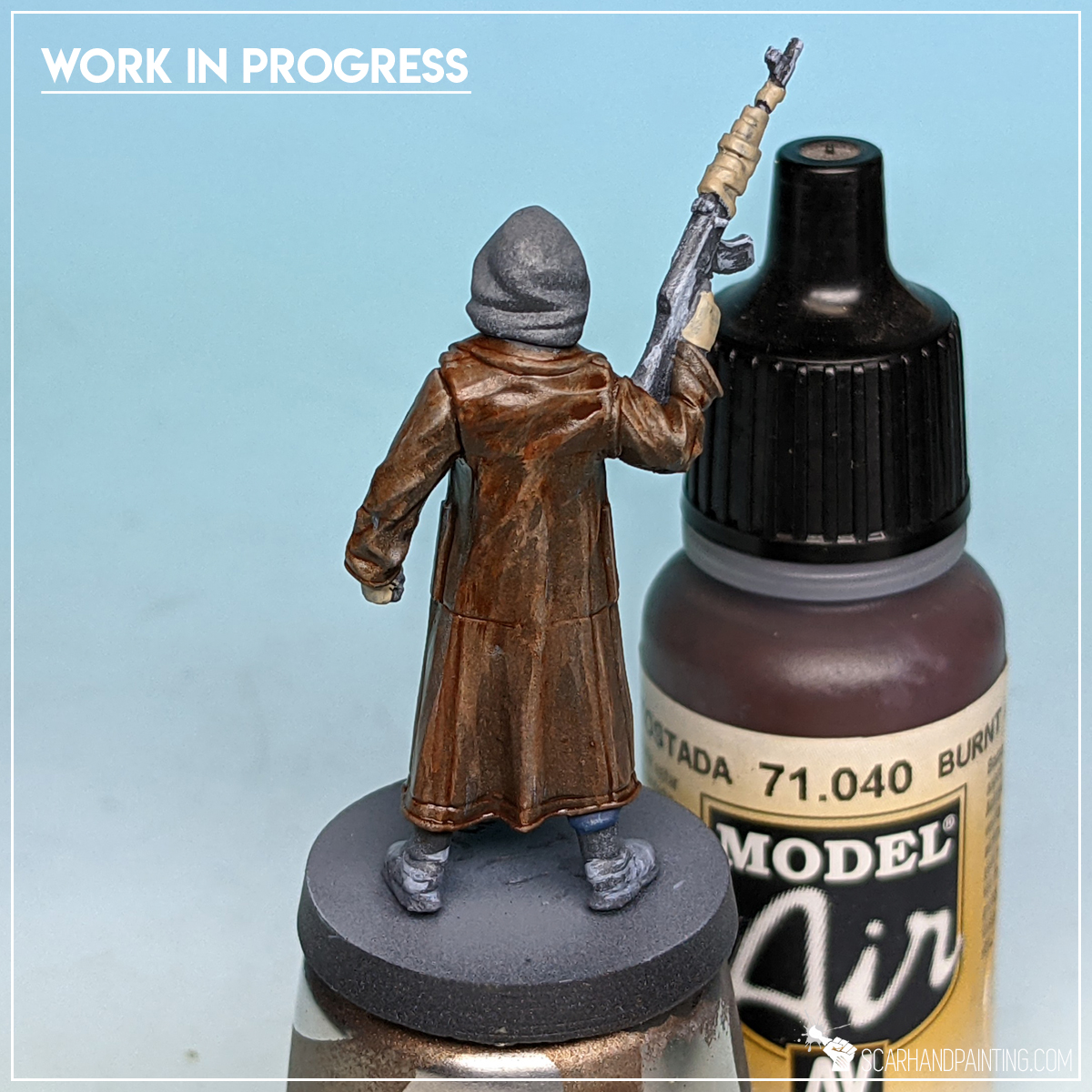
Step four: Red clothes
I moved to Reds, staring with a strong layer of Vallejo Hull Red, followed by a wide highlight of Vallejo Flat Red.
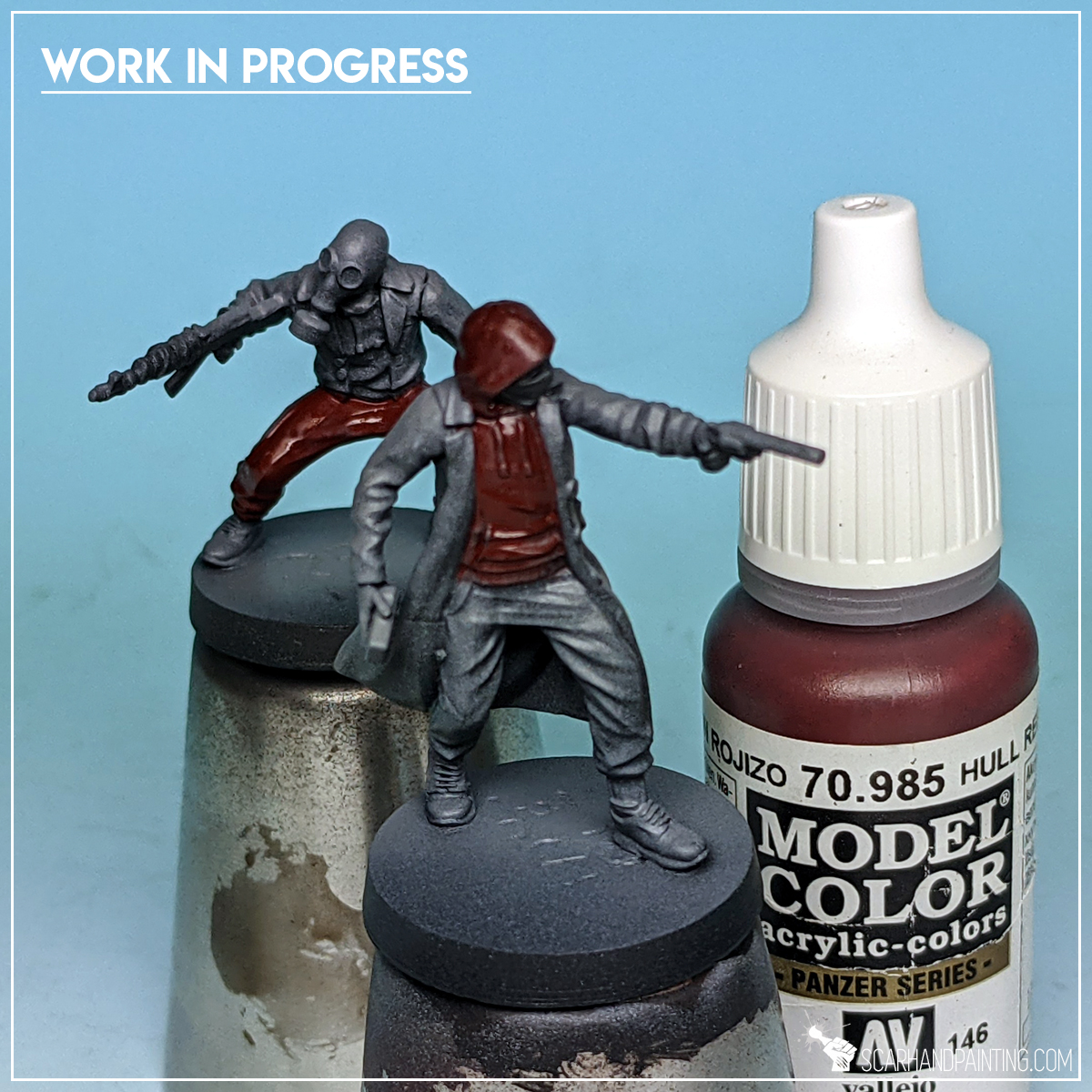
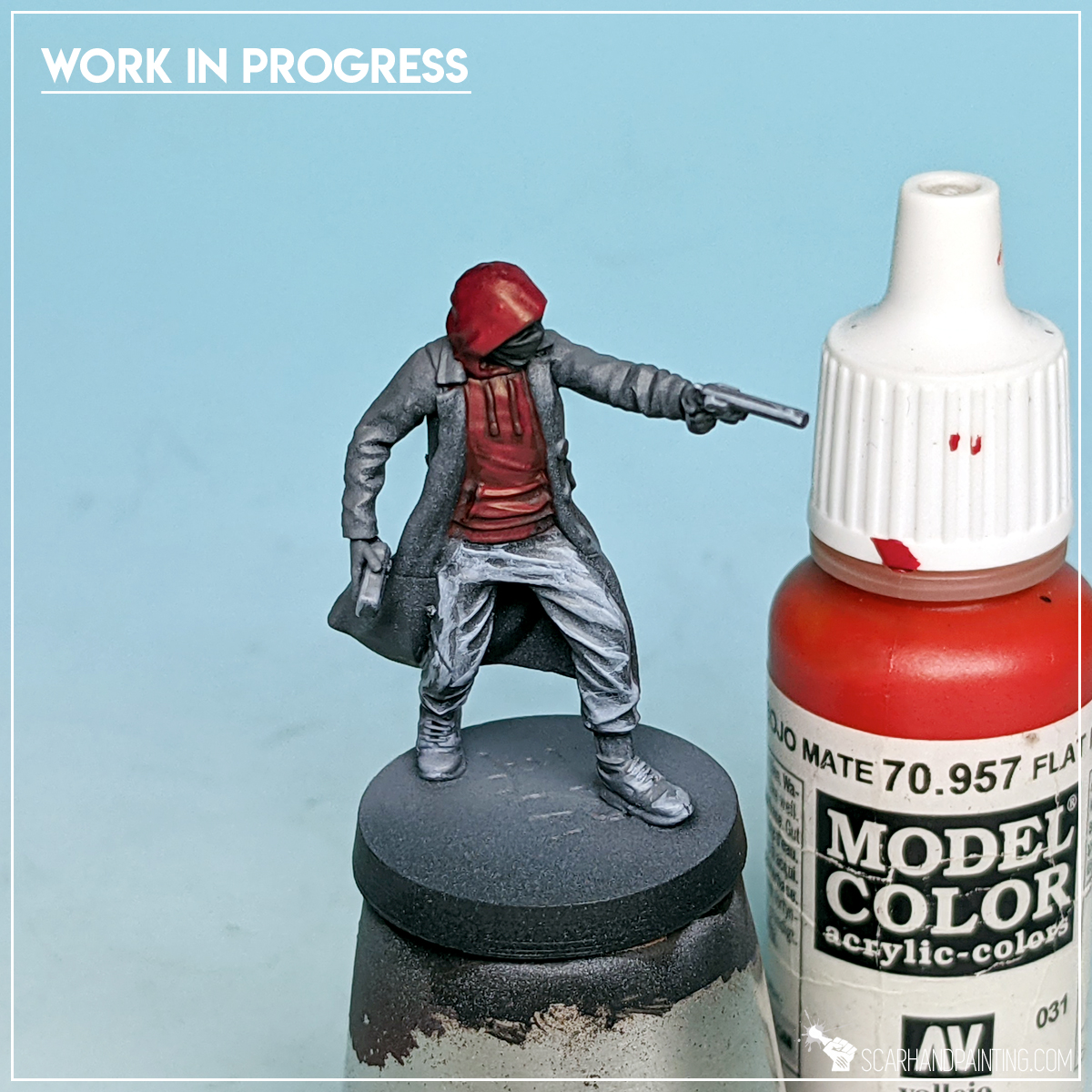
Step six: Blue clothes
Another color I took on was blue. I applied Vallejo Prussian Blue then highlighted with Vallejo Electric Blue.
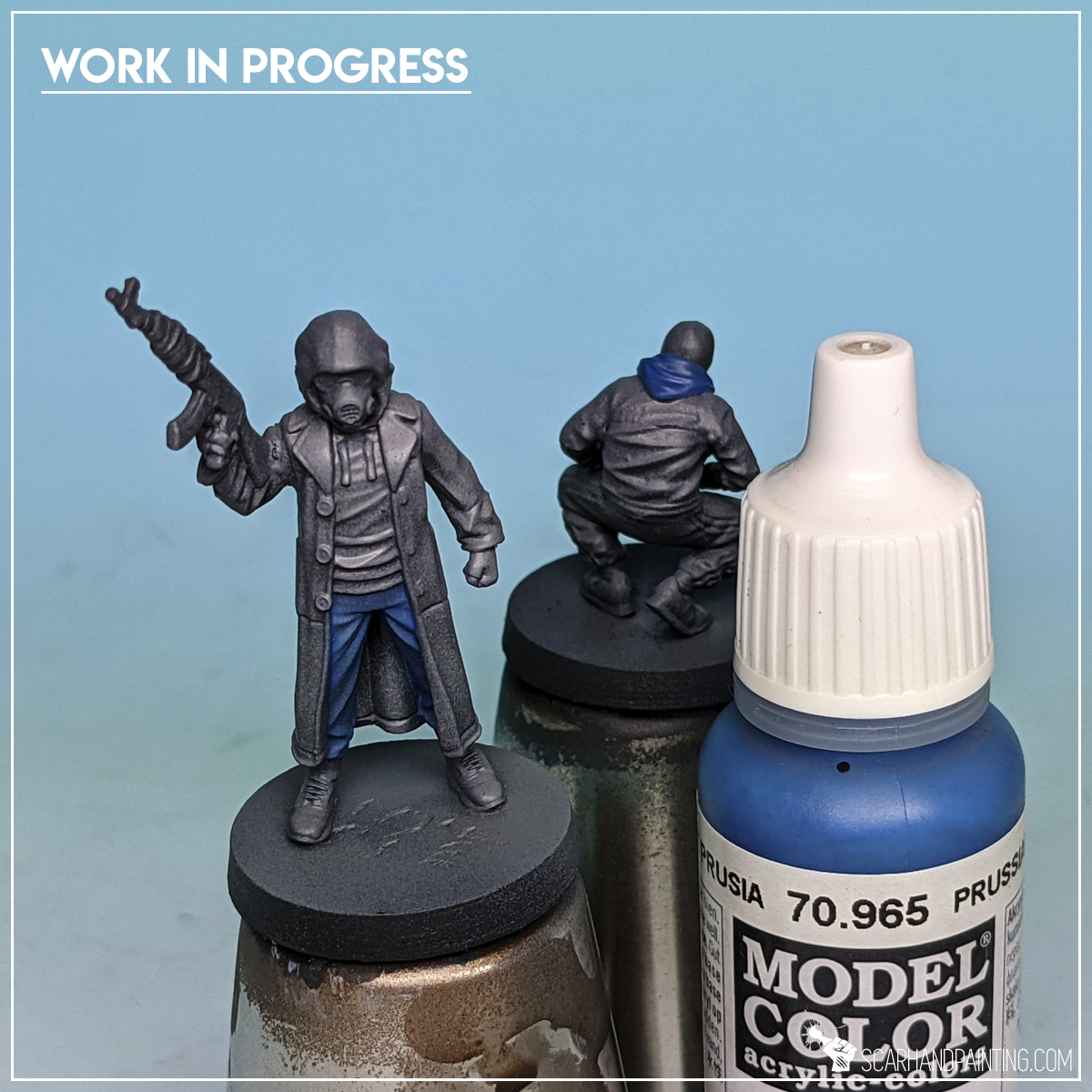
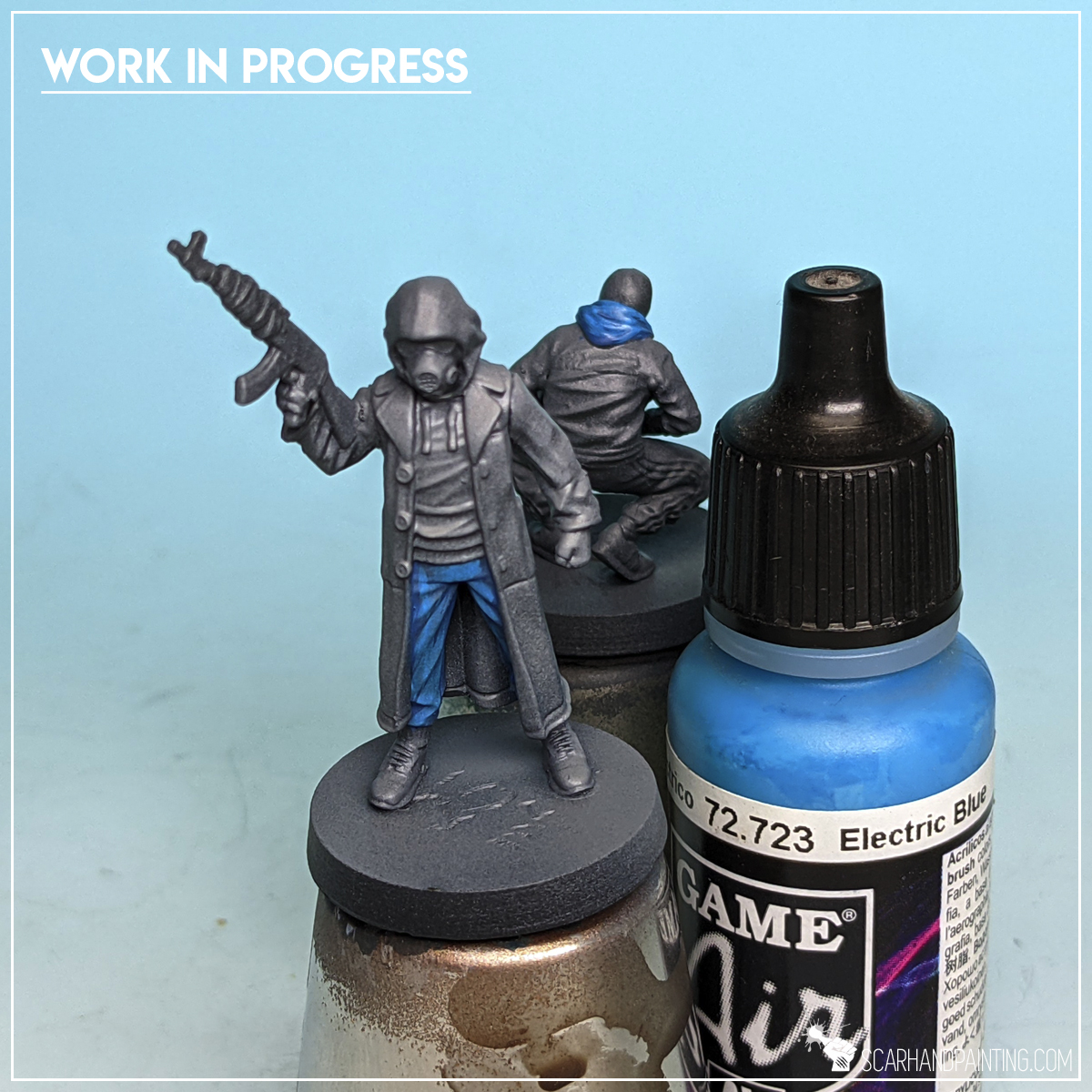
Step seven: Gas masks
For the masks and some additional detail I applied a layer of Games Workshop Karak Stone. I then strengthened the layer using Games Workshop Flayed One Flesh.
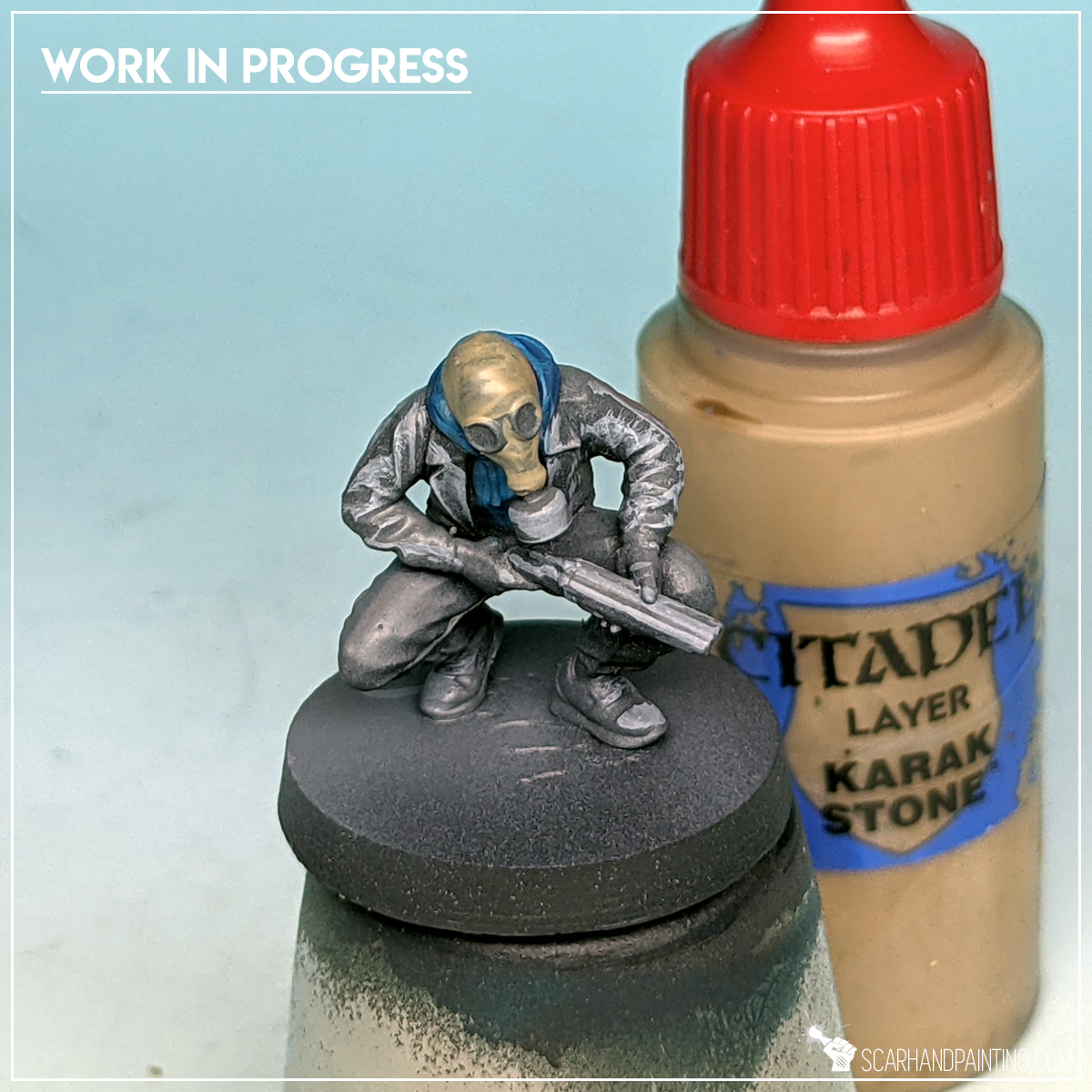
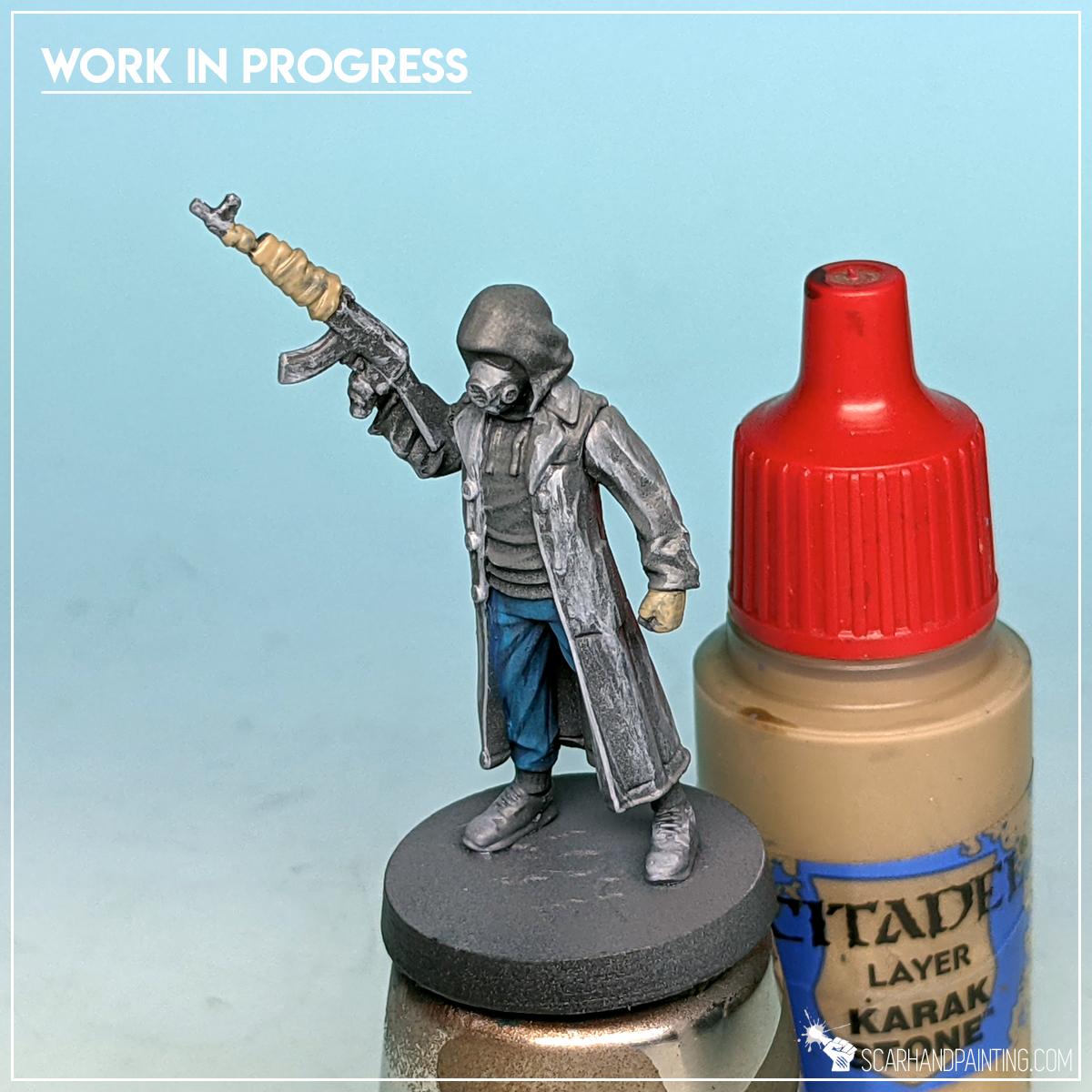
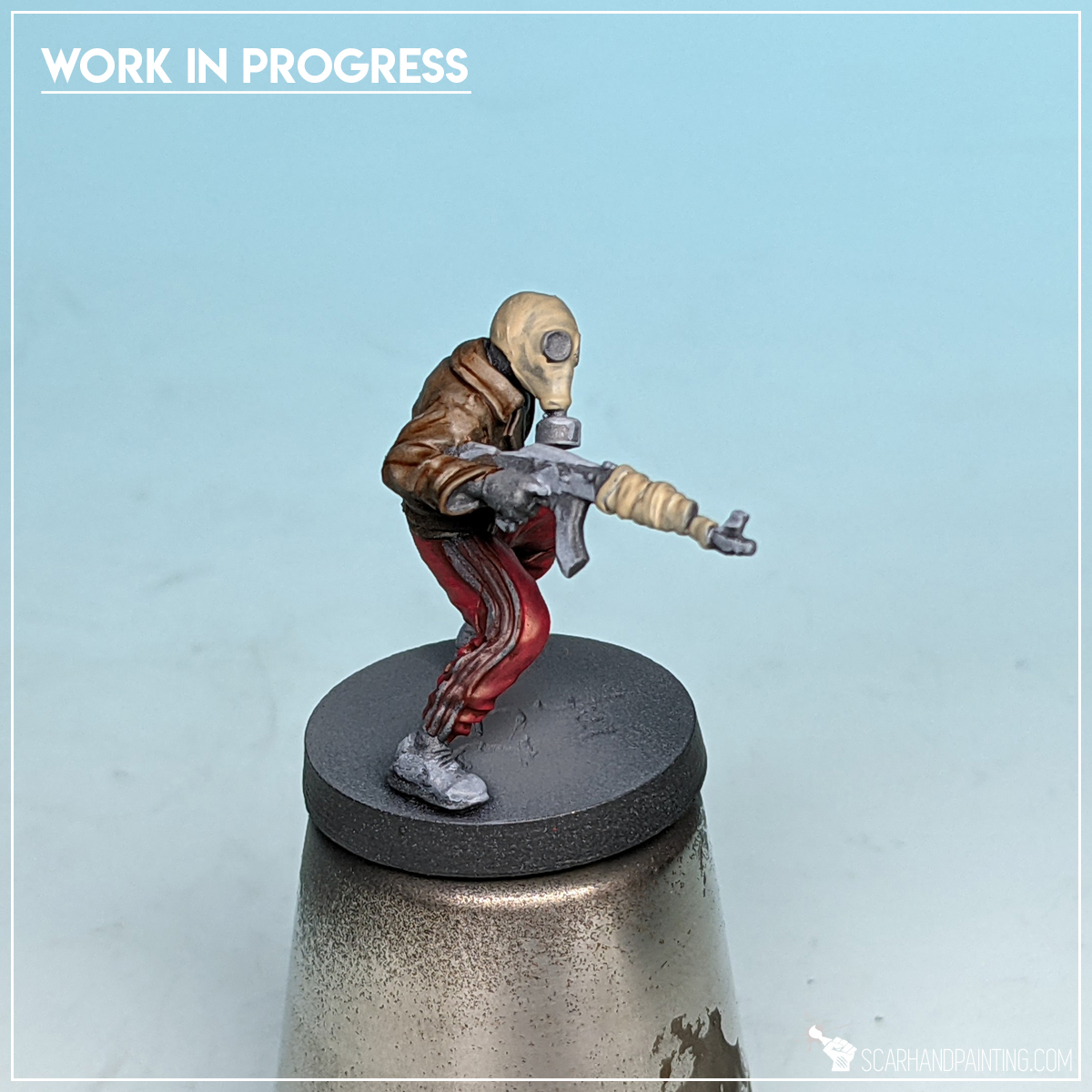
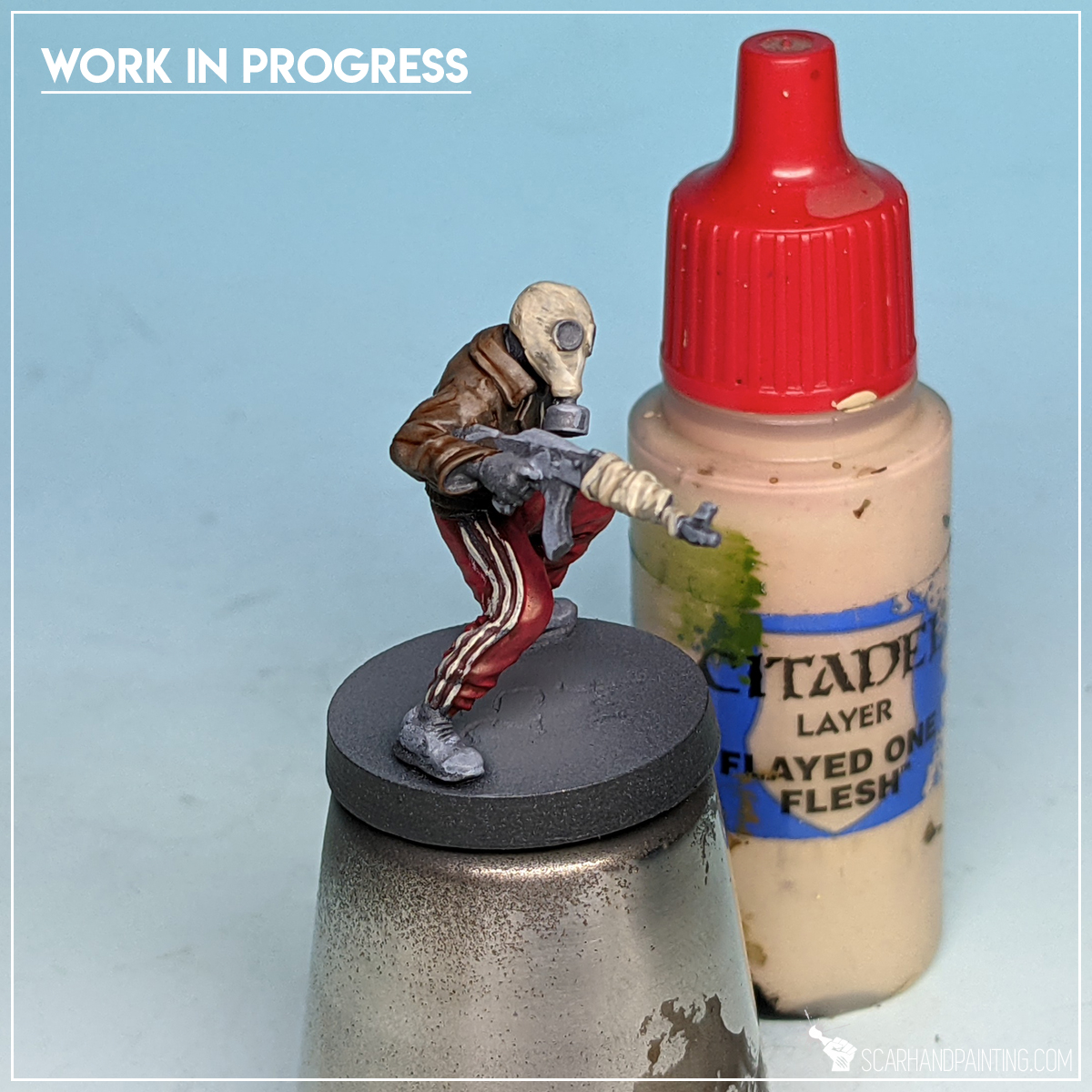
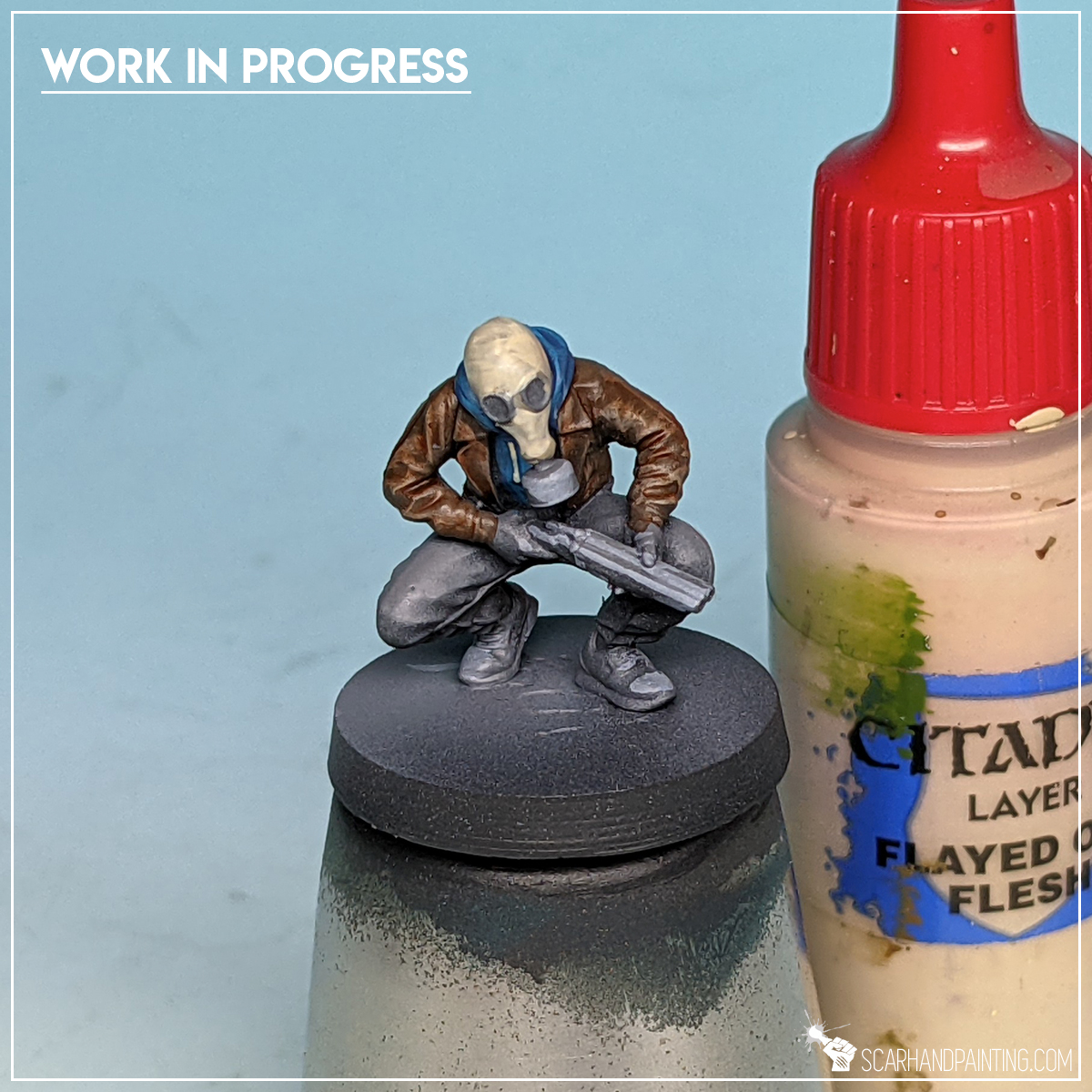
Step eight: Orange boots
For some shoes I applied a single layer of Vallejo Orange Brown. I knew boots will inevitably get messy during basing, so I decided to keep them super-simple.
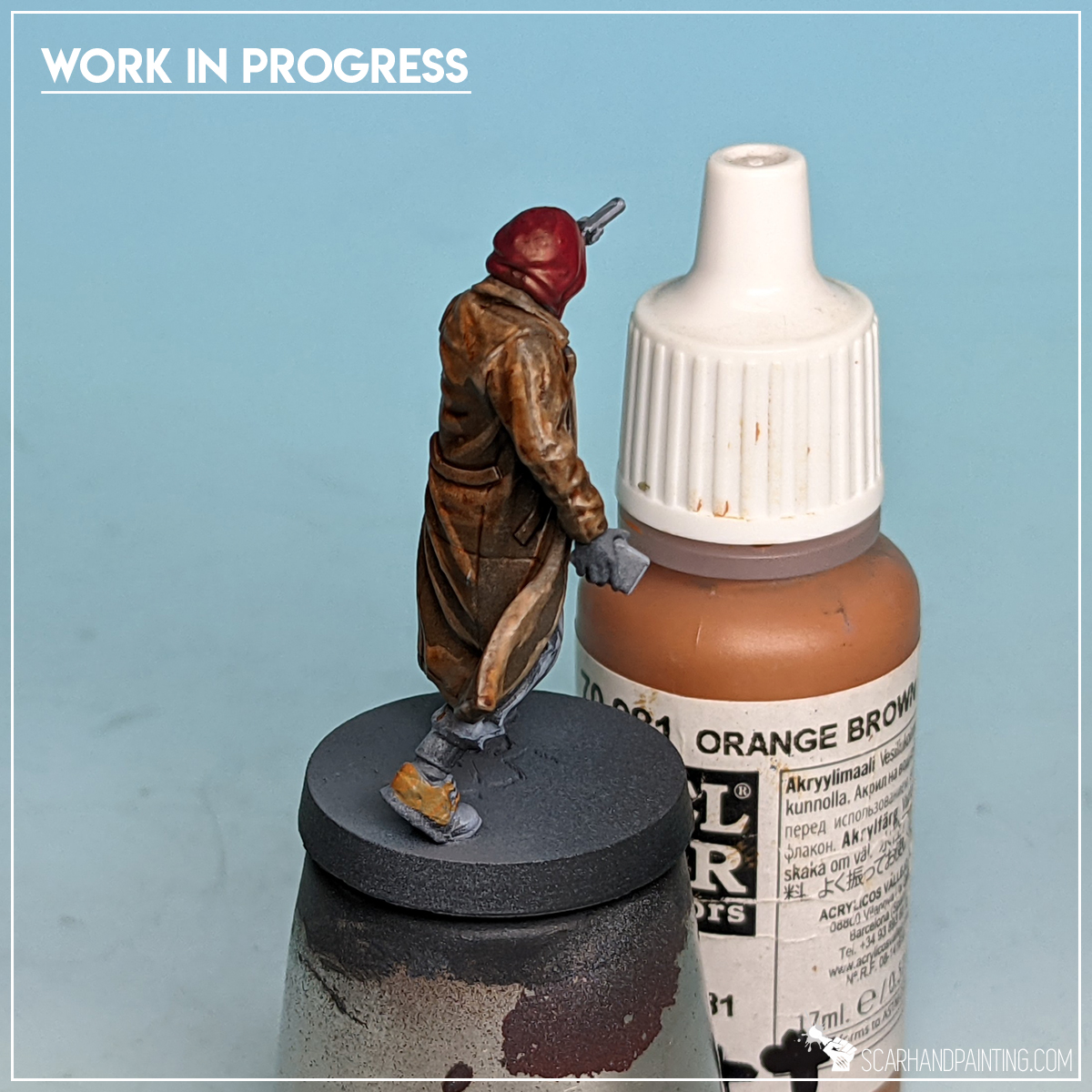
Step nine: Brown wash
Here’s where all the magic happens. I applied a strong layer of Army Painter Strong Tone Ink mixed with just a drop of Matt Varnish. I washed everything, skin* included, except for weapons*. I kept coming back to the miniatures to remove the ostentatious excess of wash throughout the drying process.
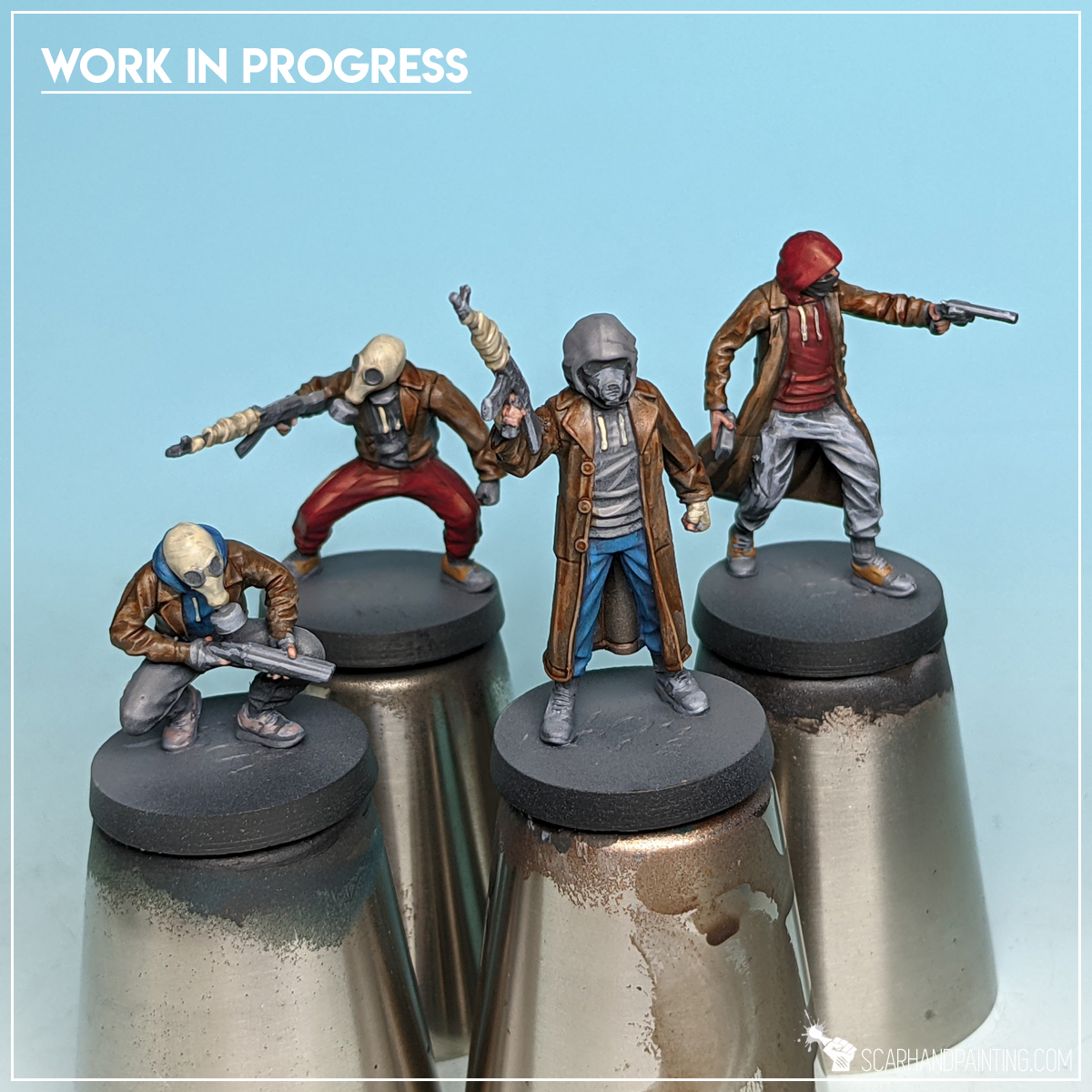
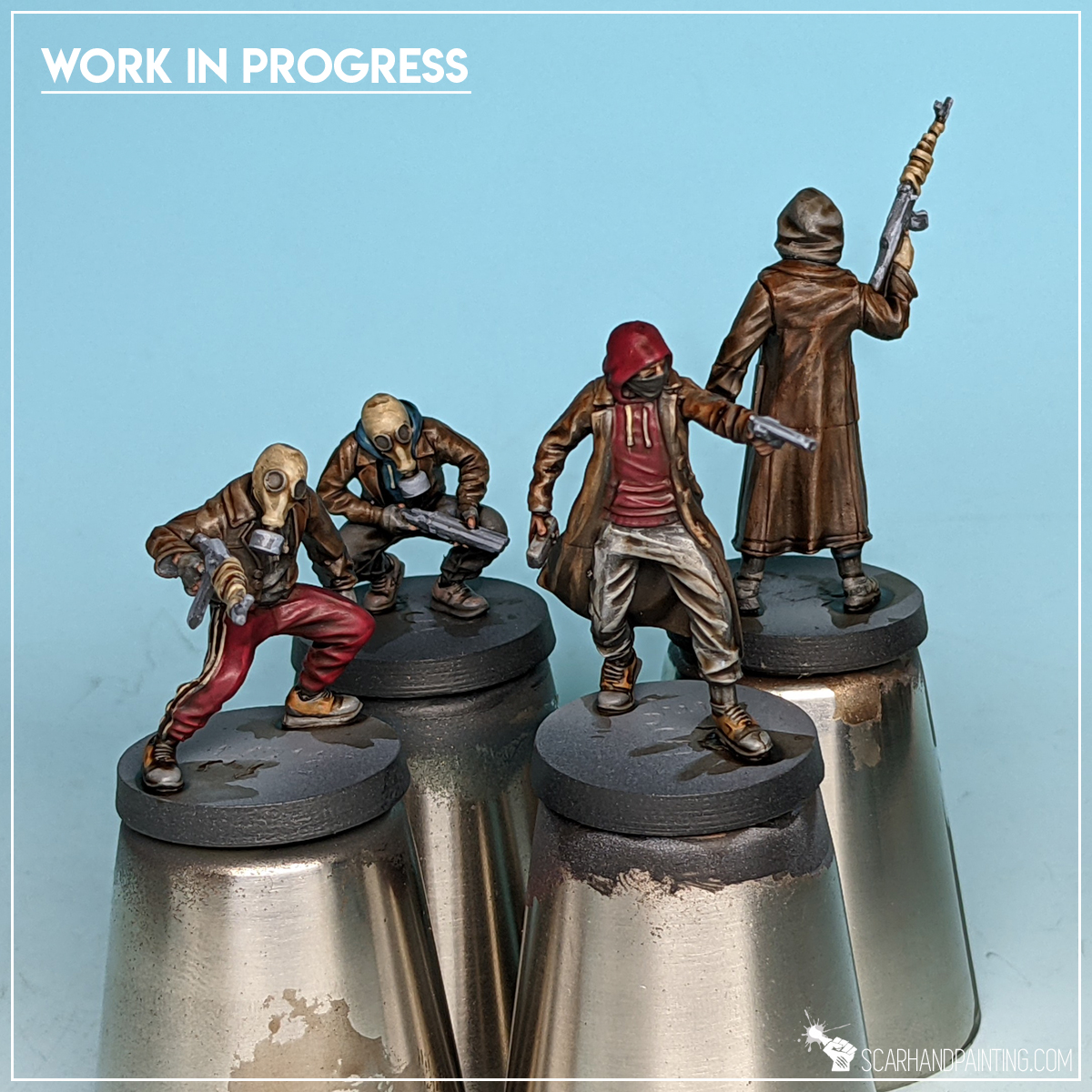
Step ten: Highlights
I used Vallejo Glacier Blue and Games Workshop Pallid Wych Flesh to highlight blue, black and paint some extra detail on the shoes and buttons.
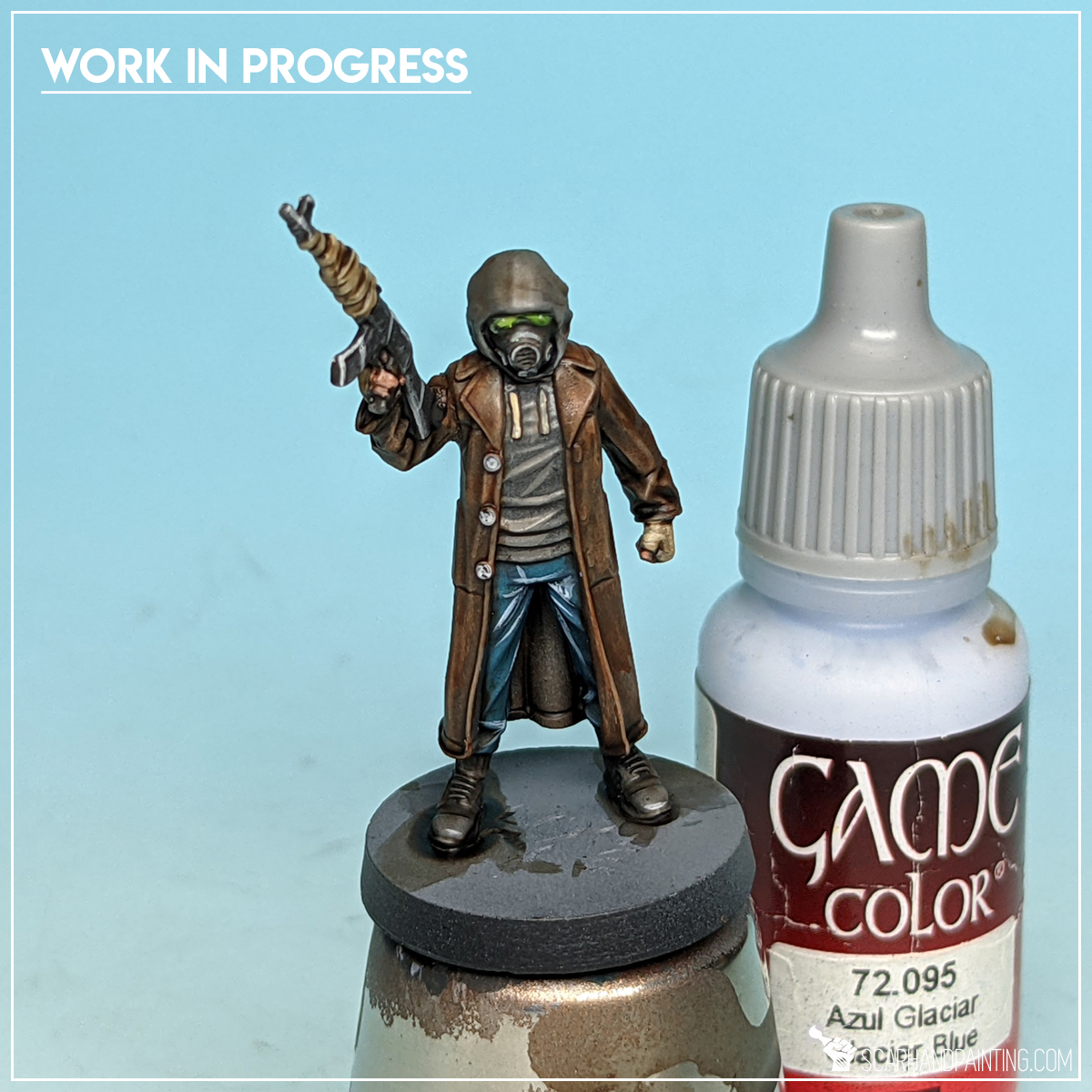
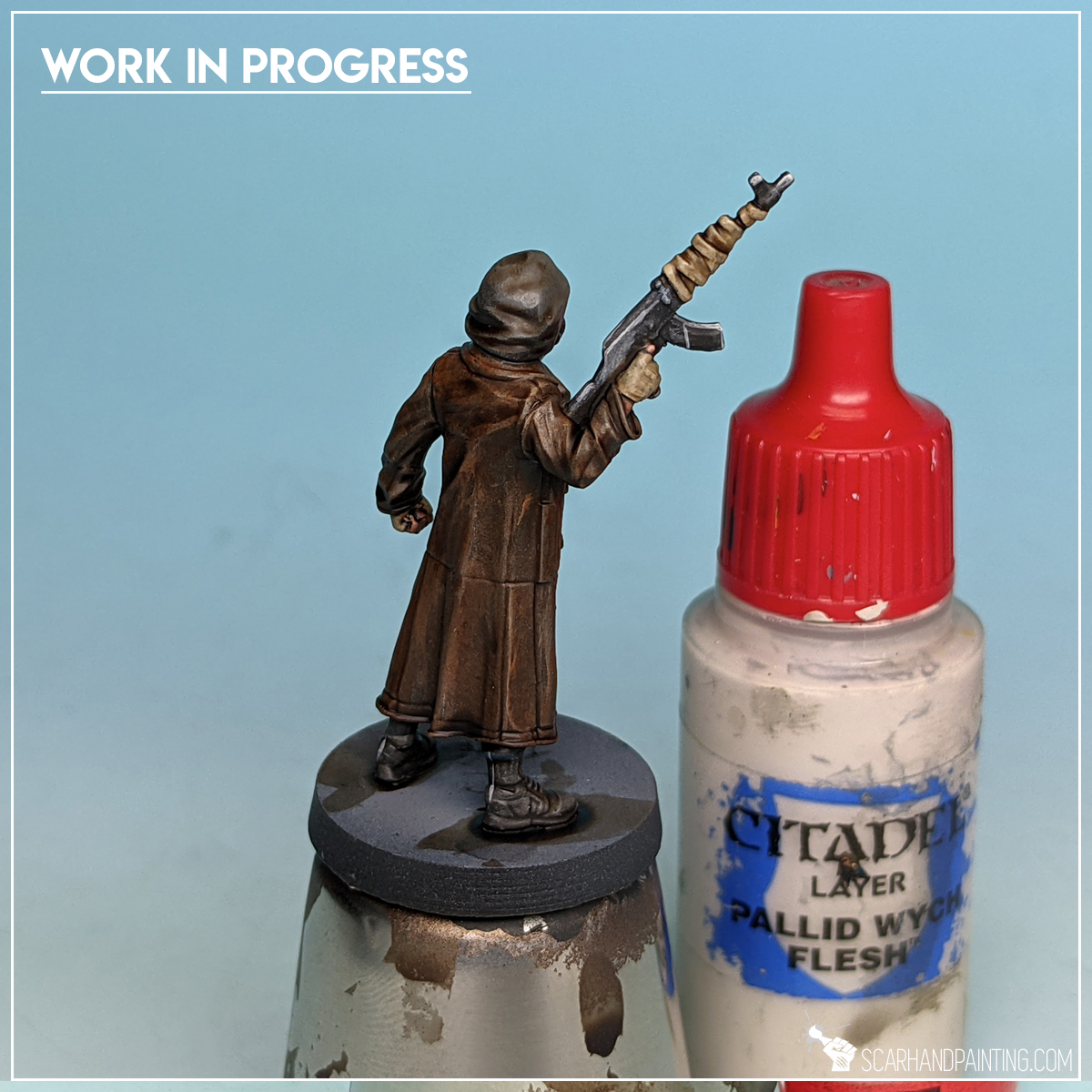
Step eleven: Gasmask visors
Finally I painted gasmask visors with Games Workshop Pallid Wych Flesh, followed by Vallejo Light Livery Green. I then applied a glaze of Games Workshop Waywatcher Green. Last step was to paint diagonal lines of Vallejo Off White through the visors – adding that extra flash effect to them.
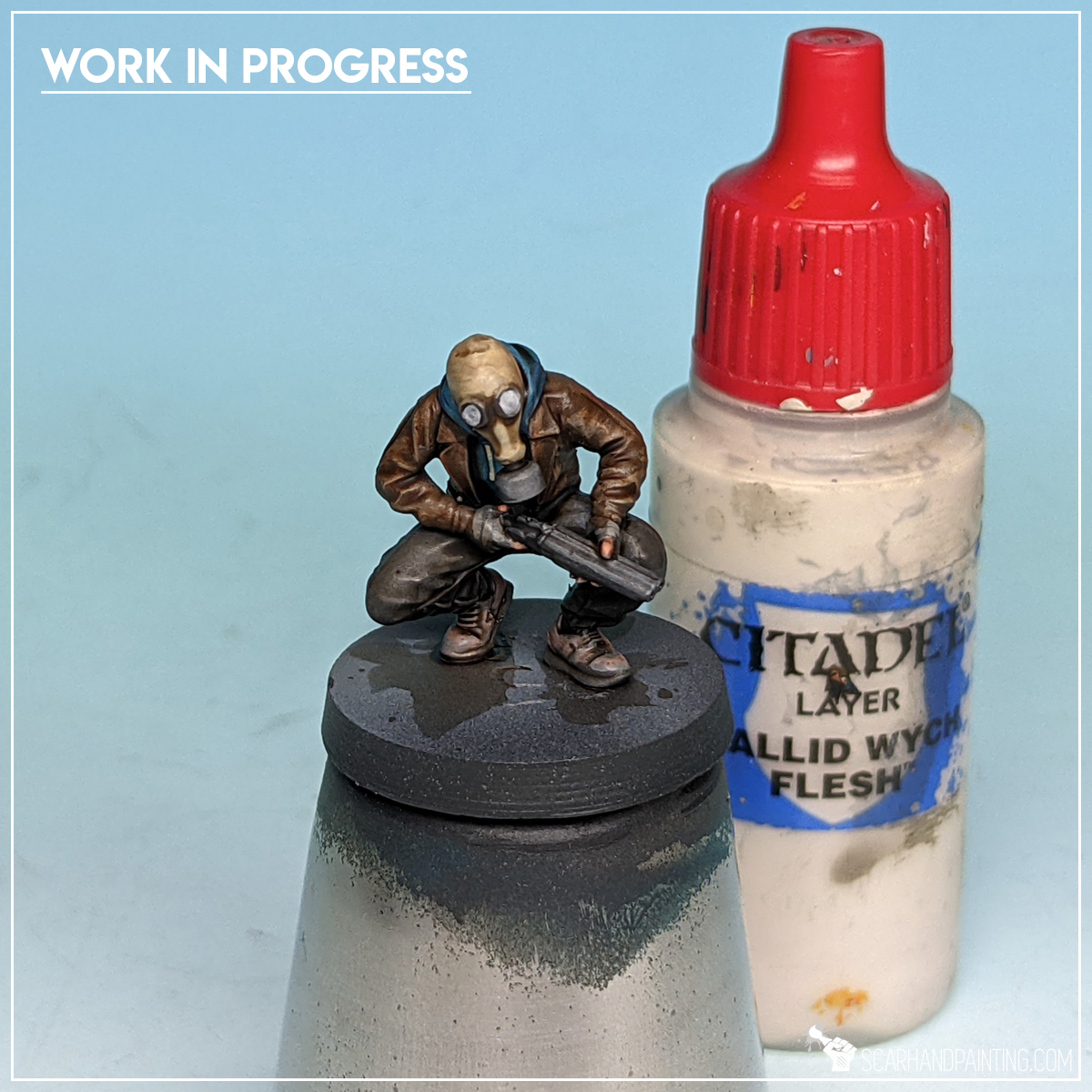
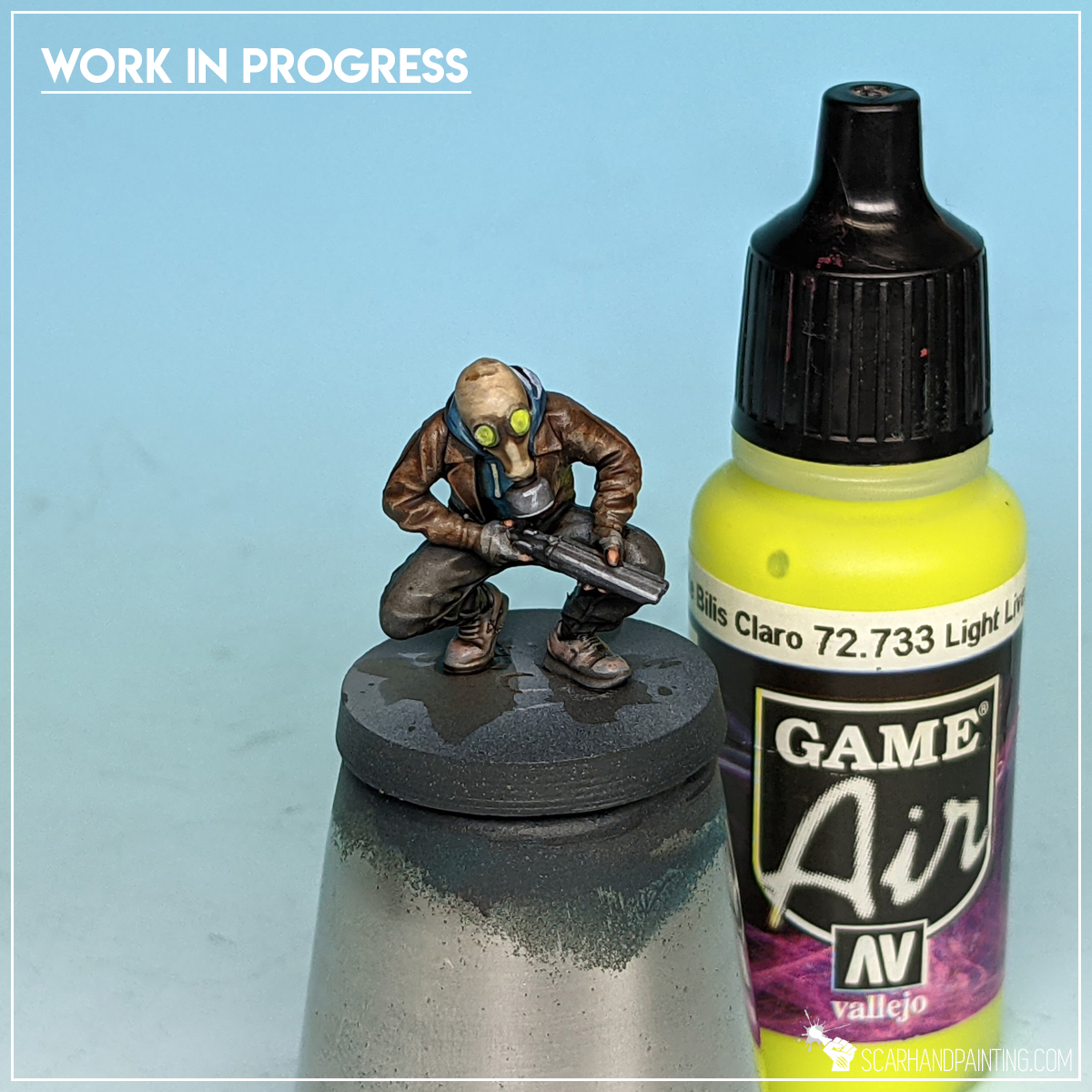
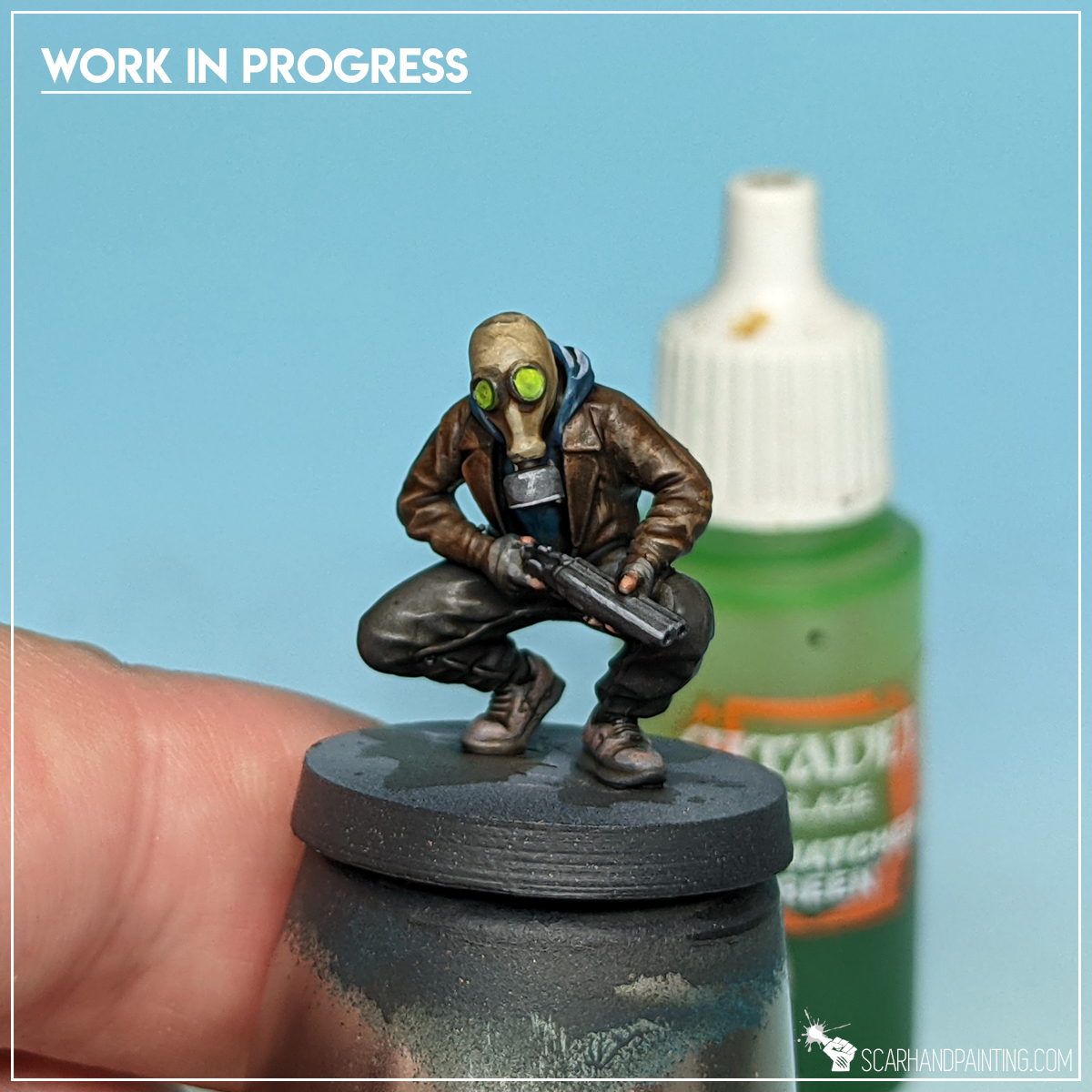
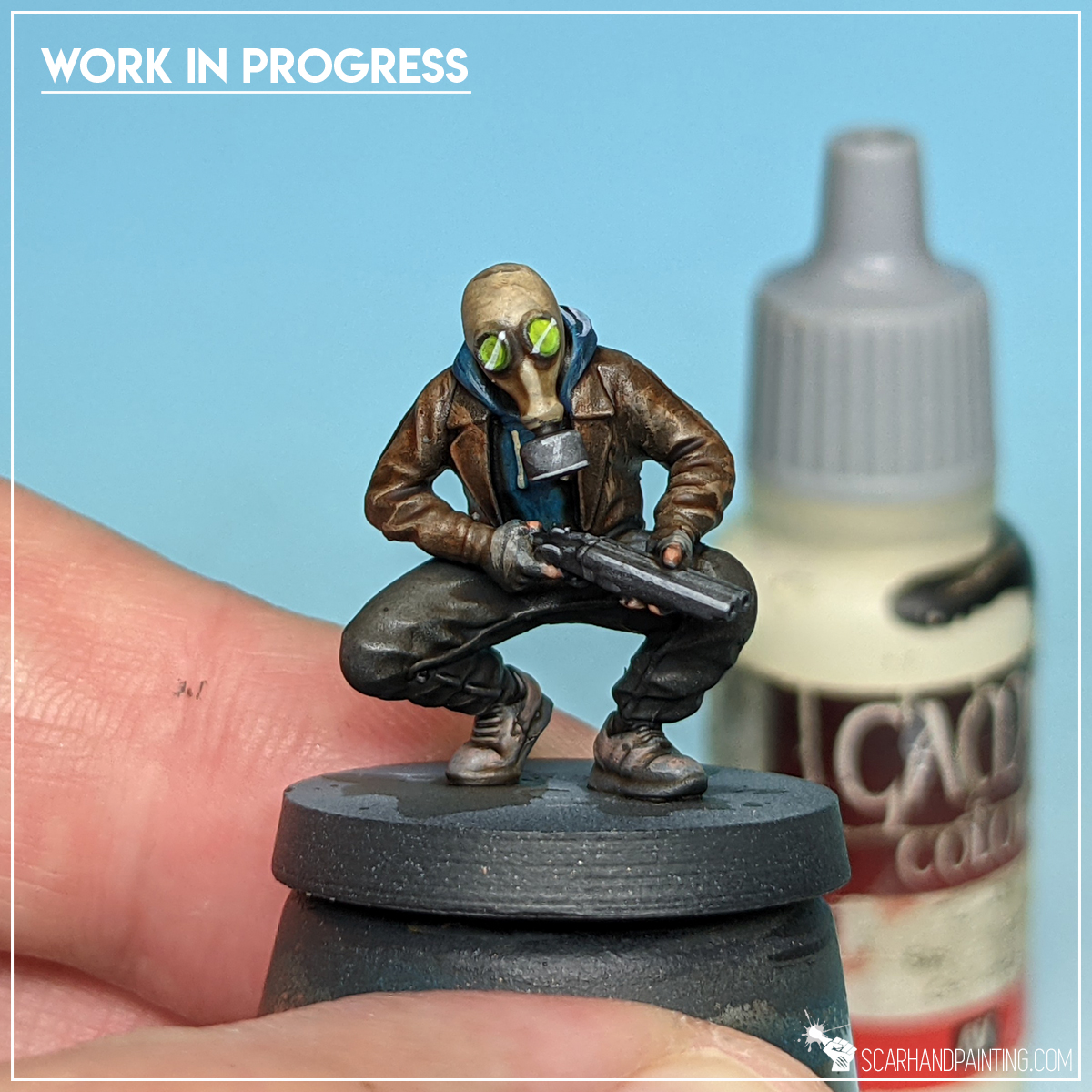
Other steps: *You can learn how to paint weapons, skin and bases in previous tutorial: Painting Post-apo Survivors part 1 Stalkers

I hope you find this tutorial interesting. Be sure to let me know your thoughts in the comments below or via Facebook.or Instagram. I would also appreciate if you considered sharing this content with your friends, who might find it useful. Finally if you are looking for a professional miniatures painting service be sure to contact me with this contact form. I always reply within 24 hours, after which please check out your spam folder.
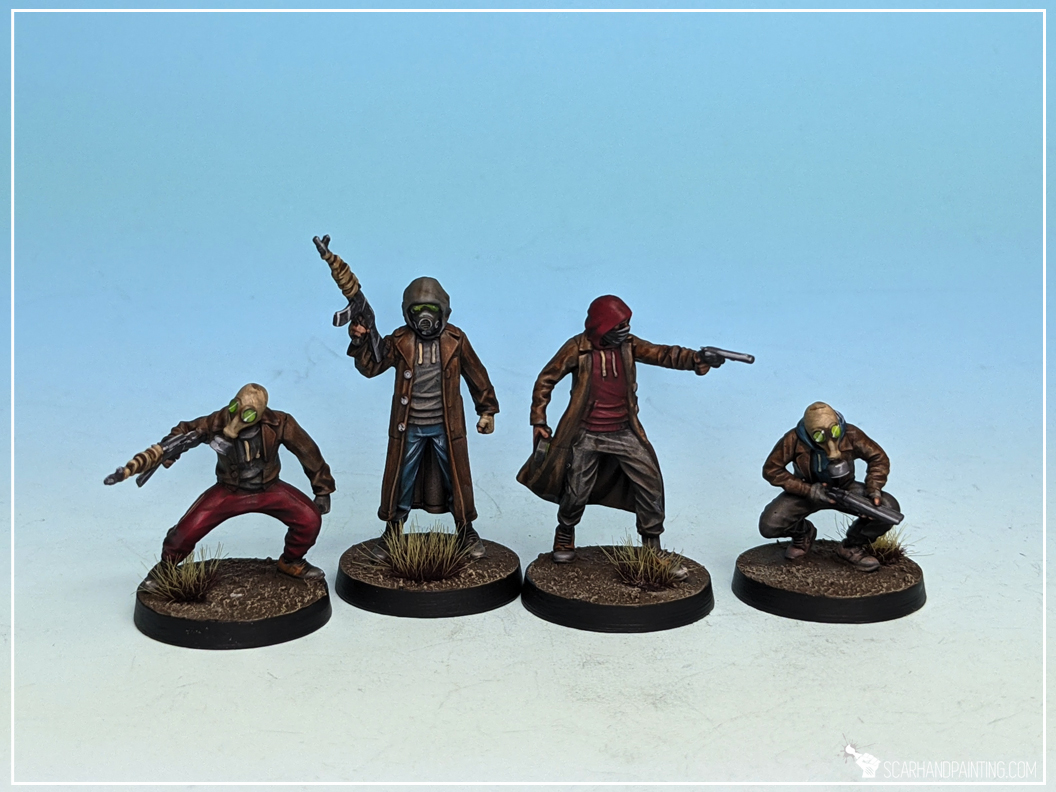
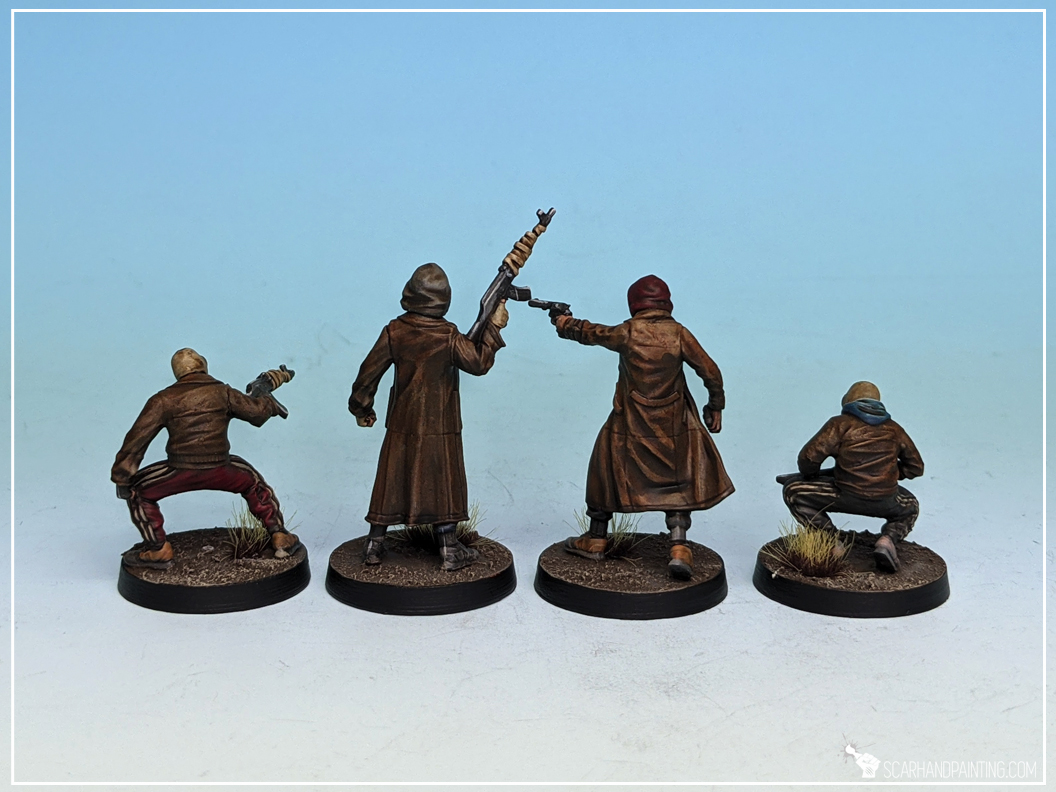

Welcome to Painting Empire of Dust Monolith tutorial. Here I will present to you a Step-by-step of an easy and fast painting process for Mantic Games Empire of Dust Monolith as can be seen in Gallery: Armada Empire of Dust.
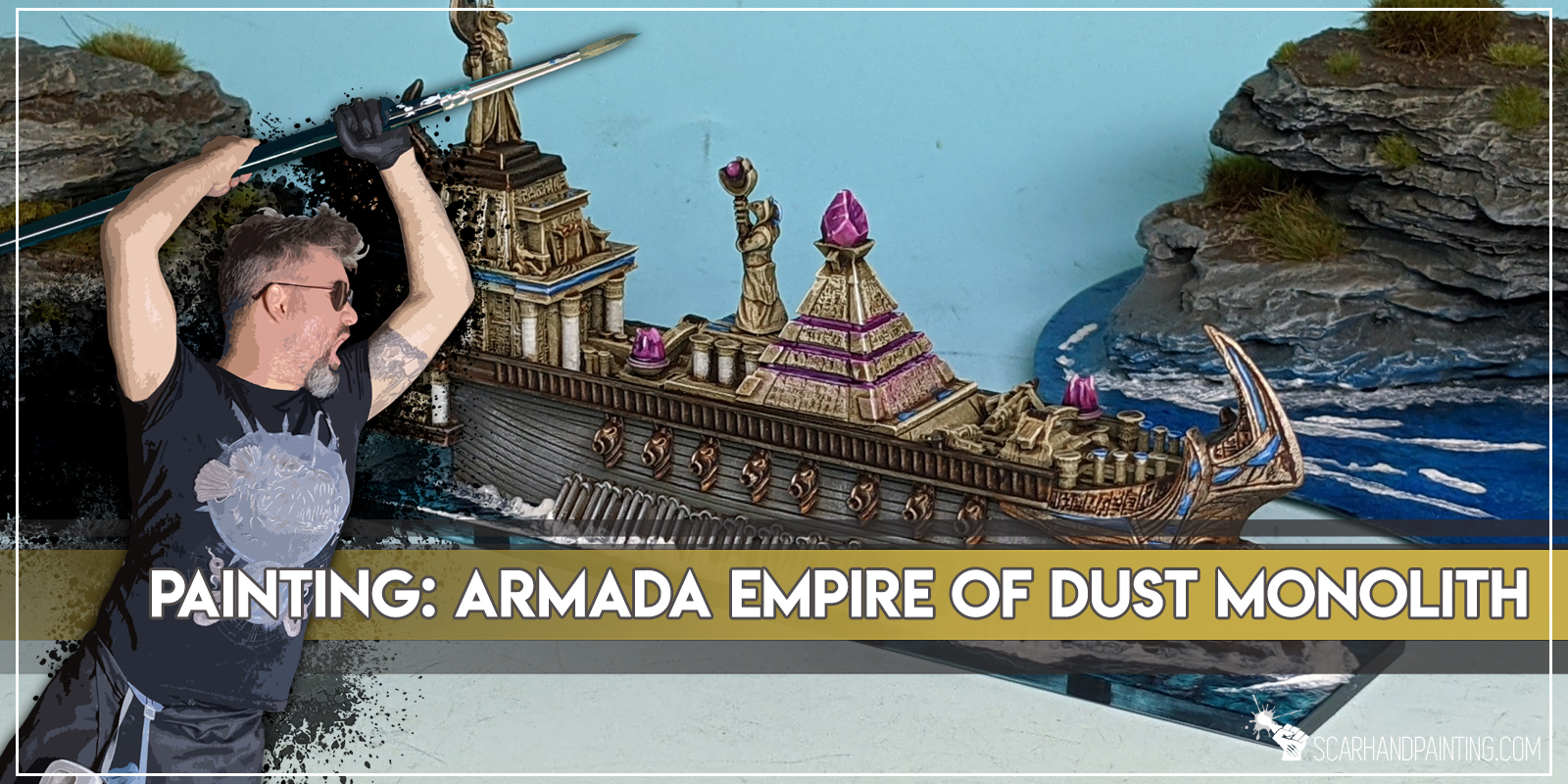
Before we start, some notes:
Step one: Undercoat
I started with a thorough layer of Games Workshop Chaos Black spray.
Step two: Deck
I airbrushed Vallejo Khaki (air) over main deck and all top structures. I then flatbrushed GW Flayed One Flesh on top of Khaki layer.
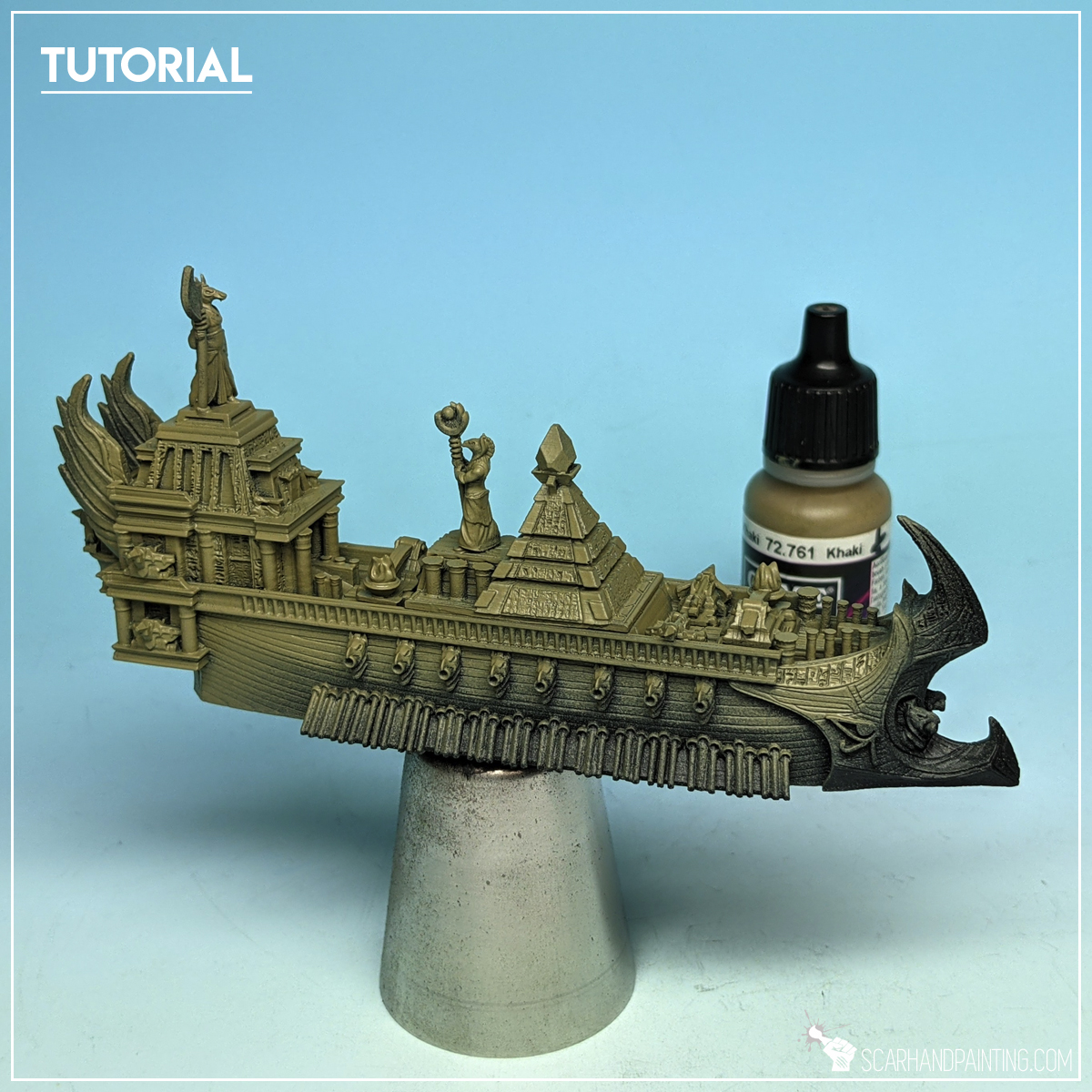
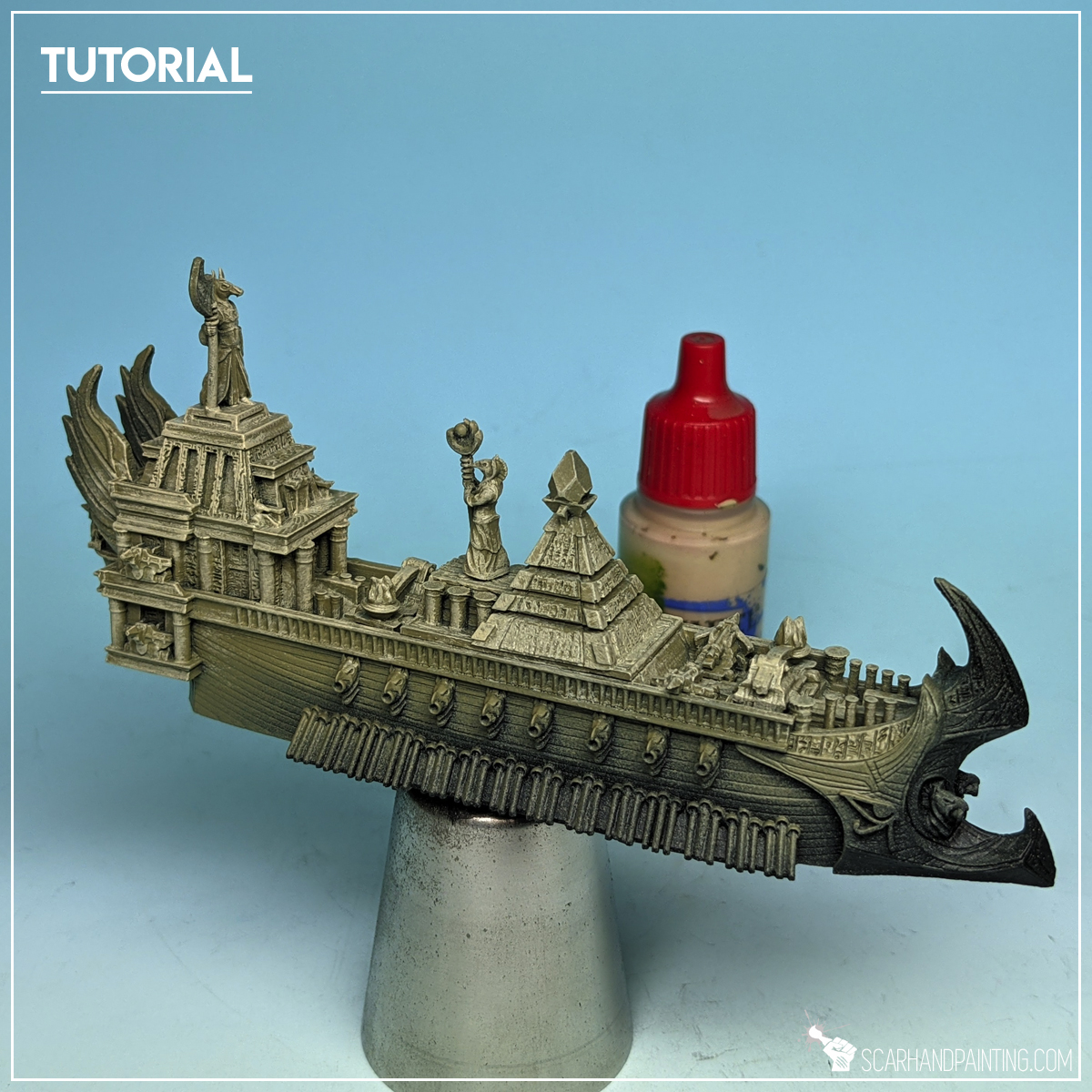
Step three: Broadside
I airbrushed Vallejo Panzer Dark Grey (air), followed by a layer of Vallejo Cold Grey (air).
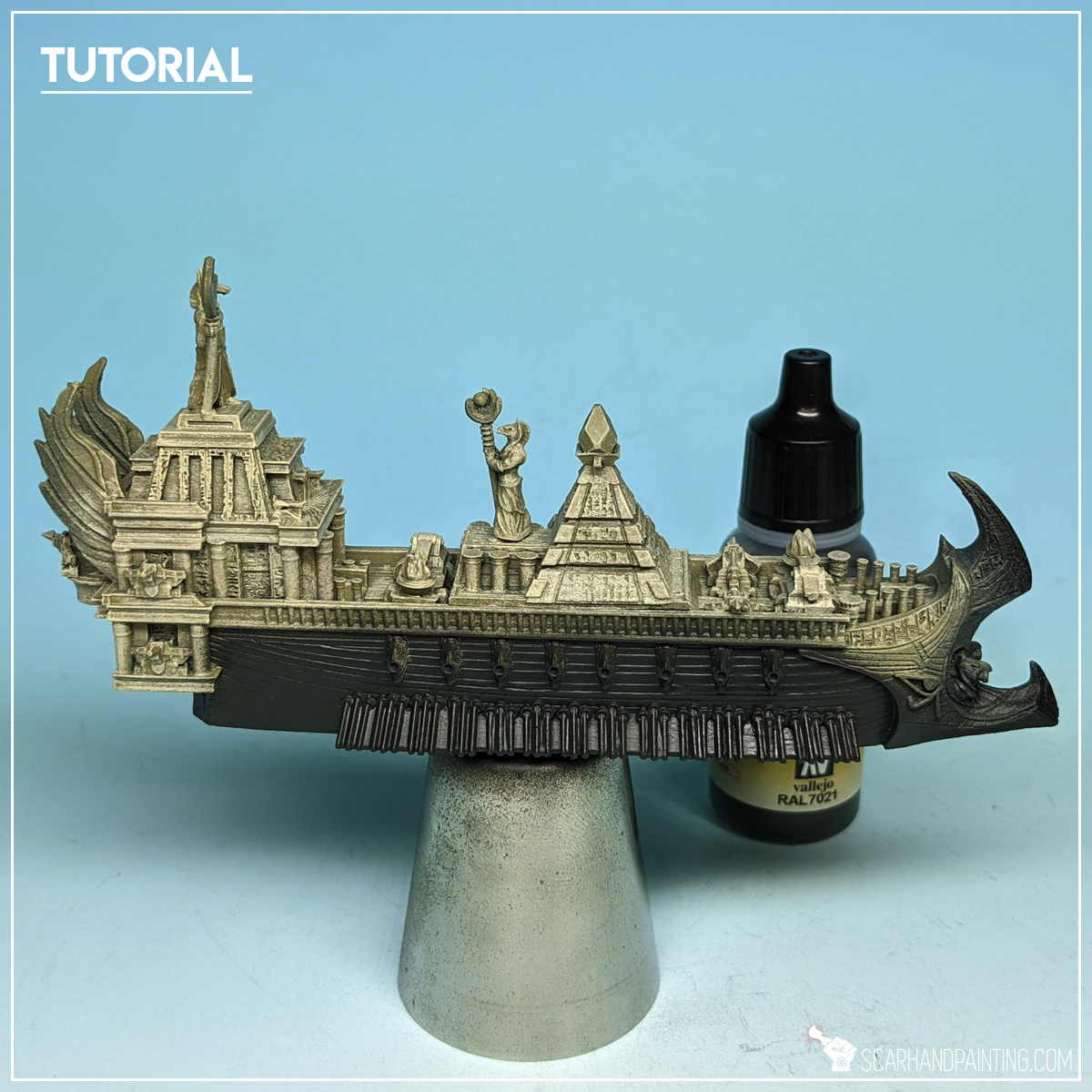
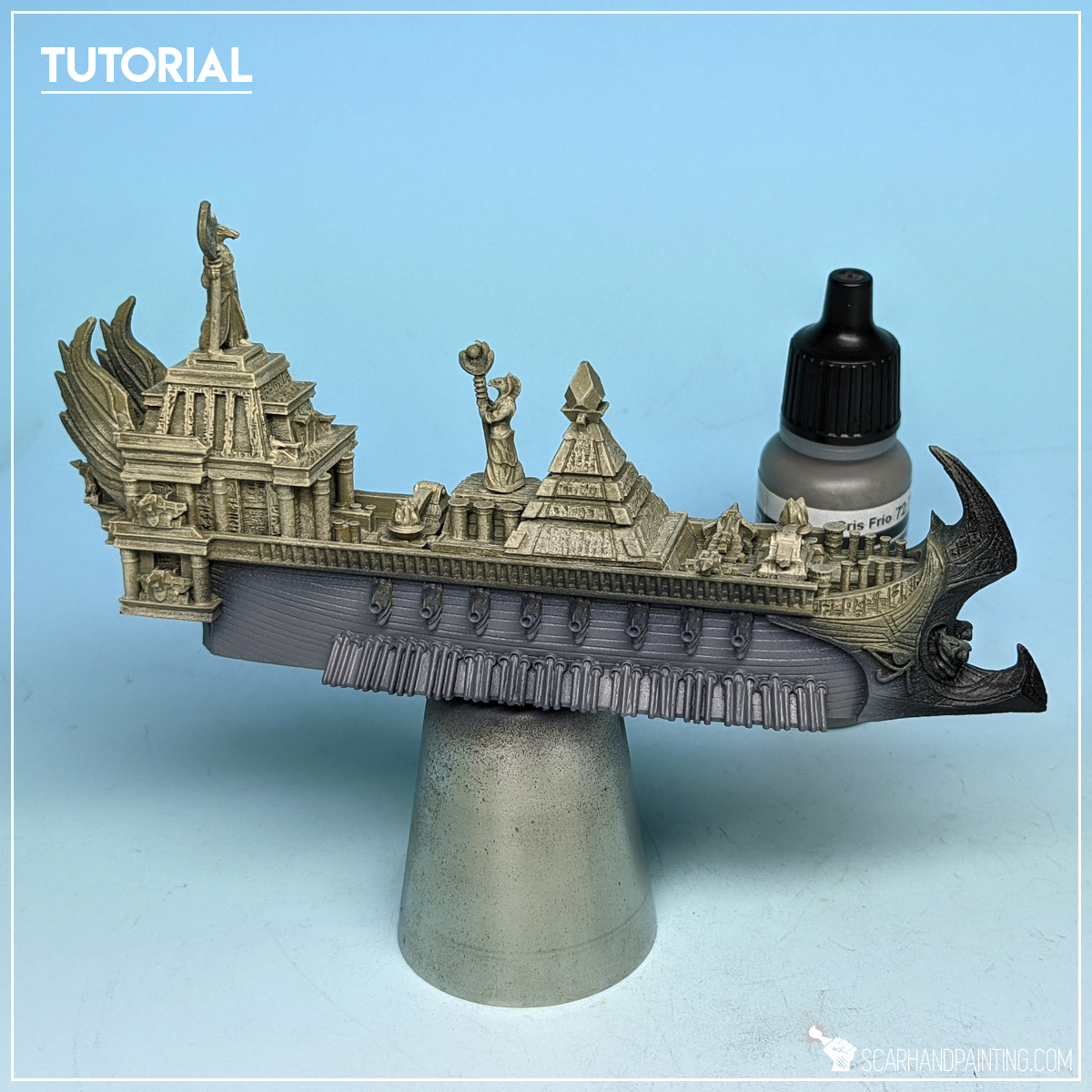
Step four: Gold
I then painted front and side ornaments, plus some additional detail with GW Warplock Bronze, followed by a solid flatbrush of P3 Molten Bronze and a highlight of Army Painter Shining Metal.
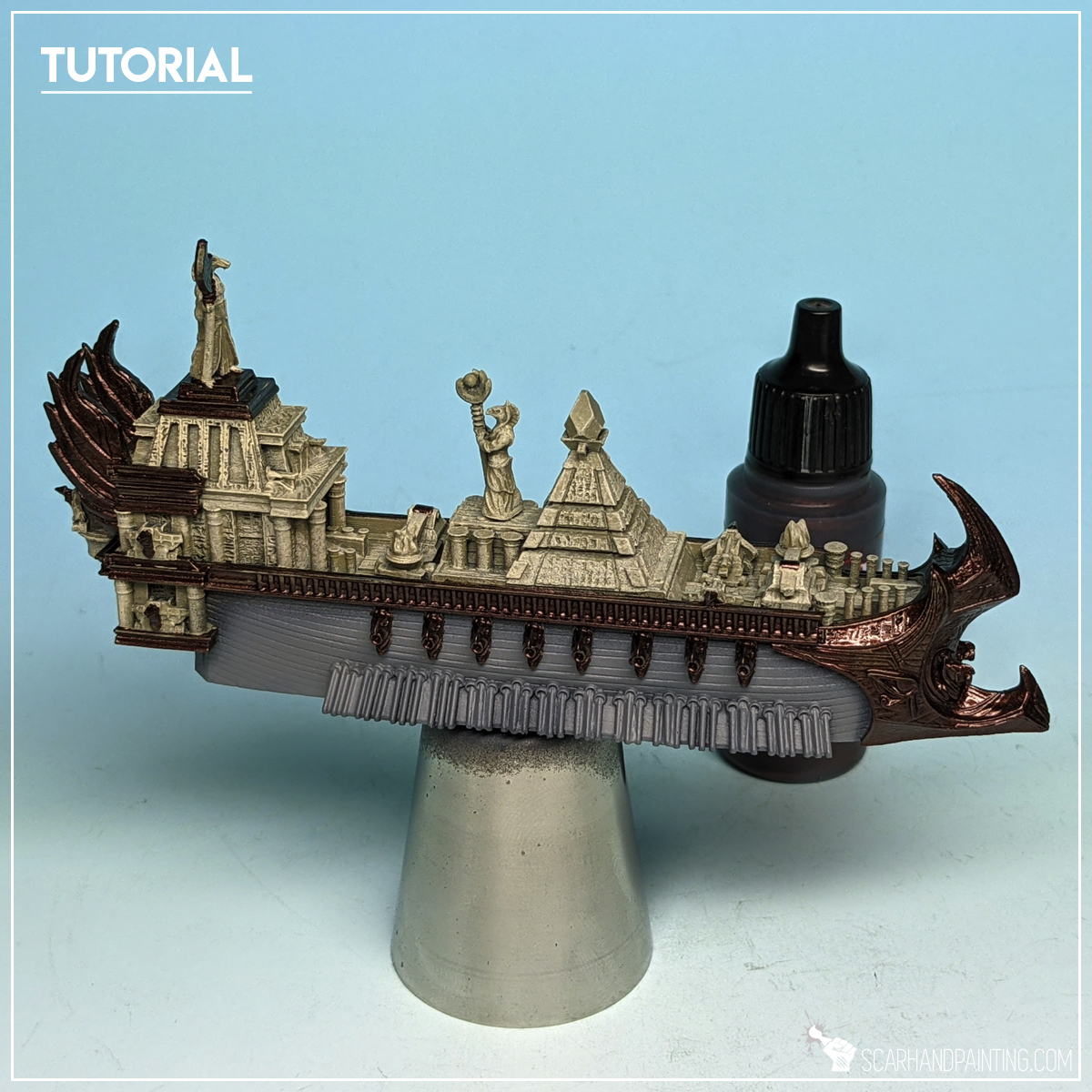
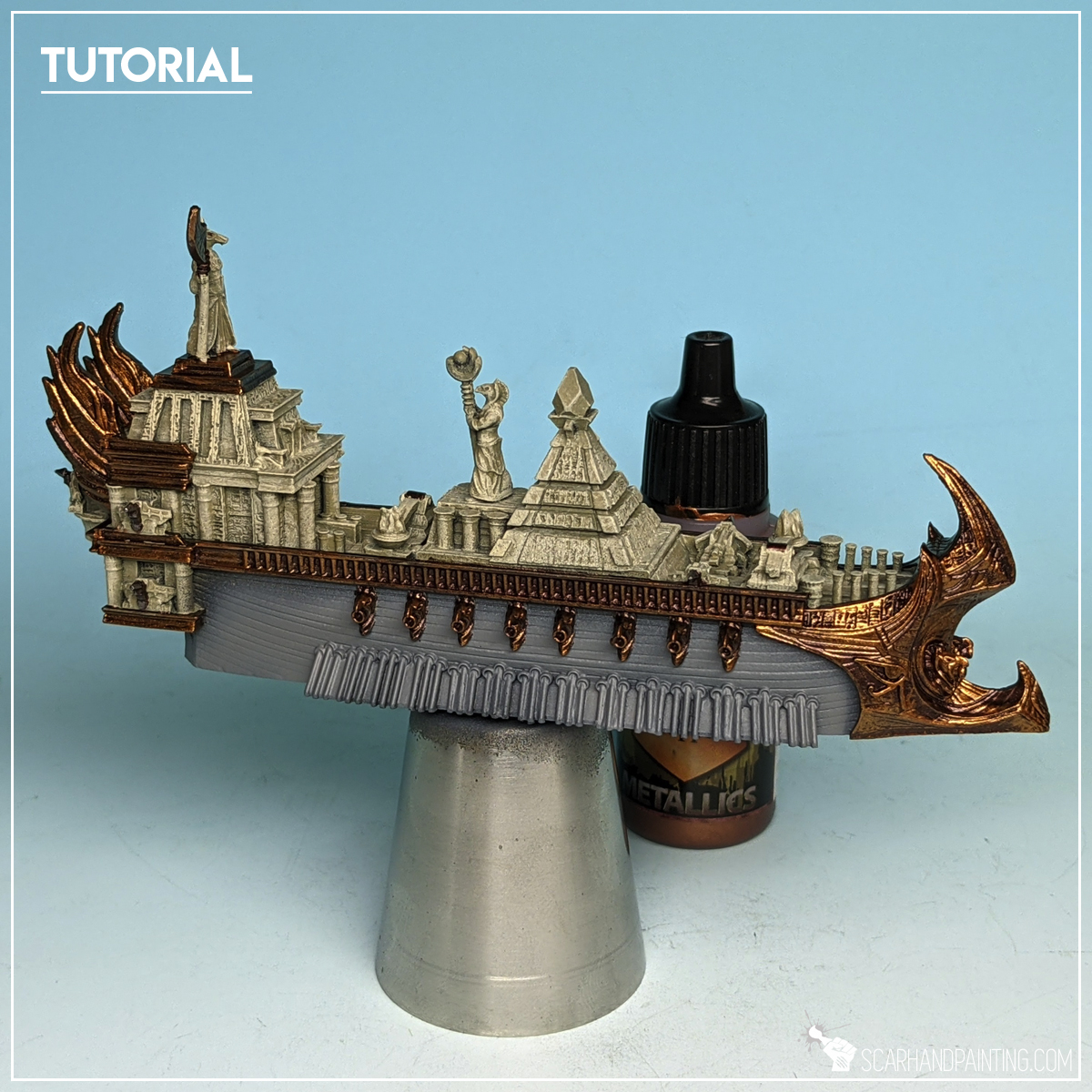
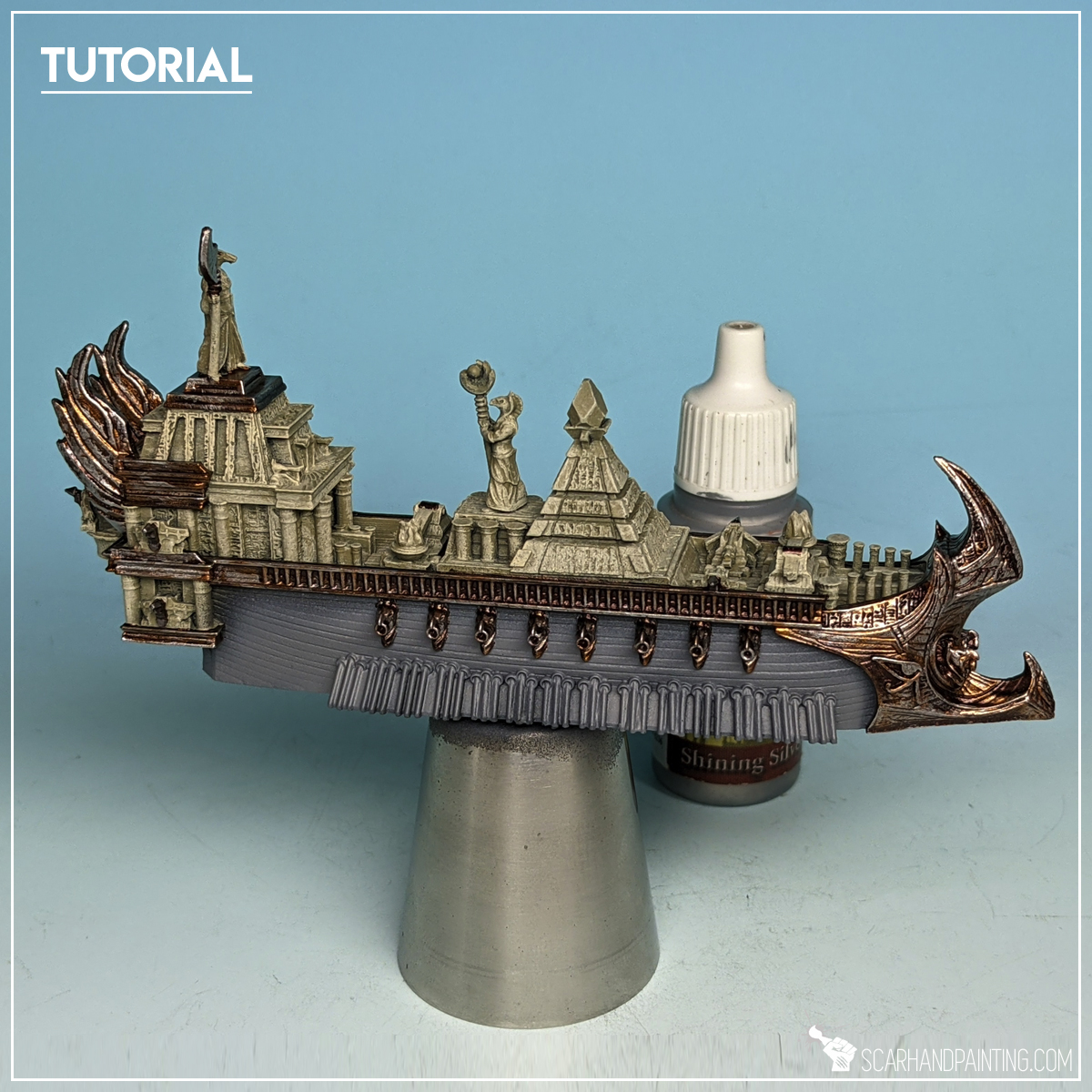
Step five: Wash
I then applied a lot of wash mix of Army Painter Strong Tone Ink 1:1 Army Painter Soft Tone Ink.
(If you followed my other tutorials you know at this point that the mixture is one of my very best friends in all painting.)

Step six: Main highlights
Once wash was dry I drybrushed broadsides with Vallejo Medium Sea Grey and then with Vallejo Ghost Grey. (I forgot to take pics). I then flatbrushed deck and top structure elements with GW Flayed One Flesh and edge highlighted with Vallejo Off White.

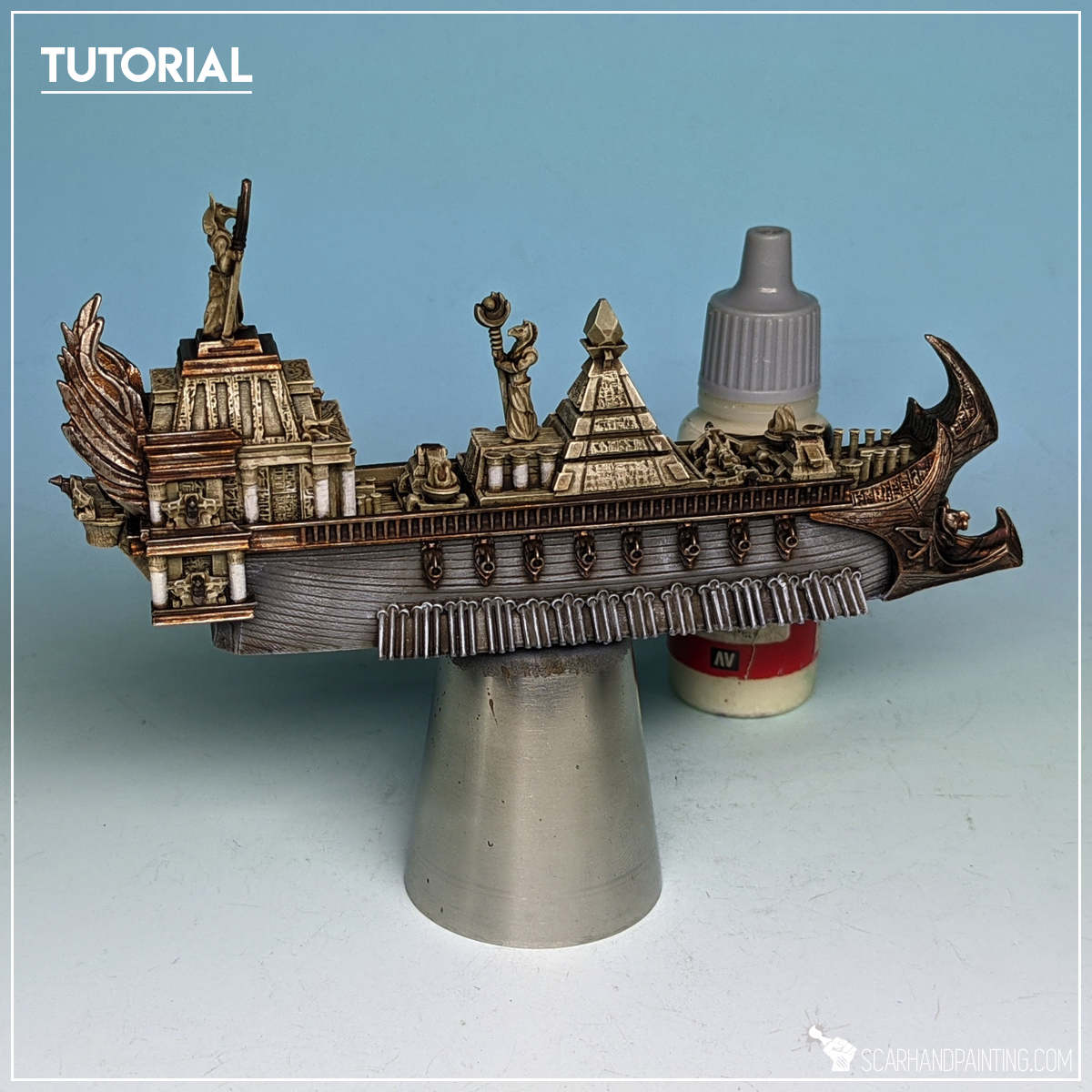
Step seven: Blue
I added accents of blue by manually painting chosen elements with Vallejo Magic Blue (air). I then highlighted with Vallejo Electric Blue, followed with Vallejo Glacier Blue. Furthermore I applied a wash layer of GW Guilliman Blue (glaze). Finally I added points of focus and thin highlights with Vallejo Glacier Blue.

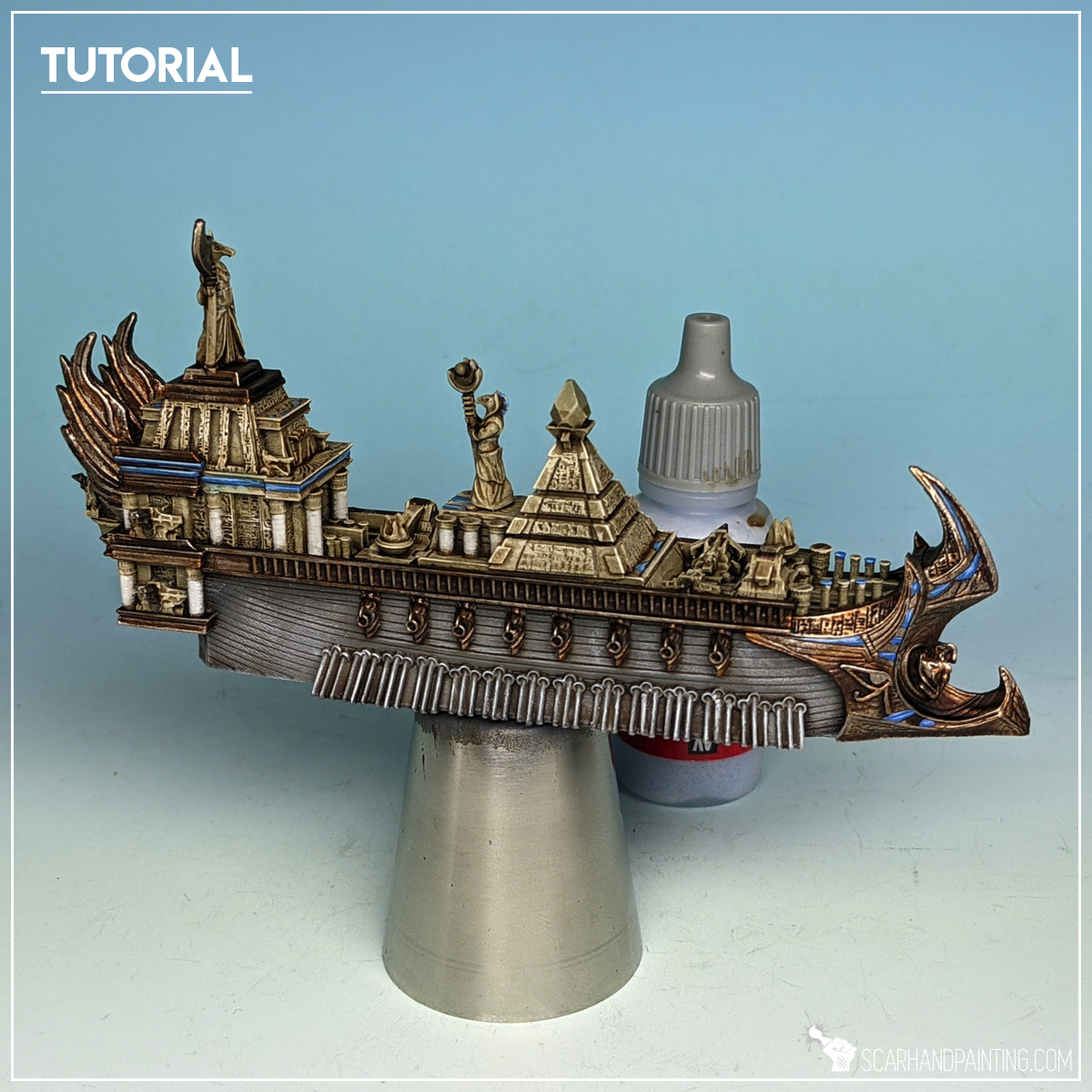
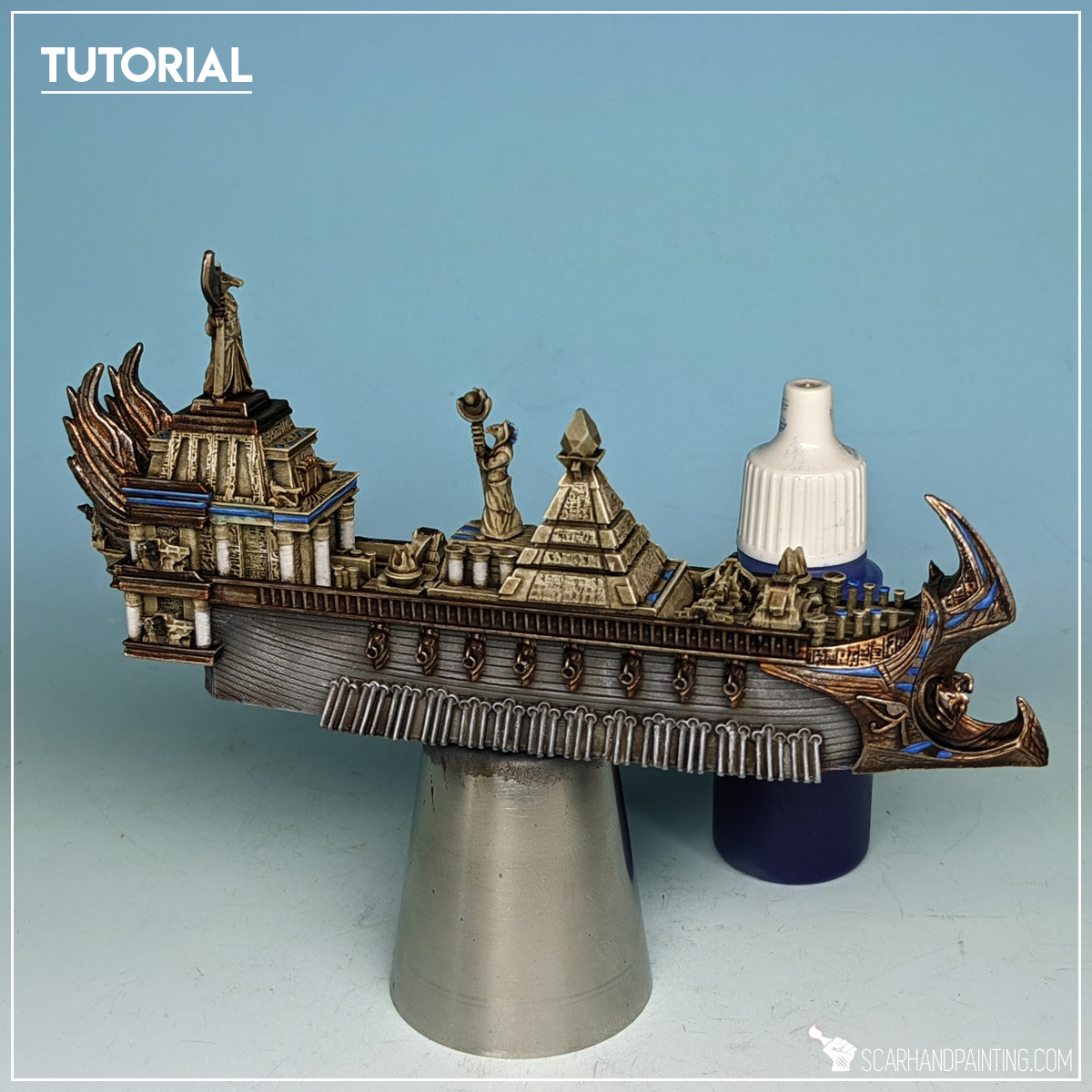

Step Eight: Purple/Pink
I applied Vallejo Warlock Purple onto chosen areas, including top gem, piramid inner lines and catapult flames. I then applied couple successive highlights with different mixes of Vallejo Warlock Purple and Vallejo Off White. With few highlights made with pure Vallejo Off White I moved to glaze Army Painter Purple Tone Ink into few areas of choice. This was contained mostly to top gem and recesses in catapult flames (and around).
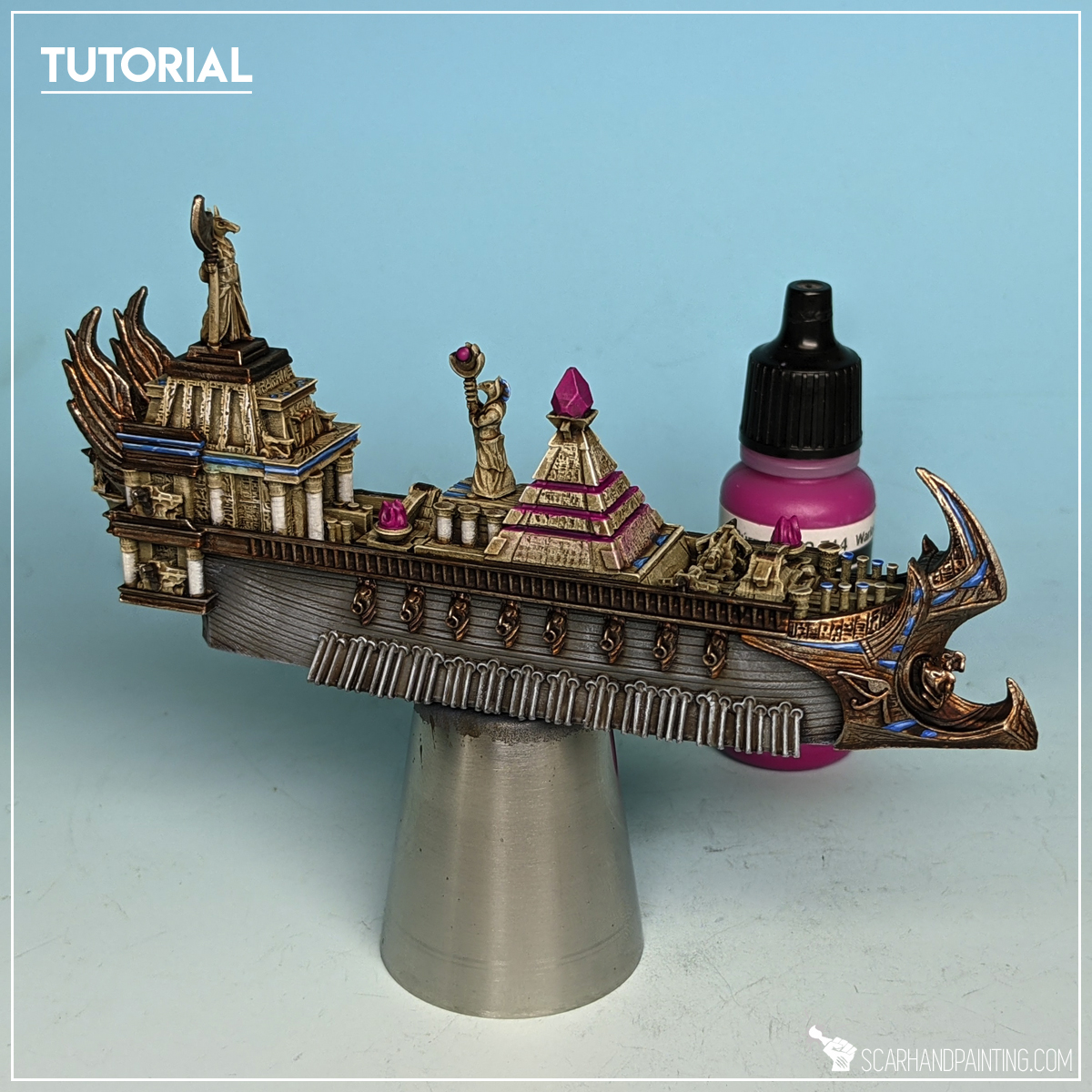
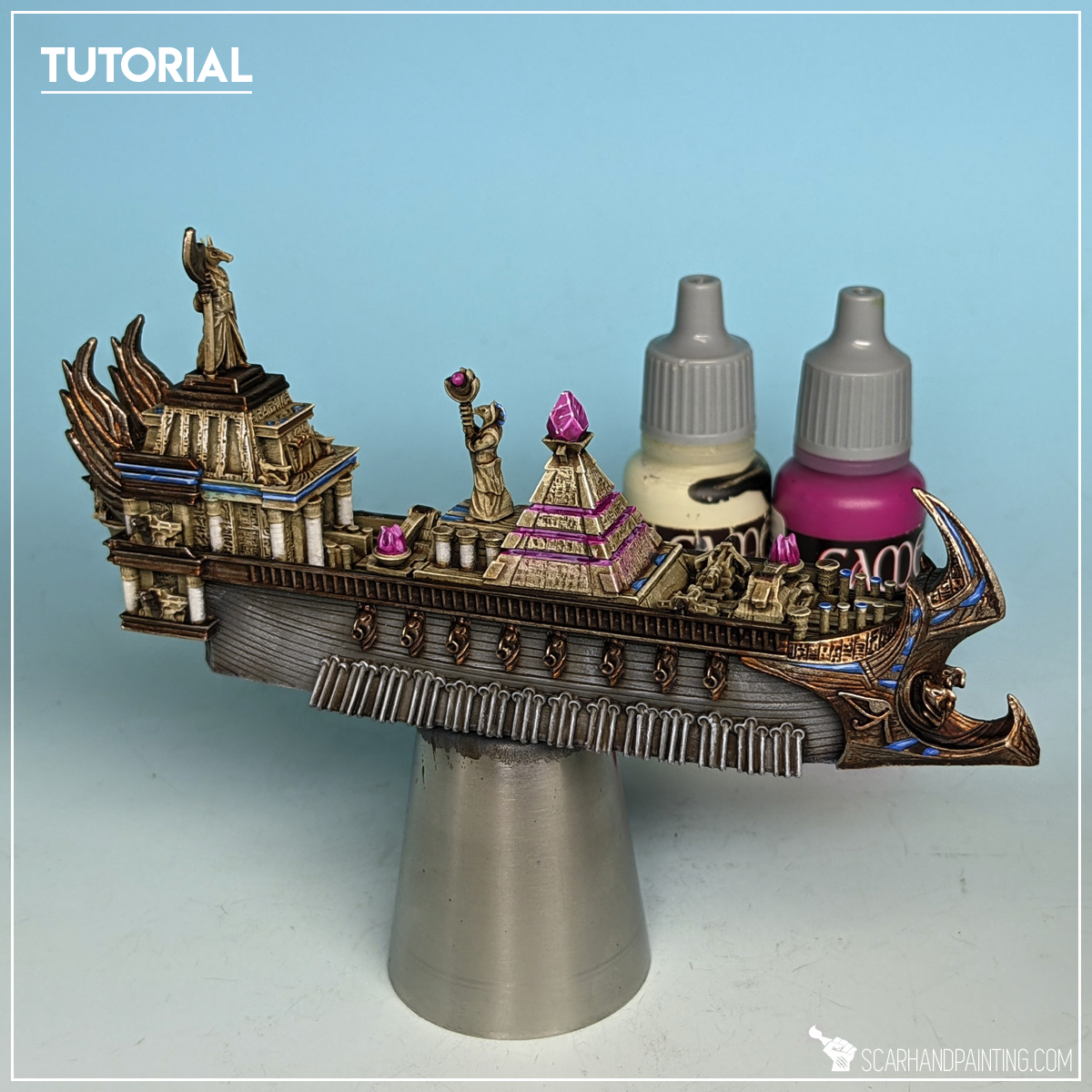
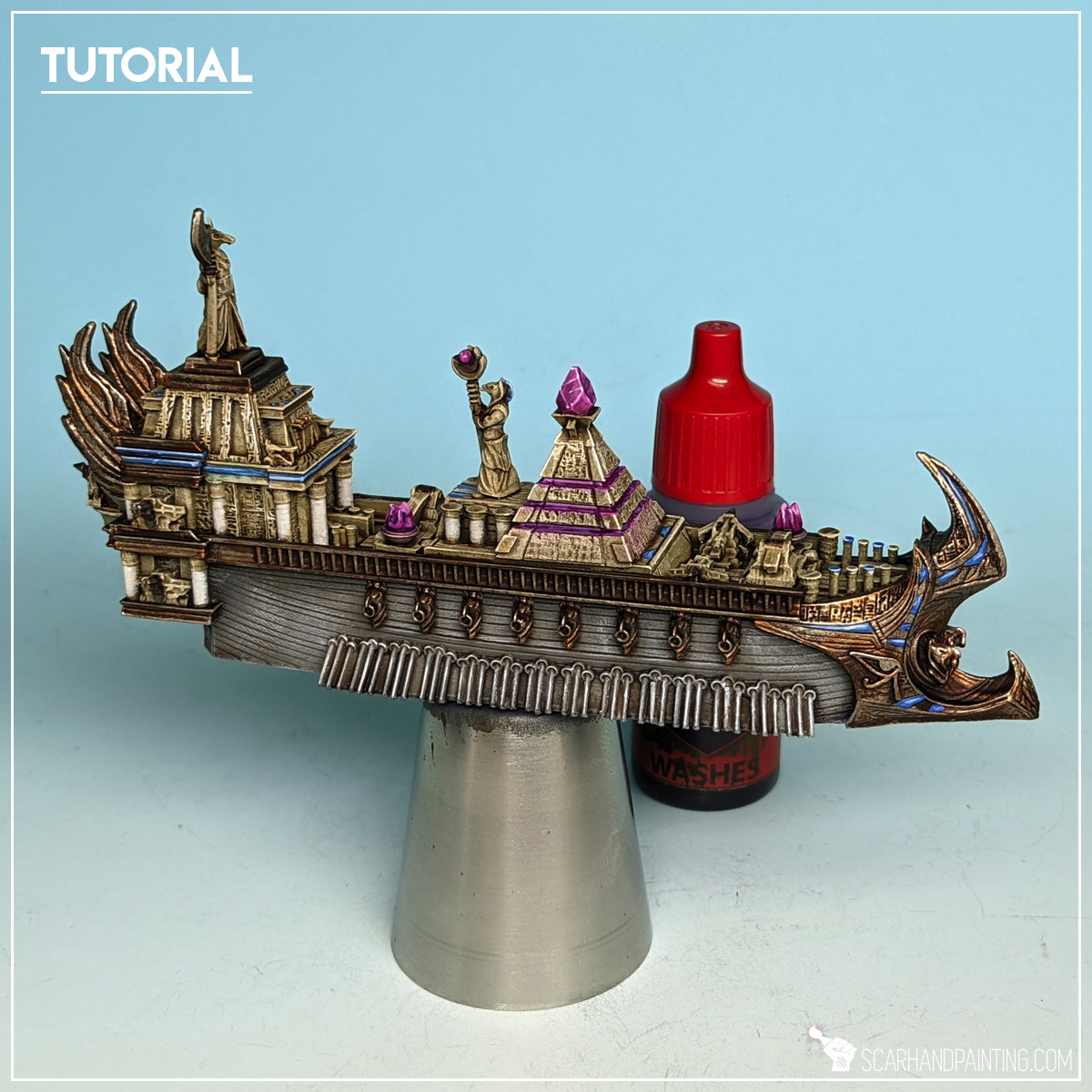
Such prepared miniature I airbrushed with two coats of Vallejo Polyurethane Matt Varnish and mounted on a base, following Tutorial: KoW Armada Water Bases.
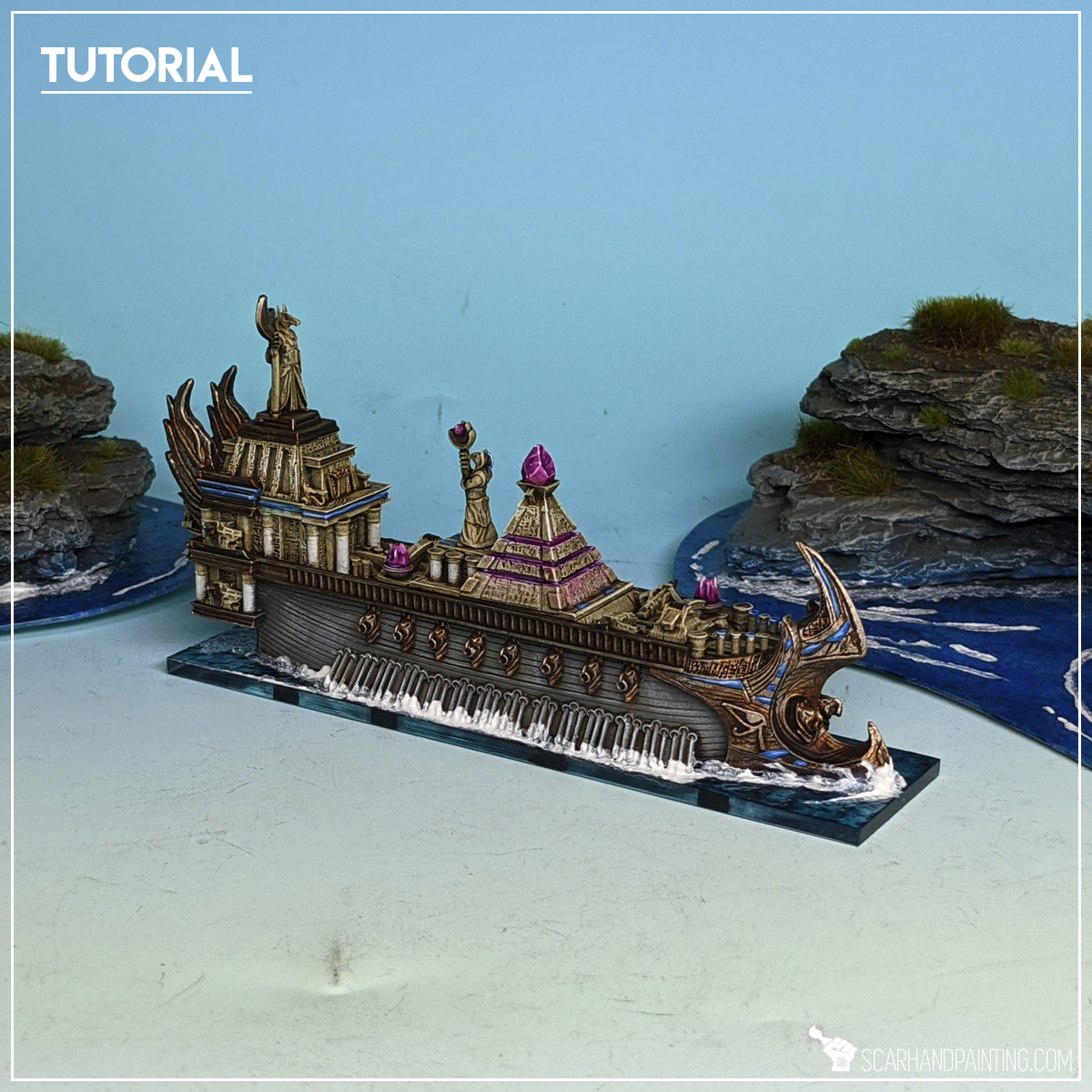
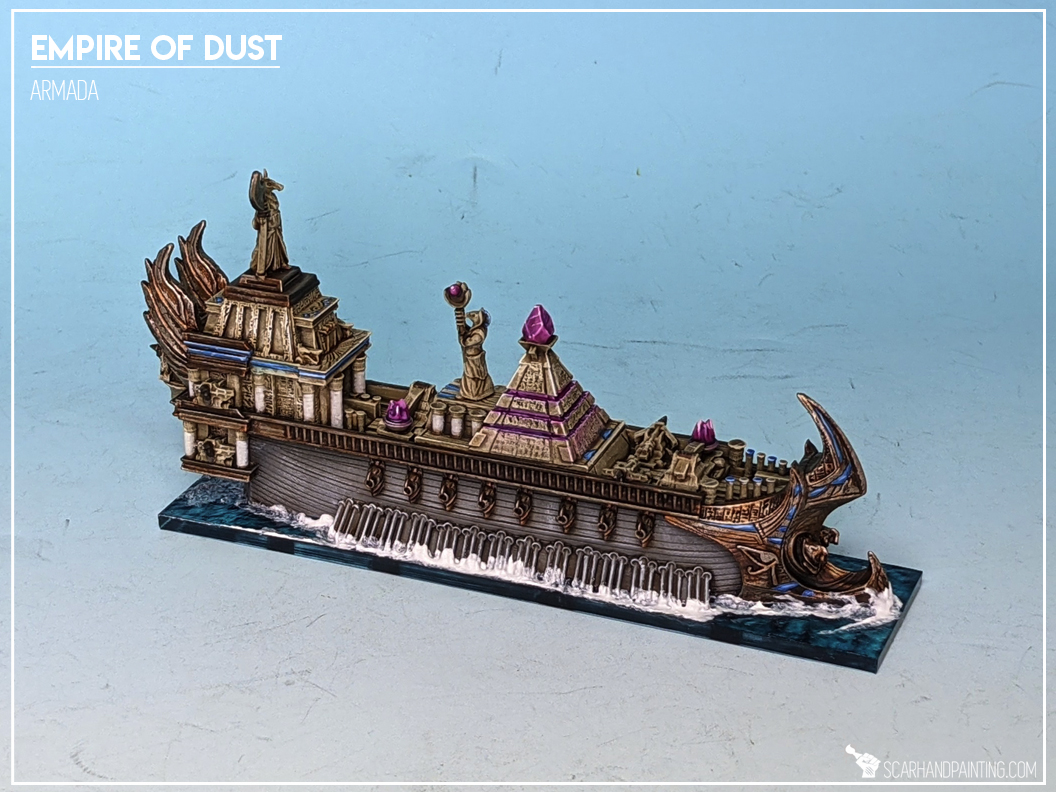

I hope you find this tutorial interesting. Be sure to let me know your thoughts in the comments below or via Facebook or Instagram. I would also appreciate if you considered sharing this content with your friends, who might find it useful. Finally if you are looking for a professional miniatures painting service be sure to contact me with this contact form. I always reply within 24 hours, after which please check out your spam folder.

Welcome to Painting Road to Survival Stalkers tutorial. Here I will present to you a Step-by-step of an easy and fast painting process for Orzol Studio’s Stalkers team from the Post-apo Survivors Kickstarter.
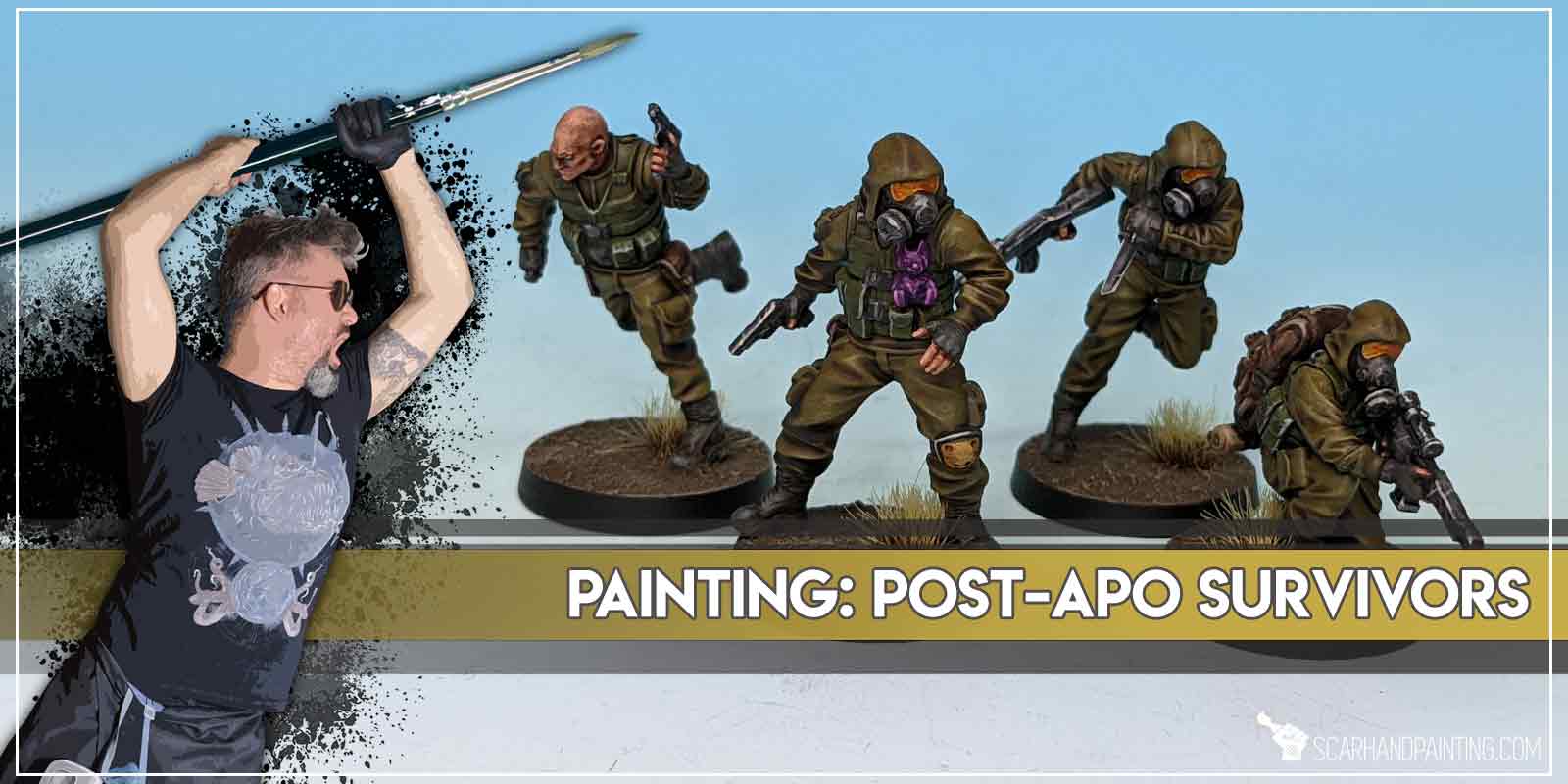
Before we start, some notes:

Step one: Undercoat
I applied a strong layer of Citadel Chaos Black spray. I prefer spray over manual application, but this is just a personal preference. Any matt black undercoat will do, as long as it’s thorough.
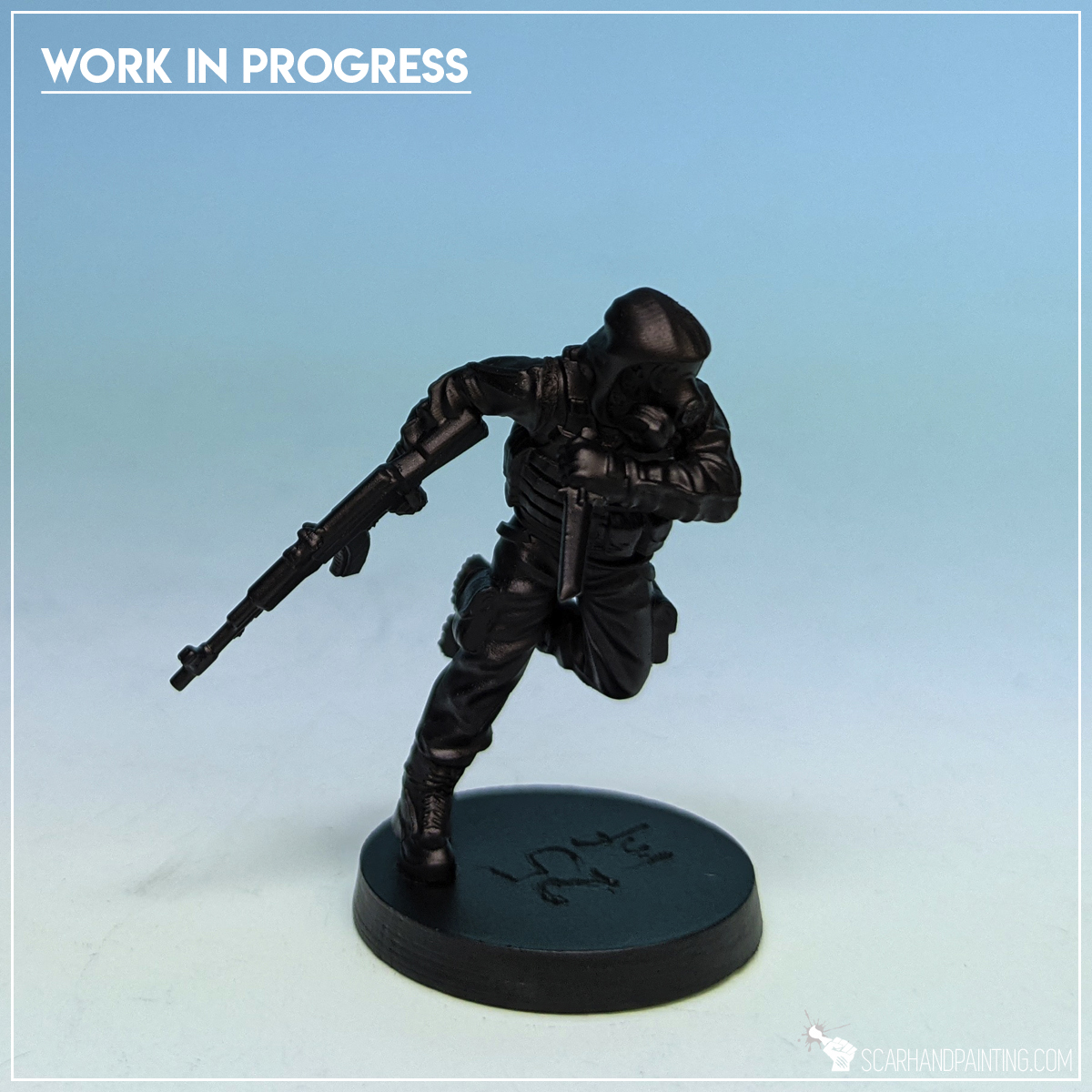
Step two: Uniform
I started by applying a strong layer of Vallejo Dark Green RLM71 (air) onto entire uniform. I used an airbrush for this, but it is not necessary. This layer might as well be applied manually, but might take few runs to look smooth and solid. Although boots, weapons and other detail got painted alongside the uniform, it’s not a problem. If you switch to manual painting you don’t have to worry about messing these up at this stage of paint job.
Next I airbrushed Vallejo Interior Green (air) over previous layer. Similarly to Dark Green this one can be done manually and follows same philosophy.
I switched to manual painting and with a basecoat size brush, flatbrushed a mix of Vallejo Interior Green (air) 1:1 Vallejo Heavy Khaki over the miniature. I then used a more precise brush and highlighted some edges with the same color mix.
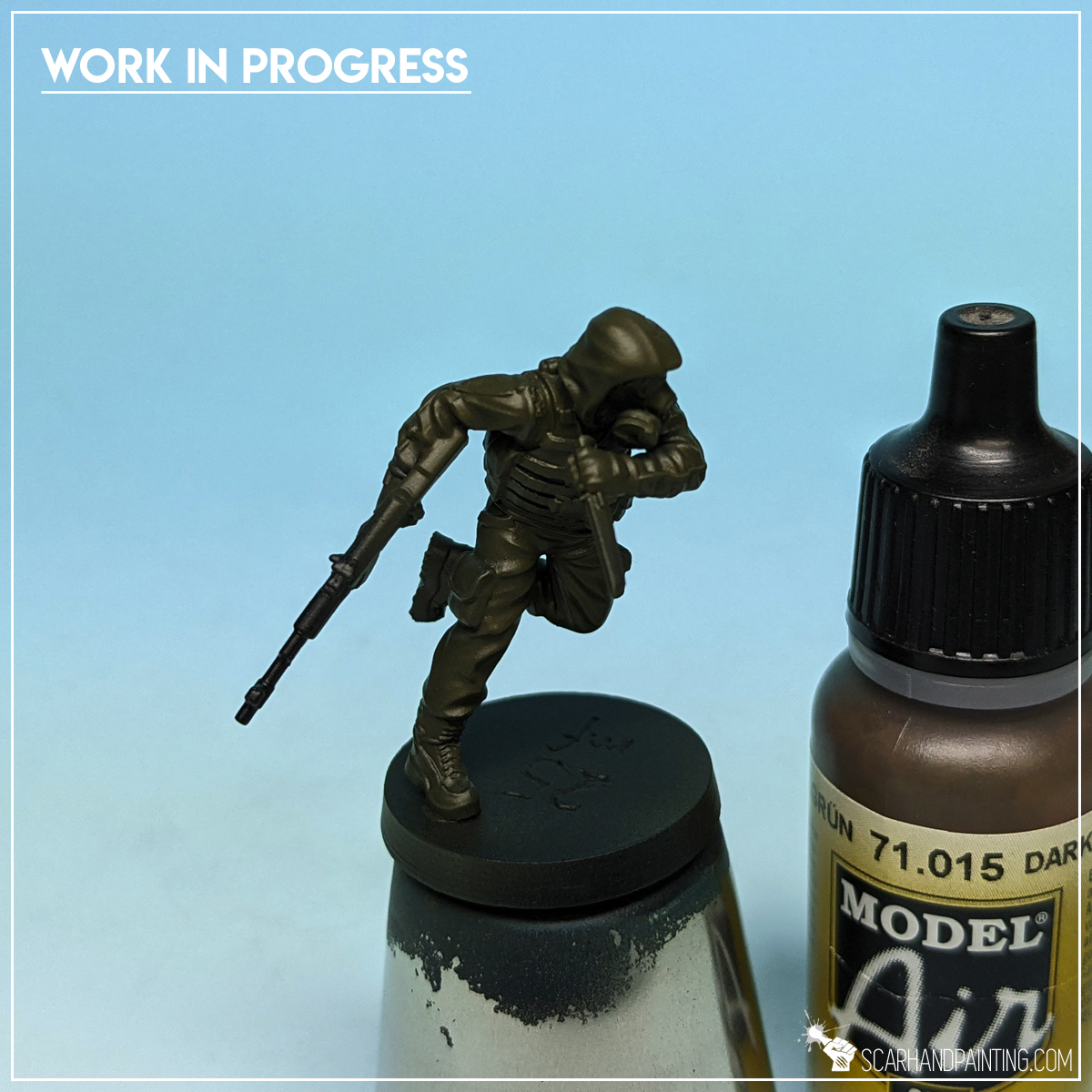
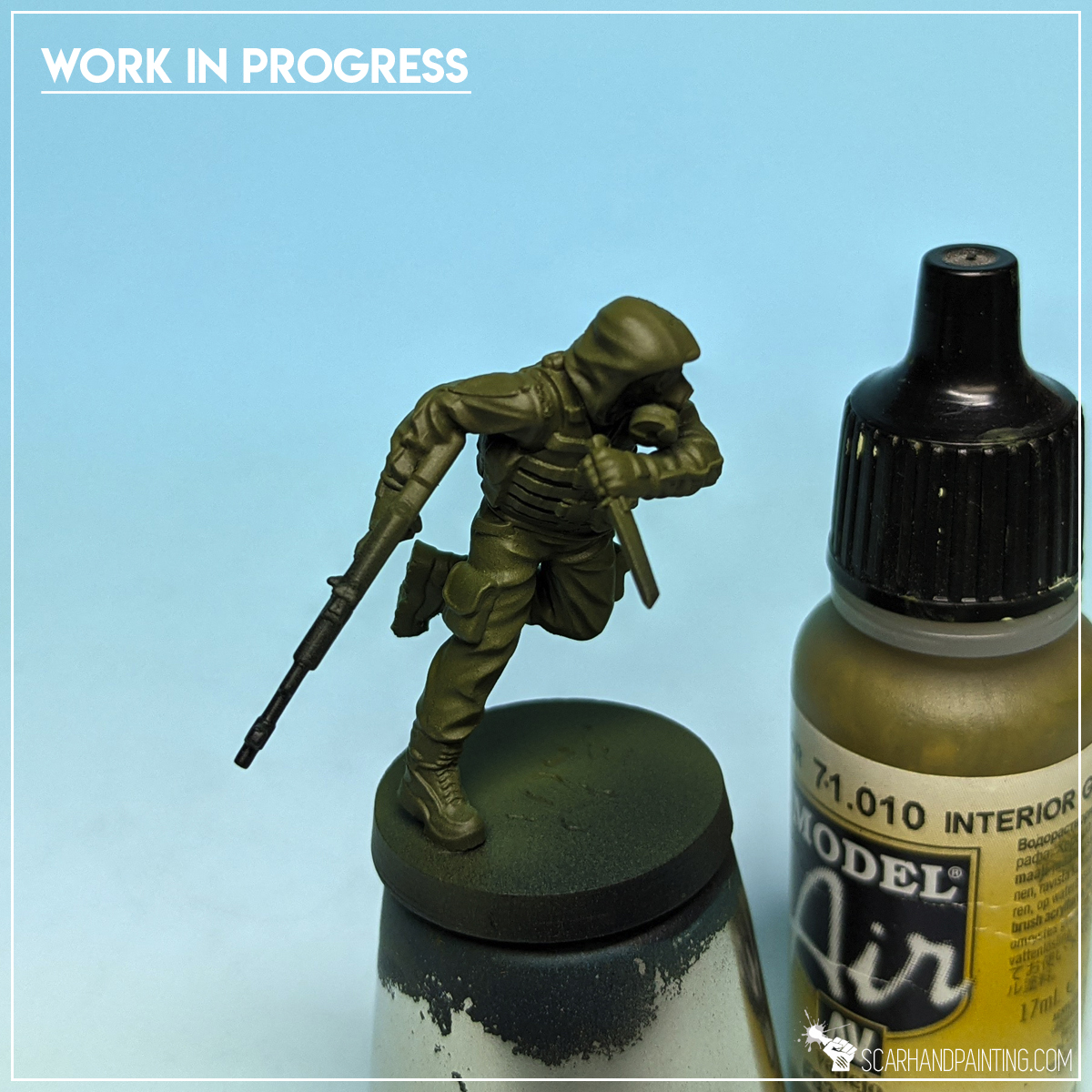
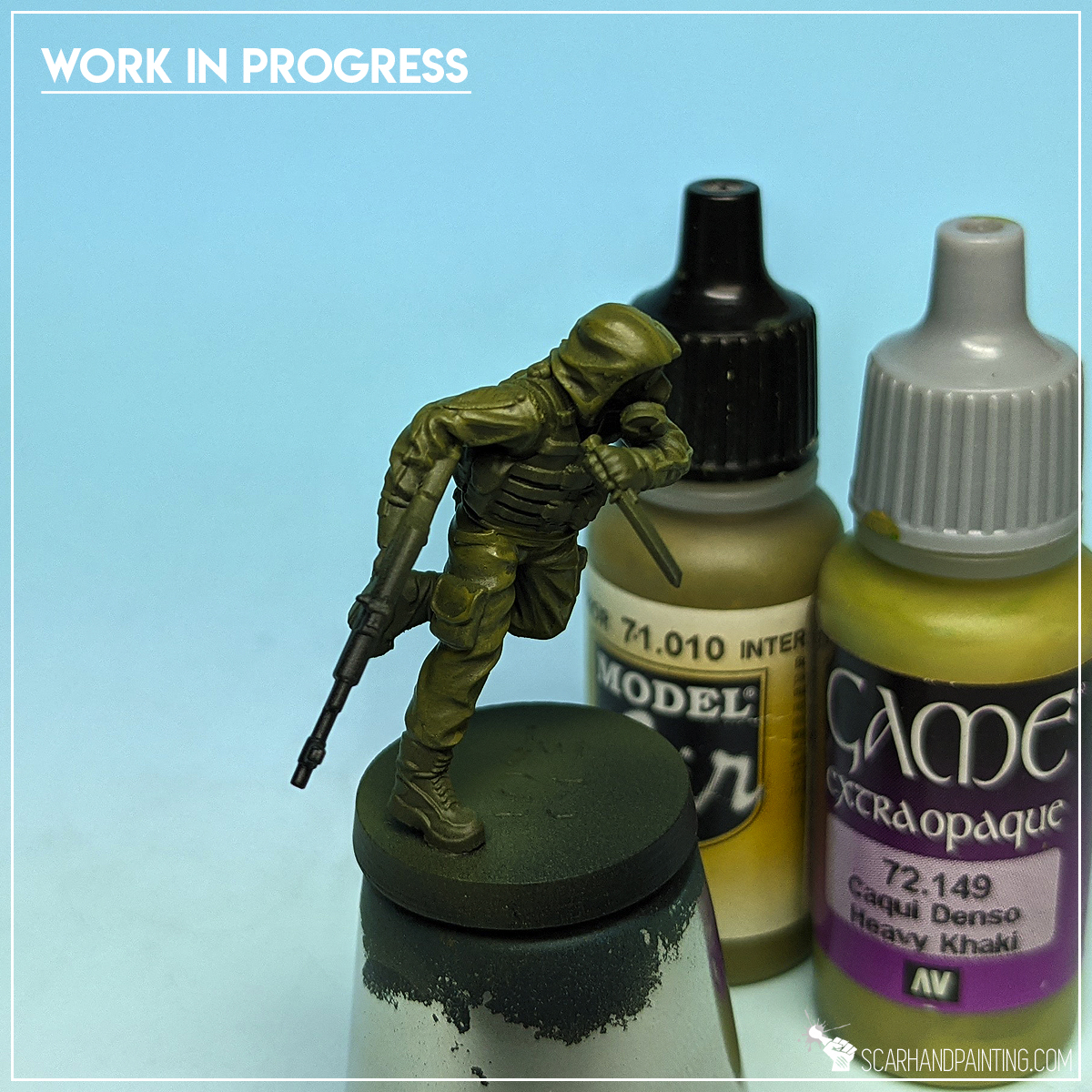
Step three: Vest
With a solid color underneath a single layer of Vallejo Russian Green (air) was enough to provide a smooth base for the vest. The key was to avoid messing up all the bright uniform around. Because of that I outlined the vest with a precise brush and only then switched for a larger brush to gain speed.
Next I flatbrushed a mix of Vallejo Russian Green 1:1 Vallejo Olive Green over previous layer. This provided nice thickness, something the upcoming Wash will work good on.
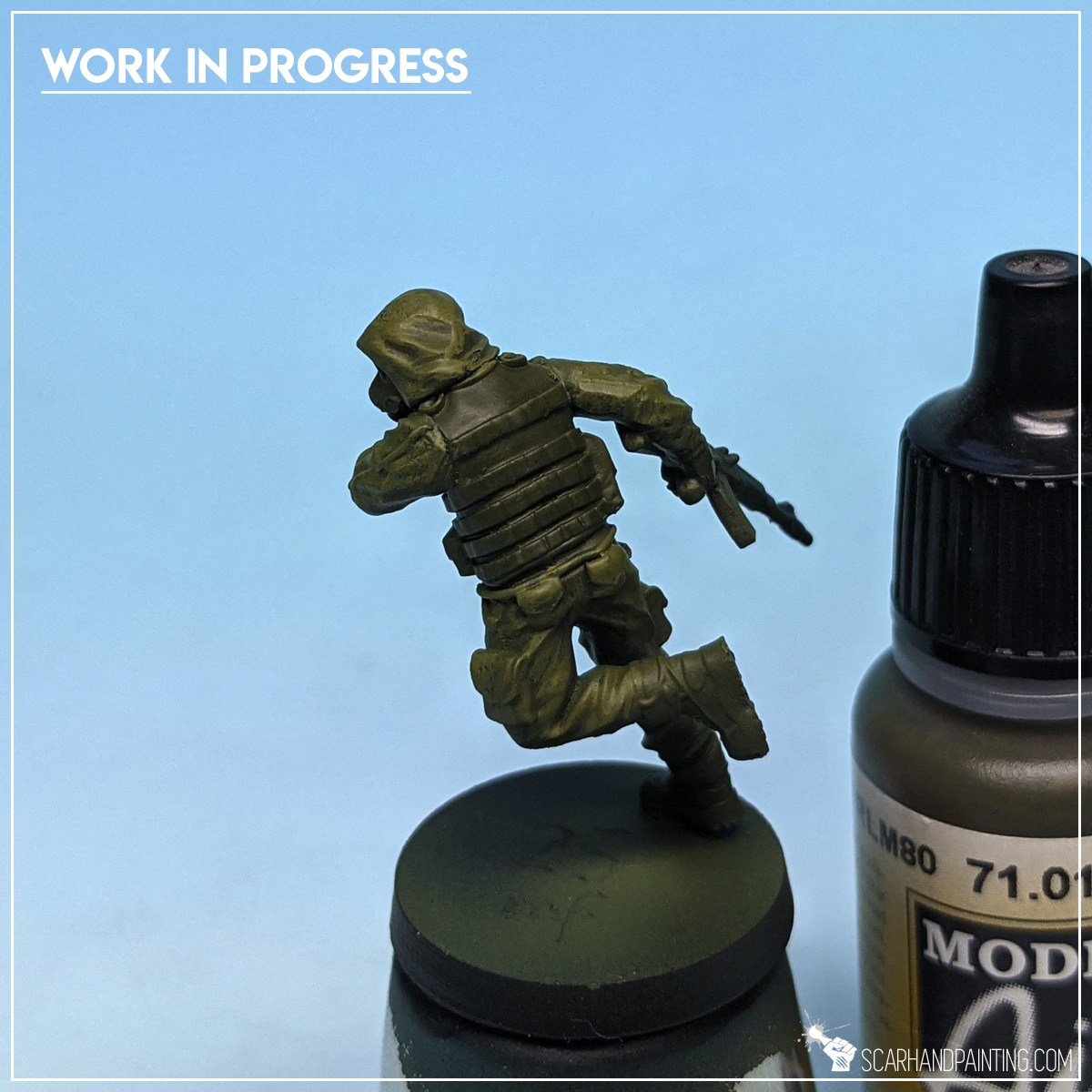
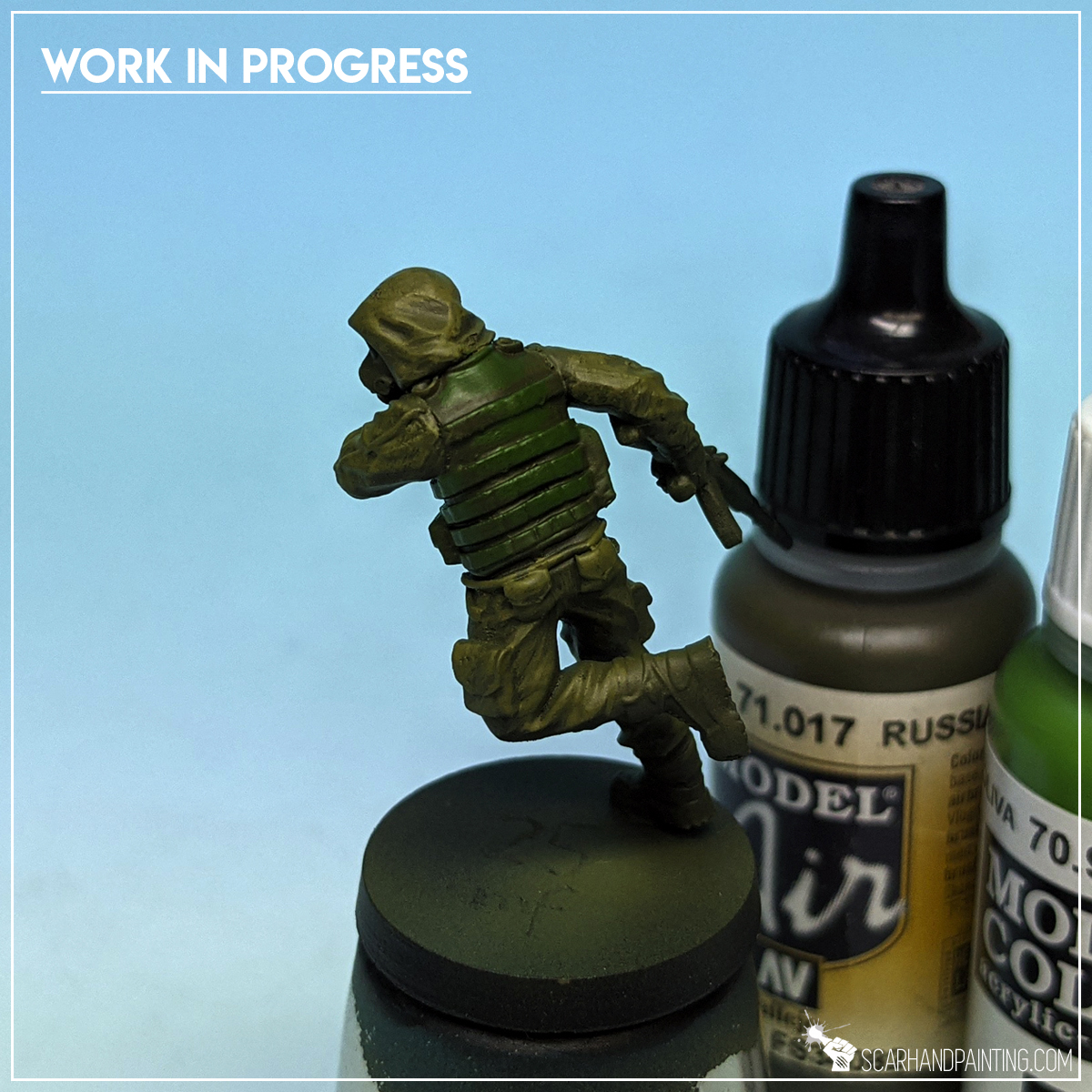
Step four: Boots, Gloves, Mask
Using a small brush I applied a strong, precise layer of Vallejo Panzer Dark Grey (air) onto boots, mask, gloves, weapons and buckles.
I then switched to Vallejo Medium Sea Grey, thinned it down with medium and applied a somehow misty, irregular layer over Panzer Dark Grey, leaving spots of previous color visible. I deliberately left weapons and buckles be for the time being.
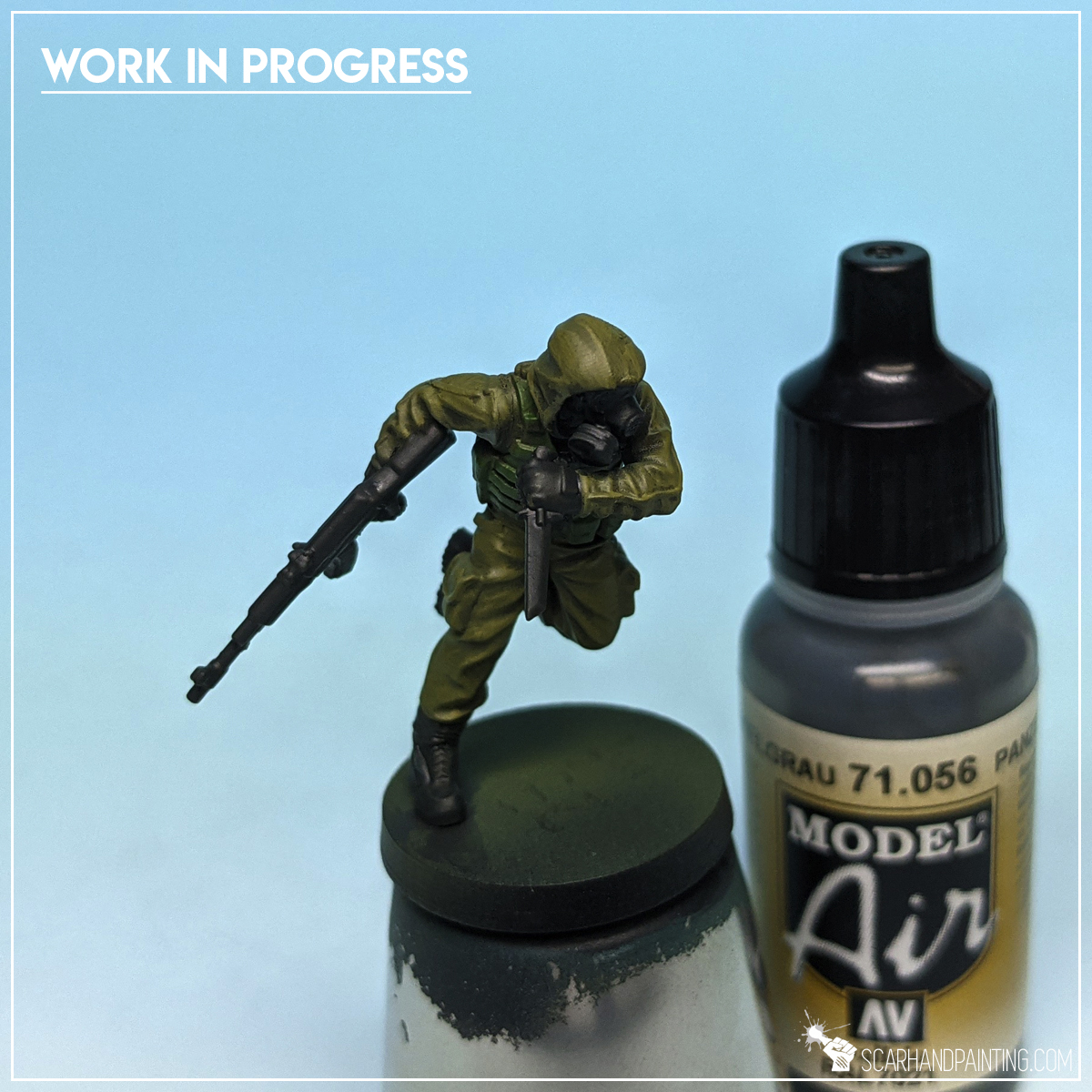

Step five: Brown wash
Using a large, soft brush I applied a lot of Games Workshop Agrax Earthshade onto entire miniature. After a while I used a clean precise brush to strip some of the paint from areas where too much pigmentation covered all the detail. I left the miniature to dry after that.
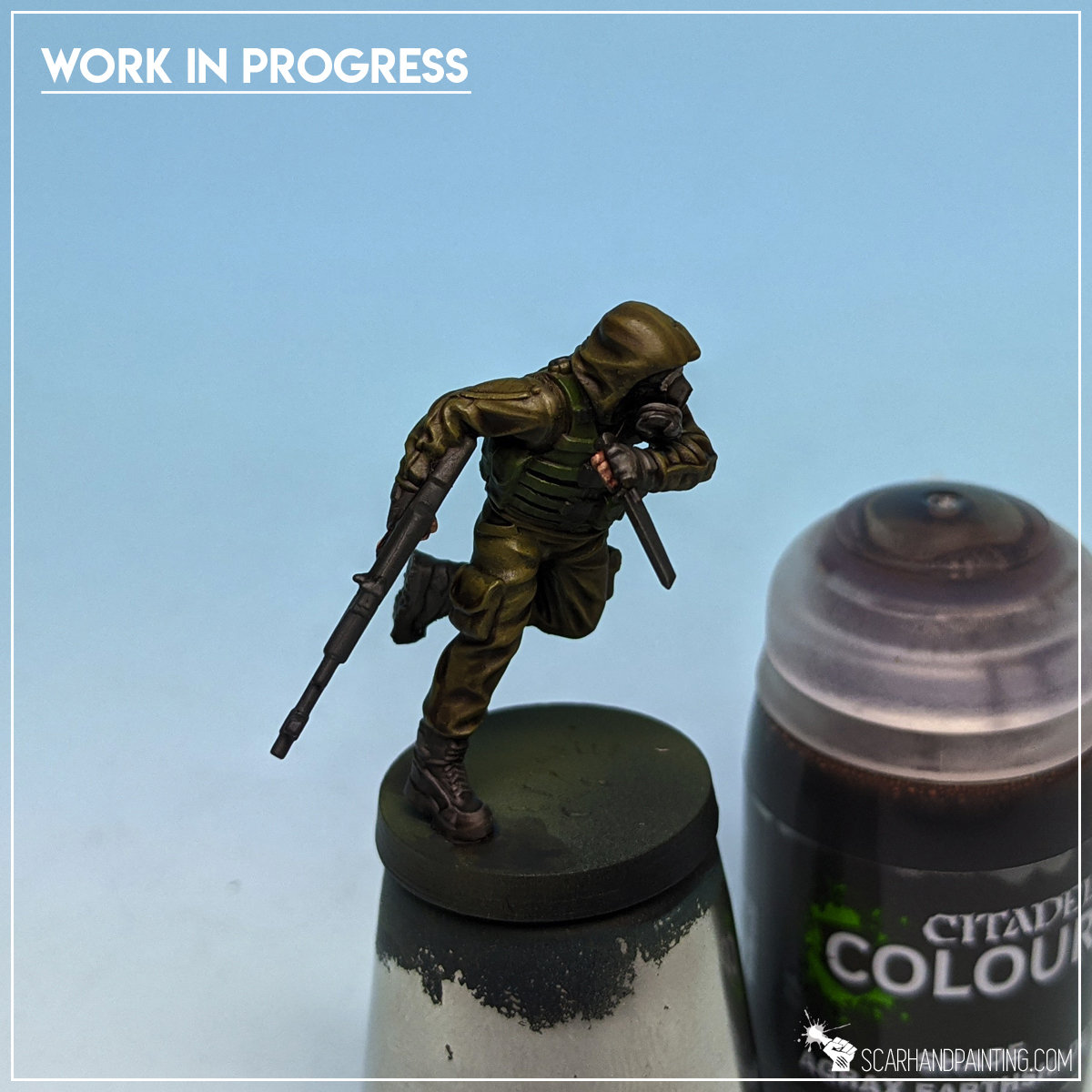
Step six: Weapons
I applied a partially translucent layer of thinned down Vallejo Wolf Grey (air) onto weapons and buckles. I moved a brush alongside blade and barrel, trying to leave pigmentation on the edges.
I then highlighted weapons with Games Workshop Pallid Wych Flesh. Mostly on the edges and with no dillution.
I then followed up by applying Army Painter Dark Tone Ink. Similar to Agrax, I let the paint flow then removed the excess and let the thing dry.
Finally I edge highlighted with Games Workshop Pallid Wych Flesh. This time around I included gas mask filter plus added few scratches here and there.

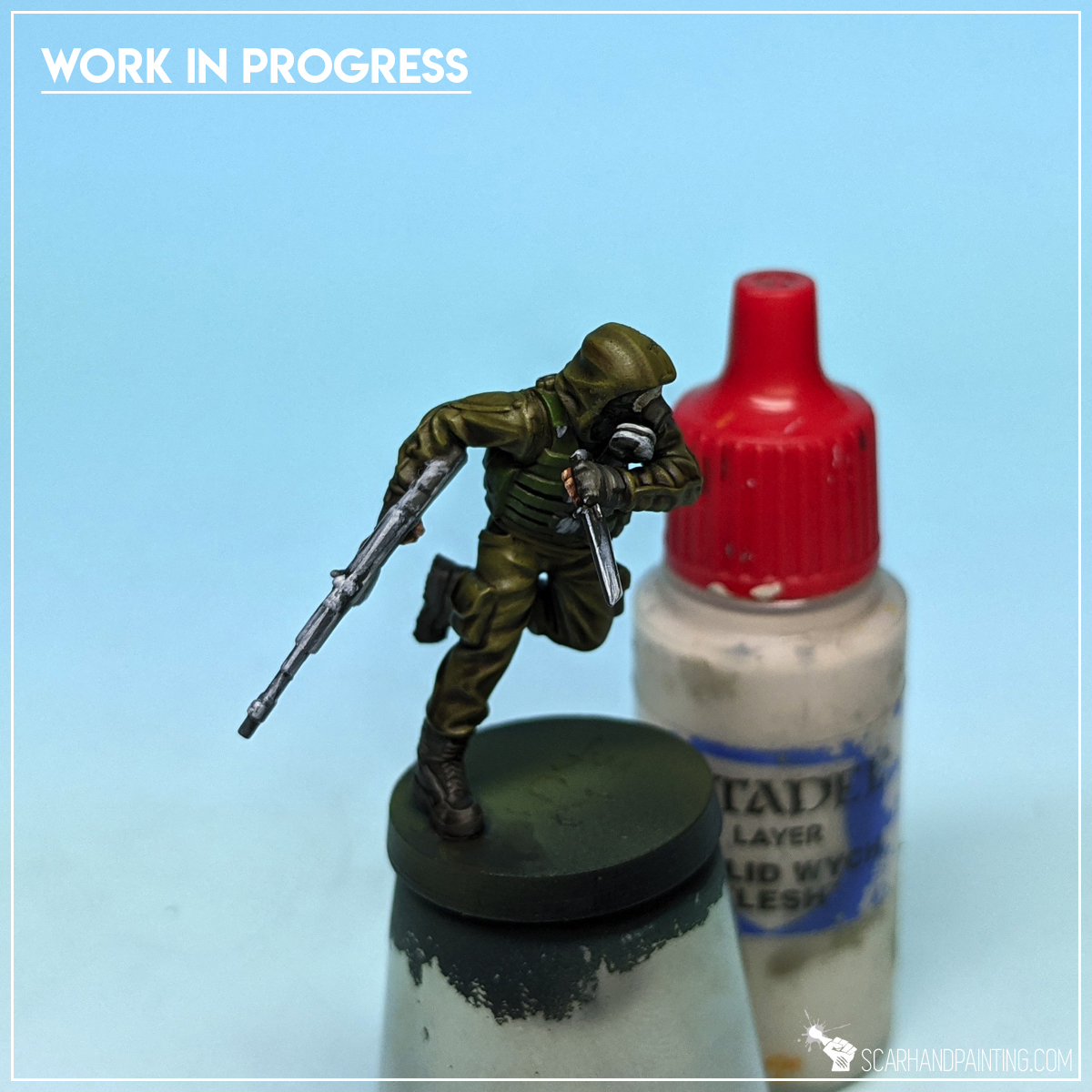
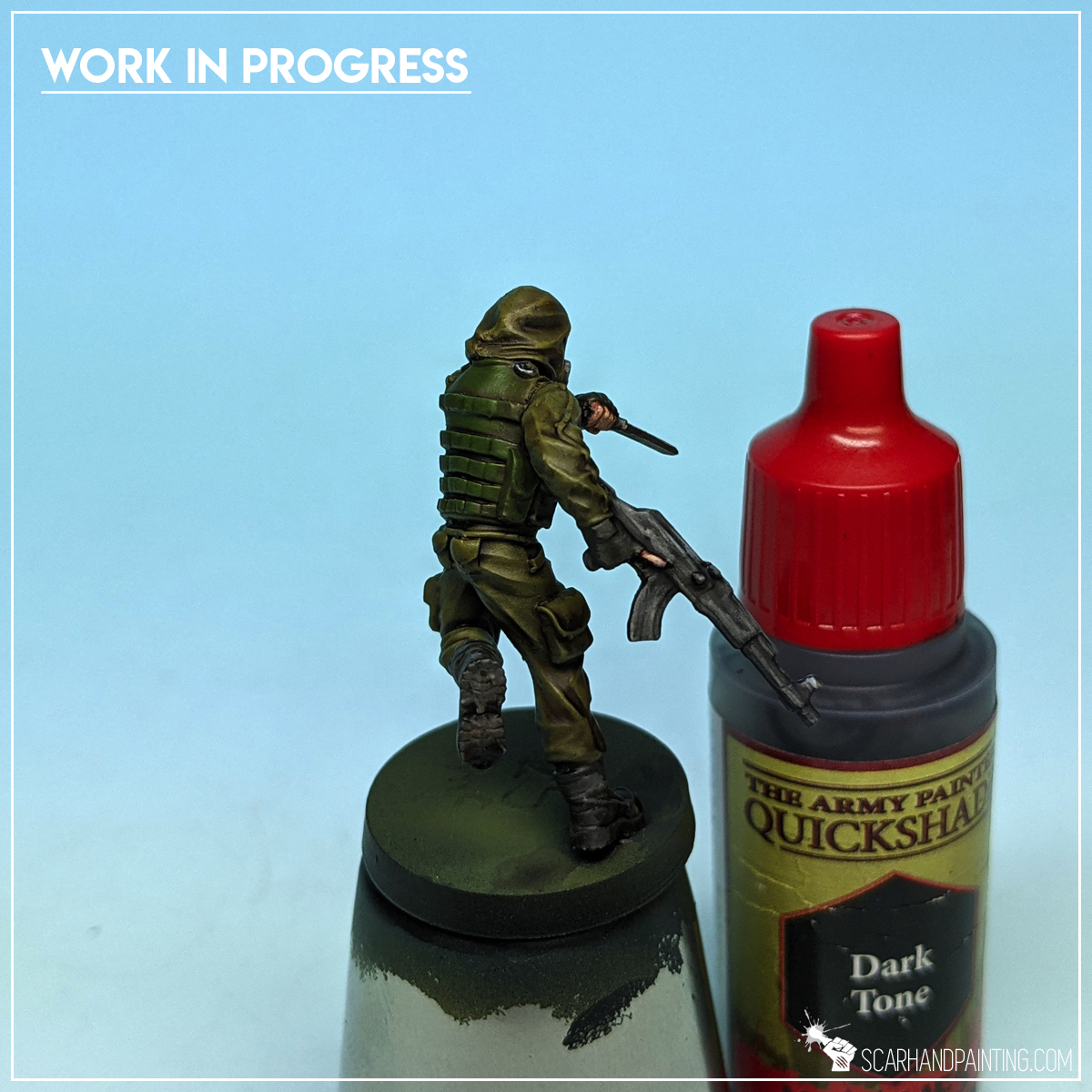
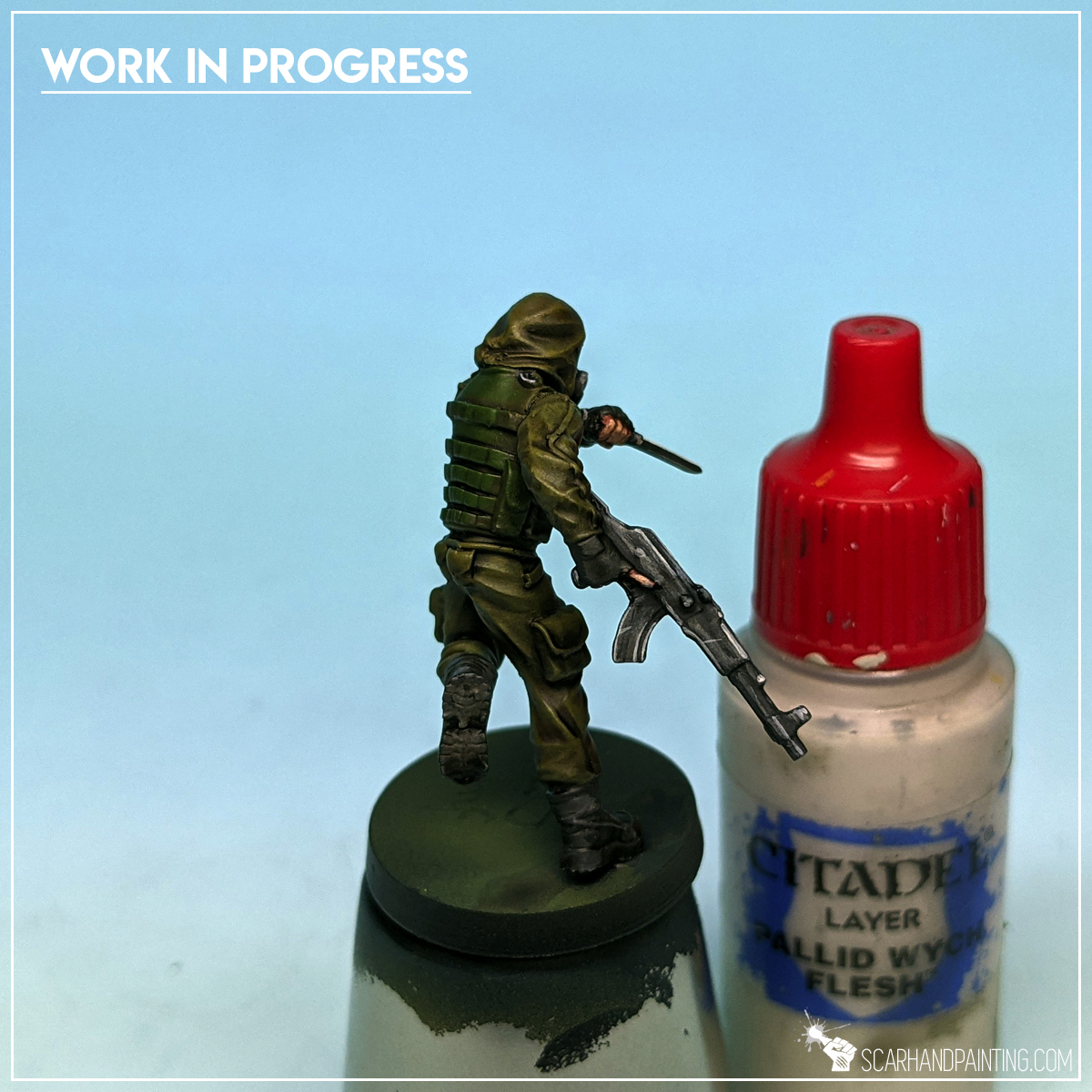
Step seven: Skin & Eyes
I started painting skin by applying a solid layer of slightly thinned down Vallejo Tan. This layer had to be precise and I avoided going out of line and messing up paintjob around it. I deliberately started painting skin before applying Agrax Earthshade Wash from previous tutorial so that any corrections could be done much easier, if required.
I then applied Games Workshop Dwarf Flesh onto previous layer. Same premise, except I left just a bit of Tan visible in the recesses.
Next I highlighted skin with Vallejo Flesh (air), which due to it’s consistency produces a partially translucent effect. I then re-applied Flesh on top of the head, cheeks and nose.
I followed up with Agrax Earthshade wash (done at Step five: Brown wash).
Finally I highlighted with Games Workshop Dwarf Flesh. I also blended some of the Dwarf Flesh over wash made stains on top of the head.
Painting eyes is a topic on it’s own and I’m not trying to write a book here, so I used a simple method of a single white line followed by a black dot in the middle. Any necessary corrections can be done to your heart’s content by painting over and over till good results are produced.
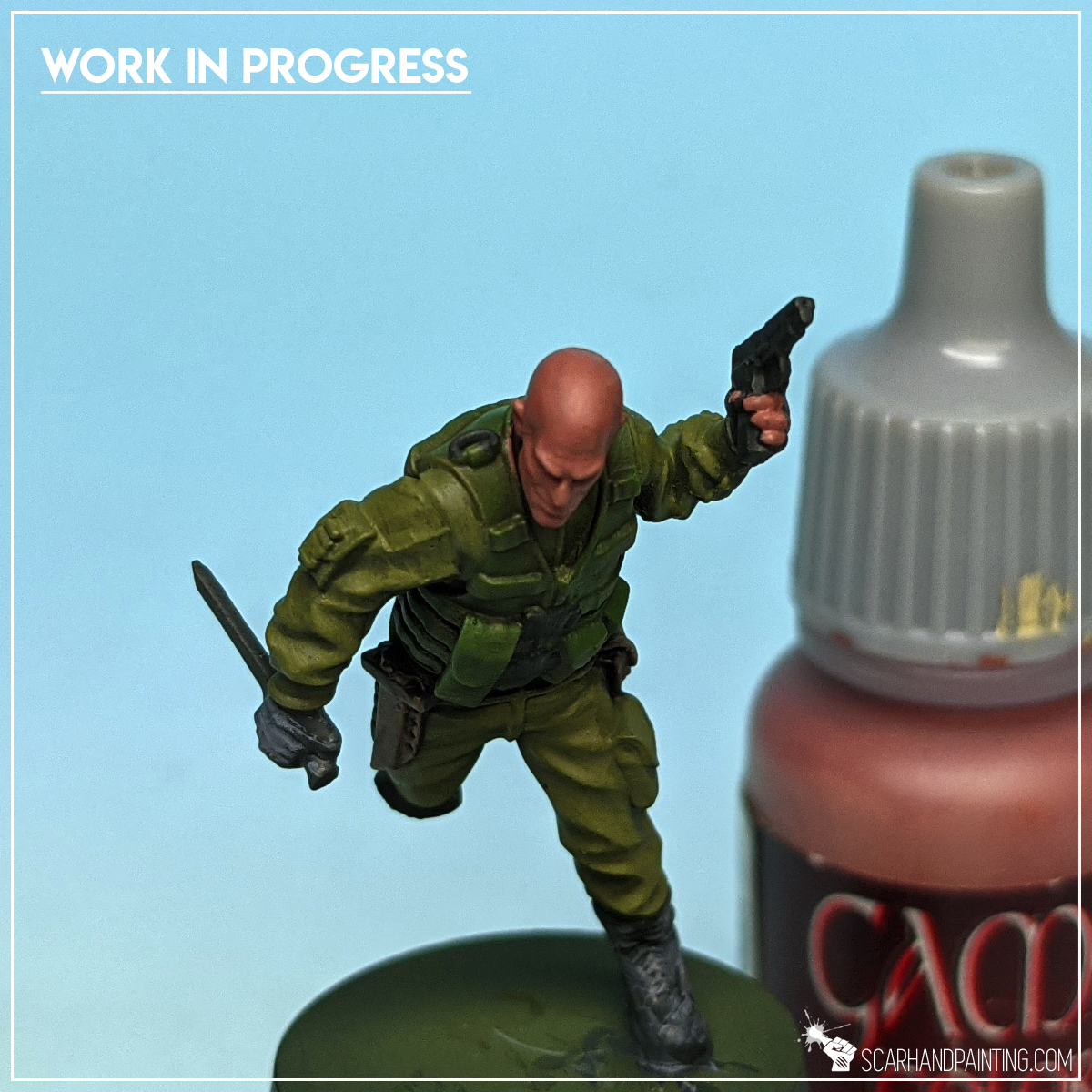
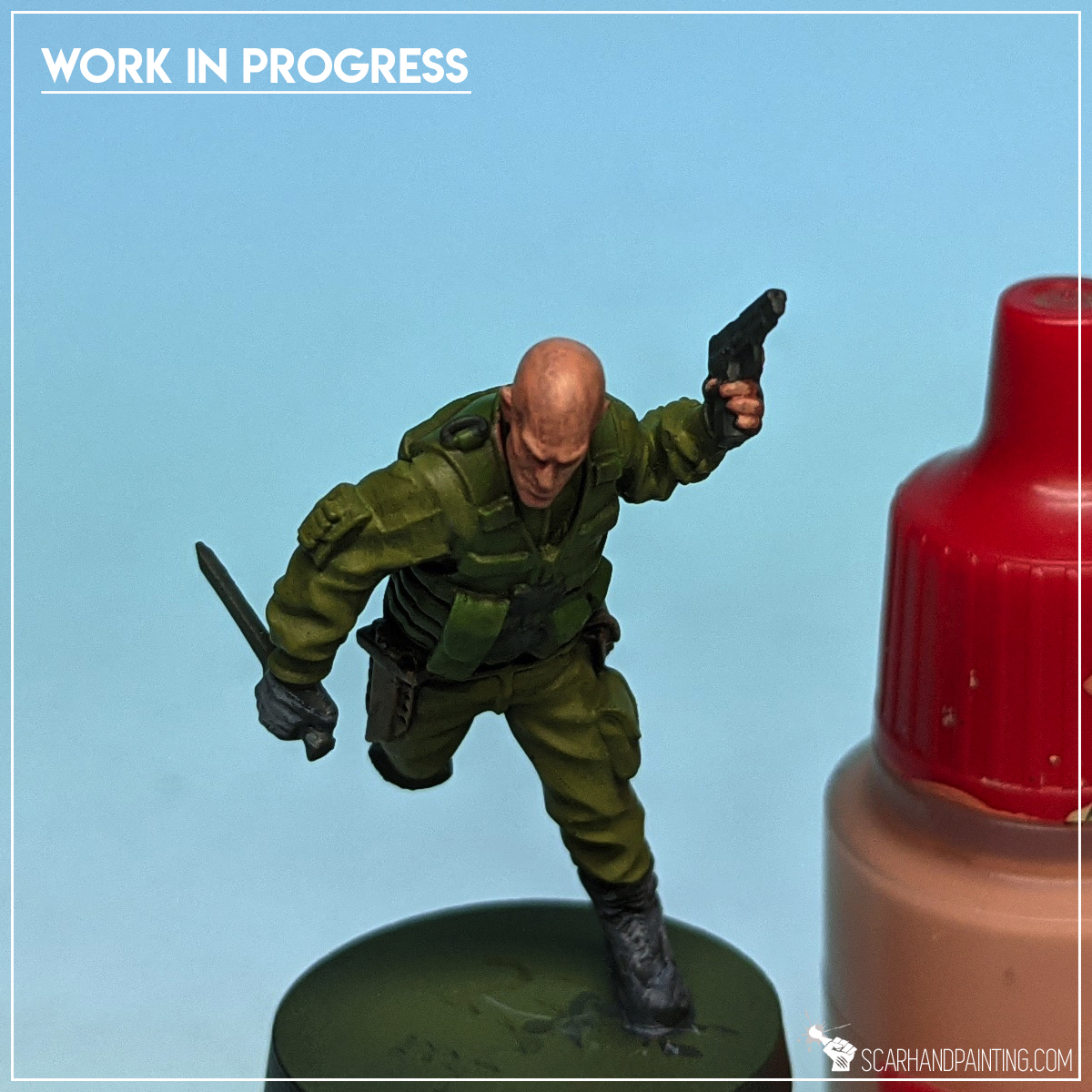
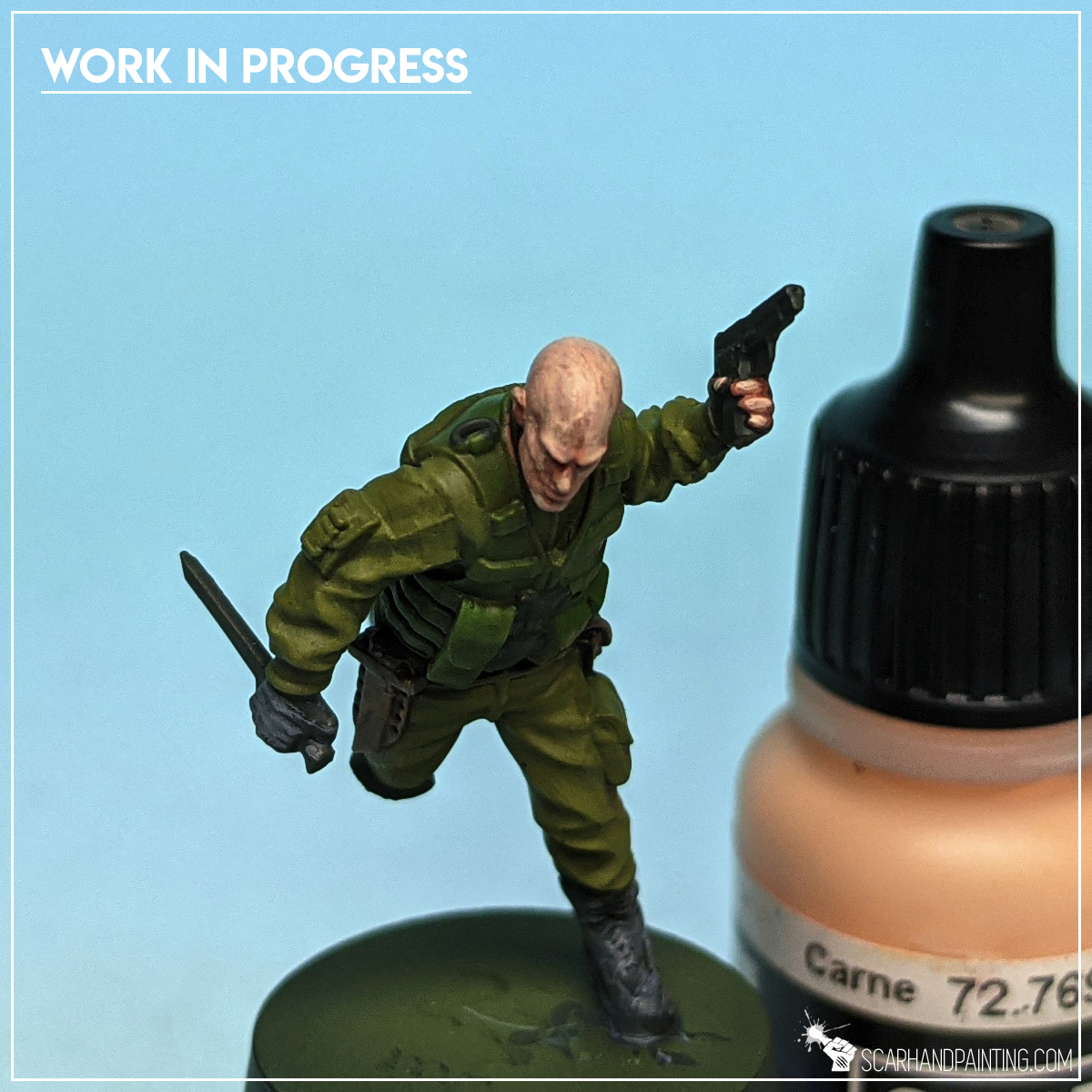
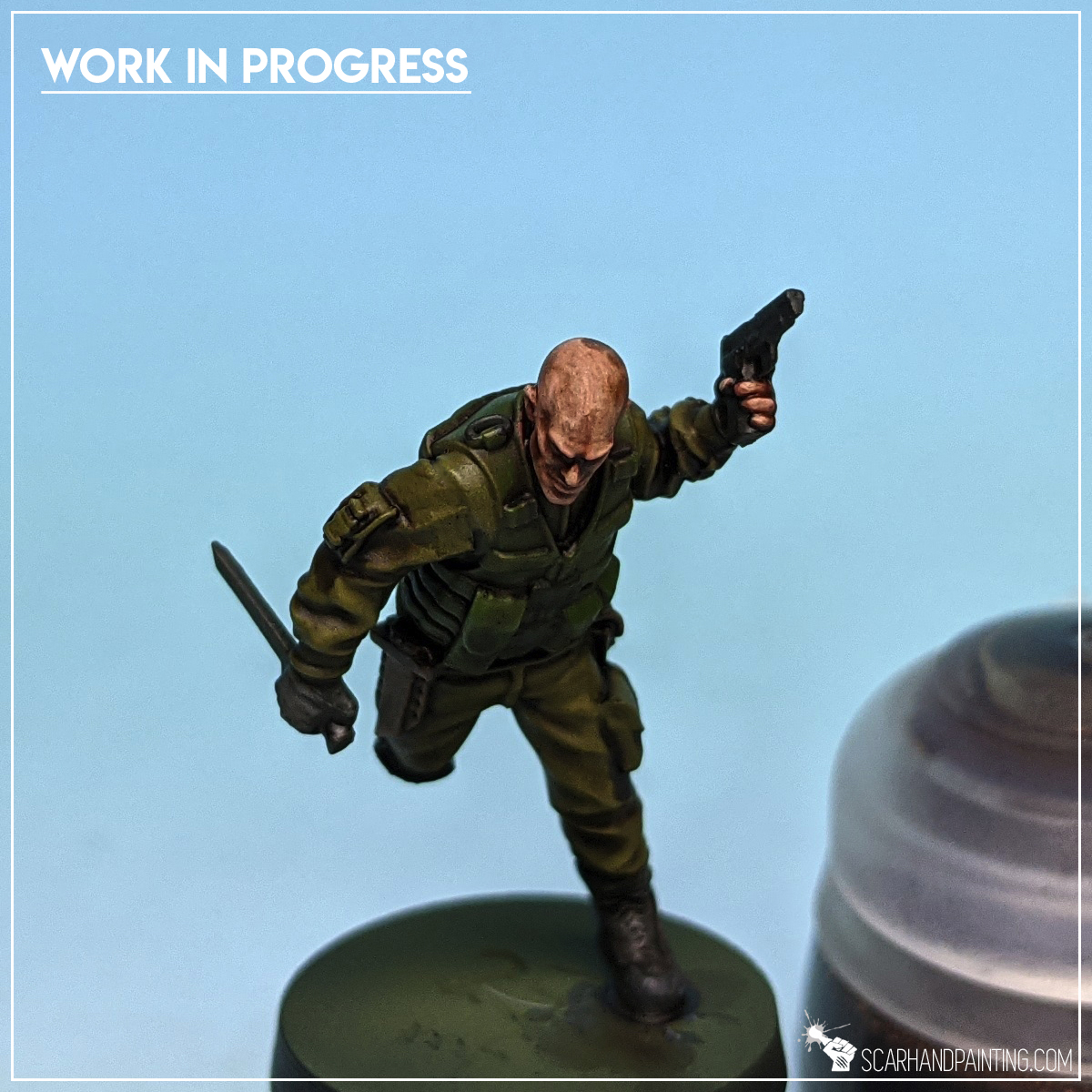
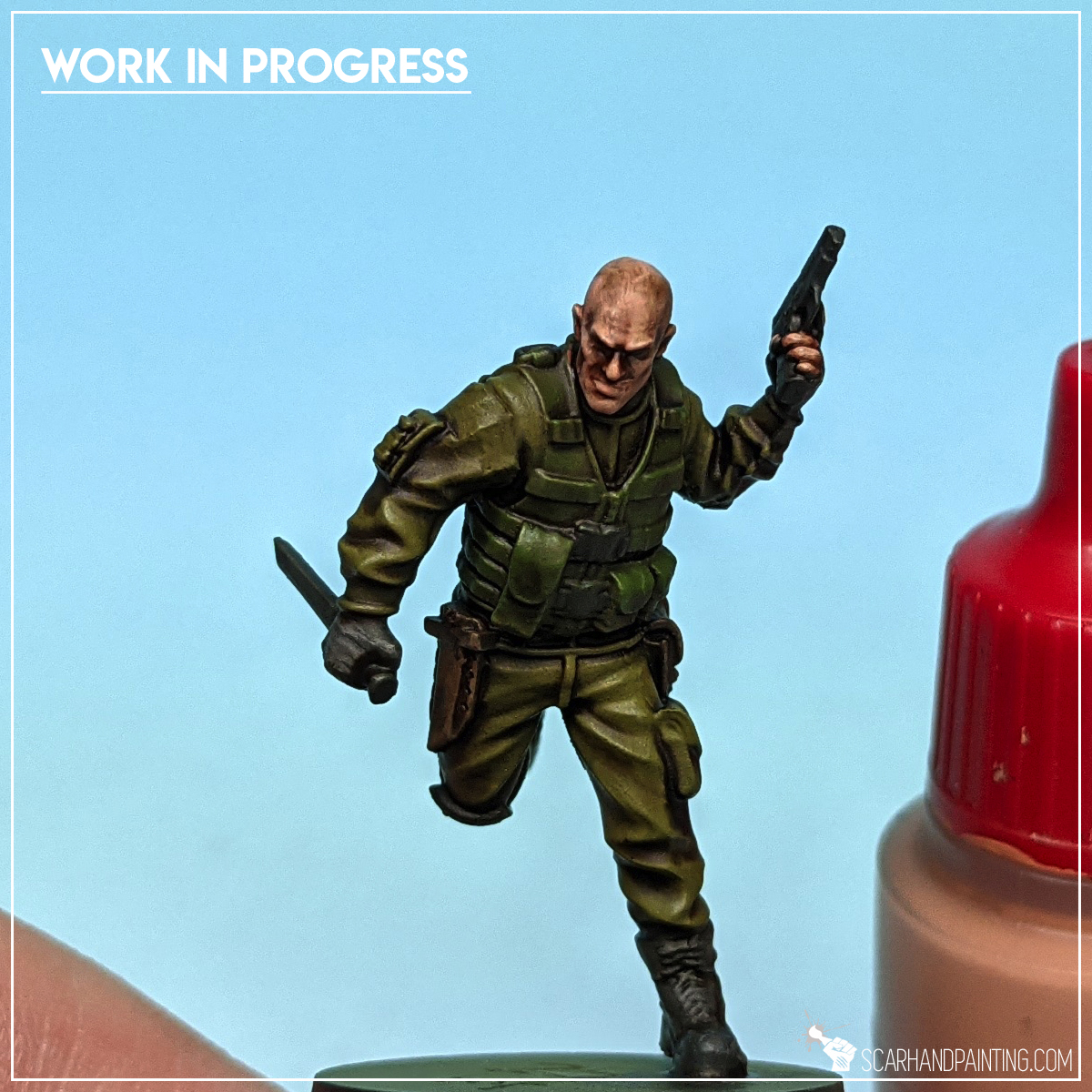
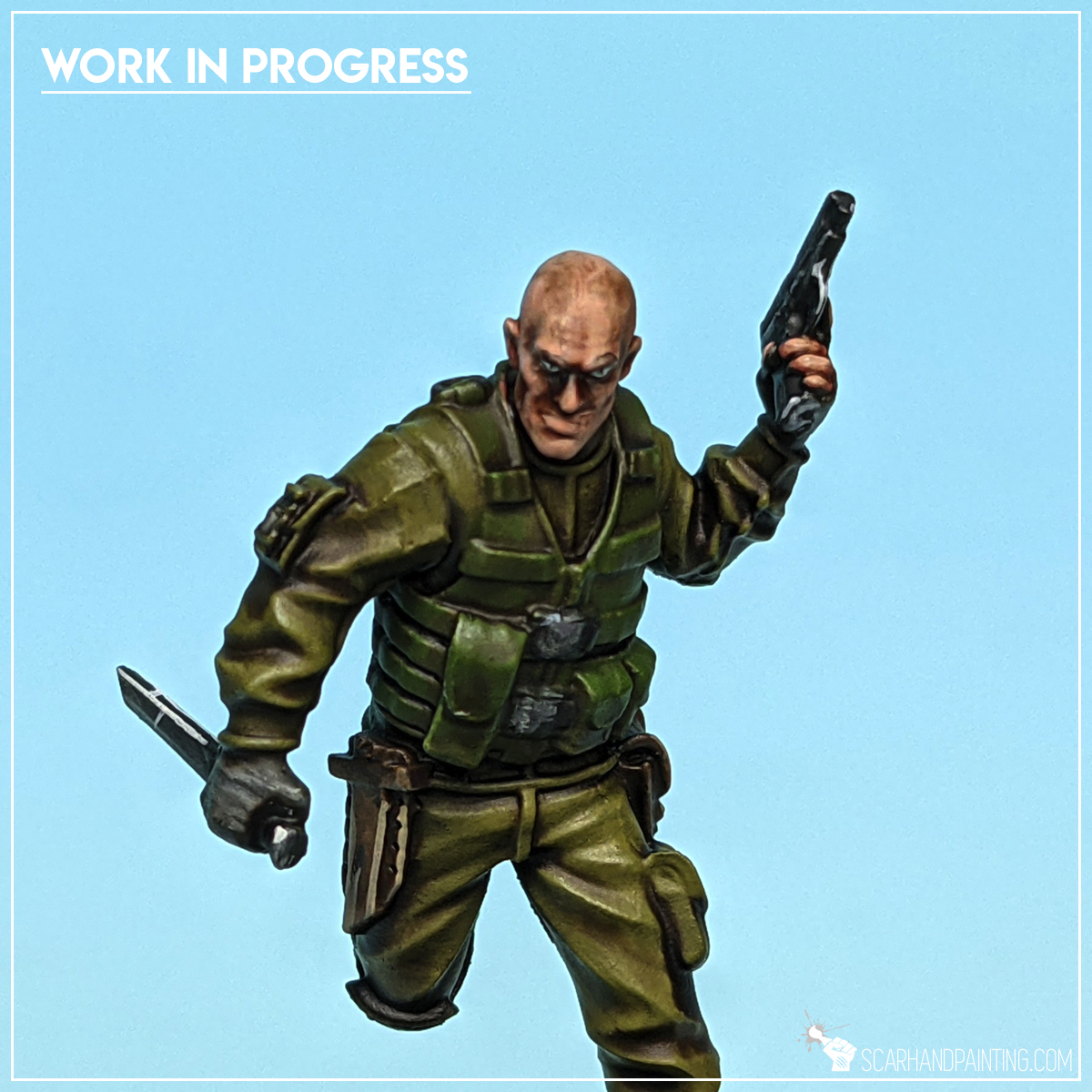
Step eight: Backpack & Holsters
I started with a strong layer of Vallejo Charred Brown (air), ensuring not to leave a mess on top of any previous layer around the backpack.
I then flatbrushed Vallejo Beasty Brown over Charred Brown. No thinning, just paint straight from a bottle and onto a palette before application.
I used Games Workshop Karak Stone for gritty highlights plus painted a blanket strapped at the bottom of the backpack.
I then switched to Vallejo Panzer Dark Grey (air) and re-painted all the buckles grey.
Agrax Earthshade wash followed (done at Step five: Brown wash).
Finally I applied a highlight of Games Workshop Karak Stone onto the edges and middle areas.


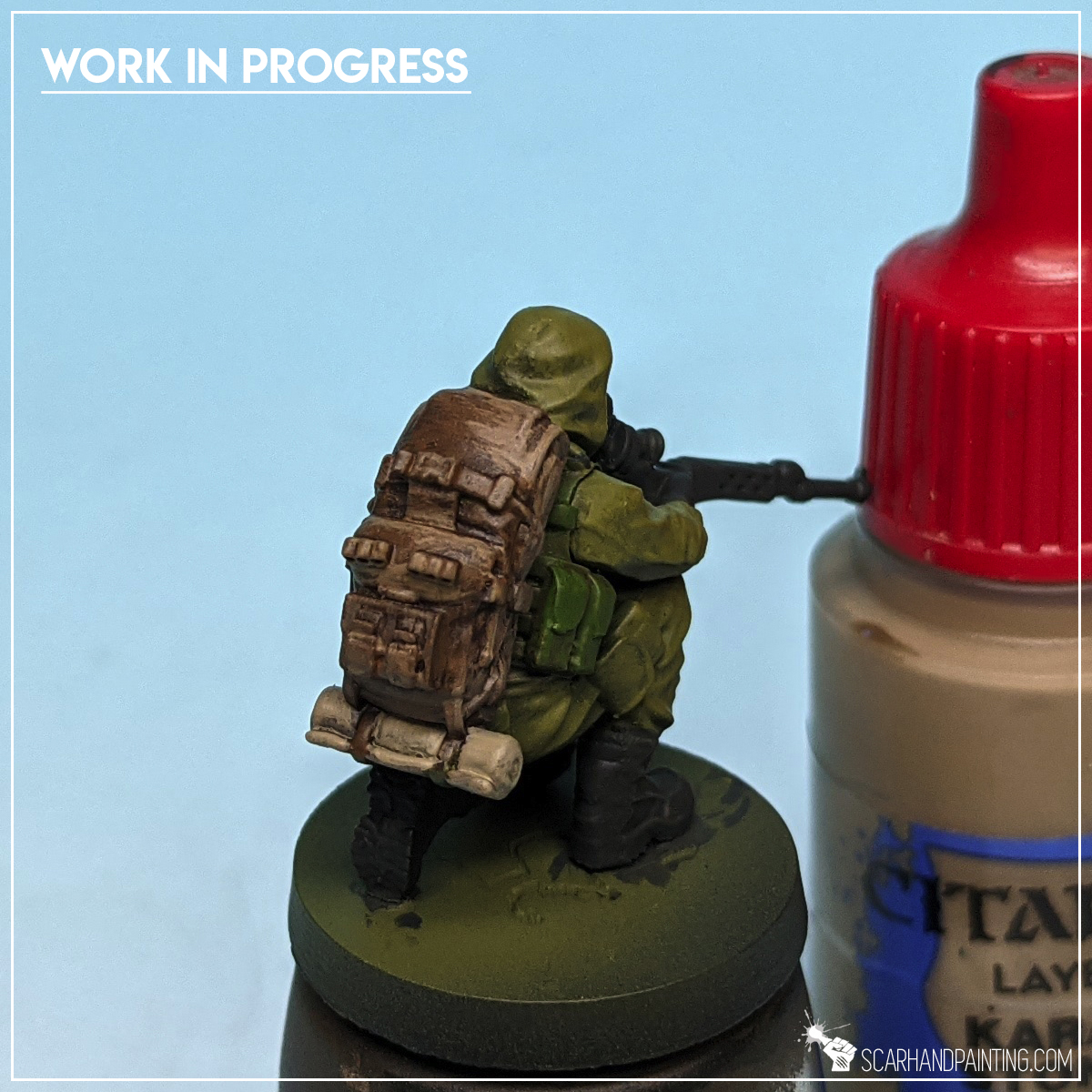
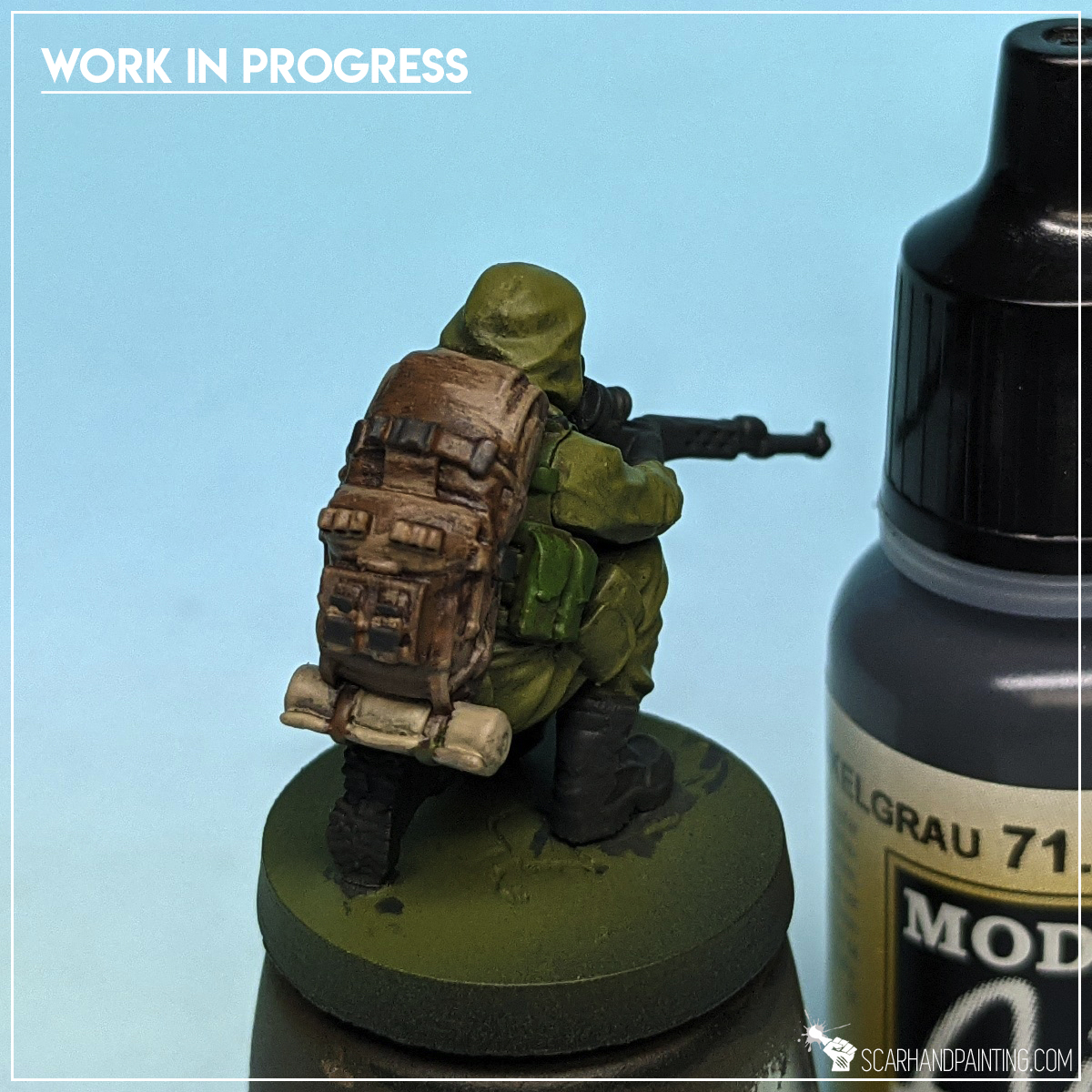
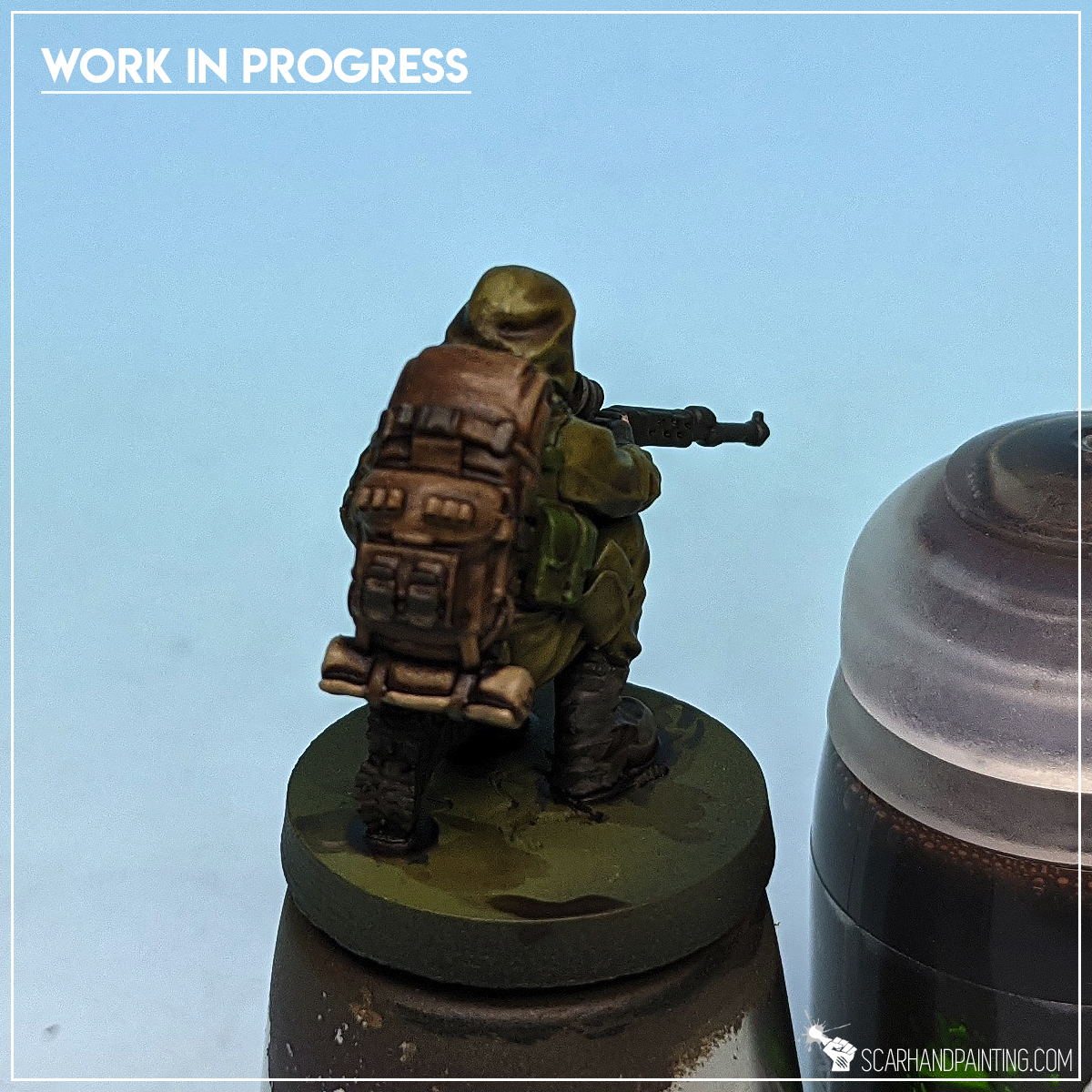
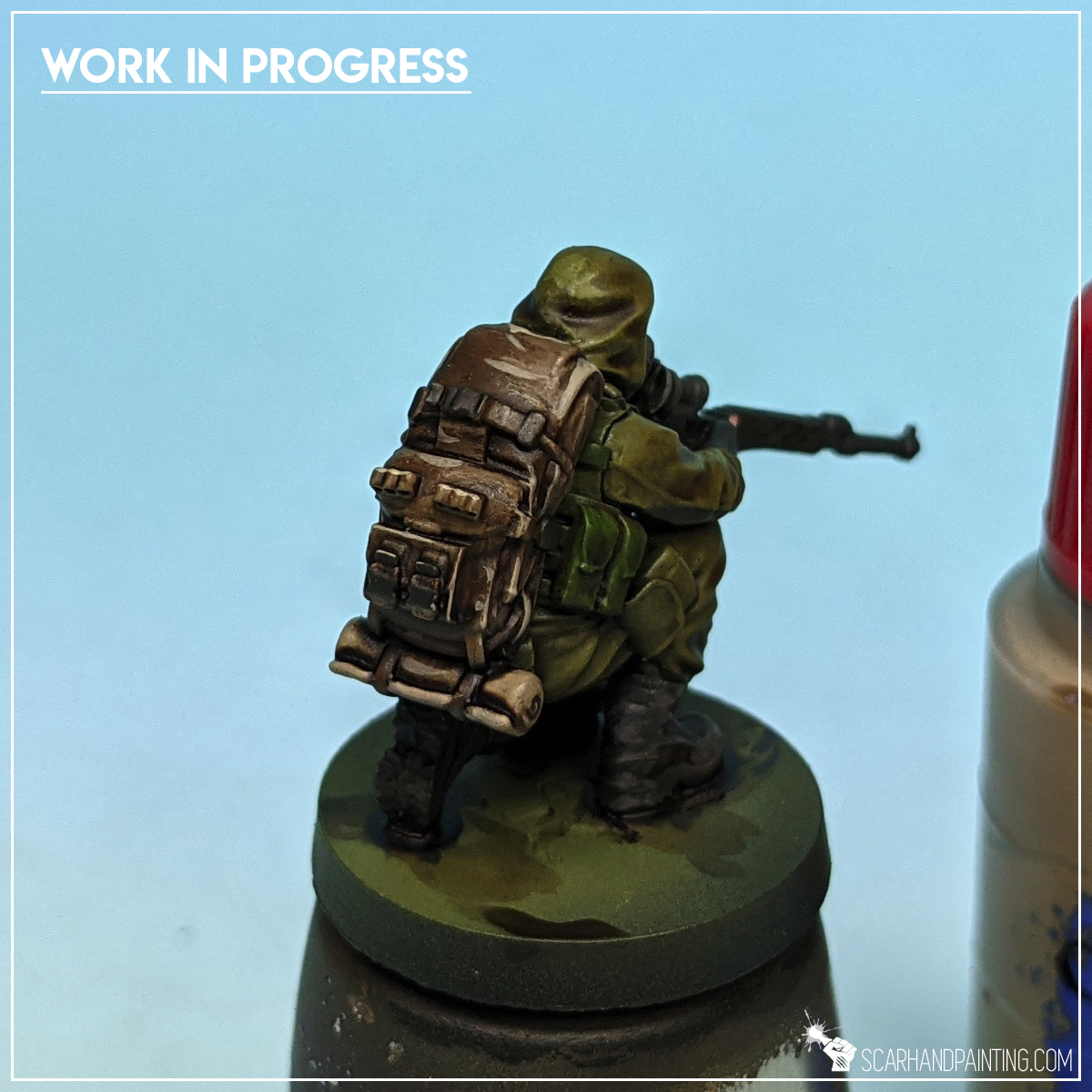
Step nine: Mask Visor
I tried to keep this one extra simple. Started with a gritty, messy layer of Games Workshop Pallid Wych Flesh. No need to be overly precise, nor smooth. The more irregular, diverse the visor looks now, the better the end result.
I then applied slightly thinned down Vallejo Hot Orange (air). Once dry I applied another layer of the same stuff. Done.
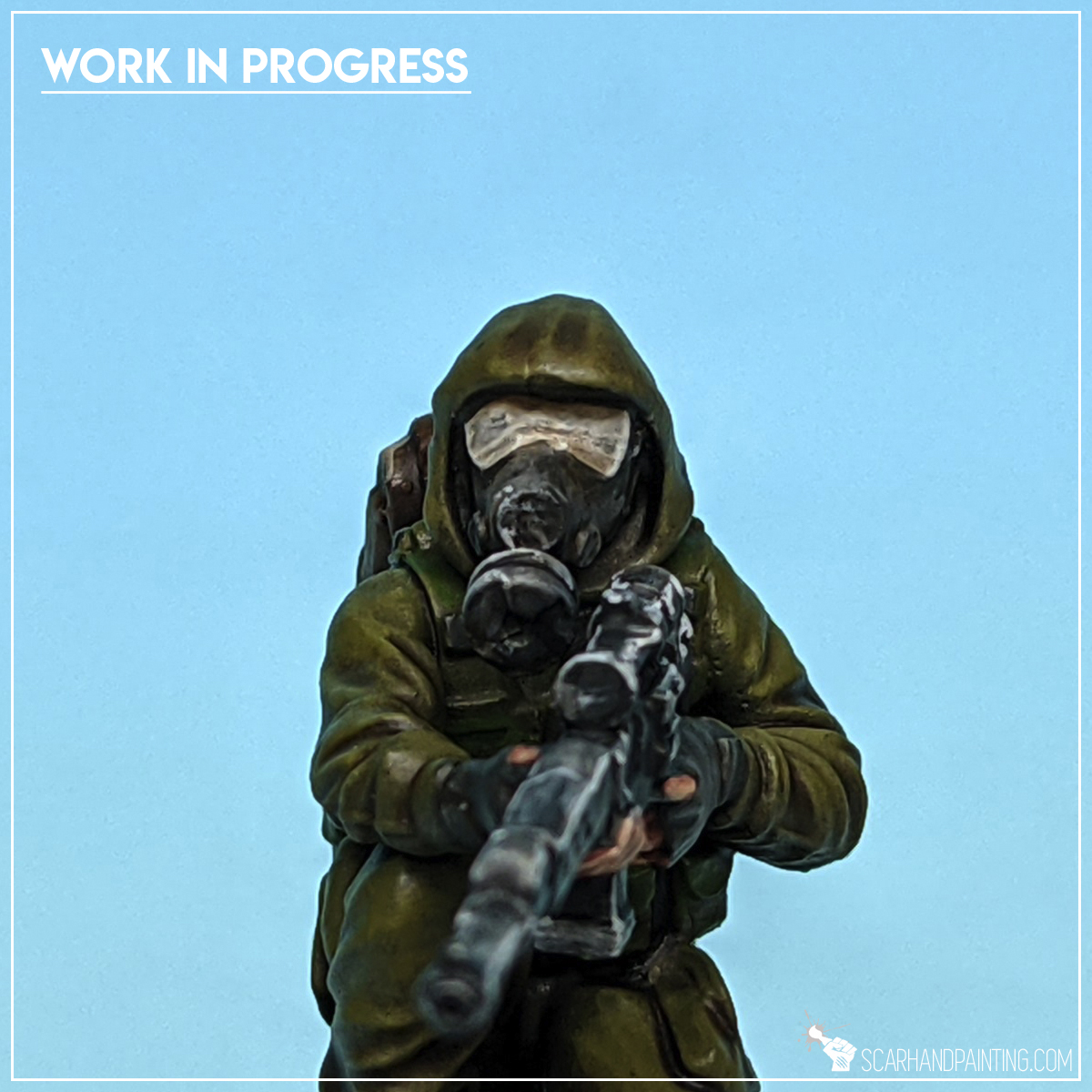
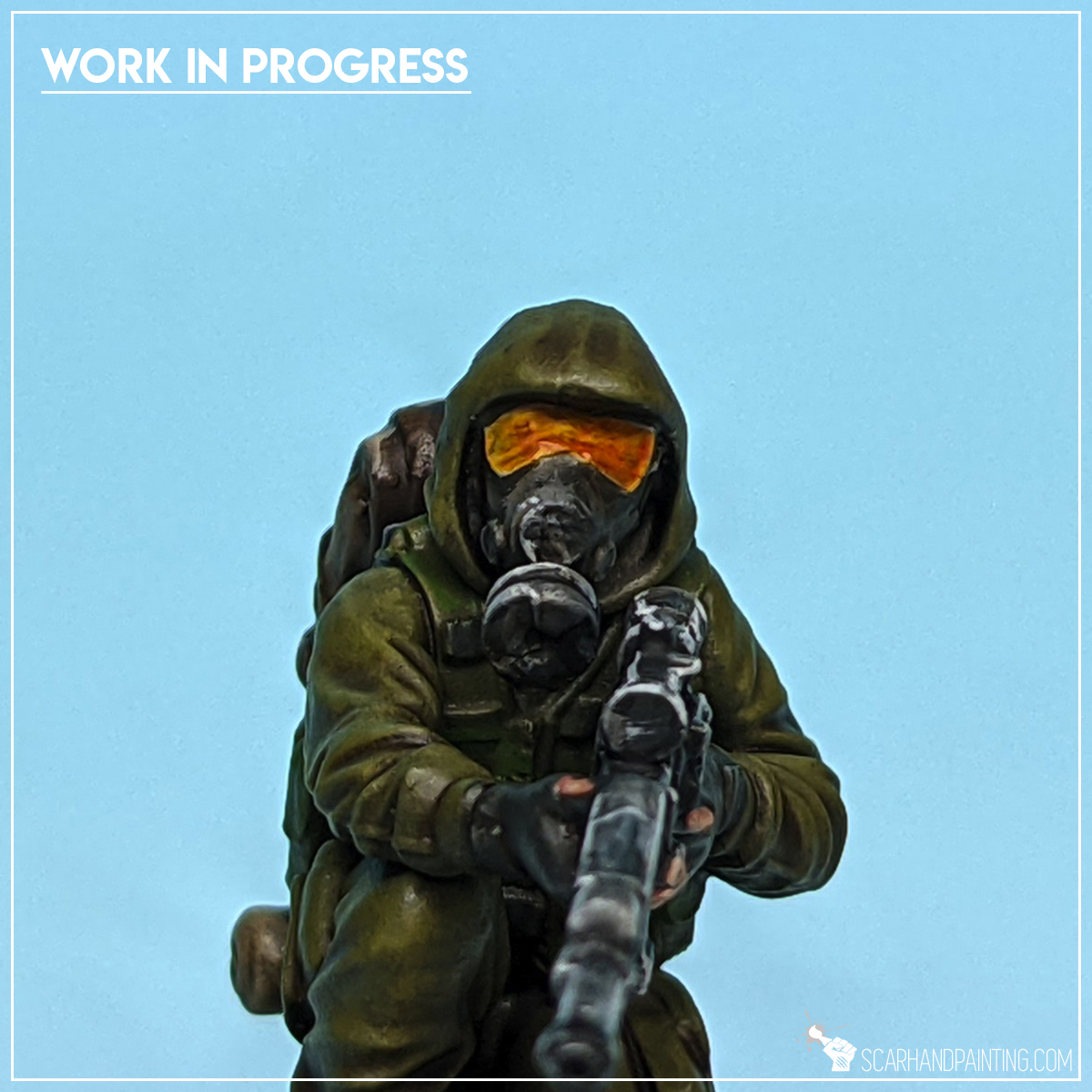
Step ten: Teddy Bear
This one is such a cool detail. I decided to go purple/pink to make it stand out. I started with a solid layer of Vallejo Royal Purple.
I then applied Games Workshop Agrax Earthshade wash (done at Step five: Brown wash).
Once wash dried, I highlighted most exposed areas of the bear with Vallejo Warlord Purple.
I then used Vallejo Squid Pink for final highlight, applying dots and lines on top of most exposed areas.
To bring all layers together I applied a strong layer of Army Painter Purple Tone Ink.
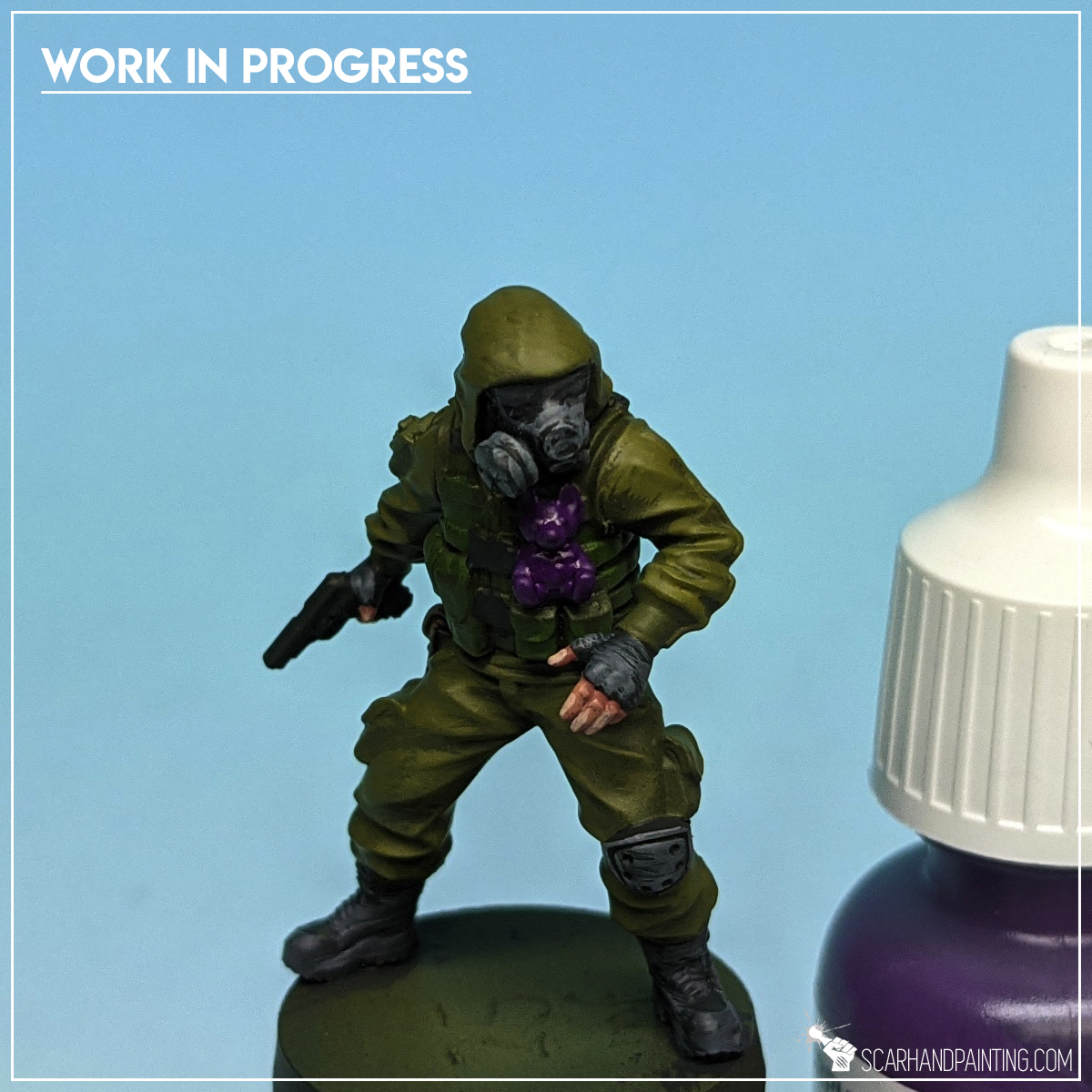
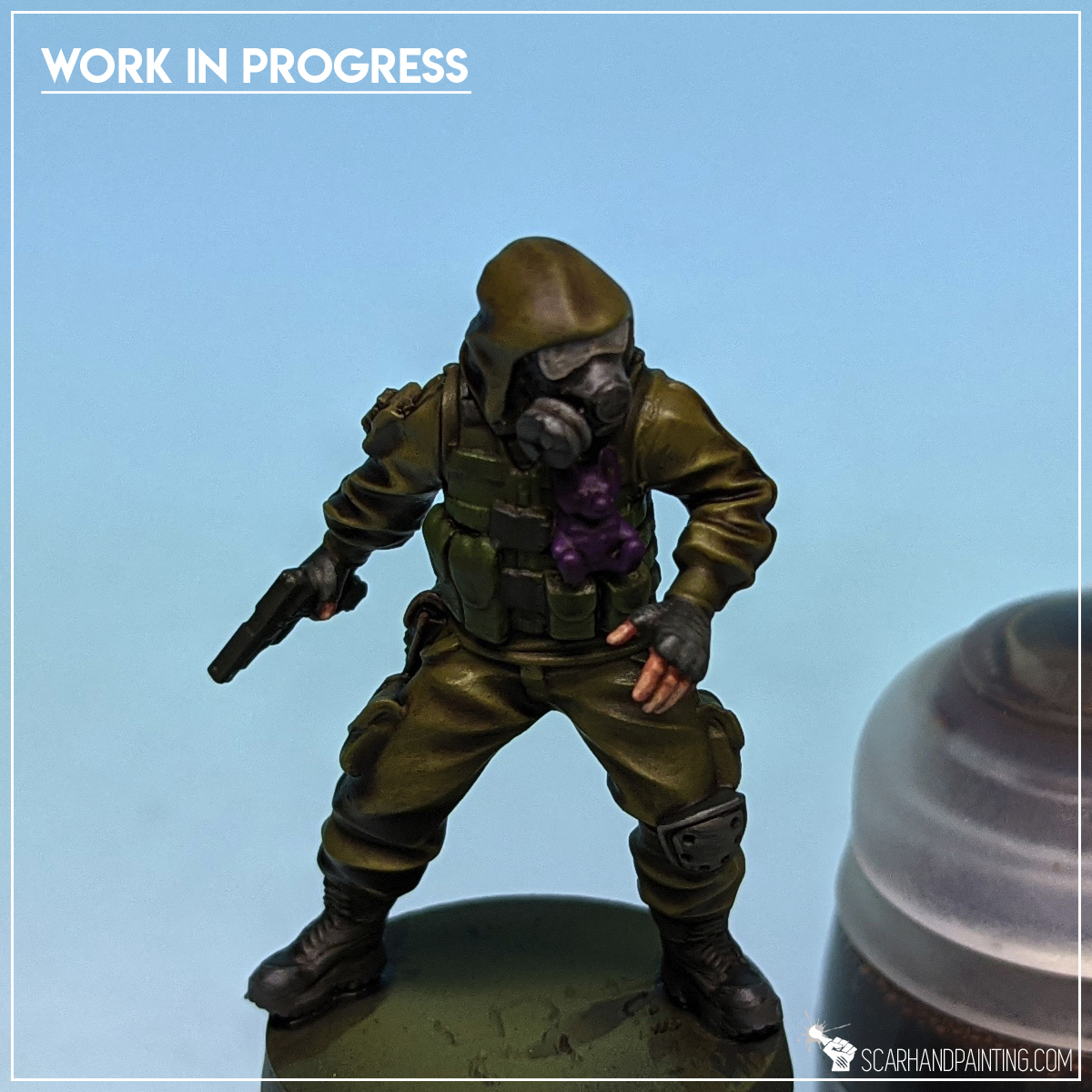
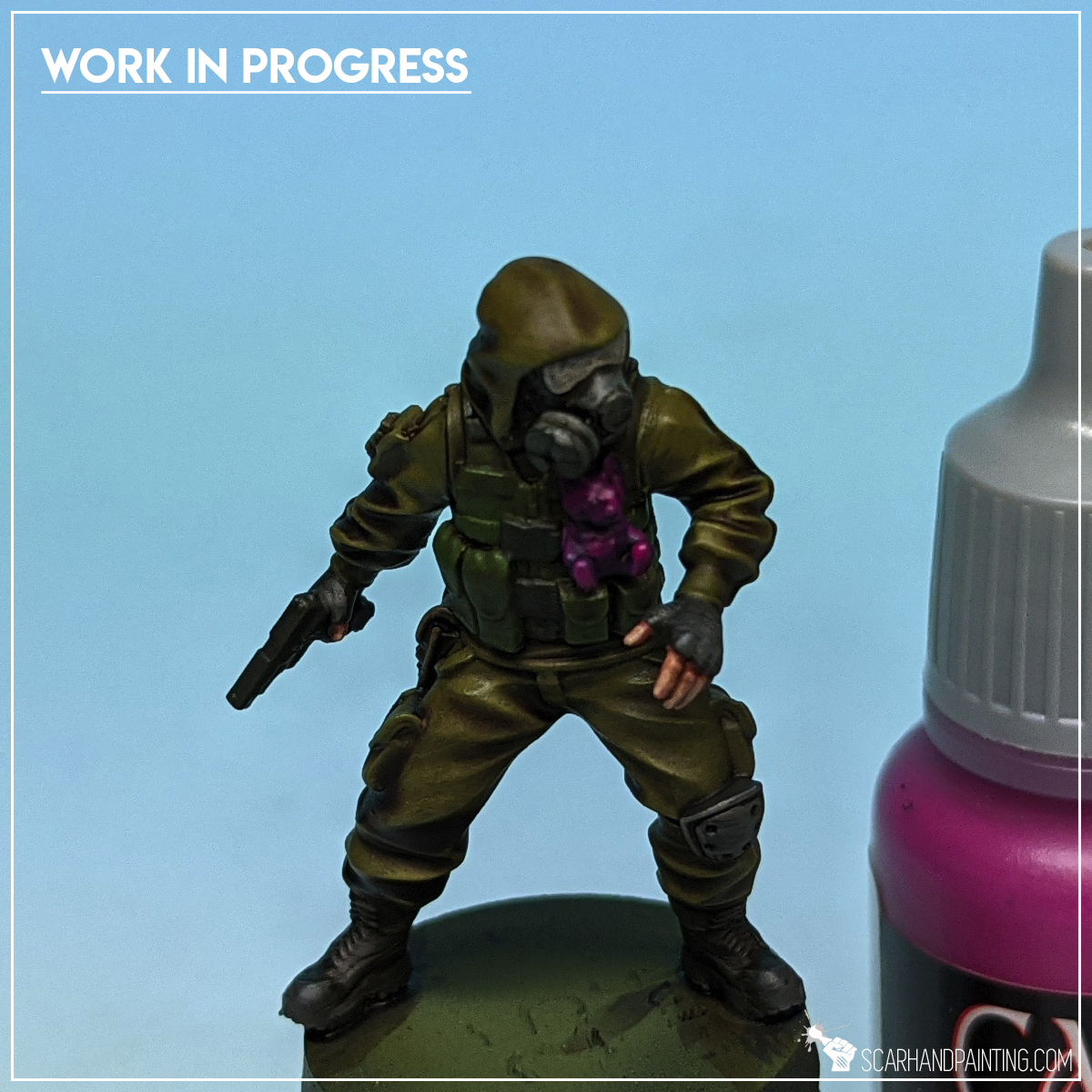

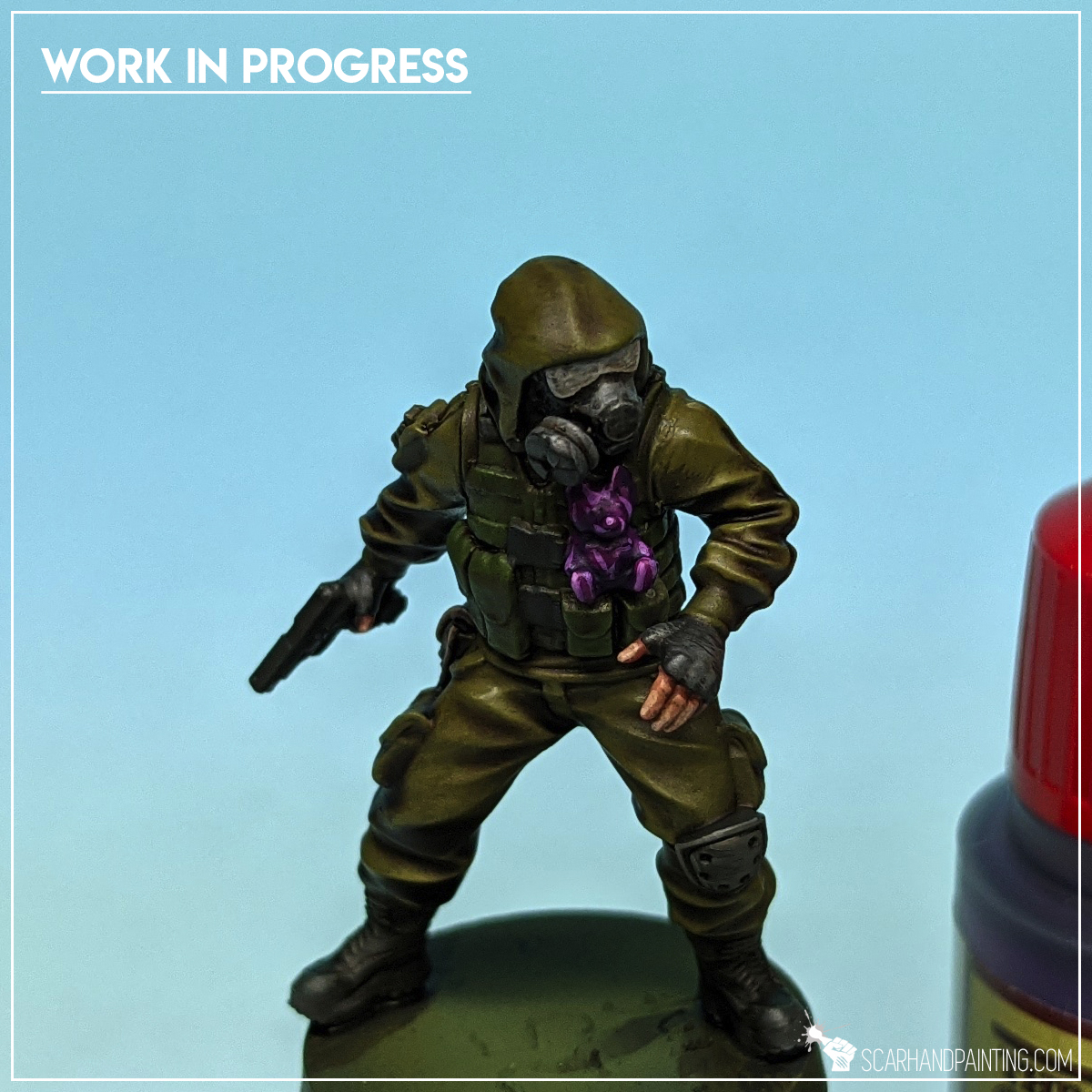
Step eleven: Yellow Kneepad
Once again I decided for a feature to stand out. I started with a strong, precise layer of Vallejo Heavy Goldbrown.
I then applied an irregular highlight of Vallejo Pale Yellow.
Finally I washed it with Army Painter Soft Tone Ink, which brought both layers together and made the knee pad look darker and used thoroughly.
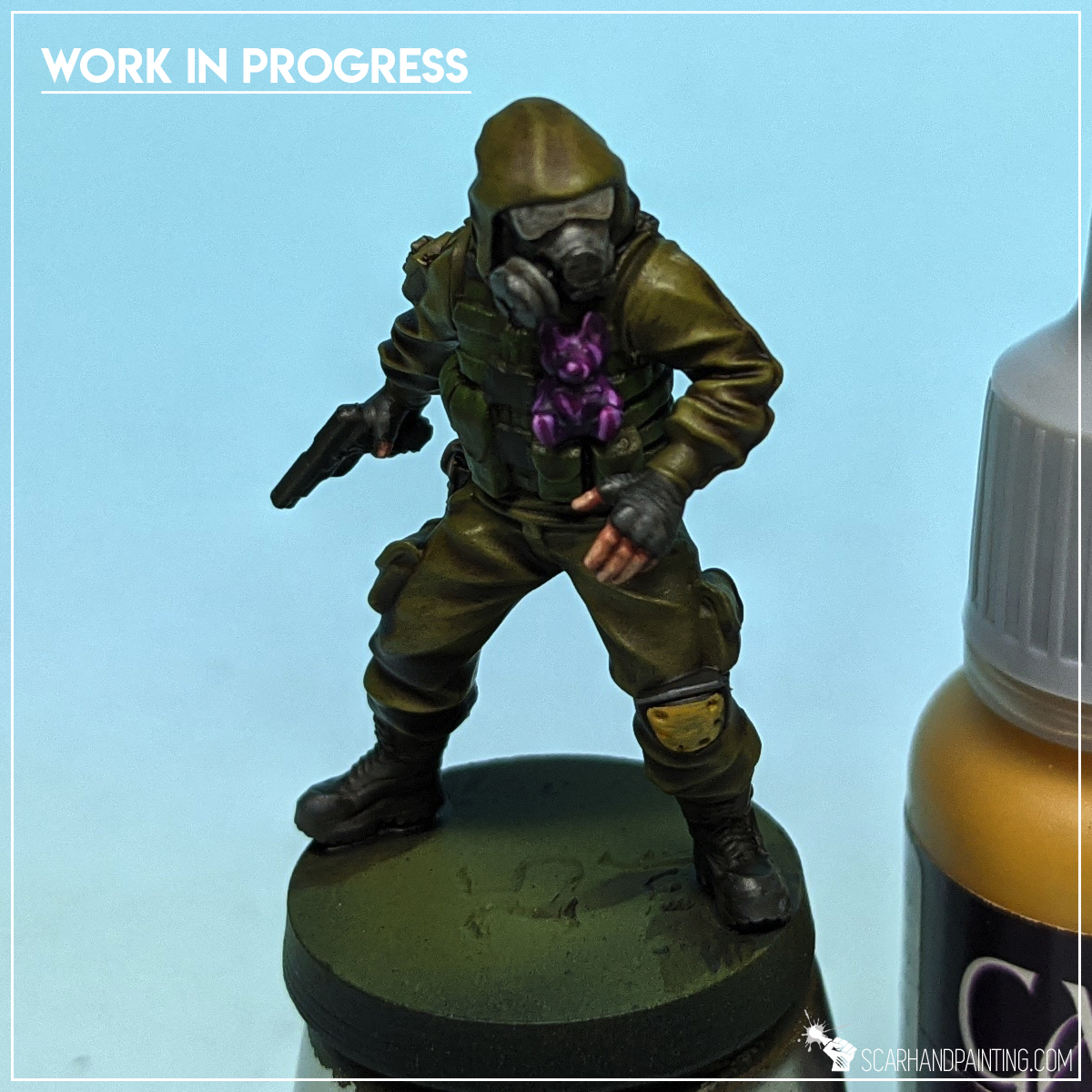
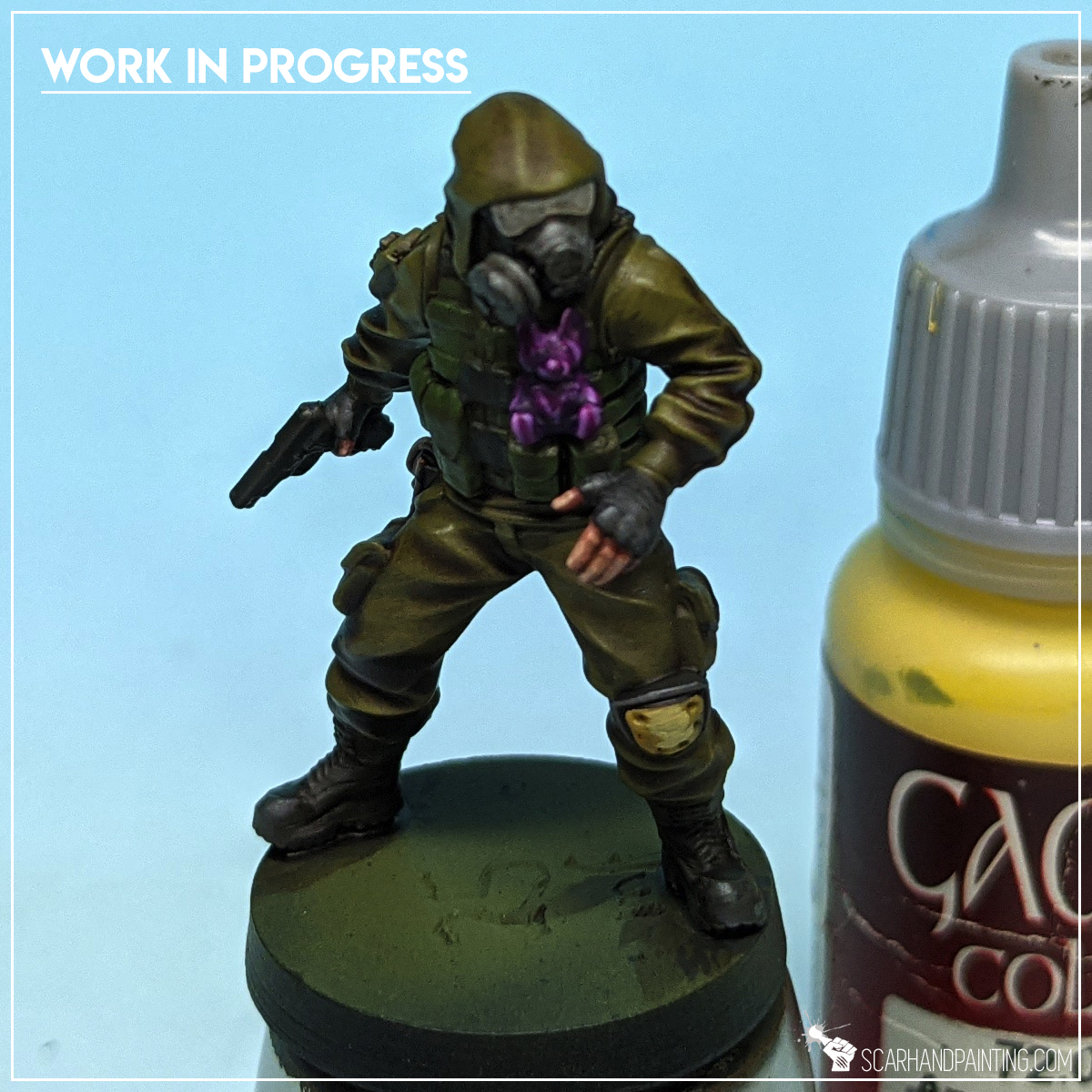
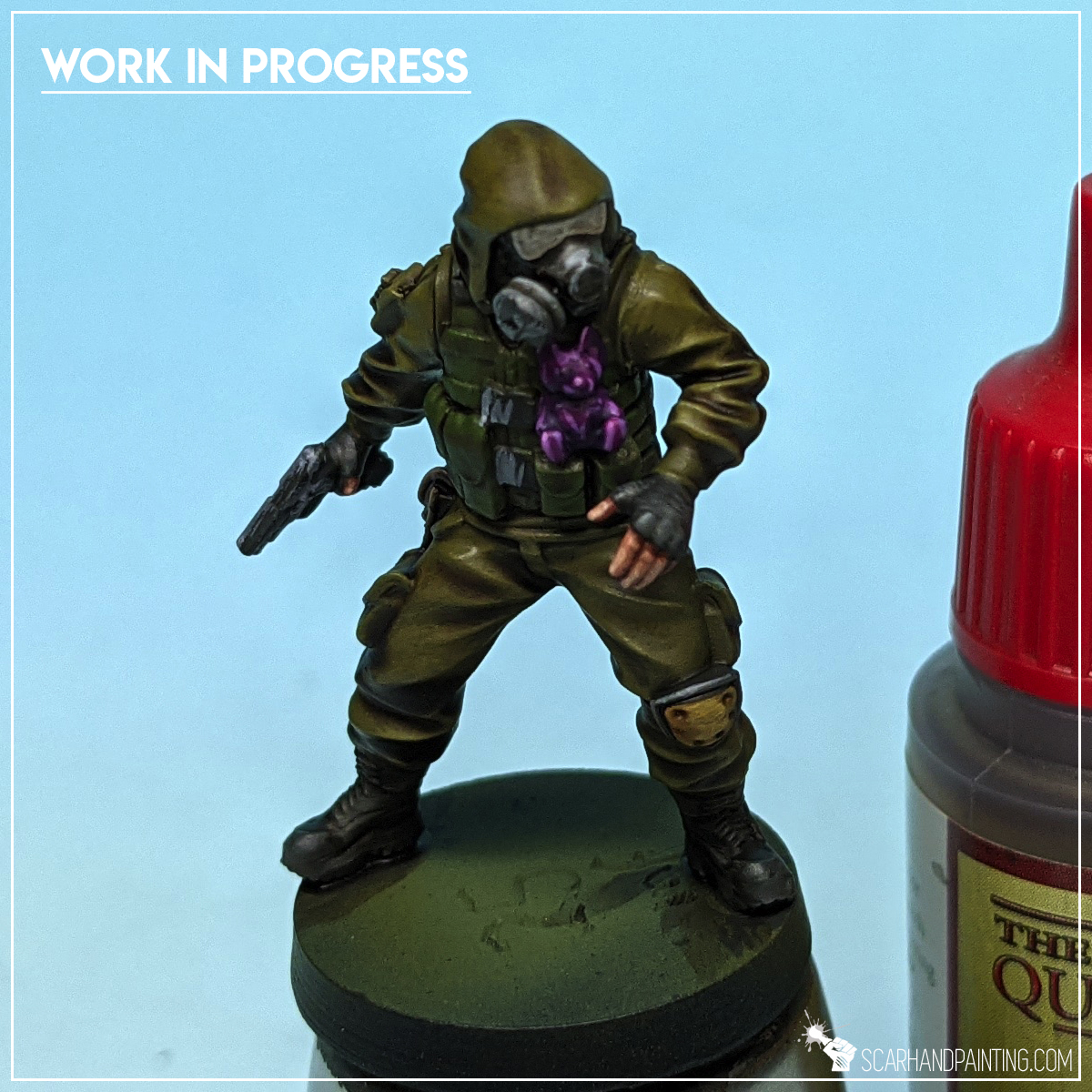
Step twelve: Basing
Time to finish the paint job with a proper looking base. For this purpose I decided to go with something easy to follow. One texture, one highlight and one tuft type for extra detail. I started with a large flat brush, applying a thick layer of AK Interactive Dark Earth texture. You can switch to any dark texture like for example Games Workshop Stirland Mud. I just prefer AK’s one because I find it easier to apply.
Once dry I drybrushed Dark Earth with Games Workshop Karak Stone.
Finally I glued an Army Painter Wasteland Tuft and re-painted base’s edge black afterwards.
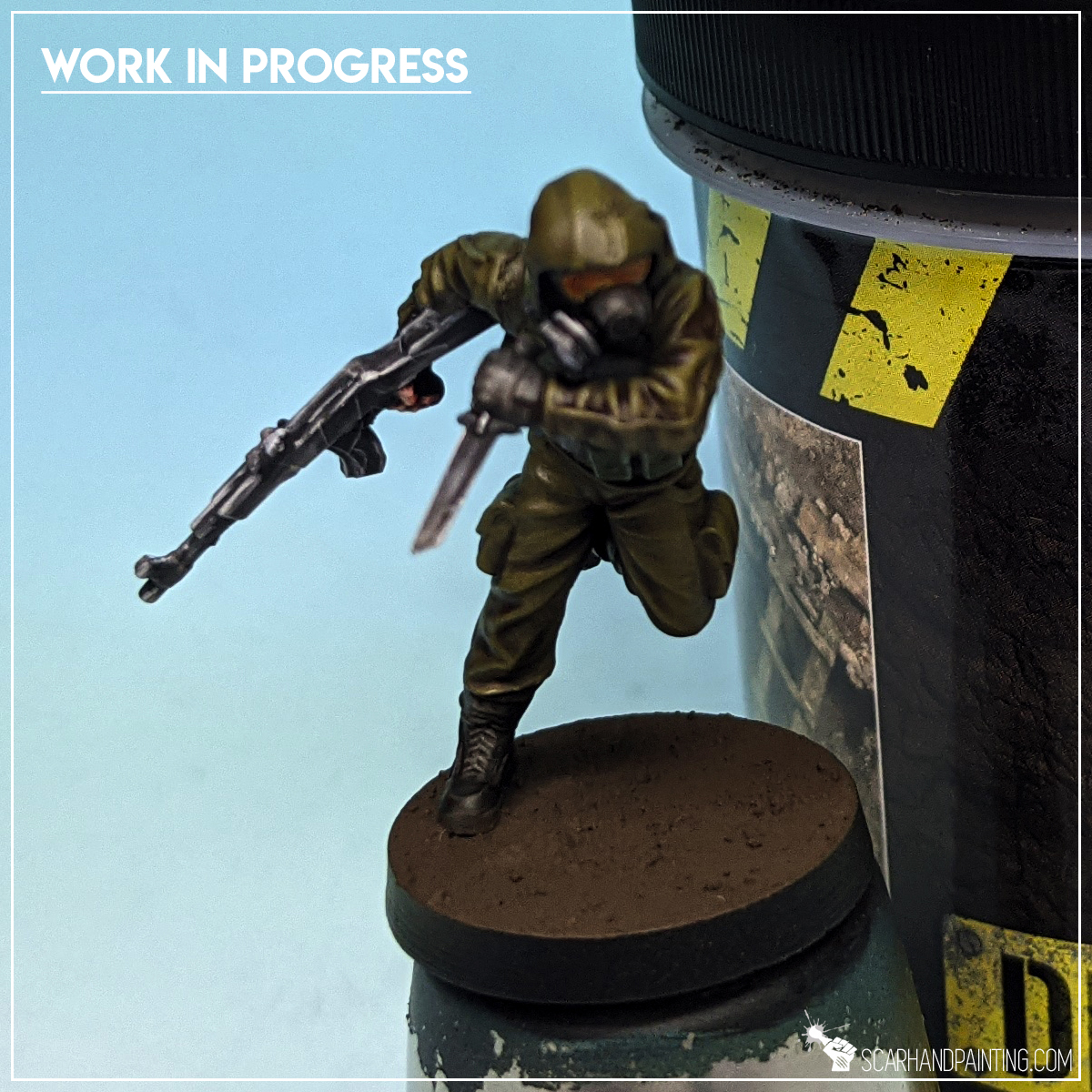
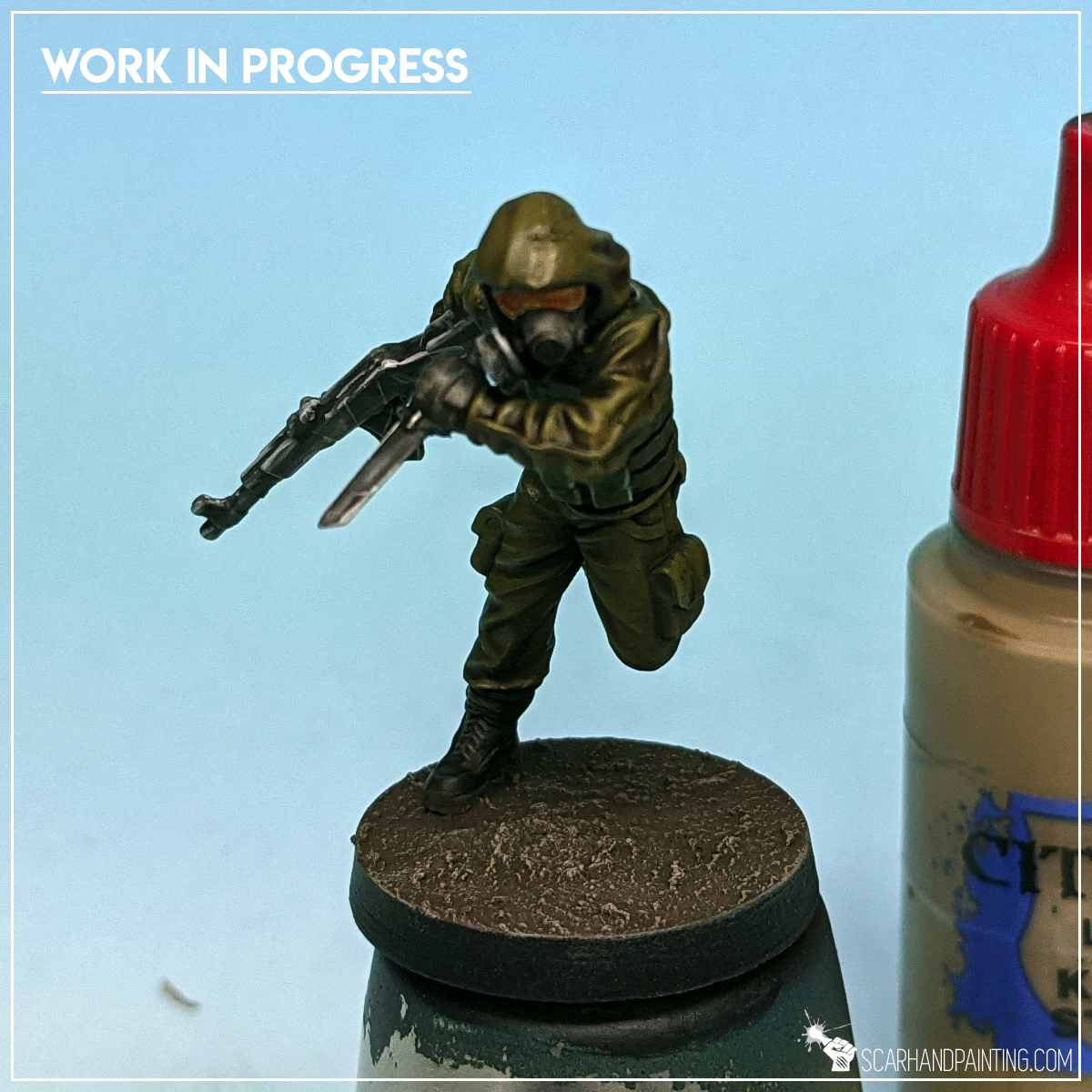


I hope you find this tutorial interesting. Be sure to let me know your thoughts in the comments below or via Facebook.or Instagram. I would also appreciate if you considered sharing this content with your friends, who might find it useful. Finally if you are looking for a professional miniatures painting service be sure to contact me with this contact form. I always reply within 24 hours, after which please check out your spam folder.
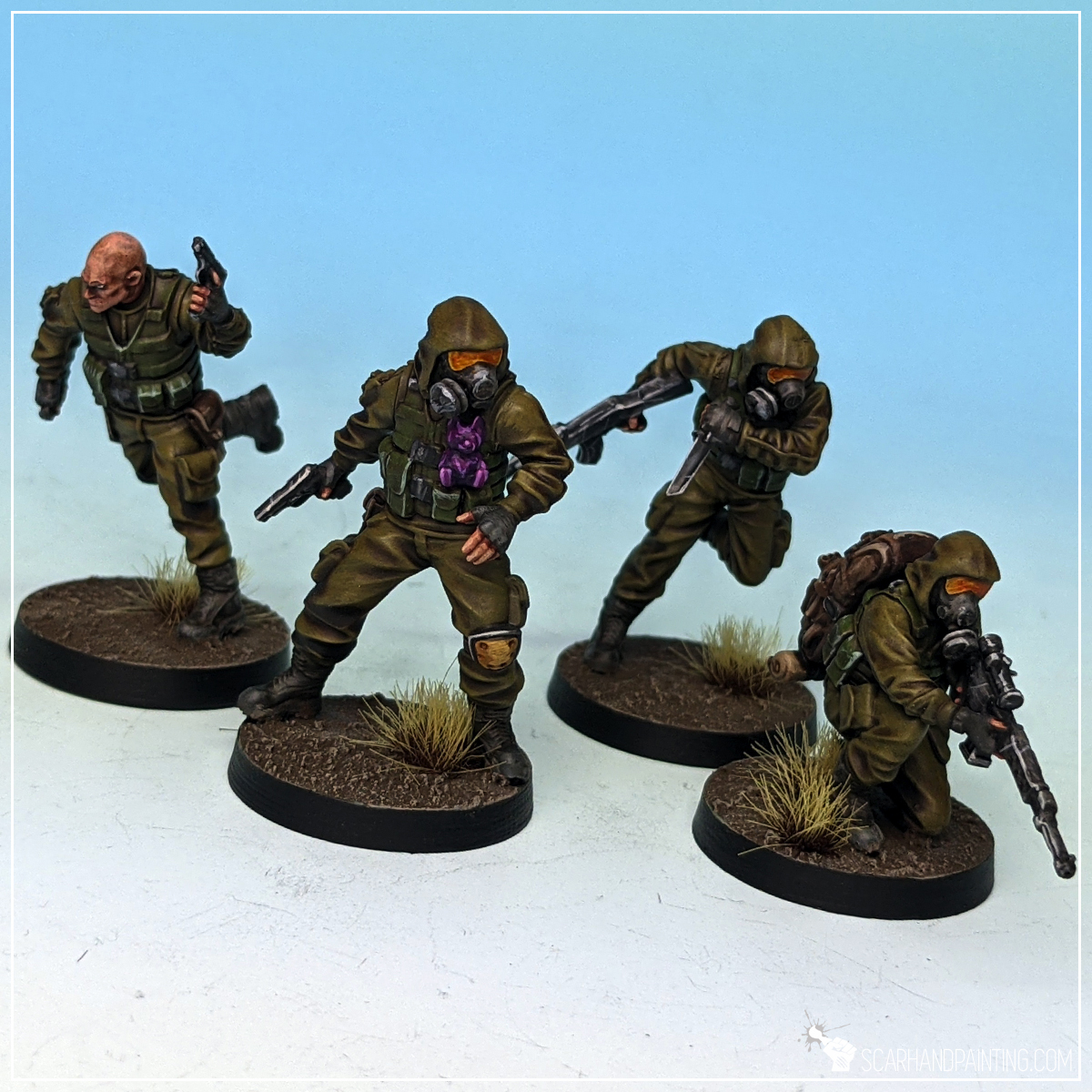
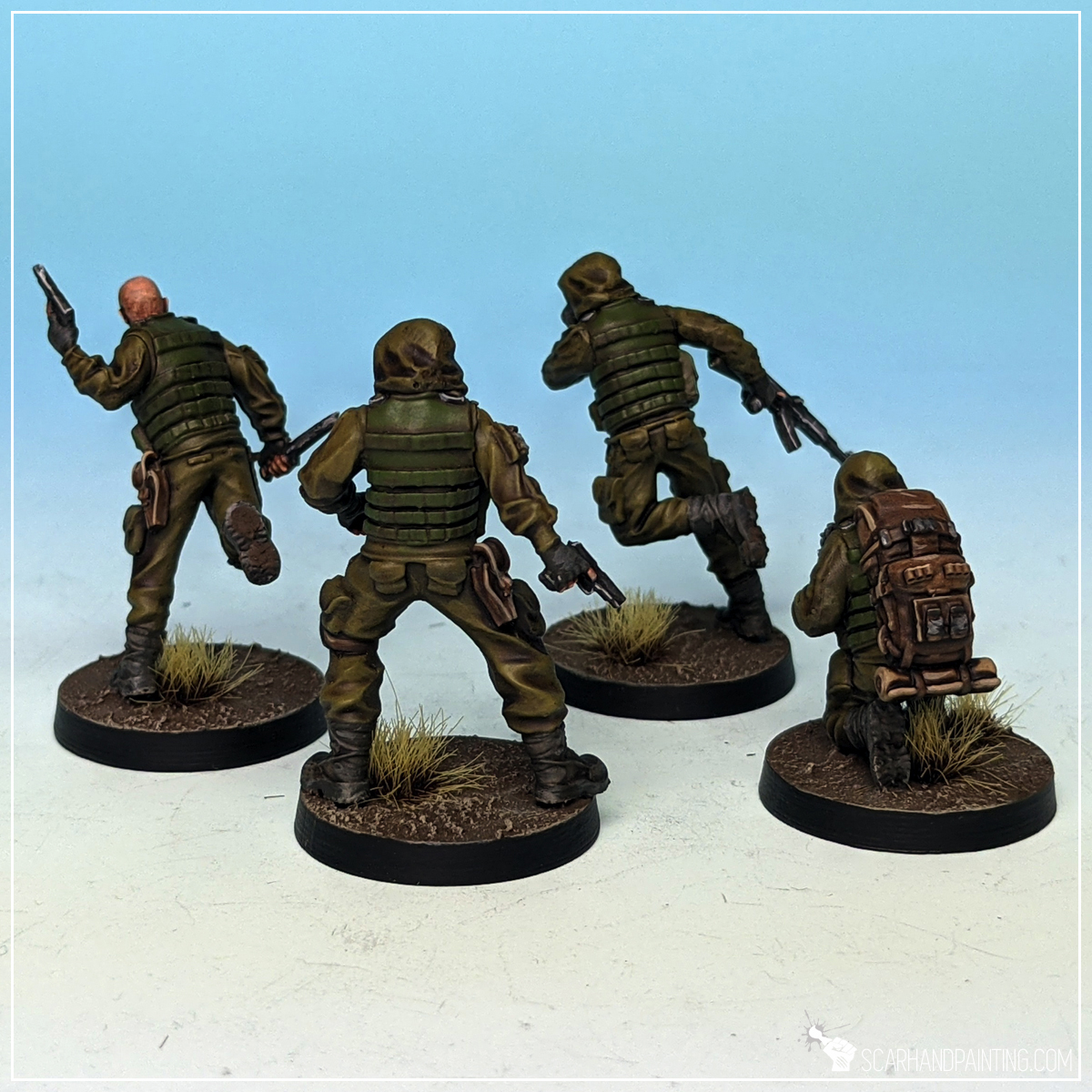

Welcome to Painting Blood Bowl Bogenhafen Barons tutorial. Here I will present to you a Step-by-step of an easy and fast painting process for Games Workshop Bogenhafen Barons as can be seen in Gallery: Bogenhafen Barons.
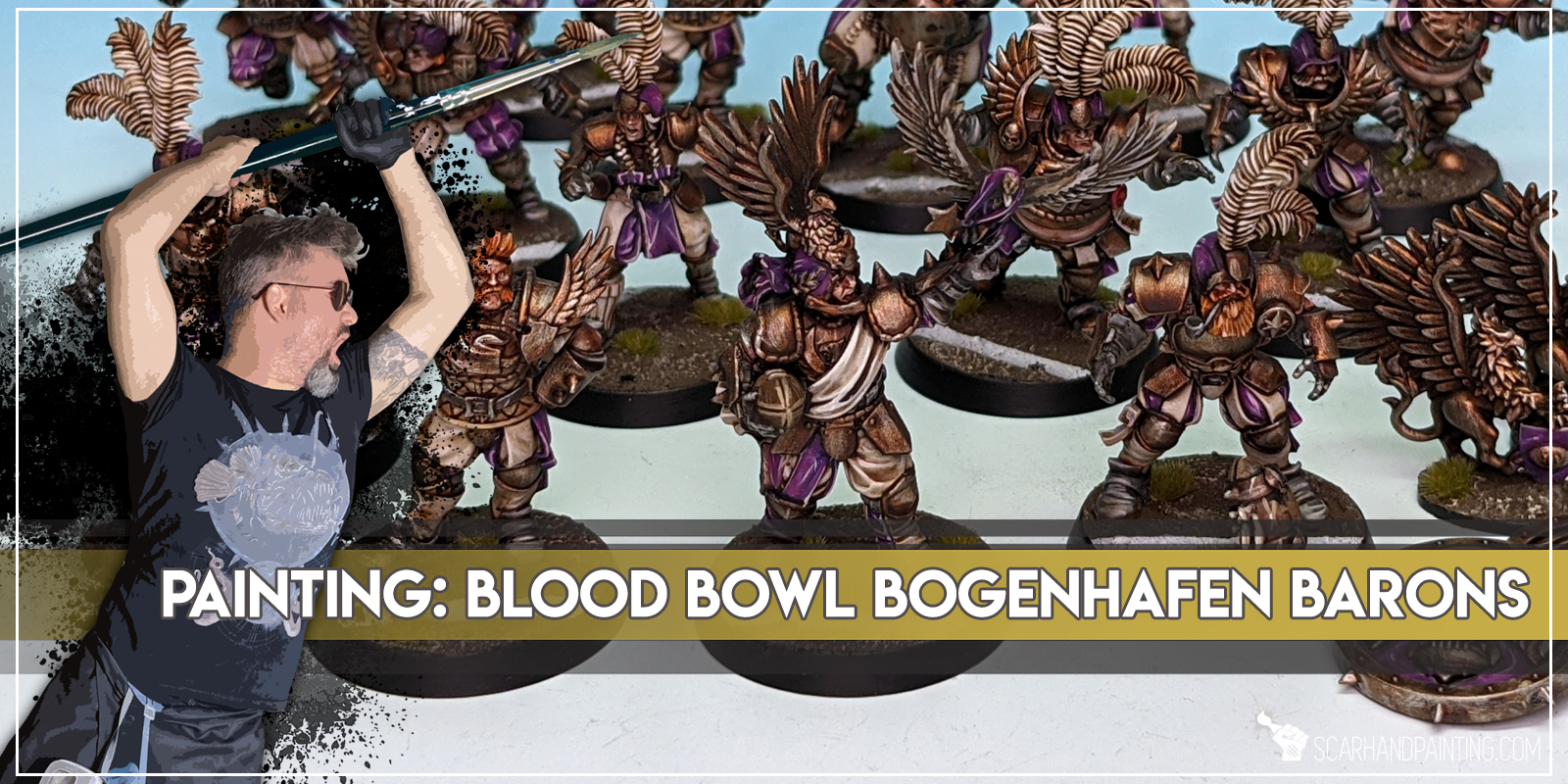
Before we start, some notes:
Step one: Undercoat
I started with a thorough layer of Games Workshop Chaos Black spray. This is a standard procedure for me. Chaos Black spray is my go to choice when it comes to undercoat.
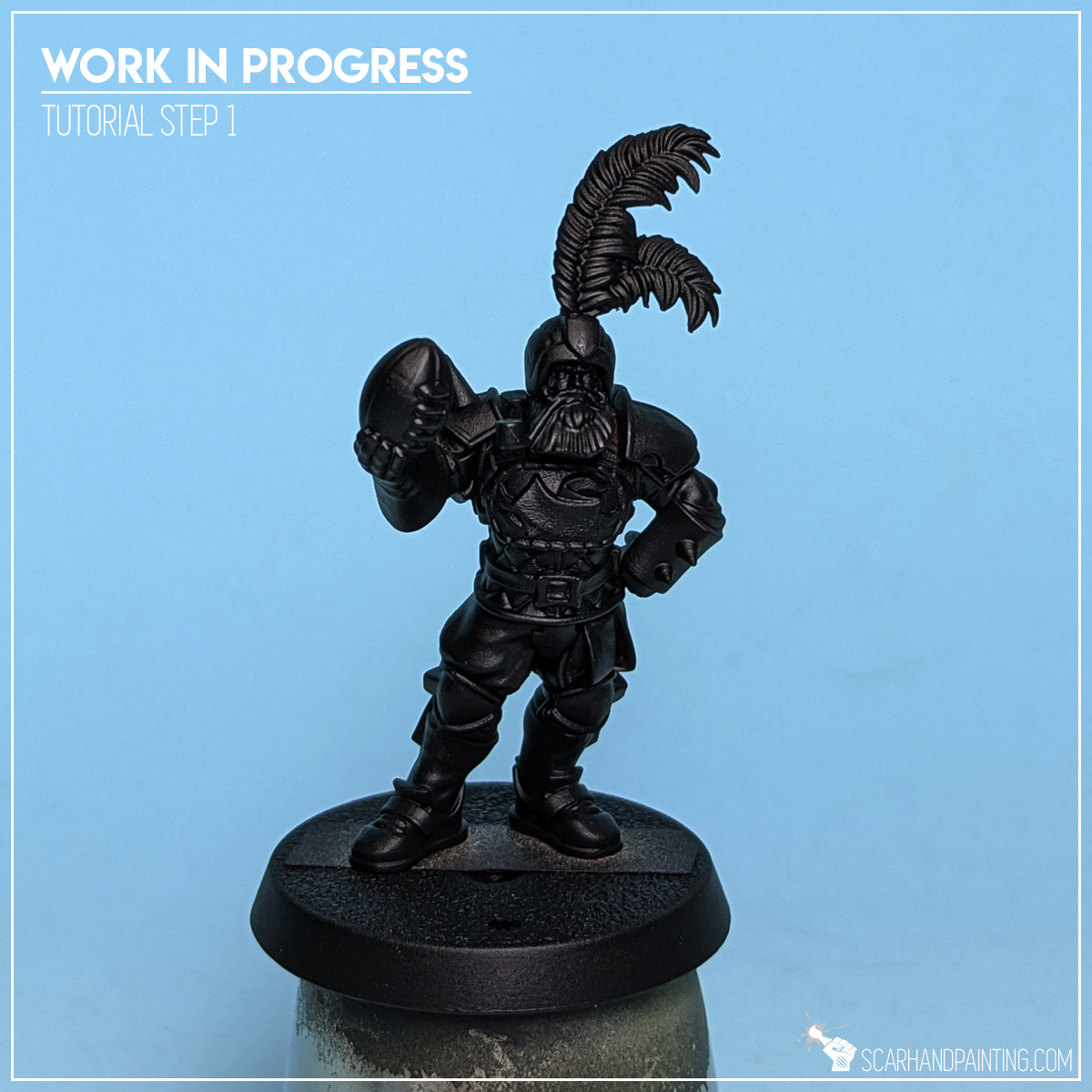
Step two: Cream
I started by airbrushing Vallejo Bonewhite (air) all over feathers and clothes of the miniature, not caring if I mess up everything around. Paint was applied straight out of bottle, no dilution. I then moved to GW Pale Wych Flesh and
Flatbrushed it over previous layer. This layer was meant to build volume of paint and just a bit of highlight for the color, so that further ahead Wash could do a better job.

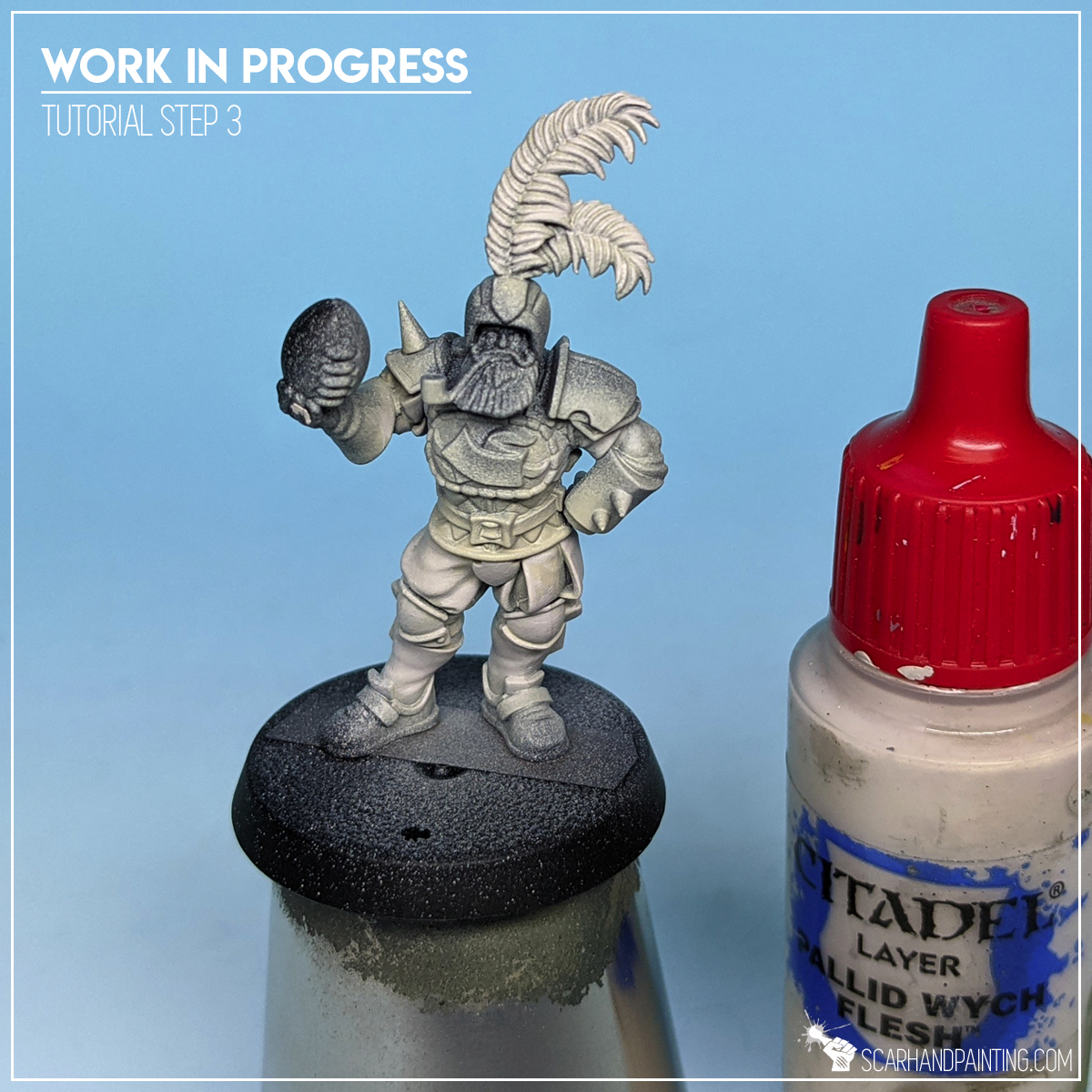
Step three: Grey
I applied Vallejo Air Panzer Dark Grey (air) manually, with natural dilution (air series). This paint is easy to control which helped me keep the layer precise. The color wasn’t strong but this layer didn’t had to. It was meant to prepare a background for future highlights of dark black-to-brown elements. Next I used slightly diluted Vallejo Glacier Blue and flatbrushed it over previous layer. Finally I applied few highlights with GW Pale Wych Flesh.
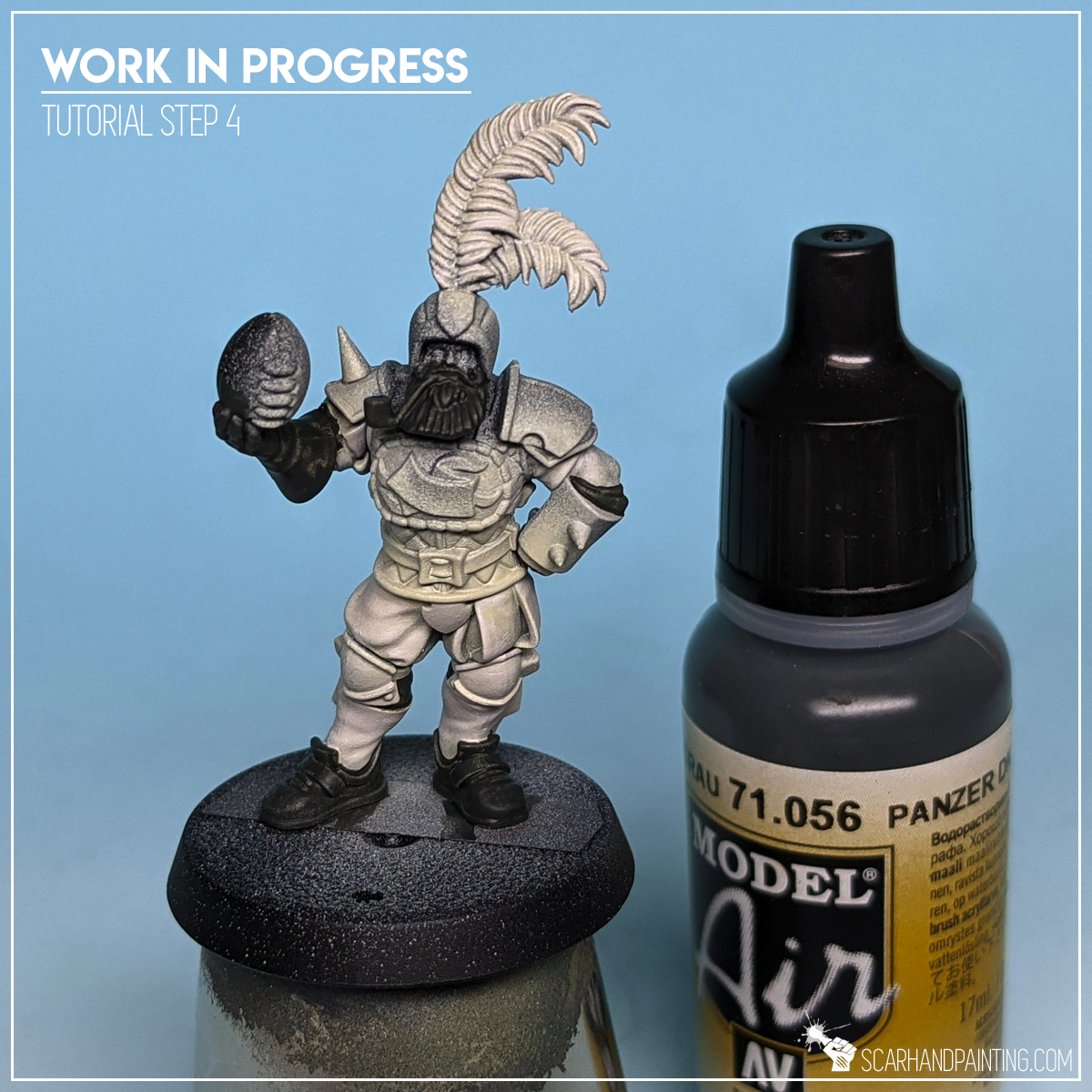
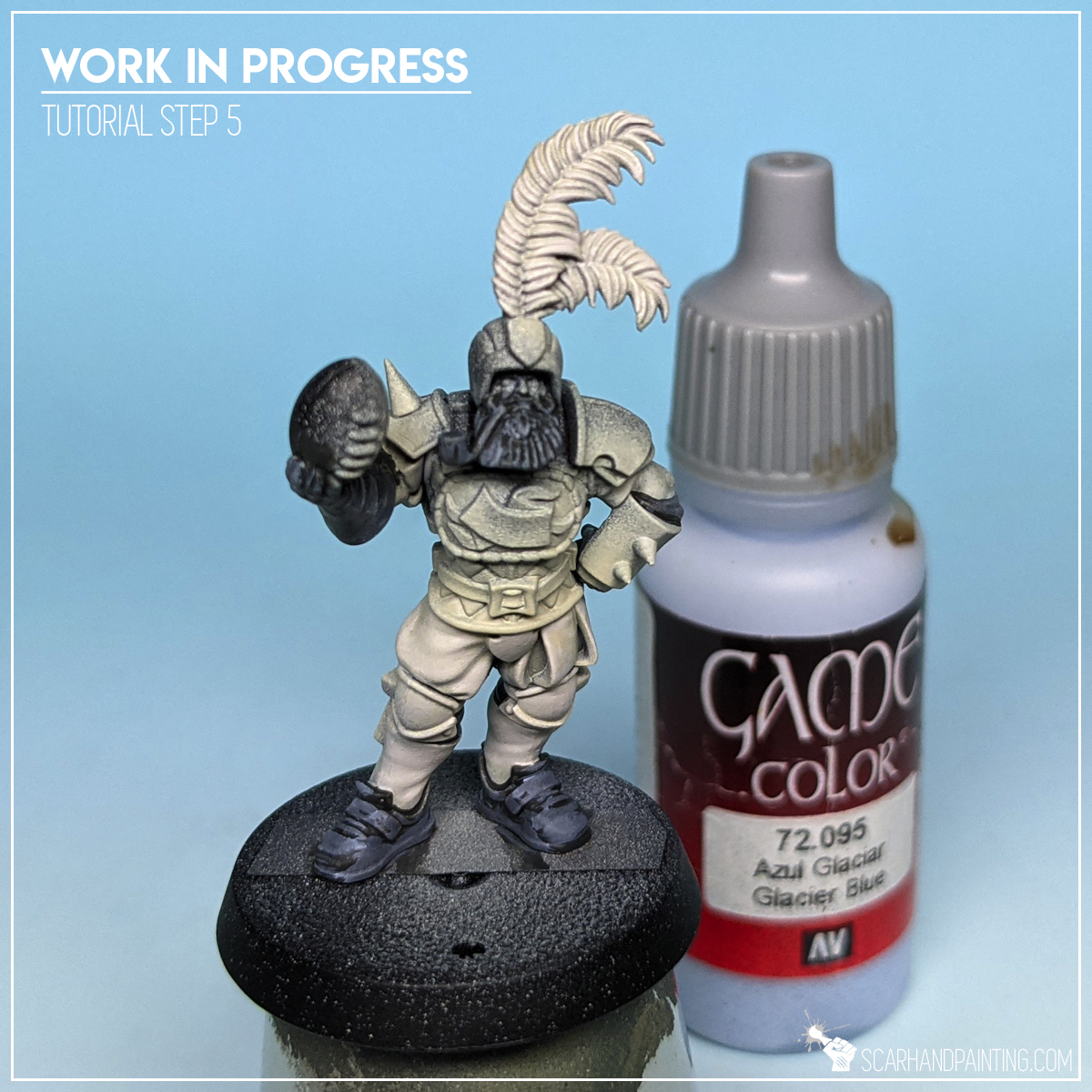

Step four: Skin
I begun painting skin with Vallejo Tan by applying a thin layer and concentrating on filling recesses. I added another thin layer on large flat areas to provide a solid color. Next I switched to GW Dwarf Flesh covered previous layer using flatbrush technique. Final highlights were made with Vallejo Flesh (air). I used the paint straight out of the bottle and applied it on the edges and on top of flat areas.
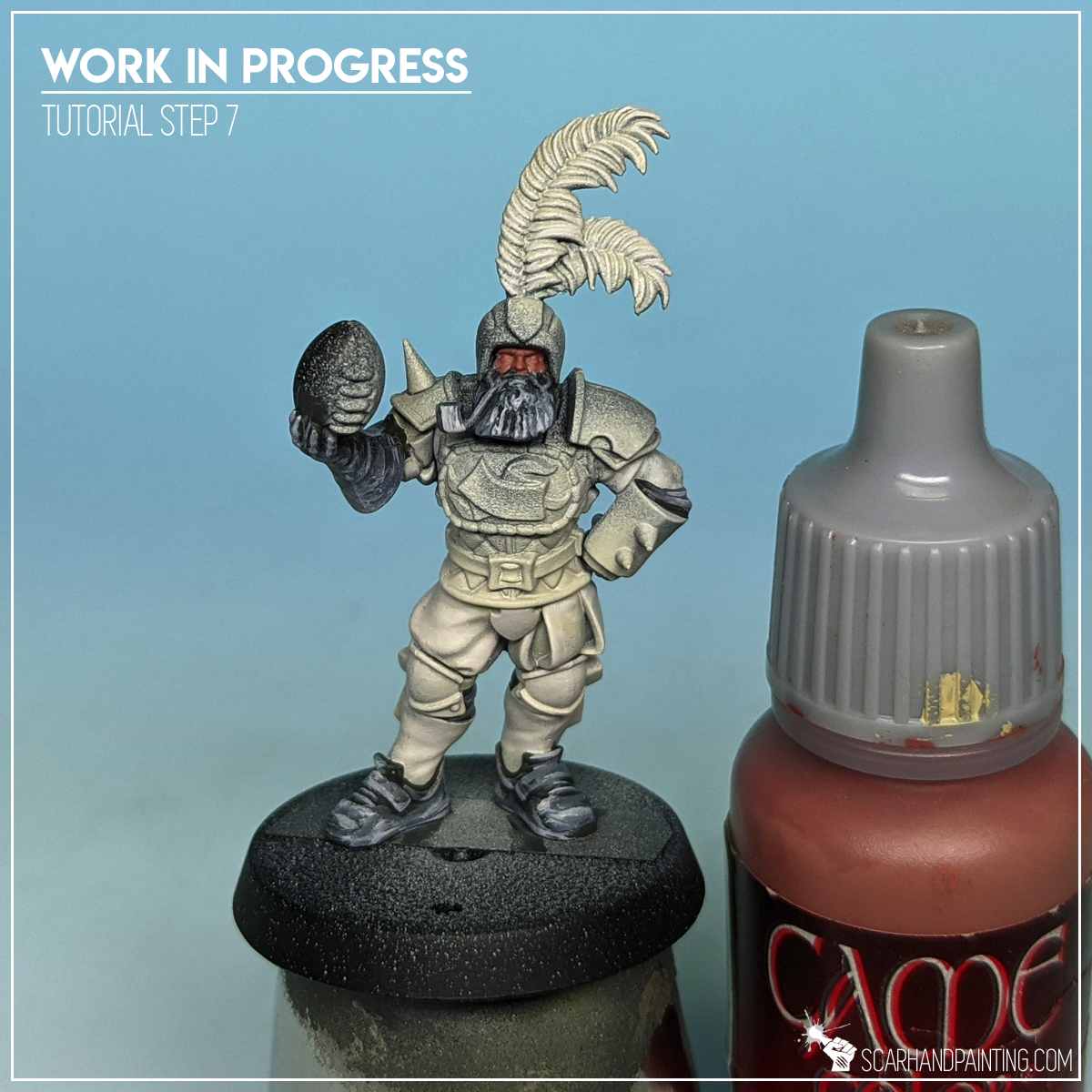
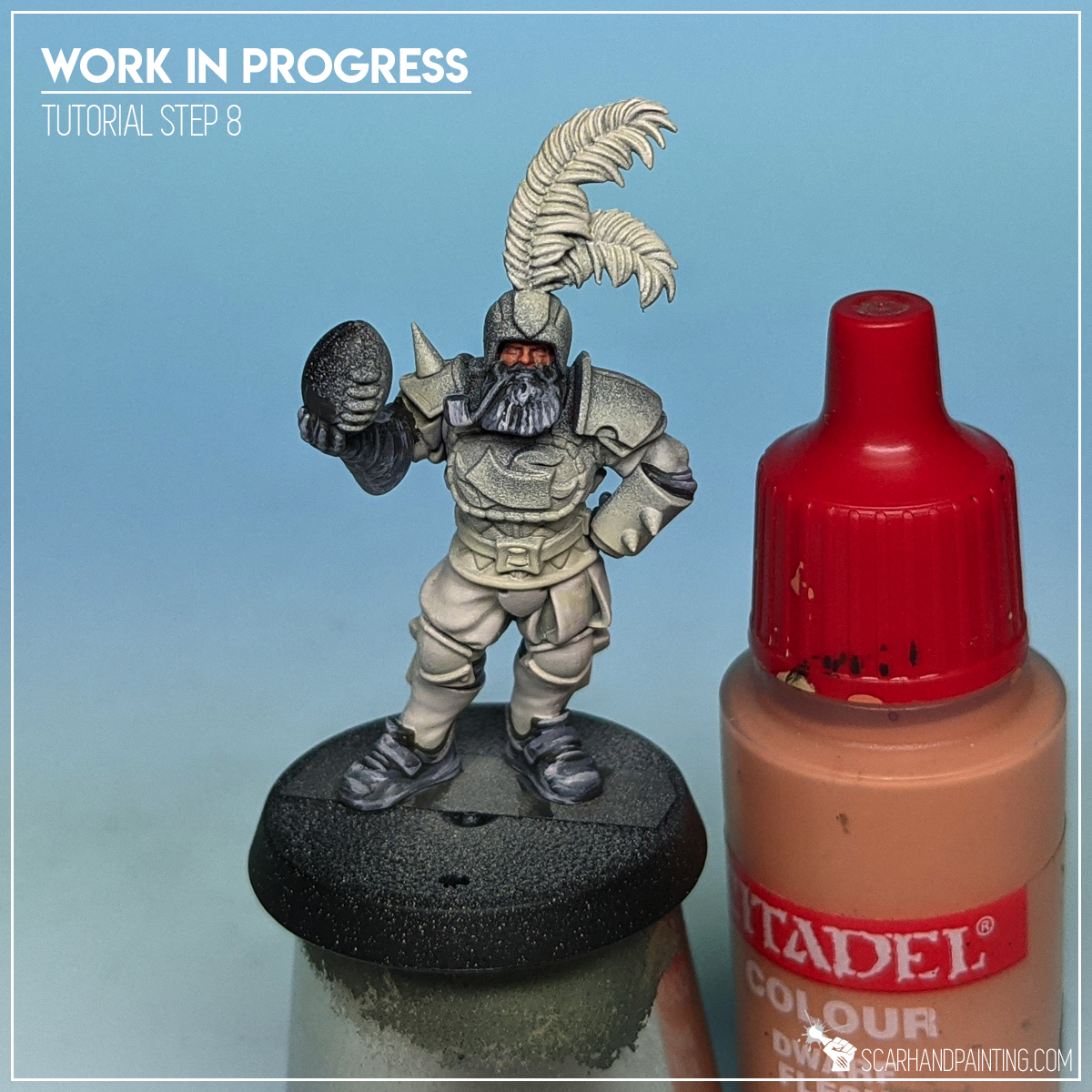

Step five: Browns
I took on Browns by manually applying Vallejo Dark Fleshtone (air) onto everything to-be-brown. Natural air series dilution allowed me to control the paint and avoid messing up other layers. I then switched to GW Karak Stone and Flayed One Flesh for classic highlights. Just few lines and dots on the edges and in center areas.
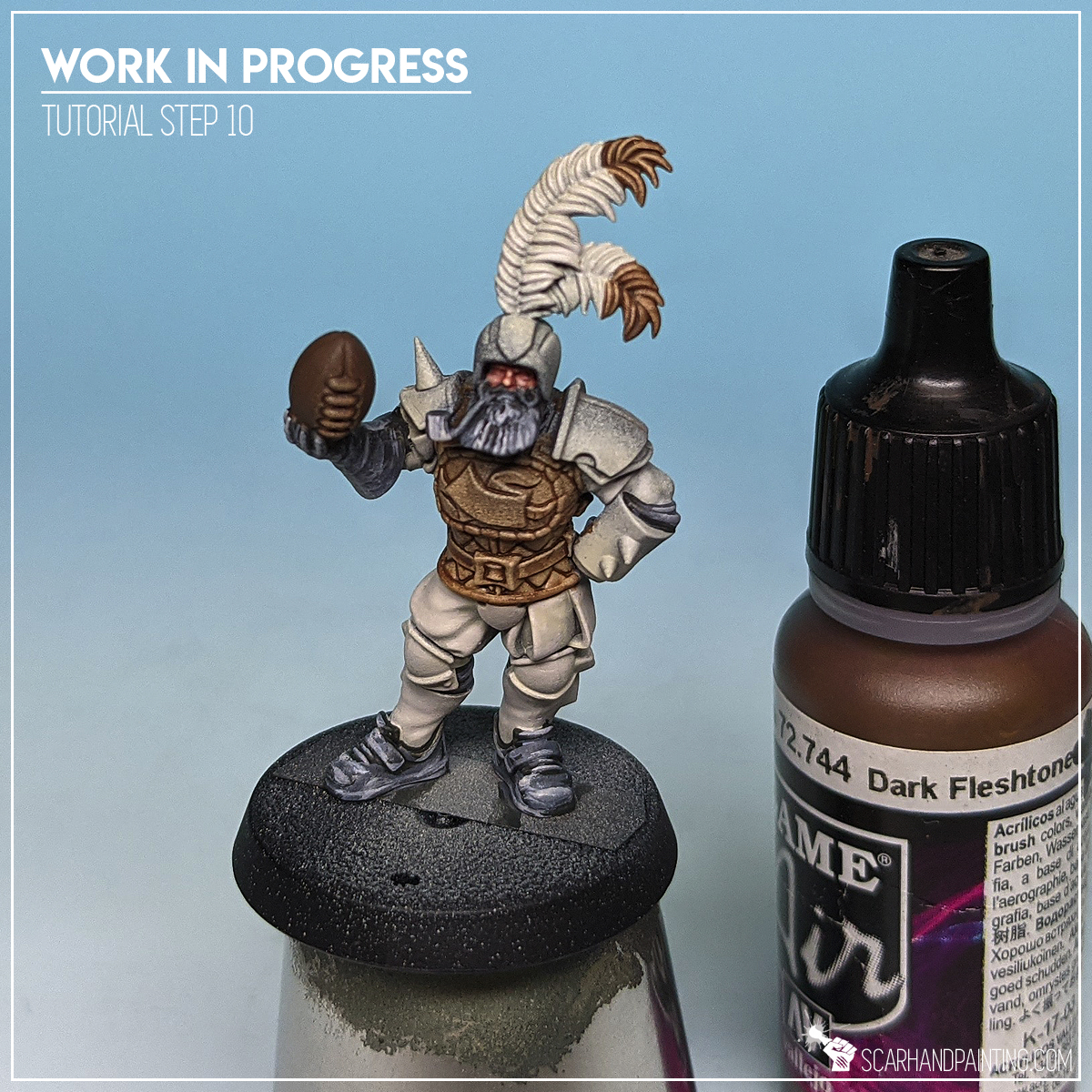

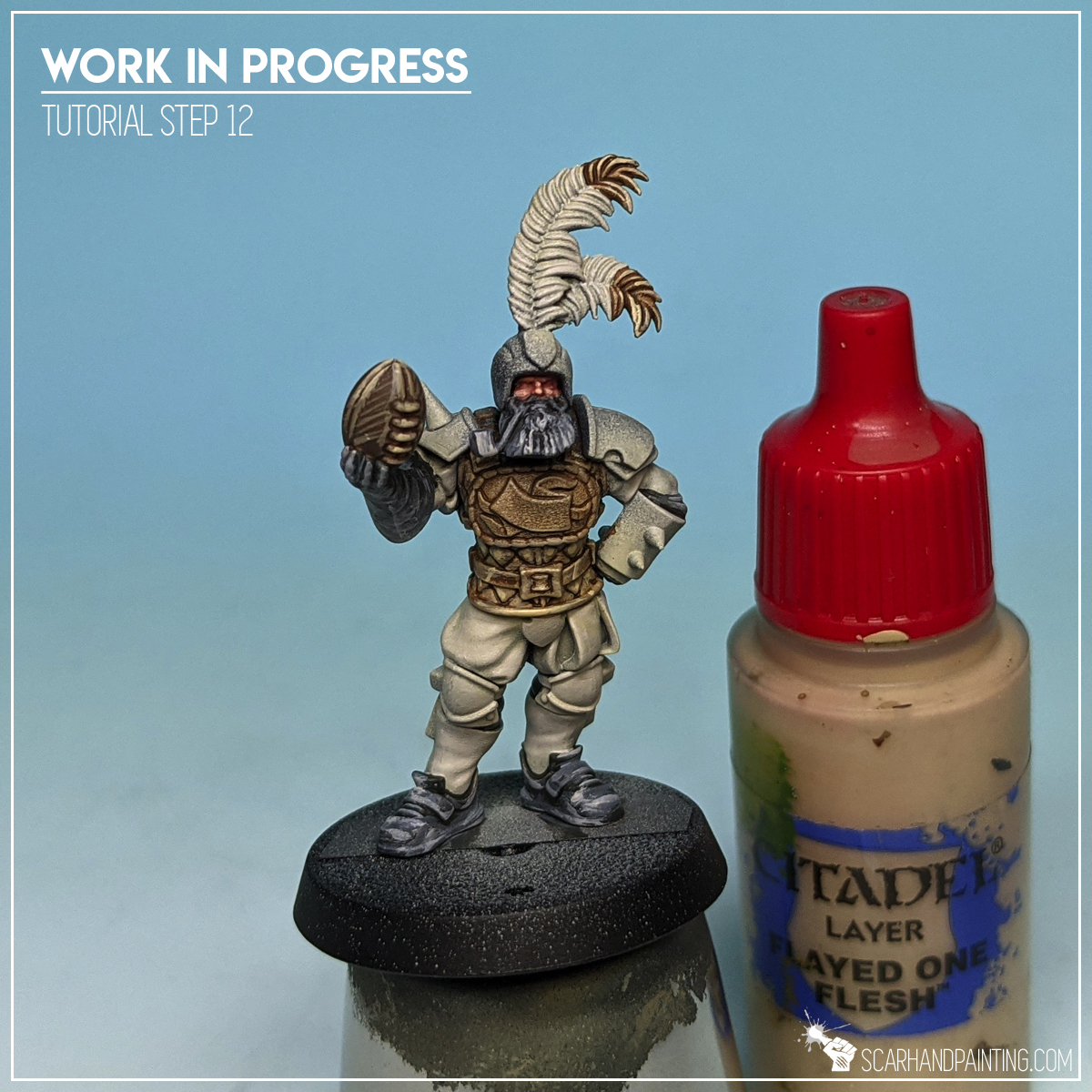
Step six: Metal
I started metal with GW Warplock Bronze, applying a thinned down layer on top of armor pieces. I then moved to P3 Molten Bronze for flatbrushed highlights. Finally I applied few highlights with AP Shining Silver.
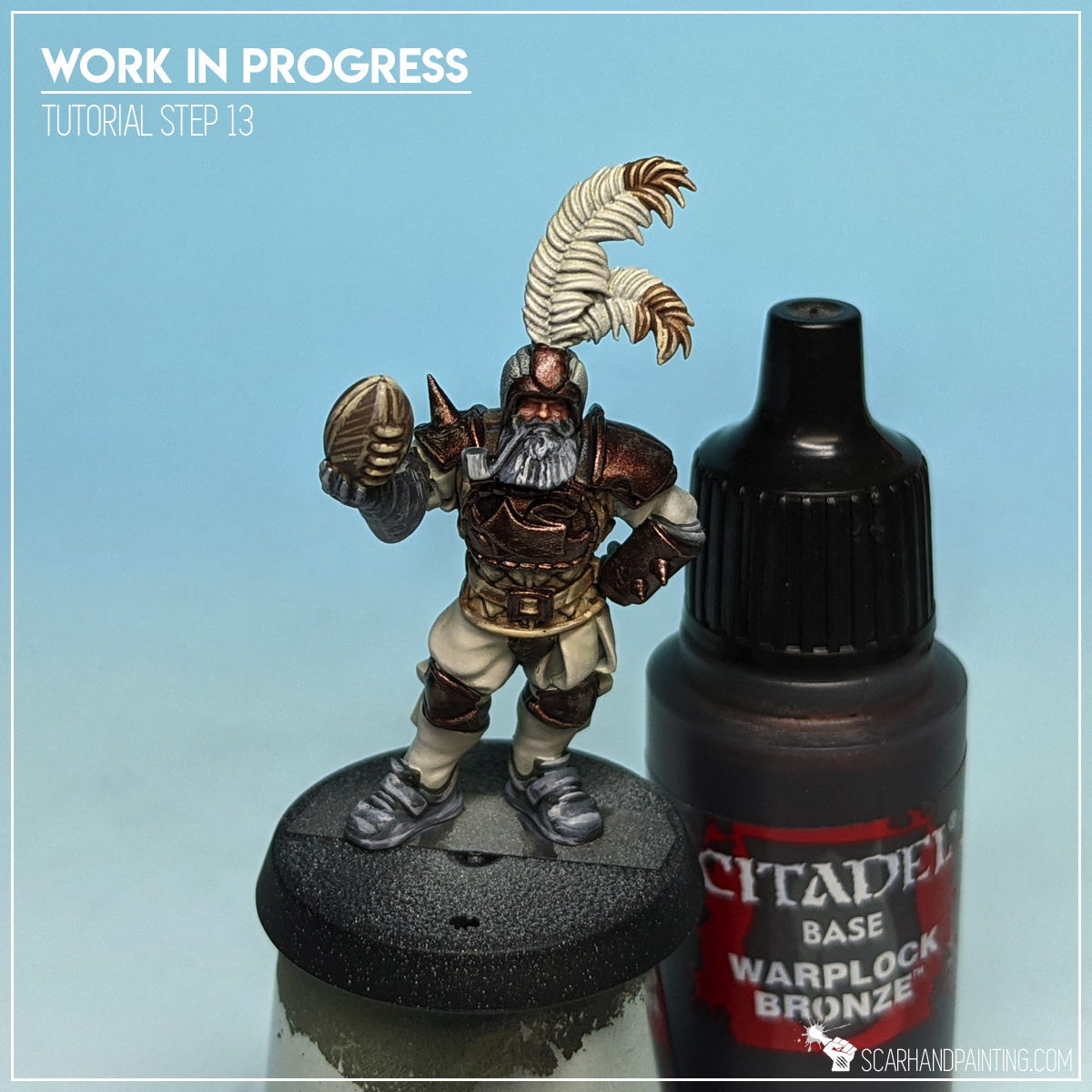
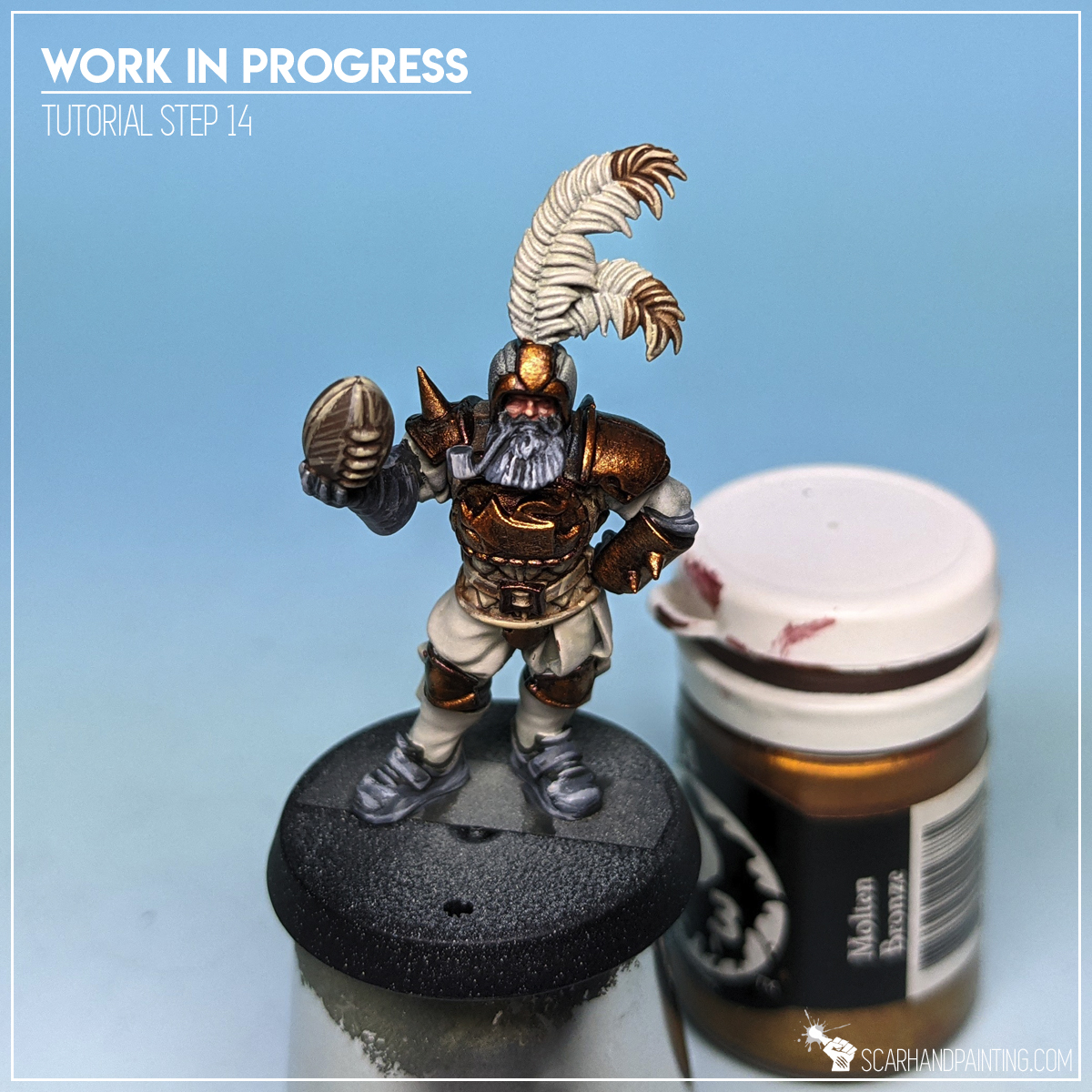
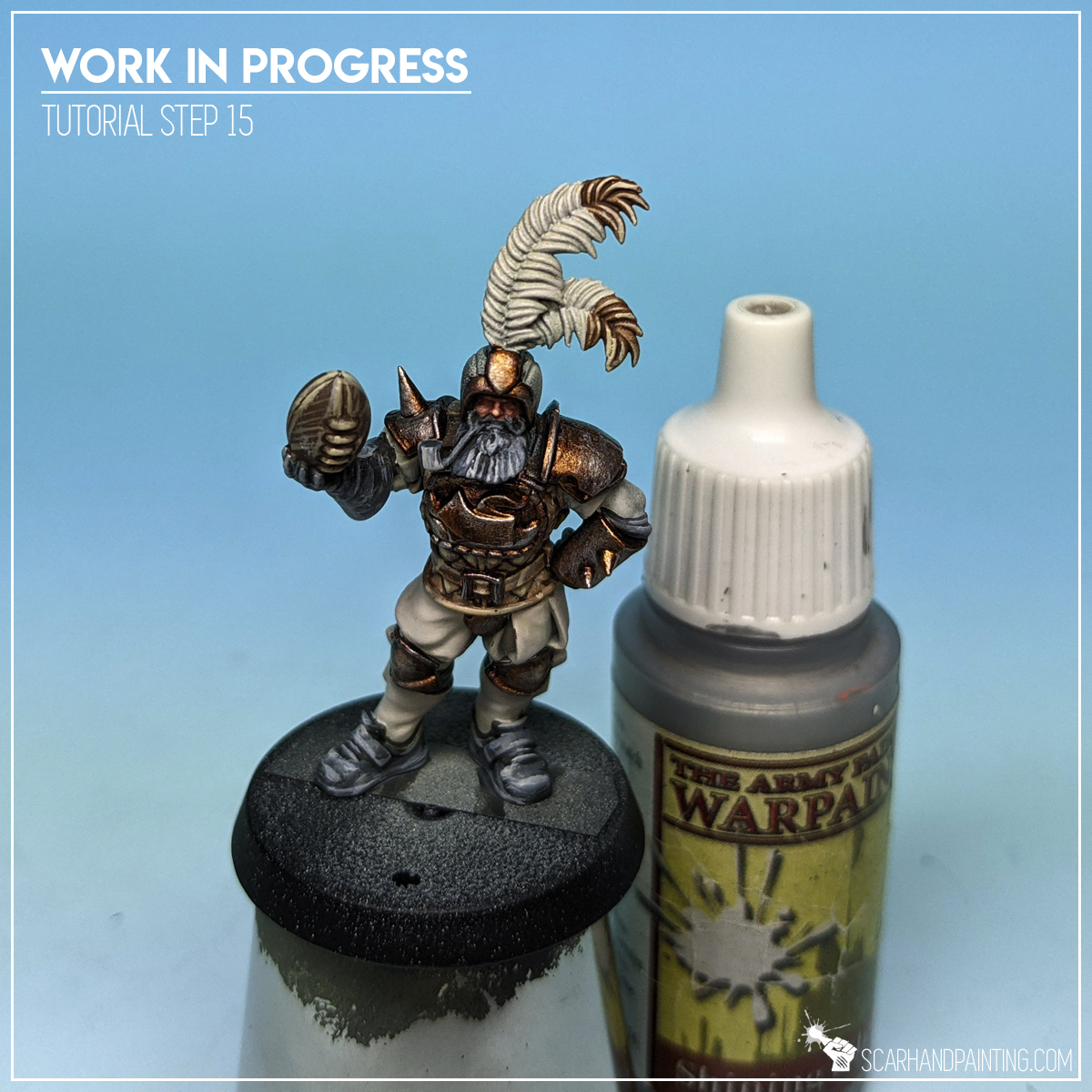
Step seven: Violet
I applied a layer of Vallejo Violet on chosen parts of clothes and decorations. This was the last layer before wash so I ensured it didn’t leave a mess on top of previous elements. At this point of the paint job, anything could still be corrected with minimum effort, and I done so accordingly.
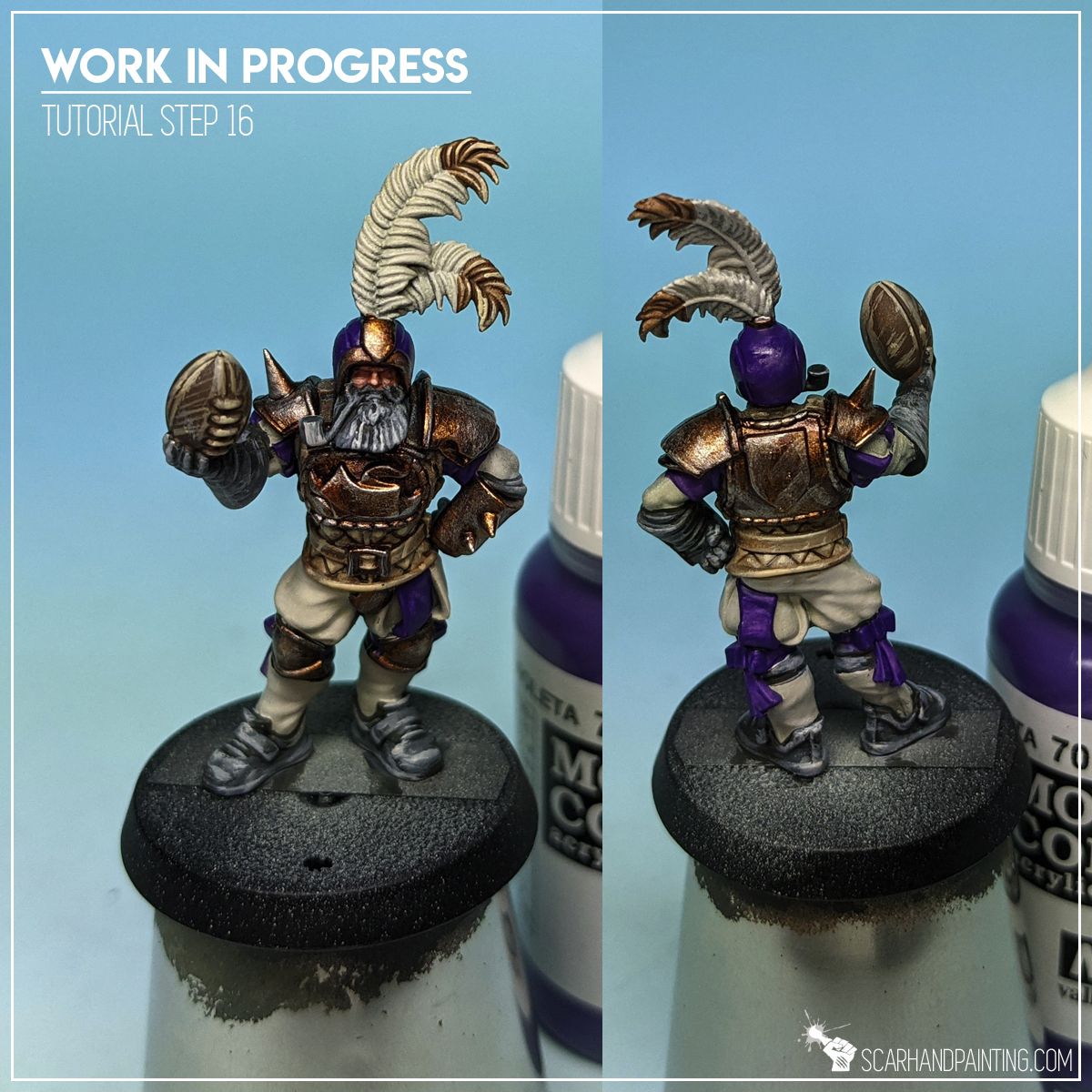
Step eight: Wash
This is where magic always happens. I applied a wet layer of AP Strong Tone Ink mixed with a tiny bit of Matt Varnish, onto entire miniature. I then ensured to remove any excess paint, from where detail got completely covered by pigmentation, with a clean brush.
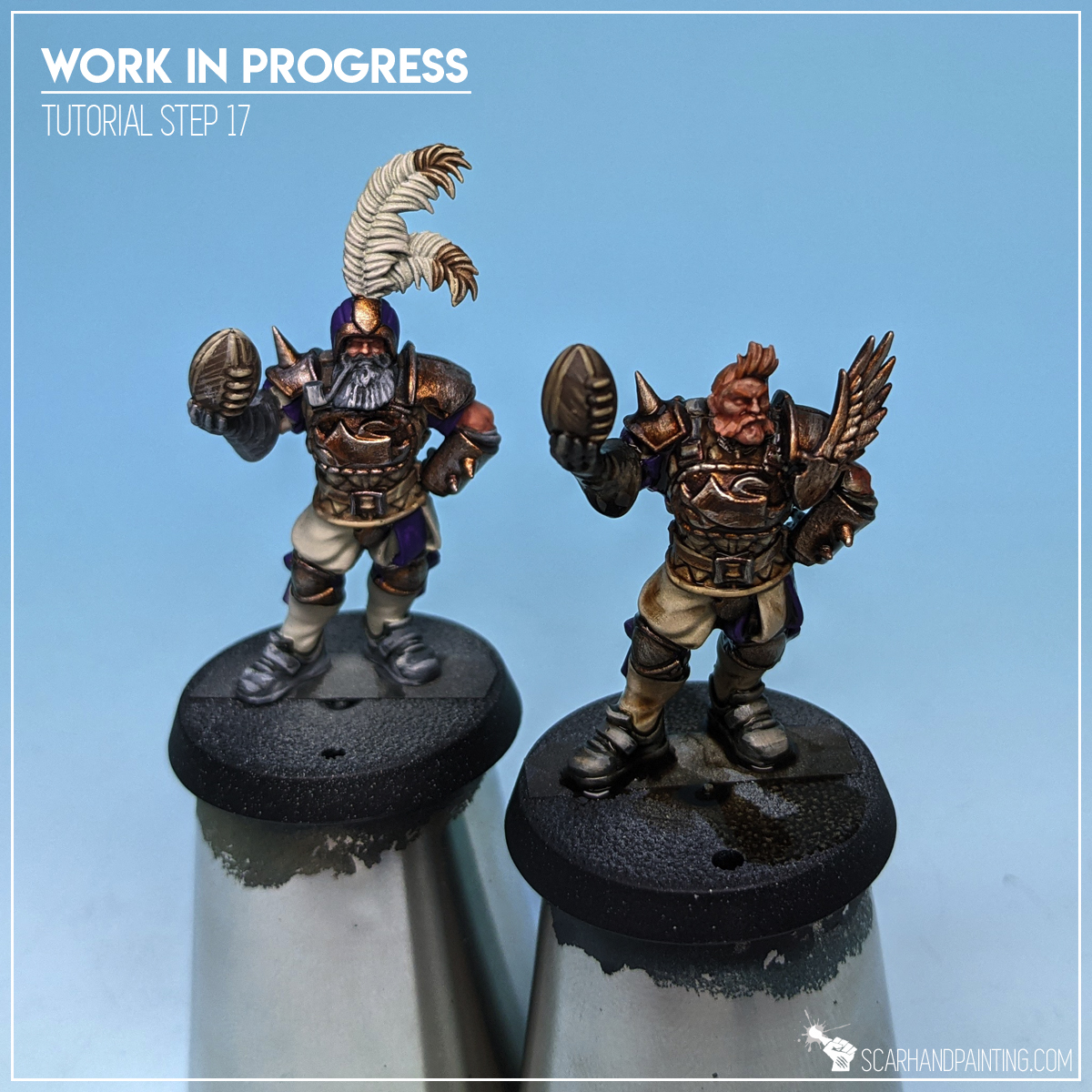
Step nine: Highlights
Once wash dried up, I applied highlights of GW Pale Wych Flesh. Edge highlights, points of focus and lines in the middle areas for everything not metal or skin. I also applied a strongly thinned down layer of Pale Wych Flesh on top of Purple clothes creating a somehow mist-like effect.

Step ten: Purple
I then got back to violet (now more of a purple) and blended a layer of Vallejo Warlord Purple (air) on top of it. Air series does not require any thinning, but I added a bit of medium to leave texture difference visible underneath. With a strong and vibrant color I moved to Vallejo Pale Flesh for both an edge highlight and some random lines. I used this opportunity to add few dots and lines on top of skin, thus providing a final highlight.
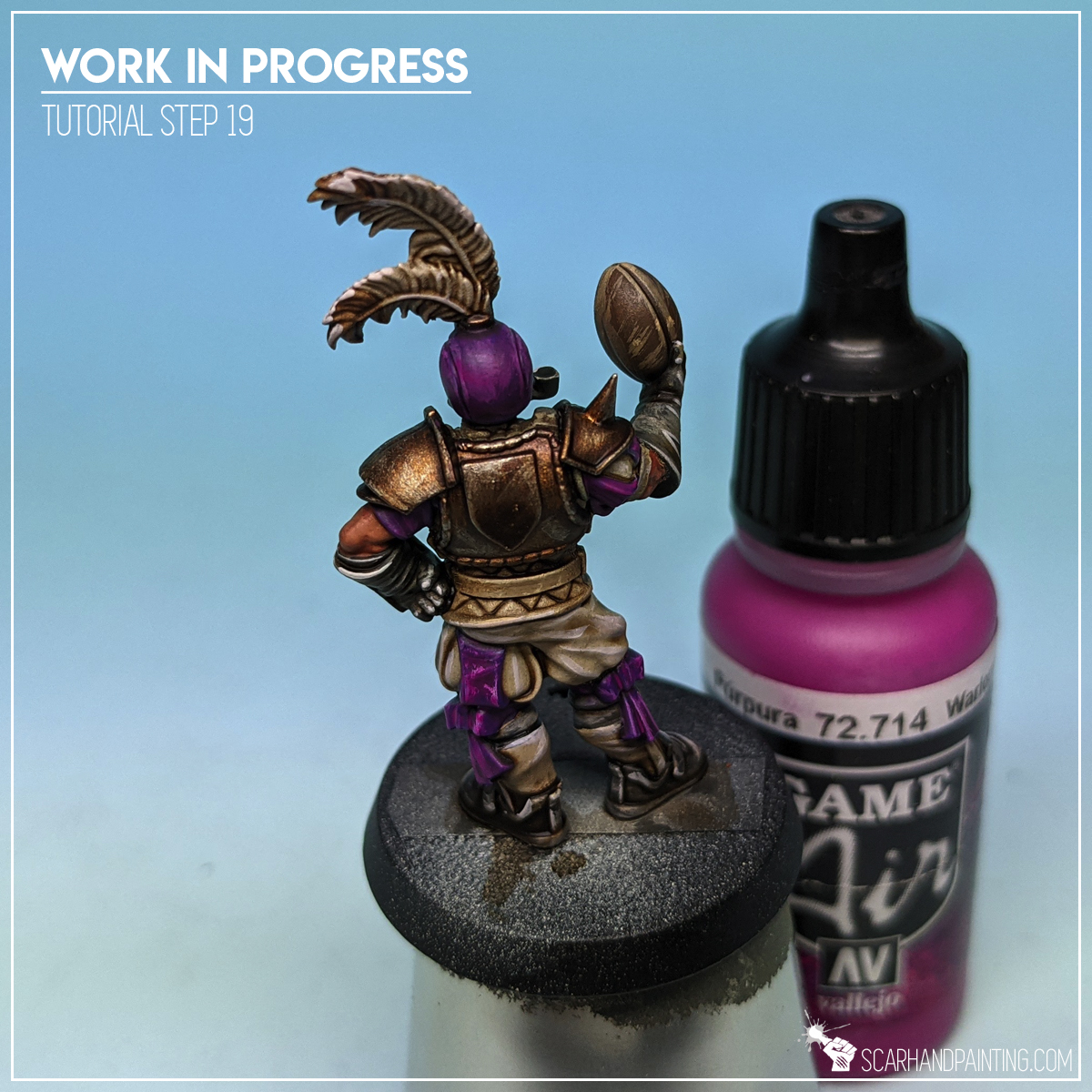
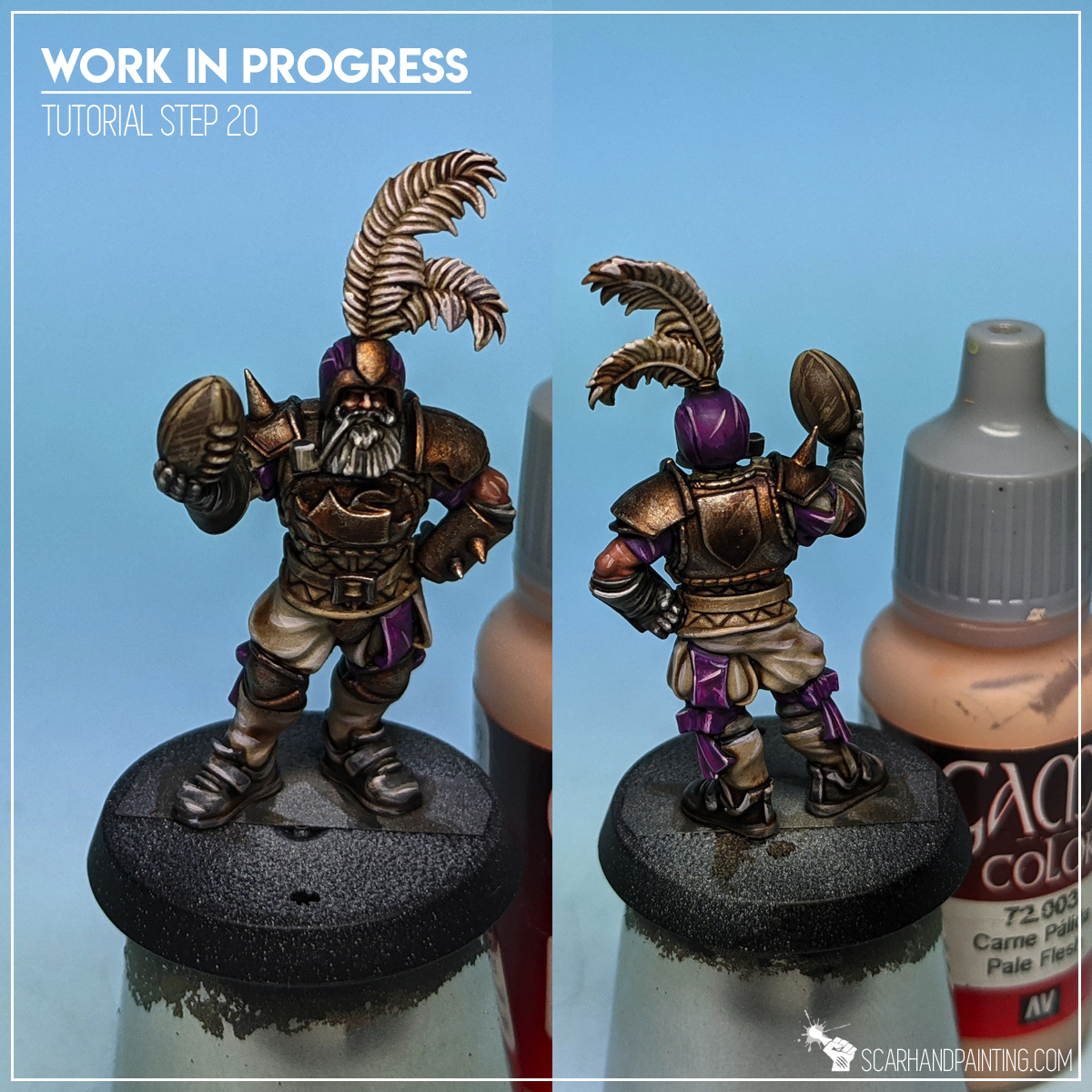
Step eleven: Grey
Finally I painted belts and straps with thinned Vallejo Panzer Dark Grey (air) with previous layers being barely visible from underneath. It was then highlighted with Vallejo Ghost Grey to add contrast and keep it in line with rest of greys on the miniature.

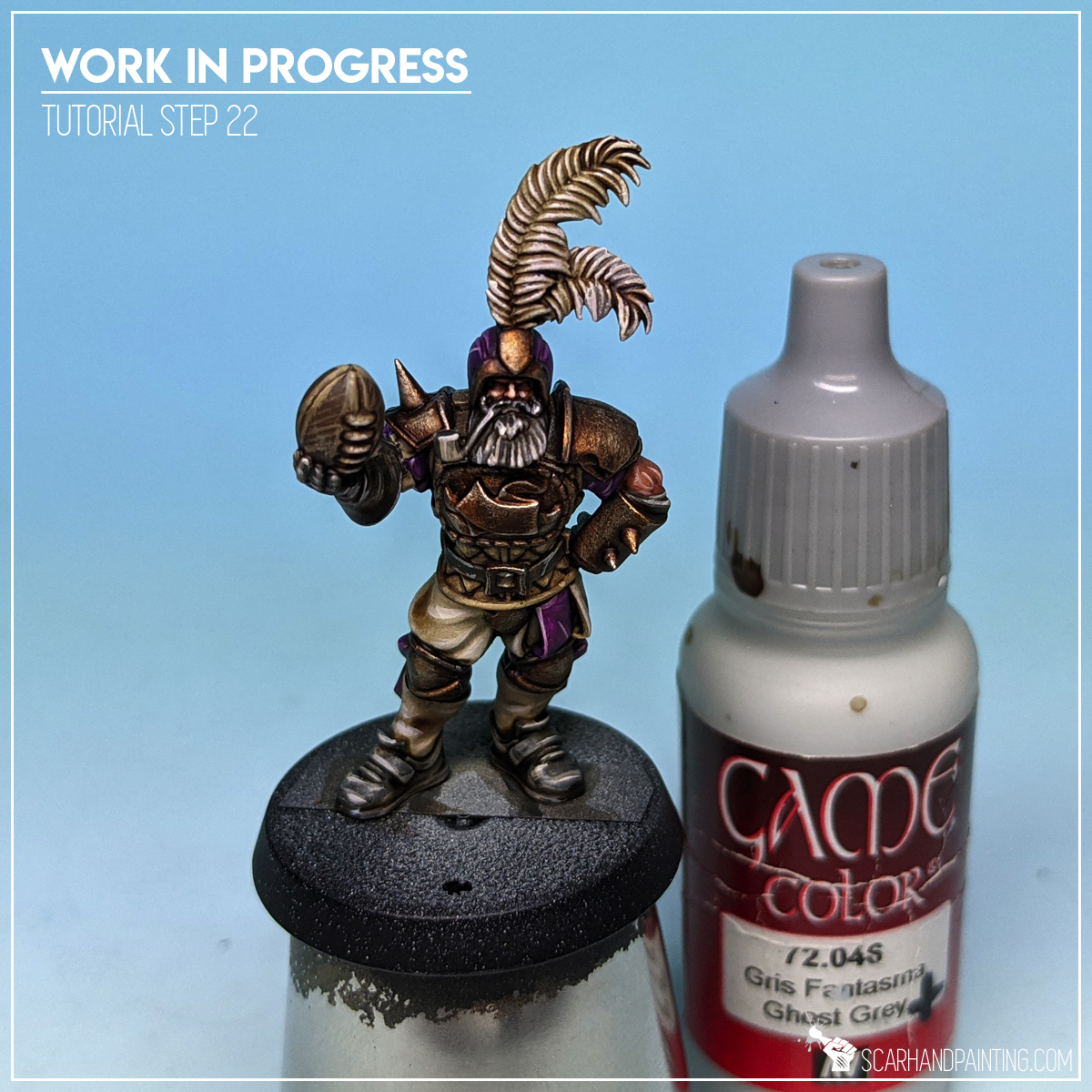
Step twelve: Basing
Basing was made using AK Interactive Dark Earth texture, followed with a single layer drybrush of Games Workshop Karak Stone. I then airbrushed a line of pure white using a masking tape to protect the rest of the base (and miniature). Few Gamers Grass tufts and pure black edge later the job was done.
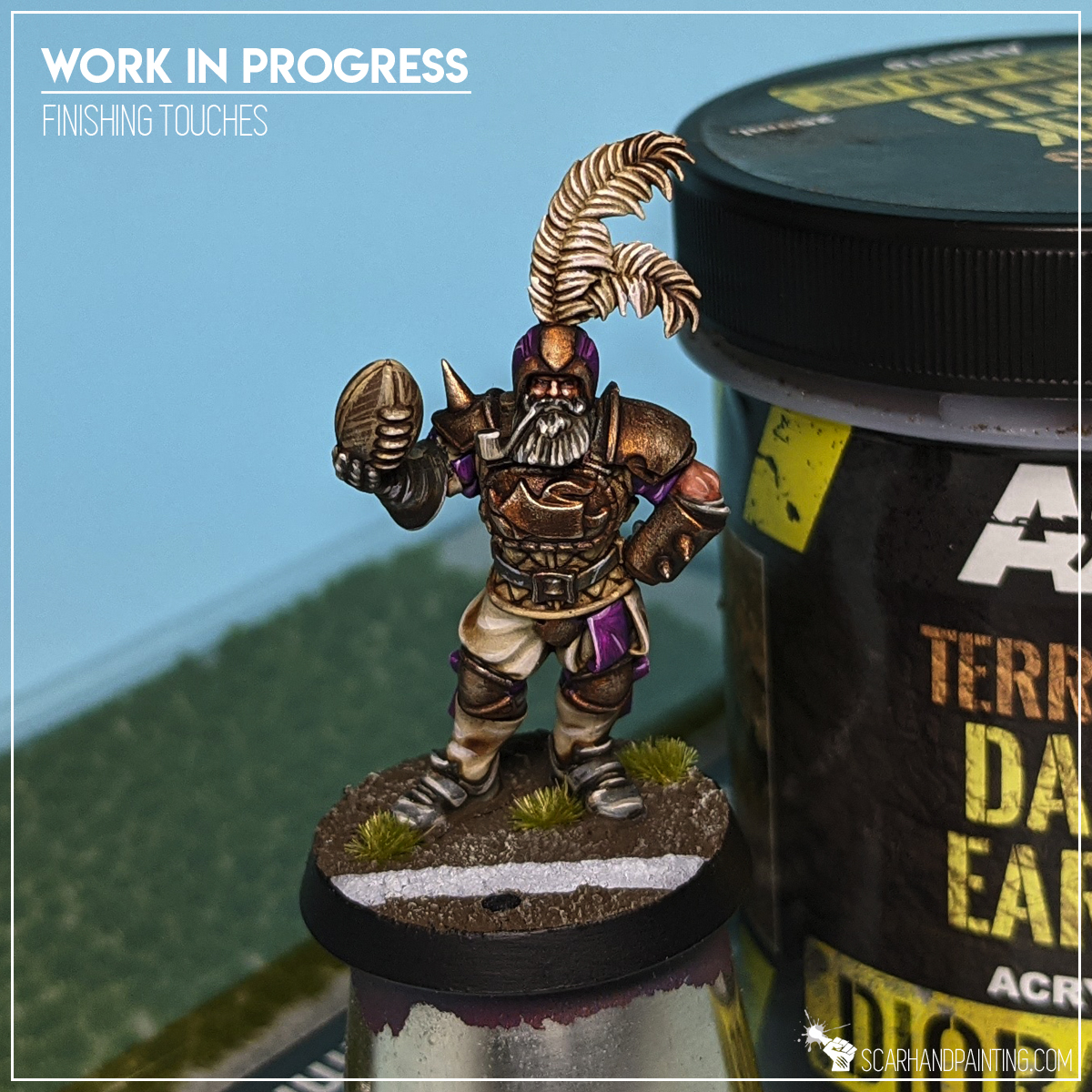

I hope you find this tutorial interesting. Be sure to let me know your thoughts in the comments below or via Facebook.or Instagram. I would also appreciate if you considered sharing this content with your friends, who might find it useful. Finally if you are looking for a professional miniatures painting service be sure to contact me with this contact form. I always reply within 24 hours, after which please check out your spam folder.
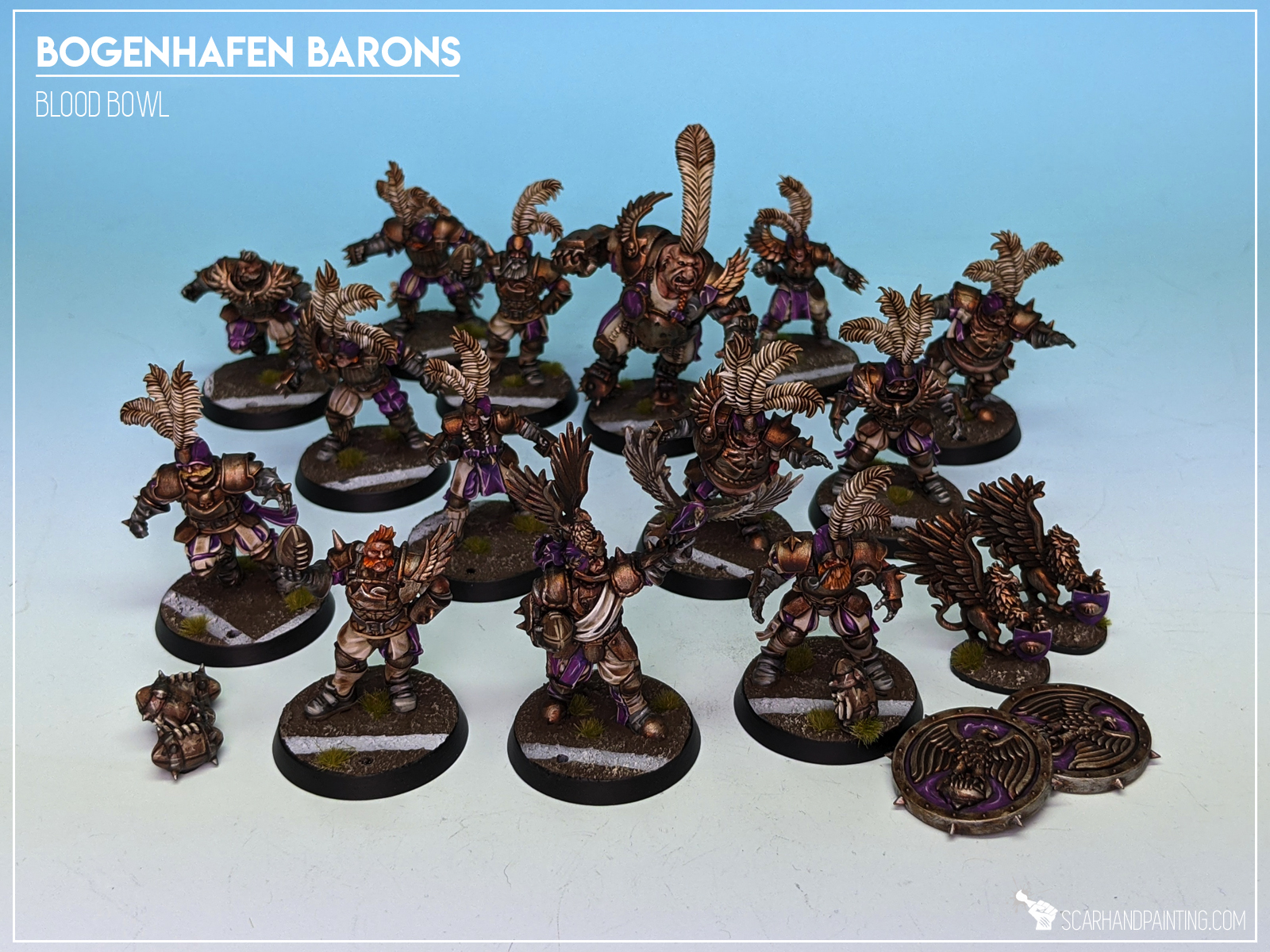

Welcome to Painting KoW Armada Dwarf Fleet tutorial. Here I will present to you a Step-by-step of an easy and fast painting process for Mantic’s Armada Dwarfs as can be seen in Gallery: Armada Dwarfs.
Before we start, some notes:
Step one: Undercoat
I started with a thorough layer of Games Workshop Chaos Black spray. This is a standard procedure for me. Chaos Black spray is my go to choice when it comes to undercoat.
Step two: Armor
I painted entire ship with slightly thinned Games Workshop Warplock Bronze. Once Warplock Bronze dried I flatbrushed entire miniature with Army Painter Gun Metal followed by another flatbrush, this time Army Painter Shining Silver. Finally I painted few elements with P3 Blighted Gold.
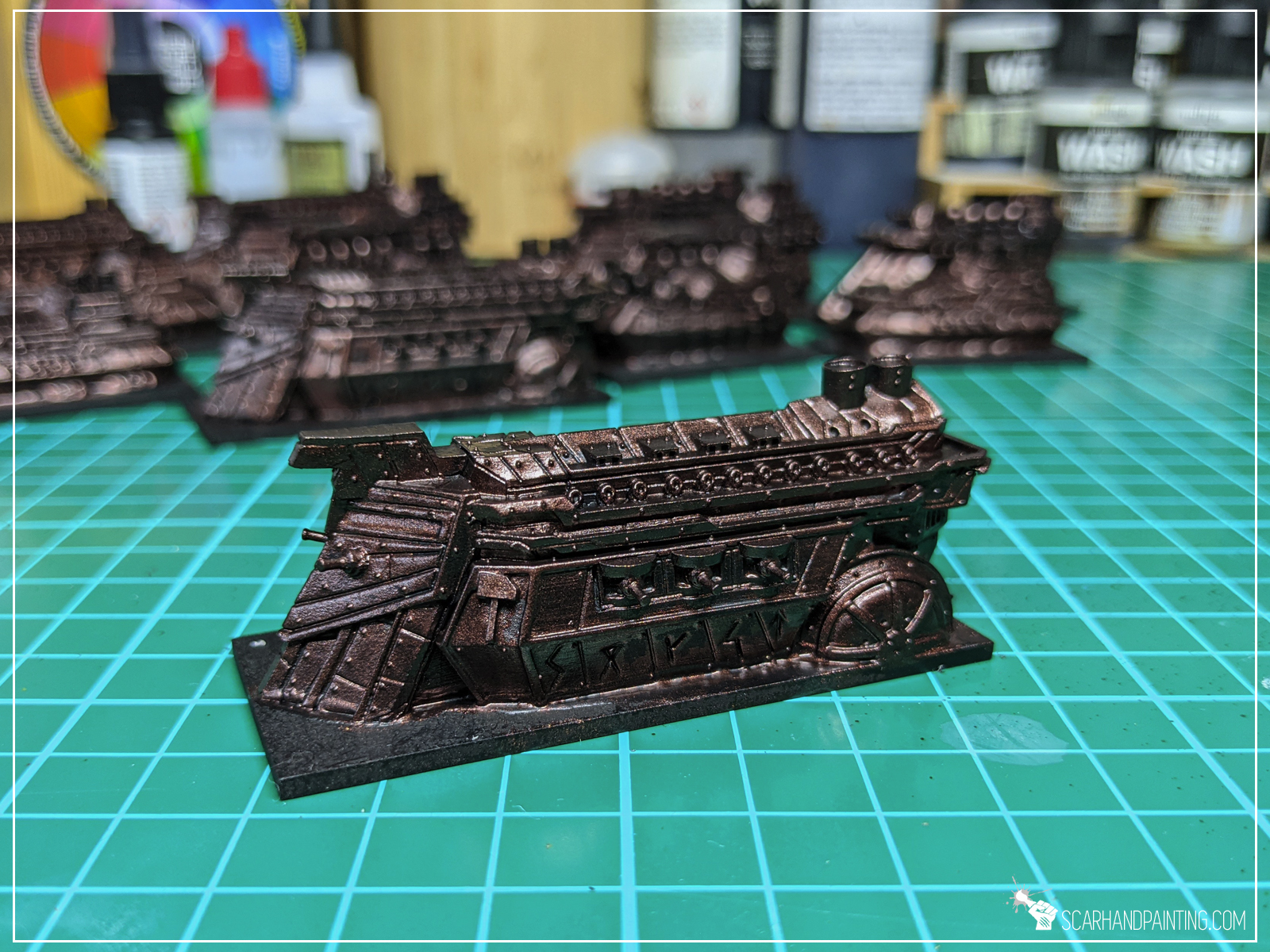
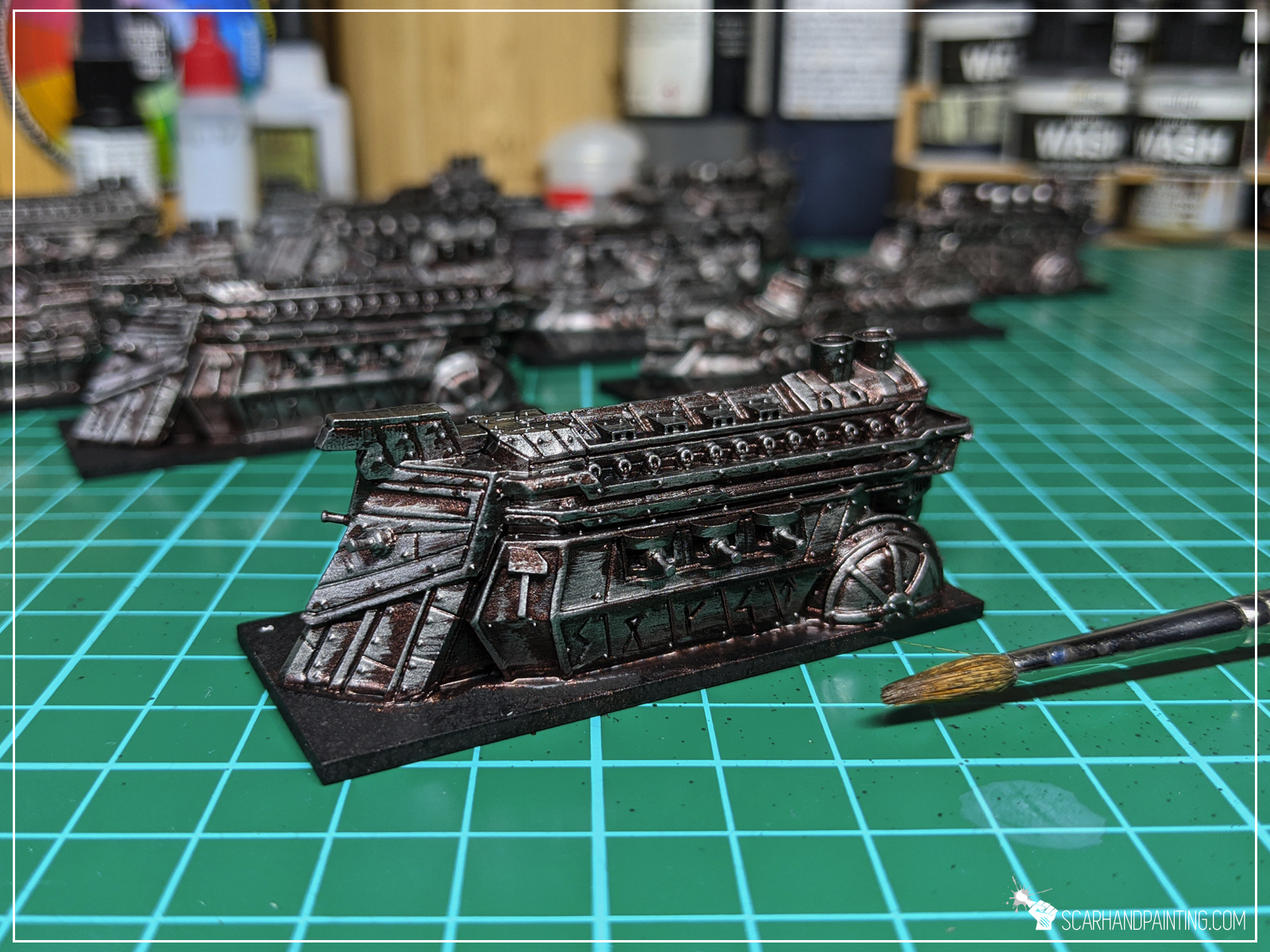


Step three: Red
Next I added some color to the ship by painting roof and side balcony elements with Vallejo Burnt Red which was in turn highlighted with a single layer of Vallejo Flat Red.
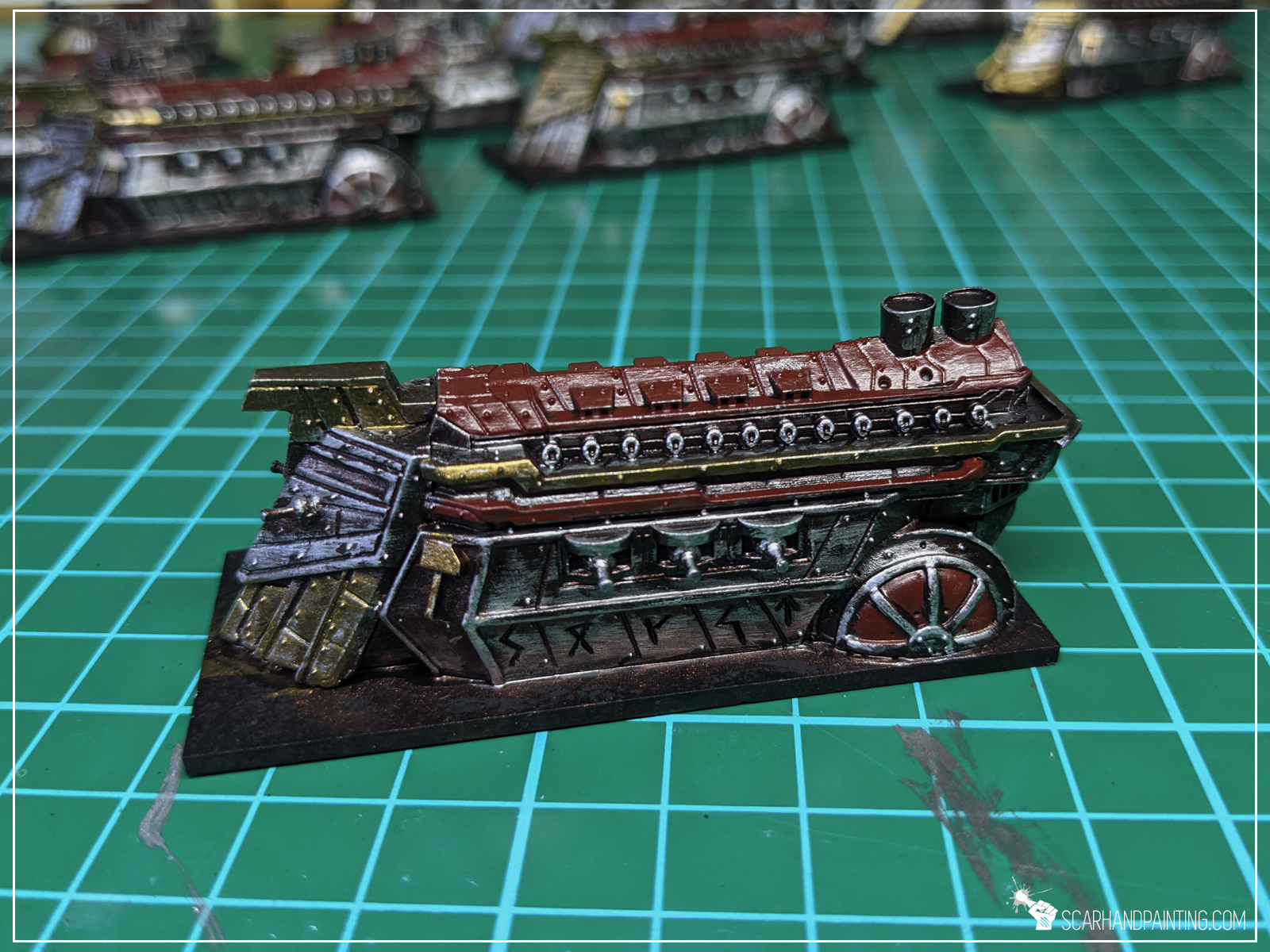
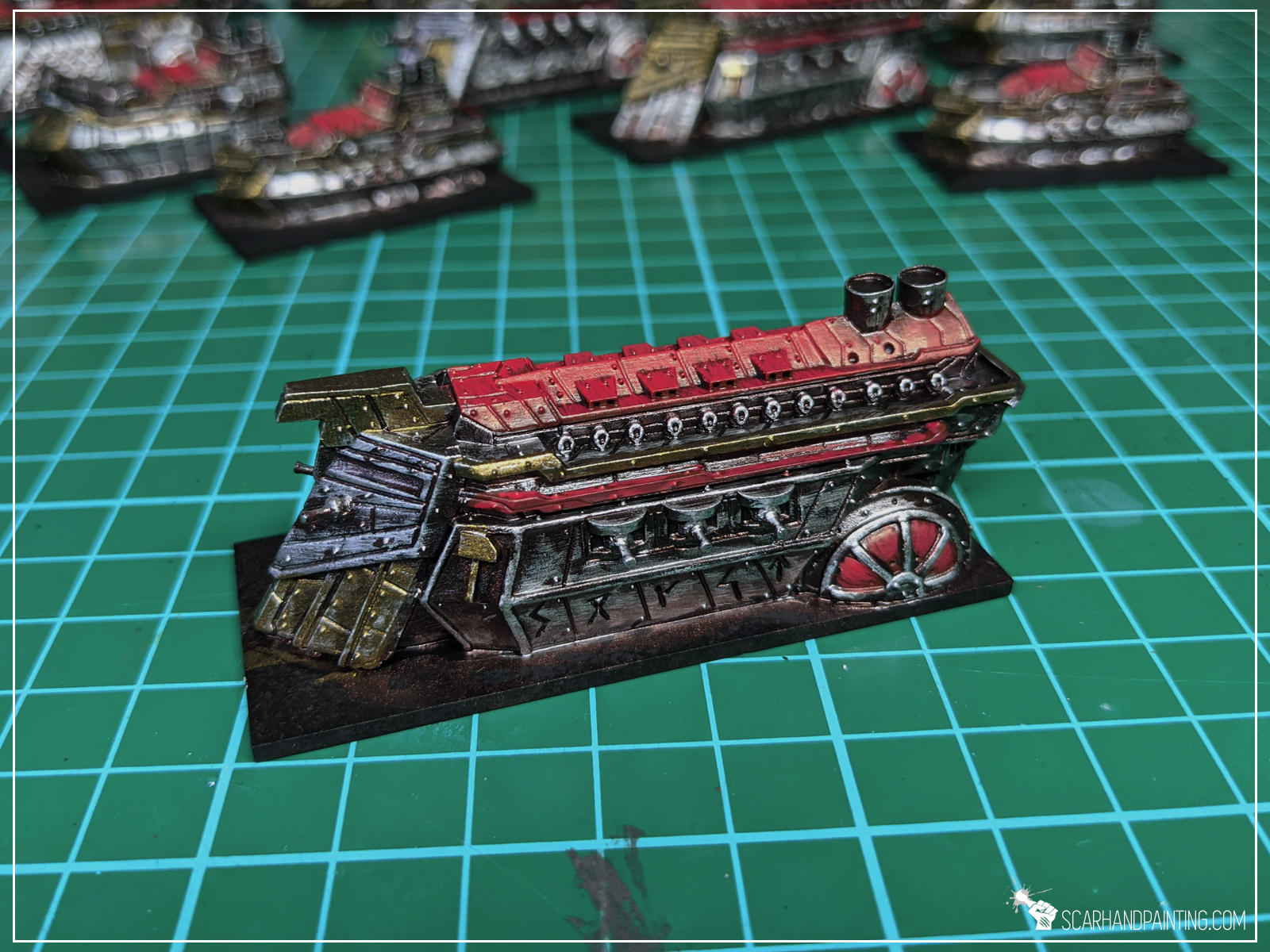
Step four: Wash
I richly applied Army Painter Strong Tone Ink onto entire miniature. The paint might be glossy depending on particular pot you got. I recommend adding just a bit of Matt Varnish before use.
Step five: Highlights
With wash dried out nicely I applied a layer of Vallejo Flat Red in most exposed red areas. I then followed with edge highlights and few lines/dots of Games Workshop Lugganath Orange. I then done the same for gold except I used GW Auric Armour Gold. For silver I went back to Army Painter Shining Silver, highlighting few exposed spots and edges.
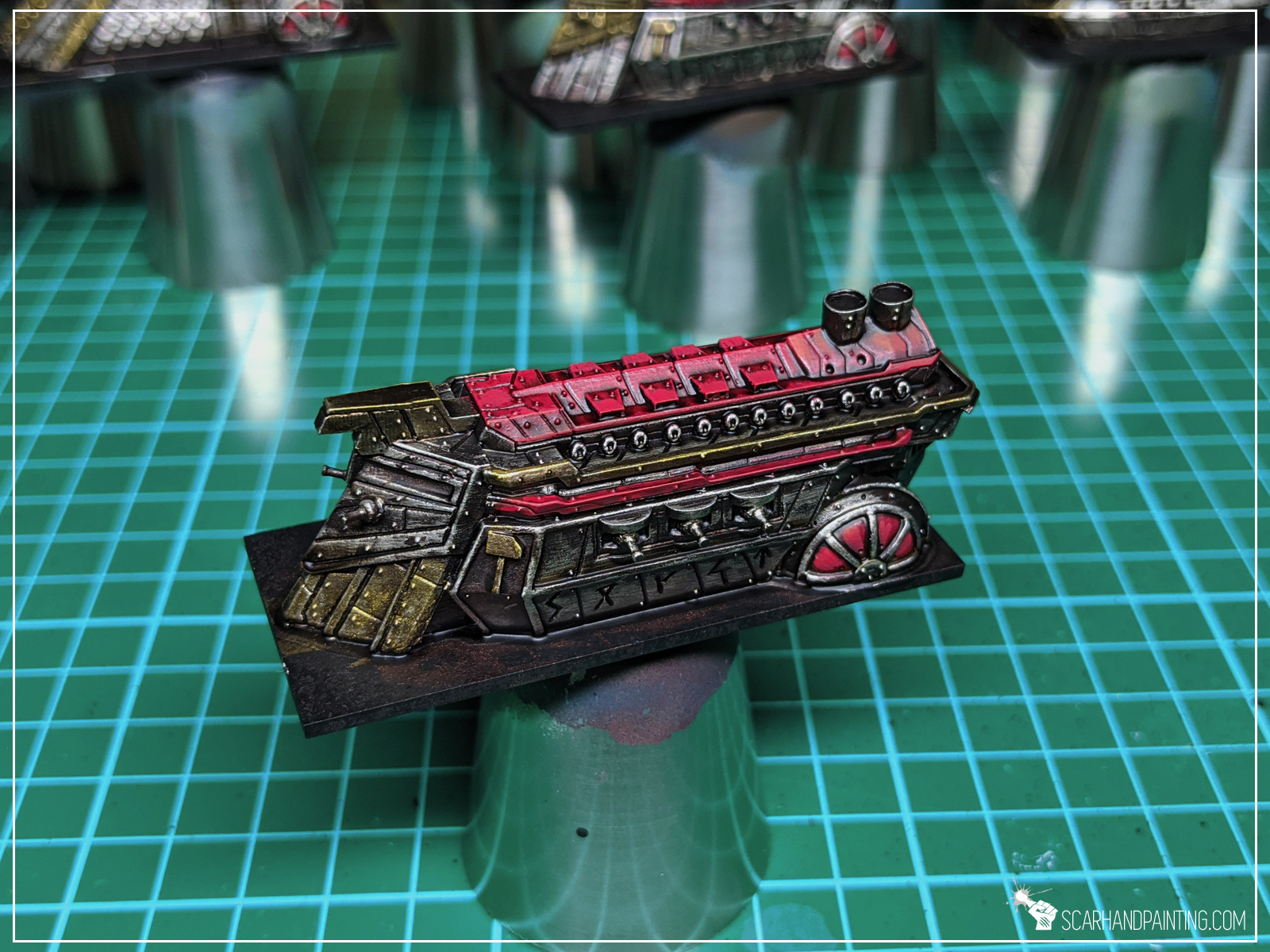
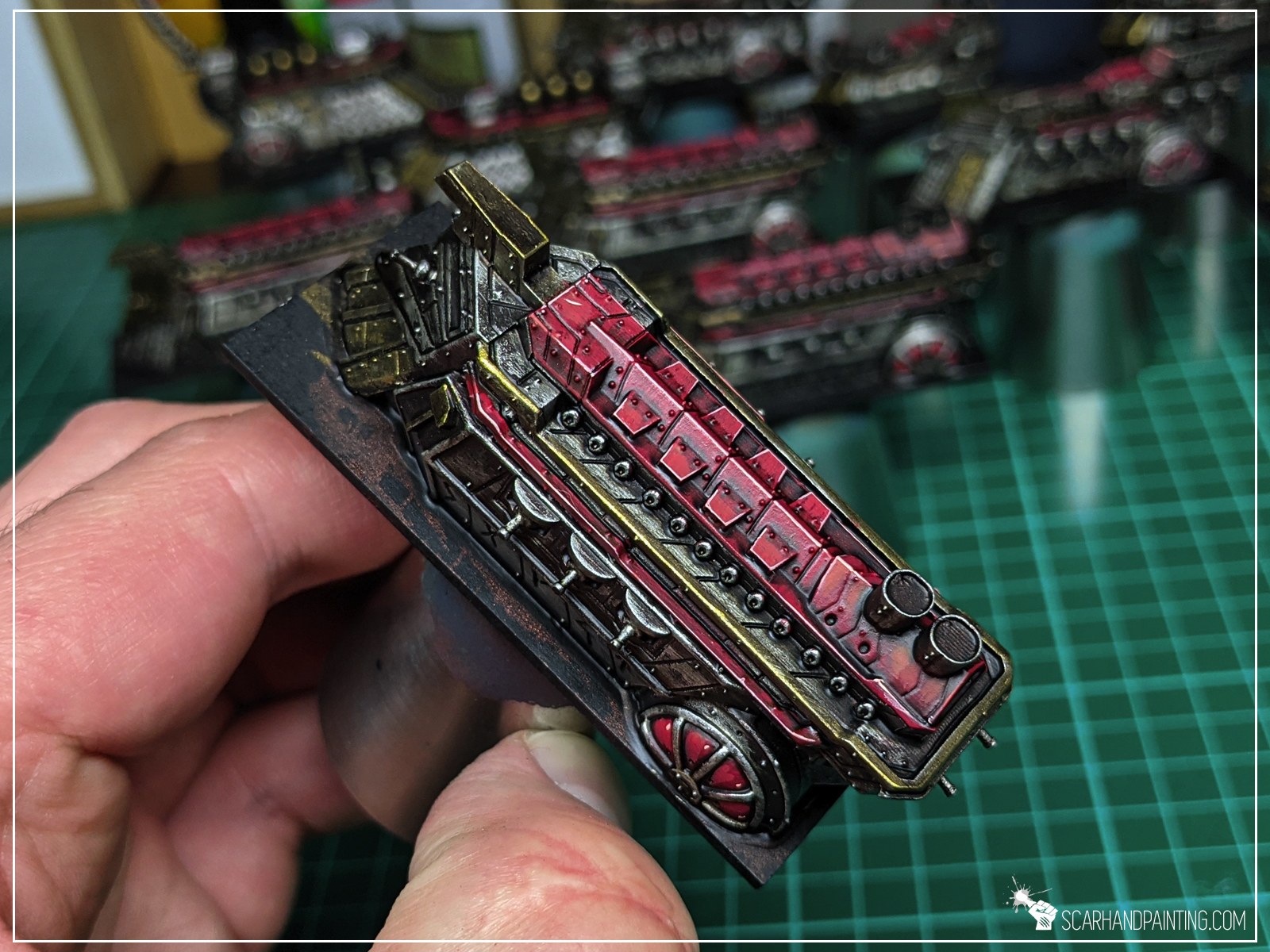
Step six: Front slots
I decided to add additional touch to the front of the ship, by painting two frontal slots blue. I done this by applying a layer of thinned GW Fenrisian Grey and then a wash of GW Contrast Ultramarines Blue.
Step seven: Basing
In simple terms I followed my own tutorial for Armada Basing, that you may find HERE, except I used standard hdf bases painted with a single layer of Vallejo UK Mediteranean Blue, followed by standard AK Interactive Pacific Blue, AK Interactive Water Effect and AK Interactive Water Foam textures.


I hope you find this tutorial interesting. Be sure to let me know your thoughts in the comments below or via Facebook. I would also appreciate if you considered sharing this content to any groups or forums, where it might help someone paint their miniatures. Scarhandpainting is not just about professional miniatures painting service. I do my best to provide interesting tutorials and share my experience with other hobbyists.